KIRKUS
Colleen Hoover

The author of It Starts With Us reflects on BookTok fame and her journey to bestsellerdom
Also in the issue: Anand Giridharadas, Theodore Taylor III, and Kindra Neely

Colleen Hoover

The author of It Starts With Us reflects on BookTok fame and her journey to bestsellerdom
Also in the issue: Anand Giridharadas, Theodore Taylor III, and Kindra Neely

It’s often said, with great fanfare, that we are living in the golden age of television. I’d submit that we are also in a golden age of the graphic novel, though it is perhaps less universally (and loudly) recognized. Has there ever been such a varied profusion of long-form comics for all ages, both fiction and nonfiction, pub lished by presses large and small? The days when fans had to make a case for the graphic novel as a valid form of literature are long past; a book like Nick Drnaso’s Sabrina can now be longlisted for the ultraprestigious Booker Prize, while graphic works for young readers are regularly nominated for the National Book Award, as was Victory. Stand!: Raising My Fist for Justice (Norton Young Readers, Sept. 27), a new memoir by athlete/activist Tommie Smith, written with Derrick Barnes and illustrated by Dawud Anyabwile.
The idea of this golden age of graphic novels occurred to me last month as I was reading Kate Beaton’s sneakily brilliant graphic memoir, Ducks: Two Years in the Oil Sands (Drawn & Quarterly, Sept. 13). Before she became widely celebrated for her webcomic “Hark! A Vagrant,” this artist from Cape Breton in Novia Scotia, Canada, traveled west at the age of 22 to work for a mining company in the prov ince of Alberta. In that rugged landscape, where working conditions were tough and she was one of few women, Beaton sought to pay off college loans while receiving an unofficial education in the realities of sexual harassment, environmental degradation, and exploitation of labor. Like all great books— graphic or otherwise—it drops readers into a specific and vividly rendered world, full of memorable characters, while also making us contemplate broader themes. In a starred review, Kirkus called it a “fascinating, harrowing, unforgettable book about a place few outsiders can comprehend.”

Here are three more graphic works that Kirkus has recommended in recent months, all proof of the genre’s diversity and vitality:
Fantastic Four: Full Circle by Alex Ross (Abrams ComicArts, Aug. 2): Celebrated comics artist Alex Ross, who has created memorable work for Marvel, DC, and others, delivers his first graphic novel, a new story for the family of superheroes originally created by Jack Kirby and Stan Lee in 1961. No surprise—the art is stunning. “A vibrant, wild ride that will bring joy to devoted comic book readers,” said our reviewer.
Numb to This: Memoir of a Mass Shooting by Kindra Neely (Little, Brown, Oct. 11): In 2015, Neely was attending Umpqua Community College in Roseburg, Oregon, when an armed student shot and killed an assistant professor and eight other students, injuring eight more. “This exploration of a gun-violence survivor’s raw pain amid ever repeating disasters will resonate with far too many,” writes our reviewer. (Read an interview with Neely on Page 116.)
Notes From a Sickbed by Tessa Brunton (Graphic Universe, Nov. 1): This autobiographical comic for young adults offers a “painfully real” portrait of life with myal gic encephalomyelitis, aka chronic fatigue syndrome. “This honest work depicts a bleak but not comfortless world familiar to many readers with chronic illness and disability,” our reviewer says.
Frequently Asked Questions:
Fully
President & Publisher MARC WINKELMAN
#
Chief Executive Officer
MEG LABORDE KUEHN mkuehn@kirkus.com
Editor in Chief TOM BEER tbeer@kirkus.com
Chief Marketing Officer SARAH KALINA skalina@kirkus.com
President of Kirkus Indie KAREN SCHECHNER kschechner@kirkus.com
Managing/Nonfiction Editor ERIC LIEBETRAU eliebetrau@kirkus.com

Fiction Editor LAURIE MUCHNICK lmuchnick@kirkus.com
Young Readers’ Editor LAURA SIMEON lsimeon@kirkus.com
Young Readers’ Editor MAHNAZ DAR mdar@kirkus.com
Editor at Large MEGAN LABRISE mlabrise@kirkus.com
Senior Indie Editor DAVID RAPP drapp@kirkus.com
Indie Editor MYRA FORSBERG mforsberg@kirkus.com
Editorial Assistant of Indie PAOLA BENNET pbennet@kirkus.com
Editorial Assistant NINA PALATTELLA npalattella@kirkus.com
Mysteries Editor THOMAS LEITCH
Contributing Editor GREGORY McNAMEE
Copy Editor BETSY JUDKINS Designer ALEX HEAD
Kirkus Editorial Senior Production Editor ROBIN O’DELL rodell@kirkus.com
Kirkus Editorial Senior Production Editor MARINNA CASTILLEJA mcastilleja@kirkus.com
Website and Software Developer PERCY PEREZ pperez@kirkus.com
Advertising Sales Manager TATIANA ARNOLD tarnold@kirkus.com
Advertising Associate AMY BAIRD abaird@kirkus.com
Author Consultant JESSICA PACK jpack@kirkus.com
Graphic Designer KYLA NOVAK knovak@kirkus.com
Administrative Coordinator SUSAN RATHBUN srathbun@kirkus.com
Submission Guidelines: www.kirkusreviews.com/about/publisher
www.kirkusreviews.com/magazine/subscription
photo
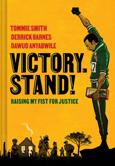
British romance author Talia

turns to YA in this enchanting story
two very different teens who fall for one another during wilderness challenges. Read
review on p. 115.
THE LIGHT PIRATE by Lily Brooks Dalton
SOLENOID by Mircea Cărtărescu; trans. by Sean Cotter
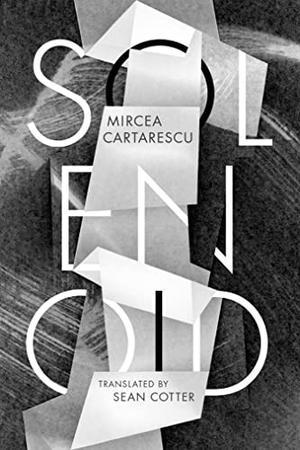
BUNNY by Bora Chung; trans. by Anton Hur
CLIVE CUSSLER THE SEA WOLVES by Jack Du Brul
THE WILDERWOMEN by Ruth Emmie Lang
RUBBLE OF RUBLES by Josip Novakovich
NOT RUSSIAN by Mikhail Shevelev; trans. by Brian James Baer & Ellen Vayner
THE SORCERER OF PYONGYANG by Marcel Theroux
SOLENOID
Mircea
by Sean Cotter
Vellum
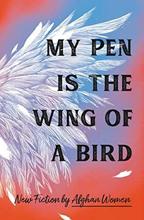
18 Afghan Women
Grand Central Publishing (256 pp.) $25.00 | Oct. 18, 2022 978-1-5387-2682-2
A selection of chilling short fiction from 18 Afghan women writers, trans lated from Pashto and Dari.
“Short stories lend themselves to fractured, pressured envi ronments,” writes Lucy Hannah in the informative afterword to this heartbreaking and heartfelt anthology, a product of the Untold Narratives project of which Hannah is founder and co-director. Calls for pieces went out in 2019 and 2021, reach ing into even rural parts of Afghanistan, and hundreds of sto ries made their ways to the editors and translators—in at least one case, having been written by hand, photographed, and passed through a chain of people using WhatsApp. The writ ers involved supported each other with an online diary through the ensuing fall of Kabul and the Taliban takeover; it’s bewil dering to imagine that their lives are now even more embattled than what is portrayed here. That said, the stories range widely. Several tell of oppressive marital and familial customs that condemn women in conditions of emotional torture. Several describe the terror of daily life, with bombs falling and lives ending randomly all around. The newscaster reads the news, the teacher drives to the school, the student goes to find her friend, with no confidence that any of them will live through the day. In at least one story, “An Imprint on the Wall” by Masouma Kawsari, translated by Parwana Fayyaz, the protagonist has already been blown up. In “My Pillow’s Journey of Eleven Thou sand, Eight Hundred, and Seventy-Six Kilometers” by Farangis Elyassi, translated by Zubair Popalzai, a family flees this night mare only to be miserable in “the long silence of America.” Two of the most violent stories—one describing a suicide bombing at a wedding, one an attack on a girls school—are followed by notes explaining that they are inspired by true events and ded icated to their victims. One of the only happy endings in the book occurs when the widow of a murdered man succeeds in refusing to be forced to marry her brother-in-law and finds a way, against all odds, to support herself selling homemade cook ies. The sacrifices people make for one other and the unbreak able attachment people have to home, no matter what hell that home may host, are repeated notes that echo in the heart.
we can do nothing else for these writers, may we reward their courage and talent with a wide and caring audience.
Blaise, Clark
Biblioasis (416 pp.)
$18.95 paper | Nov. 8, 2022 978-1-7719-6489-0
A six-decade retrospective of short fiction from an accomplished Canadian American writer.

The first two-thirds of this book can feel old-fashioned, but mostly in a good way. The stories have an autobiographical buzz and intensity; many feature an adolescent perpetual outsider, son of a mytholo gized, largely absent salesman father and a mother who, despite her nearness, always seems more distant and unknowable. The stories are as peripatetic as the family, which moves constantly, never assimilating, from racist Florida backwaters around World War II to industrial cities like Cincinnati and Pittsburgh in the 1950s. Then, in several stories, there’s an abrupt move to Canada (in one case sparked by the father having assaulted someone).
Several portraits feature an observer-protagonist who wants, by thinking about un-self-conscious doers like his father or uncle and the wide swath they cut, to convince himself he has grandeur in him, that he is “not just the timid academic son of [his] moth er’s rectitude.” These stories cover ground not only geographi cally. They are also crowded with character and incident, always fiercely and smartly observed; Blaise is, as Margaret Atwood puts it in her foreword, “the eye at the keyhole...the ear at the door.” Later, we follow a version of this protagonist to Montreal, where he is a young father, husband, and writer in love with the city and its flux, diversity, unpredictability, and cross-pollination. Many of the final stories, set in California and Europe, feature an Indian family (Blaise was married for decades to the writer Bharati Mukherjee, until her death in 2017) and another, only slightly less autobiographical approach to what dislocation feels like. What is it like to be a citizen of the world who nevertheless finds himself, again and again, in a strange, small space or a strange, small self that must for now be home?
Blaise has gathered here a smart, sprawling collection of stories about family, rootlessness, and identity.
young adult

During the last few pandem ic years, no one needed to be more scared than they already were—but Halloween is back with a vengeance this year, so it’s time to check out witchy, frightening, fantastical fic tion to go with the mood.
Stephen King never disappoints. His new book, Fairy Tale (Scribner, Sept. 6), finds young Charley Reade befriending a Maine neighbor who warns him never to go into the shed behind his house. Could it be Narnia in there? Not likely. Behind the door is “a whole bunch of people—well, sort of people, anyway— who’d like nothing better than to bring their special brand of evil up to our world’s surface,” according to our starred review. “A tale that’s at once fa miliar and full of odd and unexpected twists—vintage King, in other words.”

Jennifer McMahon takes inspira tion from the first modern horror nov el, Mary Shelley’s Frankenstein, for her new book, The Children on the Hill (Scout Press, April 26), which revolves around a private Vermont hospital for the mental ly ill and takes place in both 1978, when a young patient named Iris with raised scars she tries to hide comes to live there, and 2019, when a podcaster named Lizzy Shelley comes to Vermont looking for a monster who abducts young girls. “McMahon succeeds admirably in building real chills and a surprising twist,” according to our review.
In The Hollow Kind (MCD/Farrar, Straus and Gi roux, Oct. 11), Andy Davidson explores the hole at the center of the Redfern family—the one where the soul should be. Leaving an abusive husband, Nellie Gardner takes her son, Max, and runs to her family’s tur pentine estate in Georgia. “Let’s face it, if you hang out in dusty old estates populated by long-kept secrets, guilt, remorse, and madness…[are] bound to come slithering out of a hole,” ac cording to our review.

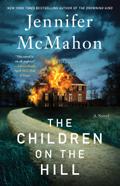
Kari James, the protagonist of Erika Wurth’s White Horse (Flatiron, Nov. 1), is a fan of Stephen King. Warn ing: Her life isn’t going to be a bed of roses. Kari is Apache and Chickasaw, but she doesn’t think of herself as a traditional Indigenous woman—so it’s a surprise when she touches a bracelet that belonged to her long-lost moth er and “experiences violent, troubling visions about the past and her family, and a dangerous monster is unleashed,” according to our review, which calls the book “an en grossing modern horror story.”


If pumpkin spice season has you in the mood for cozy rather than frightening seasonal reading, try The Very Secret Society of Irregular Witches by Sangu Mandan na (Berkley, Aug. 23). Mika Moon, a British witch, has spent her whole life trying to keep her magic secret; now she’s been invited to work as a tutor for three magical orphans. “A magical tale about finding yourself and making a found family that will leave the reader enchanted,” according to our starred review.
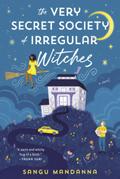
The title character of GennaRose Nethercott’s Thistlefoot (Anchor, Sept. 13) is a house: a magical house that moves on chicken legs and that offers a key to the past for siblings Isaac and Bellatine Yaga. They’re descendants of folkloric witch Baba Yaga who “realize they must tell the story of Gedenkrov ka, Russia, where a pogrom destroyed its Jewish inhabitants,” according to our starred review. “This book blooms from a fairy tale to a panoptic story that defies space and time, brimming with creativity, wisdom, and love.”
 Laurie Muchnick is the fiction editor.
Laurie Muchnick is the fiction editor.
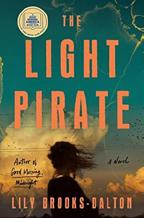
Brooks Dalton, Lily Grand Central Publishing (320 pp.)

$28.00 | Dec. 6, 2022 978-1-5387-0827-9
Climate apocalypse is the setting for a formidable young woman’s coming-of-age.
Kirby Lowe is a lineman for the util ity company in the small town of Rudder in southeast Florida. With a huge hurri cane heading in, he’s called to work before it arrives. He hates leaving his pregnant wife and his two young sons at home, but they’re prepared, or so they think. The first part of this novel is a harrowing description of that storm and the destruction it wreaks; the second part picks up 10 years later with Kirby and his surviving family: grown son Lucas and 10-year-old daughter Wanda, named for the hurricane during which she was born. In a convincingly portrayed near-future Florida, cli mate change has accelerated. The hurricanes come faster and fiercer, and the barrier island communities are already slipping under the sea. Kirby and Lucas, now also a lineman, have so much work that Wanda is often on her own, and her adven turous streak worries her father. He finds her an after-school caretaker, a retired biology professor named Phyllis, who turns out to be the perfect choice. Soon the pair are conduct ing field studies of the local flora and fauna, and Phyllis, who as a biologist and former park ranger has seen climate disaster coming for years, starts teaching the girl how to grow a garden, keep chickens, forage, and use other survival skills. As Wanda grows up, the waters rise higher and the summers blaze hot ter, and climate refugees begin to flee the state. Before long, mostly depopulated towns shut down, then even big cities are abandoned. “Eventually,” the author writes, “the federal government announced the widespread closure of Florida as a whole, as if it were a rundown theme park with a roller coaster that was no longer safe to ride.” Those who remain—Wanda and Phyllis among them—are on their own. Brooks-Dalton creates an all-too-believable picture of nature reclaiming Flor ida from its human inhabitants, and her complex and engaging characters make climate disaster a vividly individual experi ence rather than an abstract subject of debate.
Catastrophic climate change seems all too real through the eyes of a Florida girl.
Brown, Amber & Danielle Brown
Graydon House (320 pp.)
$16.99 paper | Dec. 27, 2022 978-1-525-89996-6
A fashion intern overhears a shock ing secret about her employer, with disastrous consequences for all.
Things are looking up for Brandi Maxwell; an intern at her favorite New York City fashion company, she has a professional-athlete boyfriend, Nate, who loves her, and she lives rent-free in their nice one-bedroom apartment. It’s a far cry from growing up an orphan in foster care. Brandi is ambi tious and unwavering in the pursuit of her goals, and when her internship is threatened, she gets herself invited to a charity ball at the home of her employer, Simon Van Doren, so she can pitch herself as the perfect employee to take on an important trip to Milan. Their meeting goes well, but her luck comes to a
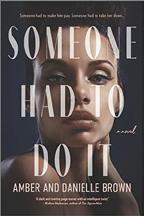
screeching halt when she overhears Simon’s daughter, Taylor, a famous model and influencer, plotting to kill her father so she can inherit his fortune before he marries his much-younger fiancee. Taylor is still reeling from her mother’s death and has developed various addictions she can’t refrain from long enough to pass a drug test and regain access to her trust fund. She also has eyes for Nate, whom she dated in high school and is still in love with. After she figures out, a little too easily, that Brandi overheard her plotting to kill her own father, she gets Brandi fired from her internship and goes about trying first to bribe her, then to destroy her life. This is where the plot becomes hard to believe; despite knowing that a stranger who dislikes her is now aware of the plan, Taylor plots her father’s murder anyway—and not very carefully, either. Switching the point of view between Brandi and Taylor destroys any remaining tension, because the reader is always steps ahead of the characters, most of whom are riddled with clichés. Simon, who only shows up to yell at Taylor, ignore her, or ogle his new fiancee, barely feels like a per son. Taylor is shallow and greedy, and her decisions make her appear frustratingly stupid; at the same time, she thinks she’s
outsmarting everyone merely by talking her way out of things. The fact that other characters often believe her makes them seem to lack intelligence, too. Though a bit too naïve, Brandi is the most interesting character, and her relationship with Nate is the best part of the book.
An easy read but lacking in depth.
Cărtărescu, Mircea Trans. by Sean Cotter Deep Vellum (672 pp.)
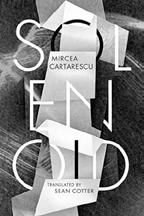
$22.00 paper | Oct. 25, 2022 978-1-646052-02-8
A beguiling novel that plunges deep into subterranean conspiracy theories while questioning the nature of reality.
“You can’t sow the world with dreams, because the world itself was a dream.” The

“A beguiling novel that plunges deep into subterranean conspiracy theories while questioning the nature of reality.”
27-year-old protagonist of Romanian novelist Cărtărescu’s wak ing-dream book is a teacher who has a decidedly Dostoyevskian discontentment with the world: He wanted to be a writer, but one particularly sharp-tongued critic, calling a poem of his “a pointless whirlpool of words,” stopped his literary career in its tracks. Now, at the beginning of the novel, he finds himself bat tling the lice that are epidemic among his students. Parasites are much on his mind throughout this sprawling narrative. So, too, is death a constant preoccupation: Why should he, why should anyone, accumulate knowledge and experience only, in the end, to be annihilated? When not pondering the eternal void, the young man is suspended in a kind of nightly dream state courtesy of the titular solenoid that the previous owner of his house, a protégé of Nikola Tesla’s who spent a long career inventing very strange things, not least of them this particular electromagnetic contraption, left behind, thanks to which, our narrator says, “I always slept aloft, floating between the bed and ceiling, occasionally turning over like a swimmer in a lazy, glittering light.” It’s not the only solenoid hidden away in the back alleys and tunnels of Bucharest, and one day the city itself will float away. Before then, however, our teacher and his girl friend, a physics teacher smitten by theosophy, are drawn into the occult world of a group called the Picketists, condemned by the regime but capable of all kinds of mischief, whose members include a surprising number of people who figure in what passes for our teacher’s ordinary life. Cărtărescu writes poetically and philosophically (“What visceral and metaphysical mechanism converts the objective into the subjective?”), and while the story doesn’t always add up, it’s full of arresting images and eldritch twists that would do Umberto Eco proud.
A masterwork of Kafkaesque strangeness, brilliantly con ceived and written.
Chung, Bora Trans. by Anton Hur Algonquin (256 pp.) $17.99 paper | Dec. 6, 2022 978-1-64375-360-7

Dark and visceral tales shortlisted for the International Booker Prize.

If the first story of a collection is meant to set the tone for the whole vol ume, then “The Head,” the opener to South Korean author Chung’s first work to be translated into English, is a doozy. A young woman is beset by a talking head in her toilet, made from, as the head tells the woman, “the things you dumped down the toilet, like your fallen-out hair and feces and toilet paper you used to wipe your behind.” No matter how the woman tries to silence or destroy the head, it grows and disrupts her life through courtship, marriage, and the birth of her daughter. If it seems surprising that an institution like the Booker Prize would go for gross-out body horror, one need only consider the deft social commentary that underpins Chung’s tales. In “The Embodiment,” for example, a single woman ends
up pregnant from taking too much birth control medication and then is warned by her obstetrician that if she doesn’t find a father for her unborn child, the consequences could be dire. (Spoiler: They are.) Women’s bodies are literally disfigured by social expectations or cultural pressures; children are destroyed by the cruel whims of adults. Money, old age, technology, and intergenerational trauma ruin plenty of things here, too. In the title story, the family business—the making of cursed fetish objects—is passed down through the generations, with one par ticularly disastrous rabbit lamp wreaking havoc on its greedy recipient. Whether borrowing from fable, folktale, speculative fiction, science fiction, or horror, Chung’s stories corkscrew toward devastating conclusions—bleak, yes, but also wise and honest about the nightmares of contemporary life.
Don’t read this book while eating—but don’t skip these unflinching, intelligent stories, either.
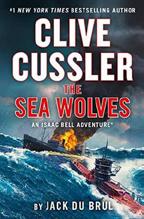
Du Brul, Jack Putnam (400 pp.)
$29.95 | Nov. 8, 2022 978-0-593-42198-7
The 13th in Cussler’s Isaac Bell Adventures series—now written by Du Brul—harkens back to the tumultuous days of the early 20th century.
In April 1914, lowlife Foster “Foss” Gly escapes from a prison on French Guiana. He plans to help the Germans, who are on the brink of war in Europe. Once fight ing begins in August, President Woodrow Wilson publicly tries to maintain American neutrality. But America supplies muni tions and other war materiel to the British in ships that German U-boats frequently torpedo. The Brits hire Isaac Bell, a crack investigator employed by the Van Dorn Detective Agency, to find out why the “sea wolves” have so much success in locating
high-value targets. It cannot be due to chance alone. The reason is that German spies in New York are using the nascent technol ogy of radio, with lighthouses and balloons often helping make critical connections. Bell is an exceptionally talented and brave fellow who can recall in detail every face he has ever encoun tered, and he loves a good challenge. In perhaps the book’s best line, “anticipation fizzled in his veins like champagne bubbles.” But he doesn’t anticipate his old nemesis Gly, and their renewed confrontation is just one part of an action-packed yarn. Bell’s most dangerous task is to find a German-made vacuum tube critical in transmitting radio signals. Ultimately, he boards the RMS Lusitania, which carries “a great many ammunition crates” for the British. The stakes could not be higher. “If you don’t get the vacuum tube,” Bell hears, “the Germans are going on a hunting spree across the length and breadth of the Atlantic, and those men, your brothers, are going to die.” Sadly, the ship is also laden with hundreds of innocent passengers, including women and children. The ill-fated ship sinks to the bottom of the Irish Sea courtesy of a German torpedo, a disaster the author describes in frightening, nail-biting detail. How far will our hero and his compatriot go to reach their prize?
Readers will enjoy Isaac Bell as much as he enjoys his work.

Hacic Vlahovic, Tea Overlook (240 pp.) $26.00 | Sept. 20, 2022 978-1-4197-6289-5
A young North Carolina woman finds more than she bargained for in her local punk scene.
Kat, the 16-year-old narrator of Hacic-Vlahovic’s second novel, is a steady hand at the piano, playing Beethoven and Chopin with ease, but her heart belongs to another kind of music: the punk rock that she’s recently discovered. She started out as a “poseur” but fell in love with the North Carolina punk scene and spends many nights hanging out at Dexter’s Lab, a house that serves as a drunken, drug-fueled haven for local crust punks living like “a million rats, scurrying out from gutters, trash cans, and pipes, taking twisted routes until meeting in a filthy abyss.” As “the least cool person in [her] group,” she’s desperate to belong, and her wish comes true after she hangs out backstage with a visiting rocker and a website reporter who witnesses their conversation proclaims her a “tiny sex martyr” and “local teenage groupie.” Suddenly, she goes from striver to star, earning the respect of her compeers: “Everything boring about me was suddenly fasci nating. My irrelevance turned important. My obscurity became crucial.” Her newfound local fame threatens to poison her life, though: She breaks the heart of a young man who cares for her, almost drops out of high school, and falls for a fellow punk whose terrible decisions are coming close to destroying his life, and hers along with it. Hacic-Vlahovic could have turned this story into a typical cautionary tale, but it isn’t that. The author
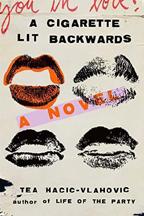

writes about Kat with compassion and respect; she gets Kat and never condescends to her. Kat is a fully fledged character: Beneath her punk-as-fuck exterior, she’s naïve and (though she’d hate to hear it) sweet; while she loves her hard-edged music, she also has an almost childlike fondness for her immigrant parents and grilled cheese sandwiches. Hacic-Vlahovic’s writing is solid, inhabiting Kat’s voice with both hardness and humor: “Teach ers often told me that if I ‘applied’ myself more I could get into Ivy League schools,” the teenager reflects at one point. “So I applied myself less.” This is a self-assured sophomore effort from a writer to watch.
Appropriately hardcore but deceptively sweet, too.
Hase, Seishu Trans. by Alison Watts Viking (320 pp.) $23.00 | Nov. 15, 2022 978-0-59-330041-1
While searching for his own destiny, a dog changes the lives of lost souls.
In the wake of a tsunami in Fuku shima Prefecture, Japan, Kazumasa Nak agaki—a young man working as a delivery driver/getaway car operator—finds a stray dog politely waiting outside a convenience store. From the dog’s collar, Kazumasa learns that his name is Tamon and assumes that this is short for Tamonten, a Japanese guardian deity. And that is exactly what Tamon becomes for Kazumasa and many others throughout the novel: a guardian angel. Tamon protects Kazumasa as he carries out his illicit activities and tries to make money to sup port his family. Tamon brings joy to Kazumasa’s sister and his ailing mother, whose dementia leads her to believe that Tamon is her childhood dog (a pattern throughout as others associ ate Tamon with dogs from their pasts). But Kazumasa knows that Tamon, who is constantly and mysteriously turning to look toward the southwest, is not fated to stay with him, and when circumstances drag them apart, Tamon continues on his jour ney. In a story told in episodic vignettes, Tamon becomes the companion of a criminal, a wife with a deadbeat husband, a sex worker with a dark secret, and, perhaps most poignantly, an old man dying of cancer. Hase’s last vignette finds Tamon with a young boy whose early years have been marked by deep trauma. Hase’s staccato sentences and straightforward narrative struc ture should not be mistaken for shallowness. And while some stories are more affecting than others (“The Couple and the Dog” feels slightly awkward in its narrative arc), Hase’s novel is ultimately a touching meditation on shining lights in the face of trauma and hopelessness: “It’s your dog magic, I suppose. Dogs don’t just make people smile. They give us love and courage, too, just from being at our side.”

Heartbreakingly moving in its simplicity.

Haven, Josh Mysterious Press (288 pp.)
$26.95 | Dec. 6, 2022
978-1-61316-363-4
Criminal enterprises make strange bedfellows.
A week before his release from a prison in upstate New York, Matt Kubel sky gets a call out of the blue from his high school girlfriend Kelly Haggerty, whom he hasn’t seen in nearly 20 years. She has a sketchy busi ness proposition for him. With no other prospects and despite faint internal alarm bells, he accepts. Can he believe her con voluted tale about Qatar and counterfeiting and art insurance and the superchallenging robbery of a cache of Klimt drawings that she wants him to execute? When she flashes some cash and makes herself sexually available, Matt’s all in. His recent prison stint gives him the connections he needs to hire a ragtag crimi nal crew, the most menacing of them “the Nazi Bob Wharton.” Haven’s sinuous, fitful plot teeters on the brink of absurdity, zigzagging from Newark to Florida to Montana to Manhattan. Simmering beneath the cross-country caper is the mutual dis trust between Matt and Kelly, complicated by their sexual com patibility. The story’s perspective, alternating mostly between the two of them, occasionally expands to include other char acters, keeping the reader a tantalizing half-step ahead of the action. The high point comes midway: a hilarious not-so-great train robbery. Rat-a-tat dialogue, concise character delineation, and brisk pacing will remind readers of Elmore Leonard. But Haven also sprinkles diverting sidebars about movies and the art world throughout, from the controversial painter Damien Hirst to the film Casablanca
A rip-roaring roller coaster ride from a fresh new voice.
Hays, Katy Atria (320 pp.)

$28.00 | Nov. 1, 2022
When a young academic is given the opportunity to research esoteric Renais sance art at The Cloisters, she gets caught up in the secrets of the present.
Gifted linguist Ann Stilwell is beyond relieved to escape Walla Walla, where she was born, raised, and where she graduated from col lege after her father’s tragic death. A summer fellowship at the Metropolitan Museum of Art in New York seems like a heavensent opportunity, but when she arrives, she is instead offered a job at The Cloisters, a smaller, more intimate museum. Patrick Roland, the curator, has a fascination with Renaissance occult, a small and specialized field, and Rachel Mondray, another recent college graduate, has been working with him to organize
“While searching for his own destiny, a dog changes the lives of lost souls.”


Close-up on a young woman in the passenger seat of a car, tears glinting on her cheeks, her eyes puffy from crying. She has just turned the last page of Colleen Hoover’s 2016 ro mance phenomenon, It Ends With Us. In one hand she’s clutch ing the book; in the other, she wields the signature tool of the BookTokker: a yellow highlighter.
“Colleen Hoover! Your mama is that chick!…*&^%&! This book is amazing! It really gives you a whole new perspective! ’Cause honestly, I was one of those chicks that was like, ah, just leave him! Just leave him!...WOW! WOW!!”
It Ends With Us tells the story of Lily, a young Boston flo rist whom we encounter on the day of her abusive father’s fu neral, when she has the courage to let everyone know what kind of man he was. That very night she meets Dr. Ryle Kin caid, a devastatingly handsome neurosurgeon who could be even more perfect for her than the boy who got away—Atlas, a homeless kid who tried to protect her from her dad when they were teens. Just as Lily finds out Ryle, too, is violent, At las comes back into her life.
During the shut-in days of the pandemic, BookTok kers like kierralewis75 swept It Ends With Us and the rest
Griffithof Hoover’s catalog onto the bestseller list—at one point, Hoover had 15 titles on the USA Today list at once. Now, ac cording to Atria Books, Hoover has sold nearly 20 million books worldwide.
Said our reviewer, “The relationships are portrayed with compassion and honesty, and the author’s note at the end that explains Hoover’s personal connection to the subject matter is a must-read.”
Or as kierralewis75 put it, and 801.7K viewers affirm, Your mama is that chick!
Thanks to the CoHort, as they call themselves, a sequel, It Starts With Us (Atria, Oct. 18), is currently the most preor dered novel in the publisher’s history. In the book’s first pages, we learn that Lily and Ryle’s brief marriage ended in divorce, but not before they had a baby. As Lily tries to navigate coparenting with her ex, Atlas again shows up in her life, now a supersuccessful restaurateur. Is Lily once again in danger? As before, our reviewer was bowled over: “Through palpable ten sion balanced with glimmers of hope, Hoover beautifully cap tures the heartbreak and joy of starting over.”
We corresponded with Hoover by email to see how she feels about being the darling of what may be the most passion ate generation of readers in literary history.
What did the BookTok explosion look like from your perspective?
Surreal is the only way I can describe it. It feels like I’m watch ing this happen to someone else. My life is very much the same; I’m still a mother and a wife and a sister and a daugh ter, and all of those things come before writer, so it isn’t until I log onto the internet that I’m reminded how much bigger it has all become in the last couple of years. I’ve actually had to refrain from getting online much this year. The attention trig gers my anxieties, so while I absolutely love it when friends and family send me fun videos about my books, I definitely don’t go searching it out.
I read that you have a degree in social work and that you grew up in a household where there was domestic violence. In that light, It Ends With Us and It Starts With Us seem like books with a purpose—perhaps more so than the 20 books that preceded them. Do you agree?
I definitely wrote It Ends With Us wanting to put myself in my mother’s shoes and understand her relationship with my fa ther. I wouldn’t say I wrote the book with more purpose than that—but I absolutely appreciate that people have reached out to say the book helped them take steps sooner to leave abusive situations.

Are you intentionally trying to change the narrative on abusive relationships? Is it working?
My only intent when I write is to explore something personal to me or write something I find touching. If anything, I hate that so many people have said they’ve been in situations simi lar to the situations found in this book. It proves we have a lot of work to do, and while I don’t think this book is meant in any way to change a narrative, I do hope it is at least prompt ing conversations that will open doors for change.
The story of how, at age of 32, you wrote and selfpublished your first book on Kindle so your grandma could read it has become a legend. Can you tell us about the transition from self-publishing to traditional publishing?
I was honestly very nervous to transition to traditional pub lishing. I liked the idea of not having deadlines, and I enjoyed that writing still felt more like a hobby rather than a job. I was worried that moving to a traditional publisher would change my love for it. After my first two self-published titles began re ceiving offers, I chose the lesser offer simply because it didn’t include future books I hadn’t yet written. After signing those two books, I wrote and self-published a third book. It wasn’t until my fourth book and having gotten to know the people at Atria Books that I felt comfortable enough to sign with them, and we’ve had many books together since.
Tell us about the Bookworm Box. The Bookworm Box is a charity I founded with my sisters, Lin Reynolds and Murphy Fennell. We have grown to a team of over 10 people now. We ship out signed books each month to subscribers, and we also have a brick-and-mortar store in Sulphur Springs, Texas. All profit is donated to different chari ties. Since we opened our doors in 2015, we have donated over $1.5 million to hundreds of different charities. We also start ed an annual book signing called Book Bonanza and an on line Book Bonanza fundraiser that many authors and indus try professionals donate items to. This year’s charity raised
over $173,000 for food banks all over the country. We’re very proud of how many authors and readers support these fund raising efforts.
You used to live in a single-wide trailer and now you’re a bestselling author. What do you love about your new situation? Anything you miss?
Life is mostly the same. I’m still surrounded by the same friends and family. When I quit my job and started writing full time, the only thing I missed were my co-workers, but over the last 10 years, I’ve brought them over to my team, and we still get to work together every day. I would say one of my fa vorite things is that I don’t have to dig in the couch cushions to find money for groceries anymore. But if I’m being hon est, I was extremely happy when I lived with my husband and kids in our trailer and made $9 an hour. And I’m extremely happy being surrounded by those same people while also be ing fortunate enough to work my dream job and see the world when I go on tour. I’m confident life would still be great if I never wrote a single book, but it sure is an incredible feeling to know that I do get to write books and that there are people out there who sometimes enjoy reading them.
Marion Winik hosts NPR’s The Weekly Reader podcast. It Starts With Us was reviewed in the Aug. 15, 2022, issue.
adult
an “exhibition on divination,” including the tarot. Ann’s own niche research neatly complements this topic, but she begins to wonder whether Patrick and Rachel might have more invested in the study of the occult than just their academic brains. As Ann digs into research for the exhibit, she becomes closer and closer to the wealthy, beautiful Rachel. She also finds herself attracted to Leo, the irreverent gardener at The Cloisters who plays in a punk band and grows hallucinogenics to sell to bored housewives. Then one night, Ann, Patrick, and Rachel do a tarot reading, and tragedy ensues. Ann must decide whom to trust—and decide once and for all whether she believes in the power of fate or the burden of free will. Hays sets the stage well for what might have been some truly creepy scenes, but those looking for chills should seek elsewhere. In the end, the plot and characters feel too formulaic and familiar to really surprise. Readers might be better served by seeking out Arturo PérezRiverte’s The Club Dumas, Donna Tartt’s The Secret History, or Tana French’s The Likeness Murder! Occult! Obsession! The pieces are there, but the drama just…isn’t.
Kirsanow, Peter Putnam (432 pp.)
$29.00 | Dec. 6, 2022 978-0-593-42228-1
This fast-moving historical thriller written by Kirsanow is the latest in Grif fin’s Men at War series.
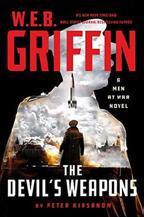
In 1940, before the U.S. joins the war in Europe, the Soviets murder thou sands of Polish prisoners in the Katyn Forest. But they spare Dr. Sebastian Kapsky because secret police chief Lavrentiy Beria senses his value. Then Kapsky escapes with critical mathemati cal equations that may help whomever possesses them to create a weapon of unspeakable power as well as a rocket to deliver it. But American and German intelligence learn about him too, and an exciting three-way chase is on. The American Office of Special Services sends in a small team led by Dick Canidy to find Kapsky in enemy territory and guide him across the Bal tic to safety. “What we’re asking of you is the closest thing to a death sentence the War Department can issue,” Canidy hears from his boss. With the chance of success or even survival at near zero, of course he and his small team are all in. Unfortu nately, Obersturmführer Konrad Maurer and Soviet “assassin without peer” Maj. Taras Gromov are also hot on Kapsky’s tail. Whoever wins the race may determine the future of the war— even the future of the world. There is plenty of throat slitting, trachea crushing, and bloodletting, and readers will fret about who dies next. Kapsky finds help from the Polish resistance, in one case expertly guided by a girl named Lara who is “not even as old as the shoes he was wearing.” The tension never lets up, with twists and turns right up to the end. Maurer and Gromov are rat-bastard villains who perfectly personify America’s foes:
utterly cold and heartless killers. The heroes, of course, are principled men in service of their country, perfectly capable of killing, but only bad guys.
The adrenaline-filled action never stops in this satisfying war tale.

Lage, Jorge Enrique
Trans. by Lourdes Molina
Deep Vellum (180 pp.)
$15.95 paper | Oct. 4, 2022
978-1-64605-182-3
The construction of a freeway in Cuba prompts a host of madcap antics in this surrealistic novel in stories.
A new road is under construction; this novel’s narrator is observing it; his companion, nick named El Autista, is along for the ride, purportedly to make a documentary about it. Within that straightforward structure, though, things get very weird in Lage’s first work translated into English. The narrator performs an emergency heart transplant. Transformers-like robots are built out of hurricanes. A talk ing car arrives on the scene; so does an army of skateboarding girls. The truth behind the marketing disaster of New Coke is revealed. A taco shop becomes a sex shop. The infant on the cover of Nirvana’s Nevermind, now grown-up, has a cameo; so does eccentric chess grandmaster Bobby Fischer. But though none of this holds together conventionally, Lage is working a consistent theme: things falling apart despite outsize civiliza tional efforts to keep them together. To that end, there’s prob ably an allegory to find here about the fate of Cuba in the wake of the Castro era. But the surface-level pleasures are worth experiencing in themselves; Lage’s storytelling is a canny mix of the dystopian, identity-scrambling, futuristic tales of Philip K. Dick (who’s explicitly name-checked) and the queasy themes of Dennis Cooper (not name-checked, but the occasional men tions of necrophilia and flayed skin fit the bill). Toward the end, Lage suggests some of the elements of his literary mission, including “Blurred Genres,” “Animal/Human/Machine Ambigu ity,” and “Surrealist Space-Time.” That may not make the point of the story any clearer, but readers comfortable with mashups of SF, myth, post-colonial literature, and horror will find this a provocative and bemusing yarn.
Satirical, absurdist fun.

St. Martin’s (336 pp.)
$27.99 | Nov. 15, 2022 978-1-2502-4691-2
Estranged siblings embark on a supernaturally guided search for their absent mom.
Five years ago, when Zadie Wilder was 18 and her half sister, Finn, was 12, their mother, Nora, left their Texas home and vanished. Finn went to live with loving foster parents, while Zadie had to fend for herself. The girls grew apart, but now that Finn has graduated high school, they hope to reconnect dur ing a celebratory vacation. Zadie arranges to borrow a friend’s Galveston condo, as she is secretly pregnant with her ex’s baby and wants nothing more than to sit on the beach and get lost in a good book. Then Finn experiences an “echo” of Nora while visiting the zoological gardens. Though Finn has been an
antenna for left-behind memories since she was 8, they’re usu ally just meaningless fragments: “the sound of a doorbell, the drag of water running through hair, the sour scent of newly laid mulch.” This, however, is the most comprehensive echo she has felt and the first she has found left by her mom. Almost simulta neously, Zadie—a reluctant psychic whose premonitions come as intrusive thoughts—is struck by a cryptic phrase: “The sky is full of birds.” Finn suggests they spend the week searching for Nora by following her memories like breadcrumbs. Zadie protests, having never forgiven Nora for leaving, but ultimately relents; even a crappy road trip beats being alone. Wryly funny and tinged with melancholy, Lang’s beguiling tale unfolds via a prismatic third-person narrative that frequently flashes back to contextualize Nora’s disappearance. Exquisitely drawn charac ters imbue Lang’s unconventional plot with verisimilitude and heart, inspiring readers to ponder whether the world is stranger and more beautiful than it appears.
Effervescent, ethereal, and suffused with wonder.

“Estranged siblings embark on a supernaturally guided search for their absent mom.”
Manenzhe, Rešoketšwe
HarperVia (288 pp.)
$26.99 | Dec. 13, 2022 978-0-063-26411-3
In 1927, when “illicit carnal inter course between Europeans and natives” in South Africa is prohibited by the Immorality Act, the van Zijl family’s fate turns tragic.
South African writer Manenzhe’s debut looks back to an especially cruel moment in history when sexual relations between Blacks and Whites were pronounced unlawful, threatening prison for the adults involved. Such is the situation for Abram van Zijl, who’s White, and his “black and English” wife, Alisa, who are parents to two daughters, Dido and Emilia. One horrific decision by Alisa shatters the family early in the book, and it’s her psychology, history, and choices that dominate the story and set the tone. Born the daughter of a slave in Jamaica, orphaned when young, she was adopted by a kindly White man who brought her to England. Alienated and haunted by her birth father and the stories he told her before he died, Alisa has always felt herself unloved, unrooted, con demned to a “legacy of wandering and melancholy.” She travels tirelessly, eventually heading to Africa, sensing she might trace her origins there, but onboard ship she meets Abram, of Dutch and English heritage, and instead discovers a love that will bring her a home and family. Over time, however, the relation ship fades, and Alisa’s unsatisfied need for connection returns, but now the external world is poised to intervene. Manenzhe’s poetic narrative, sometimes dreamy, piercing, and lyrical, at other times denser, is threaded with heartache and suffer ing as well as ancestral myth and symbolism. There are loose ends—questions about Alisa that are not fully answered by long extracts from her journals included in the text. The result is a choppy story of long-endured, compounded oppression. Its closing chapters allow a suggestion of peace, but not for all.
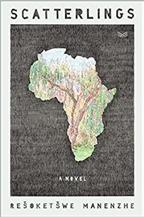
An elegiac view of colonial and racial injustice.

Mark, David Severn House (224 pp.) $29.99 | Dec. 6, 2022 978-0-7278-5055-3
No matter how deeply buried, some secrets have a way of coming uncomfort ably to light.
A brooding, evocative prologue set in 1968 introduces young Cordelia Hem lock, restlessly staring at a joyless gray sea as she stands on the verge of a consequential career with MI6. The story then jumps to 2016, which finds Cordelia comfort ably retired, living in the north of England, and meeting journal ist Paolo Fergus, who’s recently posted a blistering exposé about
death squads in Belize, the threat of revolution in Guatemala in the 1980s, and the involvement of MI6 therein. The puzzle pieces that explain the crimes he’s reported fall progressively into place through alternating narratives from shrewd, quickthinking Cordelia, writing in Guatemala in 1983, and hapless, middle-aged Felicity Goose, offering a different perspective via transcript in 2016. After Felicity and her husband, John, have been inexplicably taken prisoner not far from Cordelia’s current home, John has the unenviable task of explaining his covert past as a spy working with Cordelia to his wife. On one level, the subtly layered novel is a study in contrasts. Mark gets maximum mileage from the disparity between his two female leads. Cordelia responds to threats with cool calculation; Felic ity is understandably distraught—until she comes to display a firm resolve reminiscent of the veteran spy. Simmering beneath the twisty plot are questions about ethics, colonialism, and misogyny that add relevance and raise the novel above many of its familiar spy-story tropes.
A brisk, astute espionage thriller with a compelling moral core.
Moreno, Marvel Trans. by Isabel Adey & Charlotte Coombe Europa Editions (484 pp.) $17.99 paper | Nov. 15, 2022 978-1-60945-802-7

Barranquilla, Colombia, may have spawned a legendary group of male writ ers in the middle of the last century— Gabriel García Márquez included—but young women living there did not enjoy an equally magical time.
Moreno, an associate of García Márquez and the famed “Barranquilla Group,” delivers a comprehensive indictment of the conditions facing woman in that coastal Colombian city in the 1950s. Related from the point of view of the preternaturally observant Lina, who’s looking back on her hometown from an expatriate life in Paris, the novel focuses on the experiences of three young women—Dora, Catalina, and Beatriz—exposing the city’s sexual violence, misogyny, classism, and racism in sharp and unrelenting detail. Railroaded or goaded into marriages and relationships that rarely served to benefit their own sexual or financial interests, the three women experience varying degrees of disenchantment or outright self-destruction in the process. Shadowy Lina, whose life experiences seem to echo some of Moreno’s own, relates the advice and admonitions dispensed by a chorus of older women, her aunts and a grandmother, who have seen all the harms done by generations of men gone before. Each young woman’s story is told with elaborate attention to her history and lineage and those of the men who ensnare and inveigle her into nightmarish alliances. Patience is required to discern the interlocking web of family and professional con nections within the provincial city, and the detail with which Moreno traces who wound up where, when, and with whom

may be daunting to the casual reader. Translated into English for the first time since the novel’s publication in 1987, Moreno’s dense and incrementally meandering prose recites a litany of suffering layered upon suffering.
Man’s inhumanity to (wo)man couldn’t be made any clearer.

Mytting, Lars Trans. by Deborah Dawkin Overlook (448 pp.) $28.00 | Oct. 11, 2022 978-1-4197-5977-2
A sprawling novel about a small Nor wegian village and a young man pursuing his fate.
When Mytting’s latest novel begins, it is 1903. Jehans Hekne is an orphan. He never knew his parents, whose story drove The Bell in the Lake (2020), the first installment in what Mytting has configured as a trilogy. Jehans grows up in the same small Norwegian vil lage as his mother, and Pastor Kai Schweigaard, whom readers of the first book will remember, takes a special interest in his upbringing. Schweigaard is preoccupied by a search for a miss ing tapestry woven centuries ago by Jehans’ ancestors Halfrid and Gunhild, conjoined twins who became extraordinarily tal ented weavers. Meanwhile, Jehans meets a mysteriously familiar British hunter in the woods and, at the same time, deepens a rift with the uncle who keeps him locked in a kind of indentured servitude. The plot of this second leg of Mytting’s trilogy isn’t nearly as taut as the first—indeed, it grows baggy and unwieldy as the book goes on, eventually stretching to encompass World War I and the 1918 influenza epidemic. Nor are the characters nearly as well developed as their predecessors: In the first book, Jehans’ mother, Astrid, was a force to be reckoned with; in the second, Jehans himself remains undeveloped and unknowable. Mytting is most successful in his depictions of cloistered, claus trophobic Norwegian communities and their spiritual and cul tural traditions, from hunting reindeer to churning butter and weaving. There are moments of beauty in the book—a scene in which Jehans buys a rifle is particularly moving—but neither the characters nor the storyline ever get their feet off the ground.
The second installment in Mytting’s trilogy doesn’t quite carry the power and charm of the first.
Novakovich, Josip
Dzanc (200 pp.)
$16.95 paper | Dec. 13, 2022
978-1-950539-64-2
A would-be wine importer finds him self enmeshed in a Russian espionage plot.
In the wake of turmoil in both his personal and professional lives, an American man named David travels to Russia in the mid-2000s seeking to start a new career as a wine importer. Readers expecting a predictable story of a midlife crisis abroad will be surprised by where Novakovich’s novel heads. As David observes at one point, “My love of Russia was an illness, a self-destructive vortex”—and that vortex takes him to some decidedly strange places. An arrest for public urina tion finds David in an increasingly high-stakes legal nightmare, one in which he is imprisoned and regularly shaken down for bribes. (A confirmed bibliophile, David frequently comments on the limited selection of books available to him in prison.) At one point, David raises the possibility of his meeting Vladimir Putin when talking with the prison’s warden: “There could be several novels about Putin. Maybe a trilogy? Putin’s judo youth, Putin in DDR, Putin in Grozny. Can I talk to him?” And then Putin shows up, trying out judo moves on the residents of the prison, and becomes convinced that David would be the per fect person to carry out a sinister mission overseas. David tries to explore the possibility of a nonviolent task instead—“You know, I’d rather not kill anybody. Could I just interview you and publish your biography?”—but is rebuffed and finds himself en route to Georgia. “Maybe I could consider myself an FSB agent? Maybe I was?” he ponders. But throughout the madcap plotting, a pervasive sense of menace never dissipates.
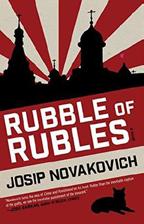
An international comedy of errors that ventures to know ingly bleak places.
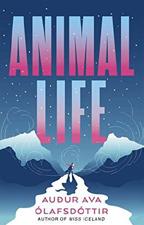
Ólafsdóttir, Auður Ava
Trans. by Brian Fitzgibbon Black Cat/Grove (196 pp.) $15.99 paper | Dec. 6, 2022 978-0-8021-6016-4
An Icelandic midwife, from a long line of midwives, tries to decipher the meaning of the unpublished manuscripts her beloved great-aunt and mentor left in her care before dying.
The week before Christmas, Iceland braces for a storm of frightening proportions. Alone in the apartment she inherited from grandaunt Fífa, Dýja takes phone calls from her meteo rologist sister about the increasingly extreme weather caused by climate change, strikes up a limited but potentially flirtatious relationship with an Australian tourist renting the apartment
“A sprawling novel about a small Norwegian village and a young man pursuing his fate.”the reindeer hunters
upstairs, and fixes up Fífa’s run-down flat with the help of a younger midwife. But rudimentary plot aside, the real focus of the book is on Dýja’s ruminations about her own and Fífa’s belief systems about life and death. Tellingly, Dýja, who gave up theology for midwifery, reveals that midwife means “mother of light” in Icelandic, and it’s considered “the most beautiful word in our language”; in rather obvious contrast, her parents run a funeral home. Childless women devoted to delivering other women’s babies, Dýja and Fífa see themselves and the world around them with concrete, spare objectivity that readers may find either refreshing or off-putting. Emotions are not dis cussed and only rarely acknowledged. Instead, this slim novel packs in a lot of factual information, from the sex life of bono bos to the worldwide death rate of women in childbirth—830 a day! Midwifery is the subject but also the metaphor, as is Ice land itself, a nation where people value light since it’s in short supply. Dýja struggles to decide if Fífa’s three manuscripts, shared in snippets, are drafts covering a main theme from dif ferent angles or separate entities. Certainly, Fífa seems ahead of her time as she rails against man’s effect on Earth’s survival in
the 20th century. Although sexual relationships are mentioned, how they fit into each woman’s life remains mysterious. Both women emphasize the noun man throughout, and it is pointedly vague whether Fífa includes women when she voices her belief that man is inferior to other animals.
Like her characters, Ólafsdóttir’s novel is emotionally chilly while intellectually passionate.
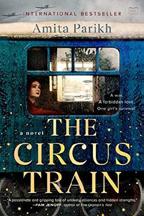
Parikh, Amita Putnam (384 pp.)
$17.00 paper | Dec. 6, 2022 978-0-593-53998-9
The ambitious daughter of a famous illusionist grows up aboard a circus trav eling through Europe—till the arrival of World War II throws her world into chaos.
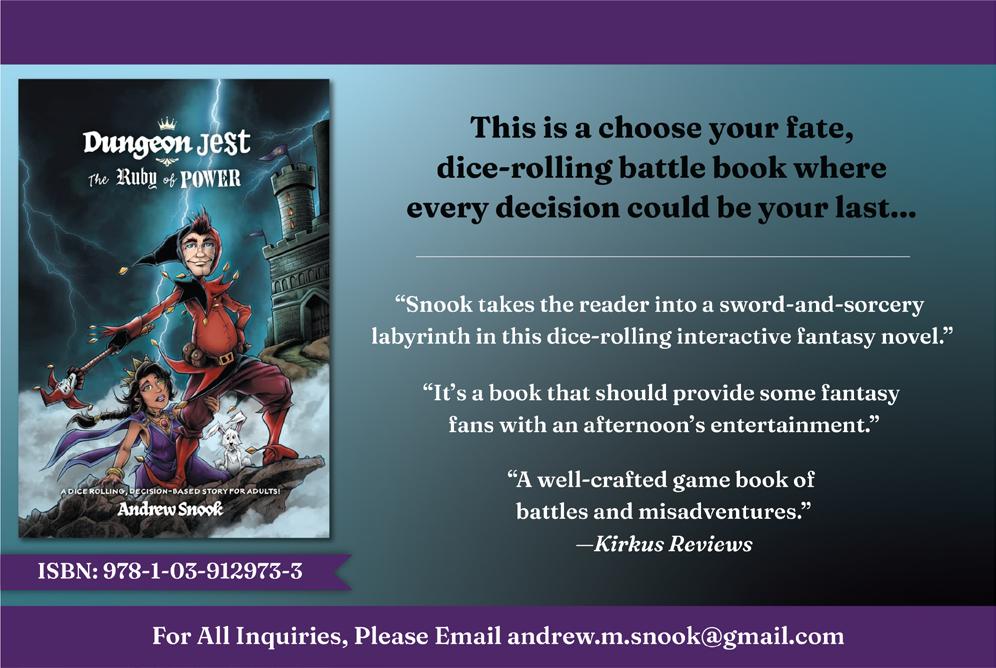
Even within the traveling circus she’s always called home, Lena Papadopoulos has always felt different. Dependent on a wheelchair after a harrowing infant case of polio that also left her motherless, Lena has never been accepted by the other circus children; instead of playing with them, she spends her time reading and attending museum exhibits with her doting, overbearing father, Theo. Only within her studies does Lena feel truly at home—a brilliant student, she’s especially drawn to medicine and science, which is, she thinks, “where the real magic lay.” She passes her days poring over complicated anatom ical diagrams and playing in the circus train’s hiding places—till the arrival of a runaway named Alexandre, whose unconscious body Lena stumbles across one day. Like Lena, Alexandre is an outsider—a Jew and an orphan—and, as he recovers from an illness aboard the train, he and Lena become fast friends over marathon games of gin rummy and shared snacks. Meanwhile, Theo takes wily Alexandre under his wing as an apprentice illusionist. But just as Lena’s life begins looking up, the circus’s crowds thin with Europe teetering on the precipice of war. And soon after Alexandre’s identifying papers go missing from the circus master’s office, SS officers capture Alexandre and Theo, whose parting words to his daughter—” I will find you. I prom ise”—echo in Lena’s ears for years to come. While Lena strug gles to accept her father’s and Alexandre’s presumed deaths (unbeknownst to her, the two have been contracted to work as entertainers in a “model town” for Jews), all three fight to sur vive. Immersive and intricately plotted, this novel brings to life the precarious, colorful world of circus performance in prewar Europe, where nothing is as it seems, danger lurks around every corner, and success is a matter of confidence, luck, and risk. Lena, Alexandre, and Theo are lovable characters, each backed by three-dimensional backstories that expand and intersect sat isfyingly as the novel progresses. Though the romantic thread is underdeveloped, Parikh has created a carefully researched historical debut whose bighearted, sensitive protagonist makes the reader’s emotional journey well worth it.
Lively and richly detailed.
Perišić, Robert Trans. by Vesna Maric Sandorf Passage (408 pp.) $21.95 | Nov. 1, 2022 978-9-53351-399-7
Lyrical novel of the ancient Mediter ranean by Croatian writer Perišić
Three principal characters move Perišić’s loping tale. The first is Miu, a cat, which, like all cats, “does not know the difference between a palace and a neglected yard.” The second is young Kalia, a son of Sparta’s sole colony, who, in another colony, finds himself enslaved. The third is a persistent wind, which explains, “I’m not an ordinary spirit, the way people imagine—a person’s ghost or some such thing—but I am from a family of wind
spirits, dragged from the upper parts of the atmosphere by some dramatic events.” Floating back and forth among con tending Carthaginians and Syracusans, the wind comments on the ways of the world even as humans, with all their vain wishes, find new ways to invite the gods’ wrath. The obnoxious child of Kalia’s owner tries to torture Miu, ordering Kalia to perform the most savage of acts, bellowing, “I am her master and she needs to love me. She needs to hate you!” It doesn’t work on animals, animal behavior being one of the wind’s chief topics. It certainly doesn’t work on Kalia, who rebels, stealing away to yet another colony far up the neck of the Adriatic Sea in what is reputed to be “the end of the world,” a place called Liburnia, modern Croatia. Perišić takes his time in pulling the threads of the story together, and in any event that story is less memorable than the delightful apothegms with which he adorns his prose. The wind always has the best lines—including, thousands of years after Kalia’s time, while looking down at an alley cat that may well be a descendant of Miu’s, a wistful reminder that she (our wind is a female) needs to find balance lest she go crazy pondering the ways of humans: “That would not be good for the climate. Everything is quite wobbly already.”
A graceful meditation on history and nature by an author well worth knowing.


Prusa, Carolyn Atria (336 pp.) $27.00 | Nov. 8, 2022 978-1-9821-8886-3
As Hurricane Matthew sweeps toward Savannah, Georgia, a woman’s life begin to fall apart.
Ramona, 38, is wife to Desmond, mother to 7-year-old Alex and 3-year-old Nanette, daughter of Adelaide, and employee of Kenneth of the too-tight trousers. She is also a fan of Prince and a one-time painter and art stu dent. Ramona has a cleareyed view of everyone around her, see ing them as entire people with parts she loves (well, for family and friends) and parts she doesn’t. With an evacuation order looming, she rushes from work to pick up her daughter from her friend/babysitter’s house because she can’t get a hold of her husband. When she arrives home with Nanette in tow, she finds a fellow mom standing in front of the fridge drinking the last coconut La Croix, and then her husband appears in his boxers. Clearly, the pair are post-coitus. The story follows Ramona’s efforts to get her kids and mother evacuated to safety as the storm bears down on them, fending off calls from her husband and the fellow mom as she tries to buy time to figure out what went wrong with her marriage and how she feels about it. This story is told episodically, with Ramona’s memories of past expe riences, moments, and Prince songs interspersed with a time line of her evacuation efforts. Author Prusa does a very good job of presenting all the stress of potty training a toddler while
managing their outrageous behavior; convincing a cantanker ous senior mother to do something (that is, evacuate) when she doesn’t want to; managing a boss’s unreasonable expectations during a natural disaster; and trying to create an outward sense of calm and safety for others when inner turmoil is almost out of control.
A story that explores how individual identity and happiness can be unintentionally misplaced in marriage and motherhood.
Shevelev, Mikhail Trans. by Brian James Baer & Ellen Vayner Europa Editions (160 pp.) $17.00 paper | Oct. 11, 2022 978-1-60945-811-9
A hostage crisis in a village near Mos cow raises questions about Russian mili tary aggression in recent years.
A journalist named Pavel Vladi mirovich, the book’s narrator, becomes embroiled in the news in 2015 when a group of men take 112 people hostage in a church. The group’s Russian leader, Vadim Petrovich Seryegin, known as Vadik, wants Pavel to serve as one of his negotiators. Pavel had helped get Vadik released when he was captured during the First Chechen-Russian War (1994-1996). Flashbacks and conversations between Pavel and Vadik fill in the subsequent years, touching on ethnic conflicts since the Soviet Union’s collapse in 1991 but mainly on the wars involving Chechnya and Ukraine. (Beyond the glossary pro vided, the author assumes a considerable knowledge of the relevant history.) Shevelev, a Russian journalist who has pub lished another novel and collections of short stories, gradually reveals how Vadik became a terrorist and how Pavel grew cyni cal about news media—two paths that give the author room for mordant comments on politics, violence, police and KGB abuses, and journalism. While one man turns to threatened slaughter unless Putin publicly apologizes for the Chech nya and Ukraine wars, the other writes a six-page screed on those who do nothing, mainly Russians who fail to oppose the Kremlin: “A hundred people gathered on Pushkin Square in Moscow when the second war in Chechnya began and Gro zny was completely leveled to the ground.” (The translation by Baer and Vayner conveys well Pavel’s savvy, rueful voice.) The central point is failure. Shevelev is quoted in introductory material saying that he turned to fiction because journalism stopped being an “effective tool” for change. Among Vadik’s last comments to Pavel is: “I want to understand why all your words missed the mark.”
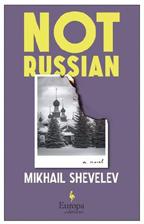
A taut, elegiac political thriller and a fierce swipe at Putin’s efforts to make Russia great again.

Atria (256 pp.)
$26.00 | Nov. 29, 2022 978-1-6680-0266-7
An illicit Dungeons & Dragons man ual sparks a revolution within a young North Korean.
Cho Jun-su, the hero of Theroux’s expert, engrossing seventh novel, is 11 when he fatefully discovers a copy of a Dungeon Masters Guide a foreign visitor left it behind at the hotel where Jun-su’s father works. Jun-su is frightened by the book’s inscrutable con tents—foreign media is suspect under the dictatorship’s iron rule—but he begins to decipher the book with the help of an English-speaking teacher, who dubs the game the House of Pos sibility. D&D’s core concepts of assuming different roles and having multiple life choices are baffling but inspiring for the young man, who soon gets attention for his inventive poetry— work that in time introduces him to the nation’s elite. Theroux offers a cross section of North Korean society, from brutal work camps where assassinations are common to the wealthy, druggy orbit of Kim Jong Il’s friends and family to the desper ate efforts of bureaucrats to cadge money for its starving people via ransomware and insurance fraud. But the heart of the story is consistently Jun-su, who navigates the traditional matters of maturity—love, sex, friendship—alongside a growing under standing of opportunities and mindsets that his friends and family aren’t privy to. (When his D&D knowledge is discovered, he becomes both an object of fascination for academics and a target for persecution.) That makes the novel a remarkable bildungsroman; here, identity is both blossoming and severely suppressed. (As Theroux writes. “How did someone created by one reality begin to operate by the rules of another?”) Theroux’s deliberately flat, investigative-reporter tone clarifies the cri sis—Jun-su is in a society stripped of anything decadent, and Theroux lets the twists of Jun-su’s adventure, not the prose, sell the story.
A cleverly imagined tale of psychic repression and escape from it.
Torday, Daniel

St. Martin’s (304 pp.)
$27.99 | Jan. 17, 2023 978-1-2501-9181-6
Heavily armed Jewish mystical cult meets weed-legalization conspiracy meets renewed college love affair meets ecstatic highs of various persuasions.
“Zeke turned onto Shabbetai Road, where he encountered all at once: an RV with an immense airbrushed painting of the face of Nathan
“An illicit Dungeons & Dragons manual sparks a revolution within a young North Korean.”
Fritzman, Natan of Flatbush, Hebrew lettering atop the image; two trailer homes in the near distance; a single two-story colonial set back from the road; and in front of each of these buildings, men in traditional Hasidic garb carrying automatic rifles.” Following his exploration of a splinter social movement in Boomer1 (2018), Torday dives deep into the beliefs, text, prac tices, and marijuana operation of an imaginary Jewish cult with ties to both the Satmar of New York and the Dönme, Turkish Jews who feigned conversion to Islam. His protagonist, Ezekiel “Zeke” Leger, is a New York–based journalist and magazine edi tor who travels back to Central Ohio for the funeral of a col lege friend. Shortly after he arrives, an Uber driver suggests he investigate the story of Nathan Fritzman, a Jewish cult leader currently jailed for the murder of his 16-year-old son. Turns out Zeke’s college girlfriend, Johanna Franklin, was the lead pros ecutor for the state. Those who are interested in the revival of the love affair between Zeke and Johanna, who met as under grads at William James College, an Oberlin look-alike, may be less interested in the mystical and unconventionally punctu ated writings of Natan of Flatbush concerning the tenets of Ein Sofism, which are included here at some length. Those who are following the investigation of the murder of Fritzman’s son and its connection to the various groups fighting tooth and nail for control of legalized weed in Ohio may find themselves floun dering during extended descriptions of drug-induced experi ences. But through it all, Torday’s redoubtable novelistic chops produce a steady stream of strong dialogue and sharply drawn scenes.
The disparate elements of this ambitious mashup may make it difficult for it to find its ideal readers.
a formidable housekeeper who turns out to be a good friend to Isabel. Unfortunately, the same cannot be said for Teddy’s unhappy sister, Matilde, who’s decidedly unfriendly. Isabel and Teddy’s delightful time together is marred when Tuppence loses a scone-baking contest to her archenemy, Hyacinth Amesbury, whom Matilde has kept as a friend even though Hyacinth stole her boyfriend and whose determination to win every battle knows no bounds. While Isabel is walking Teddy’s corgis one day, they take off and start digging up Hyacinth’s flower bed, where Hyacinth herself turns out to be planted. Fortunately, Inspector Barclay Carlyle, who has little experience with mur der, is happy to let Isabel and Teddy help, and they quickly dis cover that Tuppence and Matilde are far from the only ones who might want Hyacinth dead.
A highly enjoyable travelogue-cum-mystery that’s just plain fun to read.
Connelly, Michael Little, Brown (400 pp.) $29.00 | Nov. 8, 2022 978-0-316-48565-4
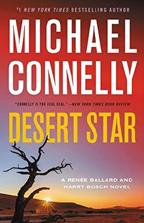
A snap of the yo-yo string yanks Harry Bosch out of retirement yet again.

Byrne, M.V. Kensington (304 pp.) $16.95 paper | Nov. 29, 2022 978-1-4967-2835-7
A dream trip to Cornwall immerses Isabel Puddles in yet another case of murder.
In her hometown of Gull Harbor, Michigan, Isabel has gained a reputa tion as a sleuth. Her best friend, Frances, doesn’t think she should travel to England by herself, but it’s too late, all is arranged, and Isabel is soon off to spend some time with her friend Teddy Mansfield, better known as the pseud onymous mystery novelist Archie Cavendish. Though Isabel’s disappointed when a last-minute glitch prevents Teddy from meeting her in London, she makes the best of her stay before leaving for Cornwall, where Teddy introduces her to Tuppence,
Los Angeles Councilman Jake Pearl man has resurrected the LAPD’s OpenUnsolved Unit in order to reopen the case of his kid sister, Sarah, whose 1994 murder was instantly eclipsed in the press by the O.J. Simp son case when it broke a day later. Since not even a councilor can reconstitute a police unit for a single favored case, Det. Renée Ballard and her mostly volunteer (read: unpaid) crew are expected to reopen some other cold cases as well, giving Bosch a fresh opportunity to gather evidence against Finbar McShane, the crooked manager he’s convinced executed industrial con tractor Stephen Gallagher, his wife, and their two children in 2013 and buried them in a single desert grave. The case has haunted Bosch more than any other he failed to close, and he’s fine to work the Pearlman homicide if it’ll give him another crack at McShane. As it turns out, the Pearlman case is consid erably more interesting—partly because the break that leads the unit to a surprising new suspect turns out to be both fraught and misleading, partly because identifying the killer is only the beginning of Bosch’s problems. The windup of the Gallagher murders, a testament to sweating every detail and following every lead wherever it goes, is more heartfelt but less wily and dramatic. Fans of the aging detective who fear that he might be mellowing will be happy to hear that “putting him on a team did not make him a team player.”
Not the best of Connelly’s procedurals, but nobody else does them better than his second-best.
de Giovanni, Maurizio

Trans. by Antony Shugaar World Noir (384 pp.)
$18.00 paper | Jan. 31, 2023 978-1-60945-727-3
Commissario Ricciardi faces murder among a theatrical troupe whose mem bers are just as devious as he is.
No one, least of all himself, disputes the fact that fading theater star Michel angelo Gelmi ended the second evening show of the revue at the Teatro Splendor by shooting his co-star and wife, Fedora Marra. This time, however, the beloved star didn’t rise for her curtain call because someone had substituted live ammunition for the blanks with which Gelmi had shot her repeatedly in the run-up to Christmas 1933. Gelmi swears he never would have killed the love of his life intentionally; Erminia Pacelli, the dresser for the Teatro Splendor, insists that she was stationed outside the door of Gelmi’s dressing room before the perfor mance began and saw no one enter. It’s up to Commissario Luigi Alfredo Ricciardi and his sidekick, Brigadier Raffaele Maione, a conscientious detective but a terrible driver, to sort out the case. Readers who know more than they do may be distracted by the problems faced by Livia Vezzi, a widow who’s under pressure to get very, very close to Maj. Manfred von Brauchitsch, a visiting German officer whose advances Enrica Colombo has rejected because she’s in love with Ricciardi, and by Lina Scuotto, a prostitute who’s been beaten nearly to death by someone whose identity nearly everyone her favorite client, medical examiner Dr. Bruno Modo, talks to seems to know but won’t reveal. Ric ciardi’s superior, who can’t see why he hasn’t arrested Gelmi, keeps him on a short leash. Fortunately, as Maione reflects, there’s still time to investigate because “nobody’s going to kill anyone between Christmas and New Year’s Day.”
Even fans of the series are likely to be surprised when the curtain finally falls.

Hollis, Lee Kensington (288 pp.)
$8.99 paper | Nov. 29, 2022 978-1-4967-3653-6
Chaperoning a class trip is the nextto-last thing two private investigators have in mind. The last thing is murder.
Even though Maya Kendrick’s hus band has been released from jail and their 17-year-old daughter, Vanessa, is ready to resume their family life as it was before he was con victed, Maya knows it will take time before the two former police officers can mend their relationship. While she’s still struggling, the principal of the high school attended by Vanessa and Ryan, the son of Maya’s business partner, Sandra Wallage,
calls Maya and Sandra in not to offer a paying job but to ask them to chaperone a field trip. Maya immediately says no, but Sandra leaves the door open, and soon they find themselves on the way to Washington, D.C., in a school bus driven by an aging retiree with a death wish. Sandra, the soon-to-be ex-wife of Sen. Stephen Wallage, knows backbiting Washington society all too well. When she and Maya find Stephen’s intern, Tess, dead in his bed, the police initially consider her death a suicide, but the pair take on the case thinking that even if Stephen can stay out of prison, his career will need help. And they’re right, because Stephen’s political enemies call for his resignation and even plant stories with the press to make him look guilty. The sleuths must not only rescue Stephen by finding the real killer, but ask which of the students they are chaperoning might be suspects.
A class act whose two strong women face both murder and marital problems with courage and humor.

Morrissey, Hannah Minotaur (304 pp.) $27.99 | Dec. 6, 2022 978-1-2507-9597-7
A pair of murky mysteries haunt the residents of a deceptively sleepy Wiscon sin town.
In wintry Black Harbor, Morgan Mori goes on an impromptu first date with Bennett Reynolds, CEO of a pri vate equity firm, after a gig photographing a family Christmas celebration at the Reynolds estate, a “sea glass-colored mansion at the top of the bluff.” Their mutual chemistry becomes clear when Morgan shares how she’s landed back home in Black Har bor after an unhappy tenure in nearby Chicago. Later that same night, as she stops at a gas station, she witnesses the murder of police detective Brix Garrison. Alternate chapters are told from the perspectives of Morgan and Garrison’s partner, Ryan Hud son, who is introduced already surveying the Fast Mart crime scene before the chapter describing Morgan’s arrival. Hudson is haunted by the crime and driven to solve it. The intriguing result is that significant plot details are doled out piecemeal. For example, Hudson’s on-again, off-again affair with Garrison’s wife, Noelle, isn’t revealed for nearly 100 pages. Timelines are also often tantalizingly fuzzy. Fittingly, the story focuses on two unsolved crimes: the murder of Garrison and the disappearance of Clive Reynolds, wealthy patriarch of that influential Reyn olds family, 20 years ago. Morrissey is unstinting in piling on the creepy atmosphere, from Morgan’s surname to Black Harbor to a part of town called “The Ruins” to her title, which refers to a classic car, a Porsche 930 Turbo, registered to Clive Reynolds.
An intriguing mix of police procedural, gothic potboiler, and psychological thriller that will keep readers on their toes.
“A pair of murky mysteries haunt the residents of a deceptively sleepy Wisconsin town.”
the widowmaker
Oliver, Katie Berkley (320 pp.)
$8.99 paper | Jan. 3, 2023 978-0-593-33763-9
A Jane Austen Murder Mystery week spawns an actual homicide. Who’d of thought it?
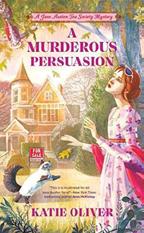
Bent on dissuading her aunt, Wendy Prescott, from selling the struggling Lau rel Springs Inn, Prof. Phaedra Brighton, of Somerset University, hatches the idea of sponsoring a seven-day event that will attract Austen fans from across Virginia, assign them roles in a climactic staging of Persuasion, encourage them to dress in period costume and inhabit their characters during the run-up, and dole out clues as to which character is going to kill which. Phaedra’s carefully crafted plot is promptly upstaged by the unknown party who shoots overbearing Regency romance novelist Harriet Overton dead with an arrow. All the guests had ample opportunity to kill her, and most of them have motives. Her henpecked husband, Tom Overton, was a college archer before his marriage made him a worm ripe for turning. Harriet had trashed technical edi tor Felicity Penrose’s attempt to write a romance novel years ago. And she was pretty clearly blackmailing Rollo Barron, a Richmond Times Dispatch journalist whose review of her latest, The Duplicitous Duke, morphed literally overnight from a pan to a paean. The killer, not content with hitting a single target, locks Phaedra in an uninhabited house’s coal cellar shortly after she rescues Victoria Sutton, the administrative assistant to real estate broker Brian Callahan, from the bottom of a well. The distraught heroine finds it hard to trust the motives of Brian, Wendy’s high school boyfriend, or Prof. Mark Selden, the Brit ish Shakespearean who’s uncomfortably attentive to her. The celebration ends up largely forgotten in the rush to identify the killer before the end of the week.
Just the thing for readers who think Donna Andrews’ Vir ginia cozies could use a drop of Jane Austen.
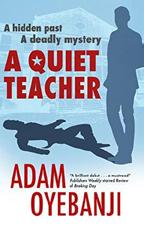
Oyebanji, Adam Severn House (224 pp.) $29.99 | Nov. 1, 2022 978-1-4483-0942-9
A high school teacher battles demons past and present while helping a col league accused of murder.
After losing an eye during a mission in Djibouti that almost cost him his life, Greg Abimbola is happy to spend his days teaching French and Russian at Calderhill Academy, a pri vate school catering to the privileged children of Pittsburgh’s Shadyside and Squirrel Hill neighborhoods. If Americans assume his British accent is Australian—because surely a Black
person could never be English—that’s just part of the price he pays for enjoying the rolling hills of the Monongahela Valley and the vibrant cultural scene of a medium-sized American city where the Russians who tried to kill him in Djibouti would never think to look for him now. And of course nobody would guess that his British accent is also a ruse, hiding the native Rus sian he learned from his African expatriate mother. Greg tries to maintain his integrity while keeping his head down and his powder dry. He listens sympathetically to chemistry teacher Demetrius Freedman’s withering observations on race in Amer ica but avoids becoming an activist himself. He struggles with same-sex urges his strict Russian Orthodox upbringing teaches are sinful. He’s fair to his students and resists parents’ demands to give unearned A’s but tries not to ruffle feathers. But when Lindsay Delcade, a parent who raises entitlement to an art form, is found dead in the basement, it becomes increasingly hard to remain neutral—especially when the police focus their investi gation on Andrea Velasquez, a young, vulnerable assistant custo dian Greg is sure can’t be guilty.
Oyebanji’s hero is complicated and sure to win readers’ sympathies.
Rankin, Ian Little, Brown (352 pp.) $24.99 | Oct. 18, 2022 978-0-316-47363-7

Criminal Investigation Department pensioner John Rebus is lured from forced retirement by the world’s most unlikely client.
Wheelchair-bound Morris Gerald Cafferty, known by every criminal in Edinburgh as Big Ger, feels uncharacteristically guilty over the pressure he put on Jack Oram, who managed the Potter’s Bar for Cafferty and helped himself liberally to the till before vanishing four years ago. Now that he’s heard rumors Oram’s back in town, he’d like his old nemesis to track the embezzler down so that Cafferty could have a word with him. Initially incredulous, Rebus agrees to poke around. Meanwhile, Rebus’ old mate DI Siobhan Clarke is looking for another missing person—Cheryl Haggard, who has enough scars to present convincing evidence against her hus band, Francis, a uniformed cop accused of domestic violence. Clarke’s old frenemy DI Malcolm Fox, a hotshot who’s vaulted into the Specialist Crime Division, wants her investigation shut down before Francis Haggard can retaliate by implicat ing half his fellow officers on the Tynecastle force. When Fran cis takes the dilemma out of Clarke’s hands by going AWOL and turning up conveniently stabbed to death, everything’s resolved—except for all those accusations about the Tynecastle constabulary, and the fate of the dead-or-alive Jack Oram, and what looks increasingly like a revolving door between Edin burgh’s criminal establishment and Edinburgh’s finest. Rebus and Clarke soon establish connections between his case and
hers, but that unsurprising news is only the beginning of a series of detonations, figurative and literal, that will ultimately land Rebus, as a teasing prologue shows, standing in the dock himself.
Two years after his checkered hero’s last outing, Rankin makes you feel the wait was worth every day, whatever comes next.
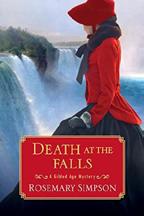
Simpson, Rosemary Kensington (368 pp.) $27.00 | Nov. 29, 2022 978-1-4967-3336-8
A call for help on a matter of law turns into a treacherous case of investi gative work in 1890 New York.
Prudence MacKenzie and her part ner, former Pinkerton agent Geoffrey Hunter, have formed an investigative law firm in New York City. A note from Prudence’s aunt, Lady Rotherton, sends the pair to Niagara Falls to help a friend of hers. Although the falls were made a state park in 1885, factories still mar the landscape five years later, and big money is sniffing around the possibilities for hydroelectric power. Lady Rother ton’s friend Lady Ernestine Hamilton, who lives on the Cana dian side, is trying to protect a 17-year-old girl named Rowan Adderly, whose rapacious grandmother was horrified when her son married a beautiful Irish singer. Now Rowan, the couple’s daughter, is set to inherit a large fortune. When both her par ents were presumed dead, Rowan was removed from board ing school and put into service. Now she’s hiding in a cabin in the woods with a blind man and his protective dog while her grandmother tries to have her declared illegitimate. Prudence and Geoffrey soon become involved in the hoopla surrounding the falls, led by Crazy Louie Whiting, who’s constantly building barrels in an attempt to successfully send a human over the falls. When the body of odd jobber Martin Fallow is found in a barrel supposedly containing a sheep, his death turns out to be murder. Losing no time, the sleuthing couple send for their secretary, Josiah Gregory, to investigate any relevant paperwork about the Adderlys and for tough and clever Amos Lang, another former Pinkerton, who gets a job with Crazy Louie. The shocking truth they uncover puts everyone involved in great danger.
Historical descriptions of Niagara Falls are a bigger treat than a mystery replete with dead ends.
St. Anthony, Joyce
Crooked Lane (288 pp.)
$26.99 | Nov. 8, 2022 978-1-63910-115-3
Newspaper editor Irene Ingram has barely recovered from her near-fatal involvement in helping solve a murder when death arrives again.
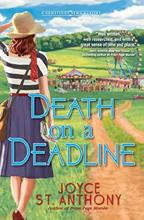
Irene is running her father’s paper, the Progress Herald, while he’s serving as a war correspondent and her fiance is in training for service in World War II. The biggest news in the small town of Progress, Pennsylvania, is the arrival of Hollywood stars for the war bond drive. Hairdresser Ava Dempsey, whose sister, a minor movie actress, claims to know all the latest gossip, announces that they can expect Clark Gable. Ava’s beautiful sister, Angela, is at odds with her actor husband, Freddie Harrison, whose claims of undying love are undermined by his numerous affairs. The death of a neighbor’s son brings the war close to home and makes the locals more eager to buy war bonds even though the closest they come to Gable is a series of minor players like Angela, Freddie, and Kirk Allen, who’s become virtually unrec ognizable as the former Eugene Allen since he left town and morphed into a handsome man set on an acting career. When Freddie turns up dead in the dunk tank at the local carnival, Irene jumps in to help her future father-in-law, Police Chief Walter Turner. Angela, who threatened her cheating husband, is an obvious suspect, but so are many of the other performers who were less than fond of Freddie. Freddie’s little black book, which contains code names and sums for people he was black mailing, opens up a new and dangerous line of inquiry.
A warmhearted tale of a small-town attempt to aid the war effort, complicated by greed, jealousy, and murder.
adult
Cochrun, Alison Atria (368 pp.)
$17.99 paper | Nov. 1, 2022 978-1-9821-9113-9
A struggling artist strikes up a mar riage of convenience with her one-night stand’s brother in this holiday romance.
For 25-year-old Elena Oliver, the one consistency in her life is failure. A year ago, Ellie moved from small-town Ohio to Portland, Oregon, for her dream animation job at Laika Stu dios only to collapse under her boss’s high expectations. Her

mother, Lindsey, calls solely when she’s in need of some cash, which Ellie is hard-pressed to find with her current barista gig at Roastlandia and pending eviction. Yet a year ago, Ellie immortalized her most painful failure into a webcomic, Snow Day, about her whirlwind 24 hours—on Christmas!—with a woman named Jack. One year later, still reeling from her failed romance, Ellie is desperate to make ends meet—desper ate enough to accept a harebrained marriage proposal from Roastlandia’s landlord, Andrew Kim-Prescott. The soon-to-be millionaire has just learned of a stipulation in his grandfather’s will stating that he and his sister must find spouses in order to receive their $2 million inheritances. Andrew offers Ellie 10% of his earnings if she marries him and spends Christmas with his family, and soon enough Ellie is en route to the lavish Prescott cabin. Anticipating family fun and a fast pass to a lifesaving income, the last thing Ellie expected was to spend two weeks baking cookies and singing carols with Andrew’s sister, Jac queline—better known as Jack. Thrust into a “love trapezoid” with Jack, Andrew, and Andrew’s stormy ex, Dylan, Ellie must confront her past with Jack without jeopardizing the financial futures of everyone involved. Cochrun’s cozy second novel is chock full of holiday cheer, pop music, and queer happy end ings: “Miscommunications are for the straights,” Jack says. Ellie and Jack’s love story is gentle, and readers will appreciate every grand gesture, whether it takes place on a snowy bridge, a ski lift, or even in a dingy dive-bar bathroom.
A heartwarming queer romance reminiscent of Wham!’s “Last Christmas.”
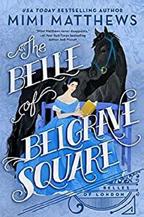
$17.00 paper | Oct. 11, 2022 978-0-593-33715-8
A cloistered wallflower and a notori ous war hero look between the covers.
Julia Wychwood doesn’t want to get married, especially if it means actually talking to someone at a ball. Unfortu nately, her overbearing and sickly parents are insisting that she do her duty, as long as she chooses a titled man who lives close enough to their house on Belgrave Square that she can keep tak ing care of them. They have an elderly nearby earl in mind, but she’s drawn to Capt. Jasper Blunt, a mysterious hero (or pos sible villain) of the Crimean War who happens to love roman tic novels as much as she does. Capt. Blunt is taken by Julia as well—and especially her dowry, which would allow him to fix his estate—though he’s quickly warned off by her father. But after a brush with death makes Julia realize she needs to escape her family before it’s too late, the two impulsively marry and then run away to Blunt’s country estate in Yorkshire. Despite mysteries and misunderstandings between them, Julia begins to settle into her new country life, and it seems they may find some happiness in their marriage of convenience. But as secrets from
Blunt’s past continue to unfurl, Julia wonders whether she will ever trust him enough to love him. The heat in this relatively chaste story comes entirely from the slowest of slow burns between Julia and Jasper, which is irresistible. Matthews brings their story to life with dozens of impeccable details, especially when it comes to fashion and medicine, giving readers a unique glimpse into how the era looked. Secondary characters may feel a bit one-note, but most won’t notice, distracted by the beauti ful relationship blossoming between the captain and Mrs. Blunt. Julia’s bluestocking ways will please contemporary readers, but Matthews never truly abandons the realities of the Victorian era, giving the book excellent balance overall and the feel of a story from Heyer or even Austen.
A swoony Victorian romance that celebrates the genre.

Zeldis, Kitty
Harper/HarperCollins (336 pp.)
$27.99 | Dec. 6, 2022 978-0-06-302-634-6
Three women are brought together by unexpected secrets in 1920s Brooklyn.
Catherine Berrill wants nothing more than a baby to call her own, but she and her husband can’t seem to conceive. One day, to cheer herself up, she wanders into a dress shop in her Brooklyn neighborhood. The shop is run by Beatrice Jones, a Jewish woman who’d recently arrived from New Orleans, bringing with her orphaned teenager Alice Wilkerson. What Catherine doesn’t know is that their meeting isn’t pure chance— Bea came to New York specifically to find her. They have a history together that Bea is afraid to reveal for many reasons, not the least of which is that telling Catherine the truth might expose Bea’s past as a madam at a well-known brothel in New Orleans. But as Catherine and Bea get closer, Alice starts to feel jealous of their connection. With no family and no friends other than Bea, she’s lonely in their new city and starts lash ing out. When Bea’s past is finally revealed, the three women must decide how they fit into each other’s new lives—if they do at all. Zeldis paints a vivid portrait of 1920s Brooklyn, full of life and culture. The narrative loses some momentum when it takes long digressions into Bea’s past in Russia, even if those details are important to understanding Bea’s character and her decisions. The most striking and heartbreaking element of the story is how the women are connected not just by their past, but by the persistent thread of sexual harassment and abuse— Alice, especially, suffers at the hands of men. Ultimately, though, the real story is about the bonds among the three women and the ways they help and support one another through immense challenges.
An intriguing and occasionally heartbreaking novel that’s perfect for historical fiction fans.
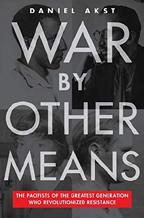
SAVOR by Fatima Ali with Tarajia Morrell
by Bethany Brookshire
HEART THAT WORKS
GRAND AFFAIR
Rob Delaney
Paul Fisher
THE WIND by Neal Gabler
IN THE DARK by Andy Greenberg
ON THE INSIDE by Jessica Grose
JEFFERSONIANS by Kevin R.C. Gutzman
AMERICAN FATE by David A. Hollinger
B by Jennifer Homans
HALF KNOWN LIFE by Pico Iyer
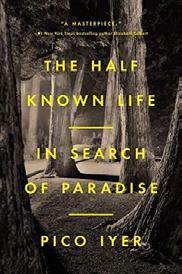
WITH BIRDS by Priyanka Kumar
ROADS BACK by Robert D. Richardson
BILLION YEARS by Mike Rinder
UNPLANNED LIFE by Franklin A. Thomas
FROM MODEL LAND by Erica Thompson
by Lucianne Tonti
Woolfson
Akst, Daniel
Melville House (368 pp.)
$28.99 | Dec. 6, 2022 978-1-61219-924-5
Study of conscientious objectors who made waves during World War II and helped pave the way for successors in Vietnam and other conflicts.
When the draft went into effect in 1940, roughly 43,000 men “were granted conscientious objector status,” writes jour nalist Akst, who breaks down that number: “Most were purely religious objectors, and some contributed to the war effort as combat medics or in other non-lethal roles.” Some 12,000 were assigned to rural work camps in the U.S., continuing the work of the New Deal–era Civilian Conservation Corps and other infrastructure-building agencies. Of the 6,000 left, two-thirds were Jehovah’s Witnesses, and there were “nearly two thousand absolute resisters.” Those in the last category were imprisoned. Objecting to the war was politically fraught, and people such as David Dellinger, who, years later, became part of the Chicago Seven, had to wrestle with being decried traitors to honor their “radical antiauthoritarianism.” In addition to Dellinger, the author describes the work of future civil rights leader Bayard Rustin, a brilliant tactician who later helped organize the Southern Christian Leadership Conference and Martin Luther King’s 1963 March on Washington; dissident journalist Dwight Macdonald; “Catholic firebrand” Dorothy Day; and a host of lesser-known characters in the struggle. Some were followers of Gandhi’s satyagraha movement, which advocated nonvio lent but by no means passive resistance; some were followers of Christian pacifism, such as the pastor Reinhold Niebuhr. A few, such as Dellinger’s friend Don Benedict, decided while in prison that “it suddenly began to make a difference to me who won the war” and enlisted after all. Akst writes effectively of these pacifists and objectors, noting that many of them took important roles in later resistance against war and for advances in civil rights. “They saw themselves as revolutionaries,” he writes, “and they were tough, having withstood violence, prison, poverty, and social opprobrium.”
worthy exploration of a little-known episode in the his tory of American involvement in WWII.
I love essay collections. Not only are they perfect for bite-sized reading sessions, they also show case a writer’s versatility and range better than many other forms. In October, two of the best essayists working today—Peter Orner and Anna Badkhen—have new books coming out, and I highly recom mend both of them.
In a starred review of Orner’s Still No Word From You: Notes in the Margin (Catapult, Oct. 11), our critic notes that “[the author]—a legiti mate triple-threat: novelist, short story master, and prolific essayist—returns with an addictive collection of more than 100 buoyant essays organized around a single day and a wide range of emotions.” Orner’s fol low-up to 2016’s Am I Alone Here? which Kirkus called a collection of “refresh ing, finely turned gems of wit and wisdom,” is packed with erudition, illumina tion, and sparkling prose. Whether he’s discussing the work of Kafka, John Cheever, James Salter, Shir ley Hazzard, Ford Madox Ford, Jean Rhys, or a host of other literary luminaries, Orner delivers fresh in sight on nearly every page, and autobiographical ele ments are pleasingly interwoven with his analysis. It’s the perfect choice for anyone who likes books about books. Our critic concludes, “As Orner inches toward ‘Night,’ readers will be lamenting the end of his wise, welcoming, heartfelt book.”

Decidedly darker in tone, Anna Badkhen’s Bright Unbearable Reality: Essays (New York Review Books, Oct. 18) invokes artistic landmarks in order to grapple with pressing global matters. “Via a series of ethereal scholarly essays, the author aims to find a better way to see and understand grief, especially as embodied in the world’s migrant crisis,” writes our reviewer. “Badkhen recounts her travels around the globe and bolsters her
experiences with a dizzying wealth of literary and ar tistic touchstones. Hazily poetic, she constructs her essays like a collagist, in search of the untapped res onance that can be channeled when seemingly incon gruous ideas are placed in proximity.”

The author is clearly concerned about the state of the world, but she re fuses to give in to despair even when she is discuss ing violence, political cha os, or the very real pos sibility of ecological ca tastrophe. Badkhen tells readers that she seeks “to acknowledge what both separates and binds us at a time when one in seven people has left their birth place, when of the esti mated billion migrants living on earth, a quarter has crossed political borders. Boundaries of race and re ligion and class and gender carve communities, of ten lethally, often block by block. It seems more and more that we live in a world of moral dislocation. And a global pandemic—in its third year at the time of this publication—dictates the direst season of rupture in humankind’s remembering, superimposes loss and anguish onto a world that already is a map of torn ness.” In another essay, Badkhen explores the work of Nobel Prize–winning Polish author Olga Tokarczuk, describing her writing as “hypnotic, spellbind ing in both imagination and rendering.” At one point in her novel Flights, Badkhen asserts that Tokarczuk’s “flight of imagination is so indisputably beautiful, so earnestly true, I feel that she has glanced into that immense beyond.” The same could be said for Bad khen’s own work. Her “soulful, ambitious quest for a path through centuries of loss and displacement” is important reading in troubling times.
Eric Liebetrau is the nonfiction and managing editor.

Ali, Fatima with Tarajia Morrell Ballantine (384 pp.) $28.00 | Oct. 11, 2022 978-0-593-35519-0
A chef’s memoir of a life lived with hard work and perseverance, tragically cut short by cancer.
When Top Chef’s “Fan Favorite” win ner Ali was told her cancer had returned, she was given a year to live. Rather than giving up, she made a goal to travel around the world, eating at her fantasy restaurants and connecting with family and friends. This memoir was born from her dream to write about her adventures. Tragically, her year to live was reduced to four months, most of which were spent pain-ridden in hospital beds. Instead of traveling, she recounted from the hospital her memories of growing up in Pakistan, where she learned to cook with her Nano (grandmother), and subsequent years in culinary school in America, where she honed her craft, competed in national programs like Chopped and Top Chef, and dreamed of opening a restaurant to showcase her native coun try’s cuisine. “I wanted a place where I could open people’s minds about Pakistan through their taste buds—to serve the glorious, generous, hearty food of my youth, of my Nano, and interrupt Western assumptions of Pakistan being a place of bias, of oppression, of terror,” she writes. This book shines with the author’s irrepressible spirit, positivity, and tenacity. Told in her own words alongside chapters written by her mother, the narrative highlights Ali’s ambitious and heartbreakingly short life. At 29, she was full of promise. Her love of food and people and belief in the future are evident throughout the text. Per haps most striking are her determination and work ethic, as she recounts starting out as a chef working 16-hour days, seven days per week. In her battle with cancer, she displayed unwavering toughness and determination. Ali’s adoration of the art of cook ing is apparent, infectious, and often moving.
Ali’s irrepressible love of cooking will not just inspire a love of food, but a love of life.
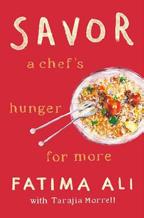
Allen, Devin Photos by Devin Allen & Gordon Parks Legacy Lit/Hachette (192 pp.)
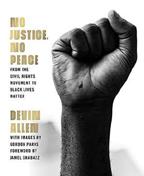
| Oct. 11, 2022
A photo-rich anthology of work decrying racial inequities and violence against Black Americans.
Each of the pieces, many previously published elsewhere, are by a different writer. In his introduction, Baltimore-based
photographer Allen, whose photos interweave with those of famed civil rights–era photographer Parks, explains his motiva tion for this book: “Black people in American must control our narrative. We must document the times we live in—through protest, photography, and words.” Collectively, these brief pieces resonate with blistering rage, grief, and urgent appeals. DeRay Mckesson explains, “There will never be peace—not in our hearts, not in the streets—without justice for those who have paid the ultimate price of police brutality.” Lawrence Bur ney remembers George Floyd: “It is important to share these caring snapshots because they underline that Black people are entitled to a sense of individuality, something that many white Americans (cops or otherwise) repeatedly fail to understand.” Dominique Christina offers a searing poem that includes these lines: “We gon’ always fight and / Be in our magic / We gon’ bury our dead and / Sing what songs we know / We gon’ be what you’re afraid of. / We gon’ be what you’re afraid of.” In “Uncomfort able Conversations With a Black Man,” Emmanuel Acho writes, “The words we use matter, and I want to focus on four of them here: protest, riot, rebellion, and massacre. When it comes to the fight against racism in this country, an ongoing question has been who gets to decide which is which, and then how they get to enforce those decisions.” The book is interspersed with quotations from Black scholars, such as Audre Lorde and Fred Hampton, and the many pages of Parks’ photographs, mostly of protests, are striking. American photographer Jamel Shabazz provides the foreword, and other contributors include D. Wat kins, Clint Smith, Ruby Hamad, and Jacqueline Woodson. An urgent, intense collection worth buying for the photos alone.

Basic Books (512 pp.) $35.00 | Nov. 22, 2022 978-0-465-09631-2
The long, complicated history of the U.S. government’s official “indulgence” of Israel, featuring dissenting voices left and right.
“America’s generosity to Israel is literally unparalleled, not only in U.S. history, but in the history of any nation,” writes Alterman, a contributor to the Nation and author of Lying in State: Why Presidents Lie And Why Trump Is Worse, among other titles. Despite legendary recalcitrance by Israeli leaders regarding conceding to Palestinian or U.S. demands, Israel “has always been able to count on the unswerving support of the U.S. government.” Yet the author systematically reveals how that support is not “monochromatic.” The seemingly limit less emotional support for Israel galvanized after the Six-Day War has dwindled since, as Israeli politics moved rightward and instigated increasingly harsh treatment of Palestinians in occupied areas. “The image of the Israeli David fighting off the
“An urgent, intense collection worth buying for the photos alone.”
Arab Goliath—memorialized in the enormously popular 1958 book and 1960 movie Exodus—was more misleading than illu minating,” writes the author, “but it lived on as a tool for Israel’s supporters in the debates they faced.” Alterman explores the early internal struggles of the Zionist movement and founding of Israel and the leaders’ relationships with different Ameri can presidents. Since the 1960s, each has tried to fashion his own Middle East success story, culminating in Donald Trump’s ambitious, misguided attempts to curry favor with fellow rightwing leader Benjamin Netanyahu. The author employs rich contextual social and media history to reveal the lively intel lectual discussions over the decades among the various fac tions, pro- or anti-Israel—e.g., the furor that burst forth when then–U.S. ambassador to the United Nations Patrick Moynihan denounced the “Zionism is Racism” resolution in the U.N. in 1975. In the final chapter, Alterman delves into the deep disaf fection that now exists among American Jews, especially young people, regarding policy involving Israel and the U.S. Illuminating history and a convincing case that Israel’s drift toward illiberalism has led to further divisiveness.
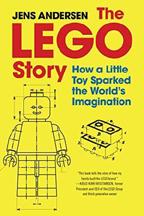
Andersen, Jens Trans. by Caroline Waight Mariner Books (432 pp.) $32.50 | Nov. 15, 2022 978-0-06-325802-0
A cultural and business history of “a global company and a Danish family who for ninety years have defended children’s right to play—and who believe grown-ups, too, should make the time to nurture their inner child.”
A few dozen pages into his narrative, Danish journalist Andersen turns up a fact that might surprise fans of LEGO (he follows company practice in capitalizing the name but without its customary trademark sign): The idea for the molded plastic bricks was borrowed from a British firm, which led to a patent investigation. “With a handful of pieces like these,” as Ander sen reconstructs founder Ole Kirk Christiansen’s aha moment, “any child would be able to copy real-life tradesmen and become their own masons.” That utilitarian note is unsurprising given that Christiansen ran a profitable construction firm that sur vived the Great Depression in part by building things such as ladders, high chairs, and, yes, toys that placed children in adult roles. In Christiansen’s carefully thought-through ideology, it went both ways: Children might play as adults, but adults, he urged, needed to recapture the spirit of childhood play. Ander sen links this attention to child development with a sweeping cultural movement. “In the 1940s and early 1950s, several land mark children’s books were written in Scandinavia,” he writes. “For the first time in world literature, adult writers dared to make children and childlike characters the first-person nar rators of children’s books, giving children natural-sounding
voices.” Christiansen would go on to build an empire of toys that expanded in many directions under the care of his descen dants—the company is wholly family owned—and eventually led to another treasure: LEGOLAND, the much-beloved Dan ish theme park. Not every LEGO experiment panned out, and entering the American market (at first in an unlikely partner ship with Samsonite, the luggage manufacturer) proved diffi cult, but the company has continued to thrive.
A welcome gift for the LEGO lover in the family and a revealing work of business history as well.
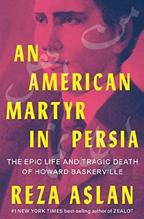
The Epic Life and Tragic Death of Howard Baskerville
Aslan, Reza Norton (384 pp.)
$30.00 | Oct. 11, 2022 978-1-324-00447-9
The story of an “American Lafay ette” who gave his life for Persian independence.
Religion scholar Aslan provides a unique biography of How ard Baskerville (1885-1909), a Presbyterian missionary who died leading a charge in the Persian Constitutional Revolution. The author folds Baskerville’s biography into the broader history of that revolution, which was an outcome of the authoritarianism and colonialism that marked Persia in the early 20th century. Aslan begins with a vivid account of Baskerville’s youth and his transition from the Black Hills of South Dakota to Princeton, where he fell under the influence of the university’s president, Woodrow Wilson, who sought to fashion the student body into “an army of righteous young men primed for national service.” The author shows how Wilson’s robust ideals about democracy deeply affected Baskerville, who left college for Persia to begin life as a missionary, settling into a Christian school in Tabriz. Aslan then dives into the story of the Constitutional Revolu tion, an episode marked by extraordinary foreign involvement, mainly by Russia and Britain. The author’s retelling of the revo lution is clear and dramatic. Readers may be surprised to find that Baskerville does not join the revolutionary forces until three-quarters of the way through the book and well into the timeline of the conflict. Nevertheless, he received a command position and, at perhaps the most crucial point of the fighting, led an early-morning raid in which he was mortally wounded. His bravery, but also the timing of his death, led to his becom ing a hero to the people of Persia/Iran—until the Islamic Revo lution of 1979. Aslan notes that after that point, references to Baskerville basically came to an end in Iran. Largely unknown in the country where he was born and officially forgotten in the country where he died, Baskerville’s legacy emerges intact from the text.
An intriguing read that breathes life into a pivotal moment of Persian/Iranian history.
Berman, Geoffrey Penguin Press (352 pp.) $30.00 | Sept. 13, 2022 978-0-593-30029-9
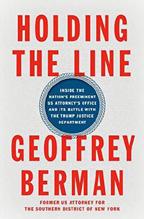
The former U.S. attorney for the Southern District of New York dishes on the corrupt Trump administration.
“One of the things you learn as a prosecutor is that there are a surprising number of people in the world who enjoy talk ing like mobsters when they’re behind closed doors,” writes prosecutor Berman in a memoir whose every page touches still-fresh headlines. One of those people was Berman’s for mer boss Donald Trump. The author, who describes himself as a “Rockefeller Republican,” came into office by means familiar to Trump watchers as, he suspects, a compromise candidate in a power struggle between Chris Christie and Jared Kush ner, with Rudy Giuliani in a corner position. It was politics from Day 1, from trying to retain independence in the Muel ler investigation to the prosecution of former Trump counsel Michael Cohen. The latter had a denouement in Berman and associates’ subsequent probe into possible campaign finance violations, when newly installed Attorney General Bill Barr “not only tried to kill the ongoing investigations but—incred ibly—suggested that Cohen’s conviction on campaign finance charges be reversed.” Thereafter, Berman writes, he was in con stant struggle against Barr, who, “always eager to please his boss, appeared to be doing Trump’s bidding” by interfering in matters such as a census question on citizenship or hijinks on the part of wealthy allies of Turkey’s president, a pal of Trump’s until he wasn’t. Jeffrey Epstein, Michael Avenatti, and Steve Bannon are among the many villains of this book, but Barr is the worst of the lot: instead of protecting the Constitution, he “was looking for clever, invisible ways to let Trump undermine our rule of law.” Barr finally fired Berman by press release, and this book stands not just as a compelling look at how justice works, but also as a fine specimen of sweet revenge.
An instructive, highly readable account of the law, its pro tectors, and its enemies.
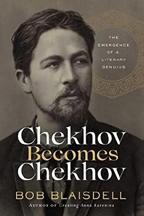
Blaisdell, Bob Pegasus Books (400 pp.)
$29.95 | Dec. 6, 2022 978-1-63936-264-6
Two years in the life and work of the Russian master.
According to Blaisdell, a professor of English at the City University of New York’s Kingsborough College, the years 1886-1887 were momentous for Anton Chek hov (1860-1904). At 26, he maintained a full-time medical prac tice and was already revealing early symptoms of tuberculosis, yet he also published hundreds of stories and humor pieces for popular St. Petersburg newspapers. While he was also feeling pressure to support his expansive family, he was carefully hon ing what would become his signature Chekhov-ian style, and

“Blue Movie is harrowing, heartbreaking,
and will tell others like us they are not alone.”
he transitioned from his previous pseudonym, Antosha Chek honte. At this time, writes Blaisdell, “in full command of his literary powers, Chekhov had written more short stories in total than he would in the rest of his productive life.” Among his more memorable works from this period are the short story “The Kiss” and the play Ivanov. Blaisdell relies on a similar approach that he employed with his 2020 title, Creating Anna Karenina. Throughout, he draws from Chekhov’s personal cor respondence and references several previous biographies in conjunction with close readings of his numerous stories. “I have tried to show how closely connected his own experiences are to his stories,” writes Blaisdell, “which he adamantly (but disin genuously) denied; for another, I have tried to convey the ‘artis tic pleasure’ so many of his stories continue to give us.” While this approach may have worked effectively in the previous book, which focused on one iconic novel, the results here are more scattershot. In trying to connect Chekhov’s correspondence to fragments and distillations of such a wide assortment of stories, the narrative often fails to cohere, yielding a somewhat tire some reading experience. Though Blaisdell offers meaningful
insights into Chekhov’s life and writing, the book is unlikely to attract casual readers of Chekhov.
An earnestly researched effort to reveal fresh perspectives of Chekhov’s life and work that overshoots its mark.

Sourcebooks (336 pp.) $26.99 | Jan. 17, 2023 978-1-72824-693-2
A journalist investigates the life of her great-grandmother in the context of mineral rights, the oil and gas industry, and the American prom ise that anyone could get rich.
In this mix of history, memoir, and environmental writing, Bolstad, a former reporter for Climatewire, begins with an intro duction to Anna Josephine Sletvold, her great-grandmother. The daughter of Norwegian immigrants, Anna homesteaded in North Dakota and, according to family lore, disappeared in 1907. “More than a century later, an oil company sent my mother a $2,400 check,” writes Bolstad. “The oil company was leasing mineral rights along the edges of the booming Bakken oil fields of North Dakota. From the oil company, my mother learned she was an heir to mineral rights below the surface of the land where Anna once had a homestead.” Following the death of her mother three months later, the author began her research, seek ing information about her great-grandmother, how her family ended up with the mineral rights, and how this fit into the refrain that “my mother had heard all her life: We could be rich.” In addition to her personal story, Bolstad discusses the Home stead Act and its repercussions over time as well as the “multi ple boom and bust cycles” in the North Dakota oil patch. Some of the problems associated with these cycles involve crowded, unsafe Walmart parking lots filled with oil workers, businesses struggling to survive on the promise of a potential windfall, and the many “toxic myths of manifest destiny.” By moving back and forth through her own life, her family members’ lives, and the realities of how oil booms have affected states like North Dakota over time, the author effectively examines the political, economic, and environmental issues involved in the production of energy across the country.
An engrossing look at the effects of the American oil and gas industry through the lens of family history.

“An engrossing look at the effects of the American oil and gas industry through the lens of family history.” windfall

Brookshire, Bethany
Page-turning stories of creatures most of us despise, mostly undeservedly. Brookshire, the host of the podcast Science for the People, begins her excellent natural history in a beautiful Indian temple filled with perhaps 25,000 common rats. According to the local religion, these rats are reincarnated people, so they are fed, cared for, and wor shipped. Chronicling her travels around the world to interview experts, the author delivers fascinating accounts of a score of widely deplored pests, from the no-brainers (rats, mice, pigeons) to the controversial (snakes, deer, raccoons) to a few shockers. Readers may be surprised to learn that pigeon was once a major food source. City dwellers raised them on roofs and in back yards. After World War II, cheap supermarket chicken took over, and the pigeons were released to thrive on the streets. The first recorded description of pigeons as “rats with wings” came in 1966. Few consider cats to be drivers of environmental problems, but “feral, stray, and outdoor domestic cats together slaughter one to four billion birds and six to twenty-two billion mammals every year in the contiguous United States.” Worldwide, they are the leading cause of animal extinction, especially on islands, includ ing Australia, where cats are officially designated pests. As Brook shire shows throughout, the concept of a pest is in the eye of the beholder. “Rats are disgusting because humans are,” she notes. They thrive on human garbage and sewage, and we are too lazy to seal our trash and too cheap to pay the taxes to build rat-free infrastructure and housing. Elephants are magnificent, but they destroy crops and kill a surprising number of people. “Between 2014 and 2019, 2,398 people died in India—trampled and torn apart by elephants.” Though humans are voracious predators, when we encounter a “pest,” we feel like prey. In the insightful conclusion, Brookshire emphasizes that we must give up some power, tolerate occasional inconvenience, and acknowledge that there are some things we cannot control.
Outstanding, possibly mind-changing natural history.

Cori
A prominent Black activist relates her story of resilience and political triumph.
A nurse, pastor, and community orga nizer based in St. Louis, the author charts
her journey in becoming the first Black woman from Missouri to serve in the House of Representatives. In these remarkably candid pages, she sets forth her resolute commitment to social change and recollections of the formidable challenges she faced in pursuing it. The impetus for her memoir—and for her politi cal activism—is her outrage at the stark injustices facing Black people, particularly Black women, and conviction that major social transformations are achievable. She first recounts a his tory of abuse by men as she explores the often traumatic con ditions of her adolescence and early adulthood and then turns to focus on systemic forms of discrimination that reflect her own experiences. At the beginning, Bush warns readers that “you will find sometimes traumatic stories of abuse and assault, racism and misogyny.” The author’s firsthand knowledge of the health care industry allows her to pinpoint specific areas of inequity and bring to light their appalling implications. “In St. Louis,” she writes, “Black women are twice as likely to die during pregnancy or childbirth as white women, and Black children make up the vast majority of children suffering from lead poisoning.” Particularly memorable are Bush’s accounts

of the evolution of her Christian faith and emergence as a reli gious leader, the galvanizing effect of the Ferguson protests of 2014 on her political activism, and the inspiration provided by a number of Black role models in her religious, academic, and professional lives. The author might have included more spe cifics about her policy ambitions and longer-term strategies for realizing them, but she provides a clear and compelling portrait of a fiercely determined reformer.
A frank, powerful account of the life and budding political career of a dedicated advocate for gender and racial justice.


Cecchi Azzolina, Michael St. Martin’s (304 pp.) $29.99 | Dec. 6, 2022 978-1-250-28198-2
An industry veteran dishes on more than three decades of service in New York City’s hottest restaurants.
“The restaurant industry is not just about truffles and sweetbreads, caviar and cream, a prime fillet of beef or a freshly caught Dover sole. It’s also about sex, drugs, and an array of misbehaviors perpetrated by both staff and guests.” So writes Cecchi-Azzolina in the introduction, high lighting the reality that intertwined with the glamour of fine dining is plenty of bad behavior. The author grew up in Ben sonhurst, Brooklyn, and started working at a local luncheonette while in high school, where he learned the basics of the business. He moved to Florida and attended college, then back to the city to pursue his master’s degree in theater at NYU. After a stint at La Rousse, the author went to “Michael ‘Buzzy’ O’Keeffe’s soon-to-be-mecca to WASP cuisine and the yacht-club lifestyle, the Water Club.” Then it was on to the River Café, an even hot ter venture, where Cecchi-Azzolina was named captain of the front of the house. He eventually became the maître d’hôtel at Le Coucou, which won a James Beard Award during his tenure. The author’s account of life in the restaurant industry is fastpaced, long on the meticulous details of service, unsparing of the salacious tales of sex, drugs, alcohol, run-ins with the mob, “jumpers” within view of the River Café, and much more. Read ers interested in the who’s who of the NYC celebrity world will not be disappointed, as the high-profile clientele the author mentions runs the gamut from actors and musicians to inter national ambassadors to “the absolutely horrid Anna Wintour.” Cecchi-Azzolina’s prose can border on abrasive and overly detailed, but at its best, his tales are entertaining and affecting, as when he describes the toll the AIDS epidemic took on his colleagues in the industry. His honesty in acknowledging the many ills of the industry’s past and its continued long journey to legitimacy is enlightening and refreshing.
An overlong yet vivid, candid account of an admirable res taurant career.
My Story
Chen, Nathan with Alice Park
22, 2022
pp.)
Chen chronicles what it took to become the first Asian American male figure skater to win a gold medal at the Olympics.

The youngest child (of five) raised by Chinese immigrants in Salt Lake City, Chen “took [his] first steps on the ice” when he was just 3. Noticing how much he loved it, his mother took him to free skating time at a local rink and enrolled him in figure skating classes. Before long, Chen was skating competitively and thriving. In 2010, he overcame a knee injury to win the nov ice national championship. He eventually attracted the atten tion of Armenian coach Rafael Arutunian, who helped Chen build the skills he needed to execute the complicated quadruple jumps that led to his nickname, the Quad King. In the years that followed, Chen’s career was a roller coaster of mental and physical challenges, ranging from a hip injury that set his train ing back before major competitions to intense anxiety about competing during the pandemic and the strain his mother’s coaching put on their relationship. Ultimately, Chen was able to win an Olympic gold medal in 2022 not only because of his training, but because of the steps he took to attend to his men tal health, including sessions with a sports psychologist, devel oping hobbies outside of skating, and going to college at Yale. The book is strongest in Chen’s moments of vulnerability, when
he speaks frankly about his love of his family and appreciation for the sacrifices they made for his career, his complex rela tionship with his mother, and his struggles with mental health. However, the prose is adequate but unexceptional, and much of the text focuses on the technical aspects of skating, making it read more like a list of practice techniques than a cohesive story.
An overly detailed yet inspiring story of dedication and perseverance.
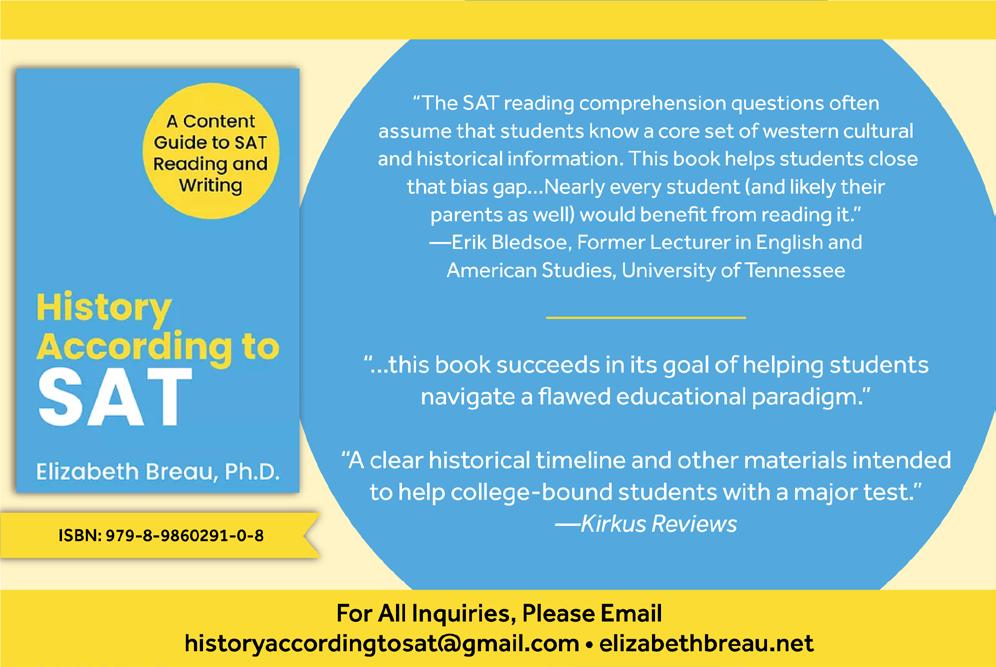
It’s Thanksgiving, and you’re seated across from that proverbial uncle who believes that Nancy Pe losi heads the Illuminati and that pizza and pedo philia go hand in hand inside the Beltway. What do you say to such a person?
You could try to move to the far end of the table and say nothing. You could punctuate the pump kin pie with bitter words. Or you could try to say something welcoming in the hope that, having
done your best to make a human connection, you’ll get a human response.
That’s what many of the interlocutors in journal ist Anand Giridharadas’ new book, The Persuaders (Knopf, Oct. 18), have been working on ever since MAGA hove into view. They face formidable odds against a welter of closed minds and open mouths. And, as Giridharadas’ narrative lays out clearly, they also confront a powerful internet-based op eration, much of it from nations unfriendly to the United States, that sows division where none exists and widens division where it does. Given all the ways that Americans divide—mostly over politics but also history, race, religion, sexuality, and oth er raw spots—the work of the hatred-fueling trolls has been easy.
Healing promises to be much harder. And so it is that those interlocutors have been going out into their communities to talk about uncomfort able issues in nonconfrontational but firm ways. As Giridharadas tells Kirkus, “There’s a pro-democra cy side and an anti-democracy side out there. We’ve got to build the pro-democracy side by growing the circle, not by circling the wagons.” One of his sub jects, for instance, is an expert on political messag ing for leftist causes. There’s a problem inherent in that very job description, she notes: “Democrats are deeply, deeply comfortable with being against things, and they are far less comfortable with stat ing what they’re for.” People want to hear what you’d do if you were in charge, she holds, not why the guys in charge are bad. Calls to abolish the Bor der Patrol are nonstarters in that regard, to name one example. It’s far more persuasive, she counsels, to invite everyone in the audience to come up with
 Michael Lionstar
Michael Lionstar
ways to “create a fair immigration process that re spects all families,” this expert counsels.
A former foreign correspondent for the New York Times and current political commentator for MSNBC, Giridharadas makes no bones about where his sympathies lie. Politics, he holds, is about “haggling over the future,” and there’s room for an ger in bargaining for it. “Look,” he tells Kirkus by phone from his New York home, “this is not a book about advocating ‘Kumbaya.’ I’m not opposed to polarization as such. Maybe 20% or so of people out there are actually committed to fascism, and we have to fight them. But politics is also a contest about how we should live, and that’s where we need to change people’s minds.”
If you’re a member of what Giridharadas calls the “reality-based community,” then doing so would seem to be best accomplished by consensus building. He suggests that we consider a right-wing conspiracist to be a victim of bad information—in his words, “incredibly well-funded bullshit”—add ing that it does no good to blame the victim for being duped by that vast disinformation machine. The trick, as one of Giridharadas’ subjects notes, is not to try to fight fiction with fact but instead to show that victim, patiently and empathetically, how he or she is being conned.
One of Giridharadas’ case studies, in that regard, involves discussing a freighted issue such as raising the federal minimum wage by finding some shared value around which to talk. As one activist frames it, “No matter what we look like, where we come from, or what’s in our wallets, most of us believe that people who work for a living ought to earn a living.” In the world today, with huge changes afoot and free-floating fear abundant, it’s easy for peo ple across the spectrum to feel lost and defensive, and everyone wants the world to make sense, even if the explanations get wacky as they drop down the rabbit hole. The overarching task may be to change the world, one activist concludes, but first we must “help people shake off any limiting beliefs, whether those are about ourselves or about society, and replace them with something else.”
Giridharadas has been working on The Persuaders for several years, gathering material while process ing his own thoughts about what happened when, in 2016, plutocracy gained an extended toehold in

American politics. In what seemed a looming civ il war, it was critical to emphasize civil discourse about possibilities for positive change. “Think of it,” he adds. “People working on the ground, talk ing, changed people’s minds about LGBTQ rights. We’ve changed minds about race. We’ve changed minds about smoking. The important thing to un derstand is that it’s possible to change minds in the first place.”
So pull up that slice of pumpkin pie and talk with your QAnon-besotted uncle. Start with something easy to agree on—hating the Patriots or Cowboys, say—and then, following the lines of argument that Giridharadas sets out, move on to the tough stuff. “Plant doubt,” he says in closing our conversation. “Raise questions. Get people to wonder about motives.” It’s tough work, but reality will thank you for it.
Gregory McNamee is a contributing editor. The Per suaders received a starred review in the Sept. 1, 2022, issue.
a heart that works

Countess of Carnarvon
| Dec. 6, 2022
(272 pp.)
A fawning biography of the Brit ish aristocrat who, with Howard Carter, unearthed King Tutankhamun’s tomb. The author is the wife of the eighth Earl of Carnarvon as well as the caretaker of the vast family castle, Highclere, now famous as the locus of the TV show Downton Abbey. The fifth Earl of Carnarvon, George Herbert (1866-1923), was the most notorious of the bunch, as the financial backer of Carter’s King Tut excavation in 1922 and a dilettantish archaeologist who perished shortly after the momentous discovery from blood poisoning. The countess delineates with painstaking
detail the privileged fabric of the scion’s life. He was known as Porchey as a child, the only son of a well-regarded Tory states man. Porchey was sickly growing up and stricken by the early death of his mother in 1875, when he was 8. He was raised to love hunting and horse racing, and he was more interested in socializing and gambling than academics while a student at Eton and Trinity College, Cambridge. In 1895, he married Almina Wombwell, the illegitimate daughter of Alfred de Rothschild, and he spent untold amounts of money on race horses and cutting-edge automobiles before discovering his love of Egyptology. He and Almina spent much of each win ter season in Egypt, and in 1908, he employed Carter as his “learned man” to extend excavation work into the Valley of Deir el-Bahri. With the war intervening and political upheaval in Egypt, the two got back to the Valley of the Kings by 1920. Due to his health, however, the earl could not savor the dis covery of King Tut’s tomb, but his widow persevered with Carter, ensuring his tireless work would not be in vain. The narrative may interest amateur Egyptologists, but the text is another addition to a long line of the author’s celebrations of her wealthy, influential descendants—e.g., The Women of the Real Downton Abbey, At Home at Highclere, etc.
Written by a family member, the book lacks objectivity and suffers from an excess of detail about family lineage.


Delaney, Rob Spiegel & Grau (196 pp.) $25.00 | Nov. 29, 2022 978-1-954118-31-7
A devastatingly candid account of a parent’s grief that will have readers laughing and crying in equal measure.
Delaney is no stranger to balancing grief and humor, and it shows in this heartbreaking yet often darkly funny recounting of how he lost his third son, Henry, to brain cancer. The author’s work as a writer and actor in the dramedy series Catastrophe clearly primed him to share these poignant recol lections. Few would attempt to bring humor and levity to such an unbearably sad story, but Delaney manages to do so with grace, sincerity, and warmth. His ability to weave laughter into something so dark also makes the book accessible for a wide audience, as the author gives readers permission to fully absorb his family’s story, to empathize and understand, without having to remain straight-faced and downcast. Throughout, Delaney includes playful but sincere asides: “Advice to people who have a friend or relative with a very sick kid: get right up their ass and go spend time with them. They’ll kick you out if they need to, but don’t waste their time by saying, ‘If there’s anything I can do, just let me know.’ That’s for you, not for them. You might as well yawn in their face while looking at something more exciting over their shoulder.” The narrative takes place mostly in Lon don and serves as a sharp criticism of the American health care system in comparison to the British National Health Service,
“A heart wrenching and impressively self aware story of a father living through the death of his young child.”

underscoring the additional strain many families of sick chil dren suffer in the U.S. It is also a tender tale of how a family can remain loving and connected during and after tragedy, and Del aney pulls no punches in highlighting his own perceived short comings as a father and husband throughout the unimaginable ordeal. His raw honesty and ability to inject humor into the nar rative are both charming and refreshing.
A heart-wrenching and impressively self-aware story of a father living through the death of his young child.
Dennison, Matthew
Pegasus Books (272 pp.)
$27.95 | Jan. 3, 2023 978-1-63936-332-2
A warm, compact portrait of the popular author.
It’s a crowded field when it comes to biographies of Roald Dahl (1916-1990), including an “authorized” version as well as the often unreliable memoirs by the author himself. In his latest, Dennison, who has penned biographies of Kenneth Grahame, Beatrix Potter, and others, enters the fray. Dennison’s Dahl is a man “composed of contradictions.” Born in Wales to wealthy Norwegian parents, he was brought up listening to fairy tales and nursery rhymes, which became fodder for his future books’ magic realism. “For the rest of his life he retained a childlike disdain for the ordinary,” writes Dennison. He worked for Shell Petroleum in Kenya, was badly injured in a plane crash during the early days of World War II, and served as a British spy in America, hobnobbing with the rich and famous, especially women. A meeting with novelist C.S. Forester resulted in Dahl’s first published work. From then on, he “required his writing to be prominent, praised and, above all, profitable.” A story about gremlins caught Walt Disney’s attention. Dahl had more success with short stories—many later adapted for TV as Tales of the Unexpected—than adult nov els, but his career was floundering. When a literary agent friend encouraged him to cross a “creative Rubicon” and return to his gremlins roots, James and the Giant Peach was the result, fol lowed by Charlie and the Chocolate Factory. Despite family health issues, deaths, a challenging marriage to actress Patricia Neal, and his own health issues, Dahl, ever the good soldier, weath ered on. Writing the screenplay for You Only Live Twice, the fifth James Bond film, helped bring the family financial stability. Dennison offers little literary analysis of Dahl’s books, focusing on biographical details, and he doesn’t shy away from discussing Dahl’s character flaws: He was irascible, abrasive, and vainglori ous, and “for all his denials, anti-Semitism did shape aspects of Roald’s thinking.”


An efficient, adequate introduction to Dahl’s life.
Evans, Mike Legacy Lit/Hachette (272 pp.)
| Nov. 1, 2022
An irreverent memoir by the founder of GrubHub.
A scrappy rural Georgian who came to the big city as a whiz-kid coder, Evans is a technolibertarian without the right-wing
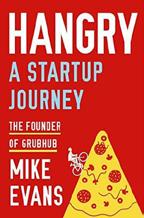
baggage. One takes him at his word that a job must reward the soul as well as wallet, and one feels for his youthful captivity working in one soulless enterprise after another. It was in such a cubicle farm that he cooked up the idea of GrubHub, a natu ral outgrowth of his longtime familiarity with the food-delivery business: “Being raised the youngest, feral child of a single mom, we were on a first name basis with the Domino’s driver.” Com ing up with the name of the company was one hurdle fairly easily solved in brainstorming. Figuring out how to make the thing work was quite another, with all sorts of hidden-trap chal lenges: How to recruit restaurants for his delivery service? How to charge for it? Evans isn’t much for metrics and certainly not for business plans—as he counsels, defying the business-school received wisdom, “Just start. Make the thing. Sell a customer. Start.” The author is full of practical advice, including a rueful observation about the drawbacks of his hard-charging nature, as when he tried to acquire a competitor by ridiculing him. It was a definite nonstarter that led him to conclude, “Running a business is dangerous business.” There are even some funny moments, such as the author’s observations on the pecking order
of the Goldman Sachs team that came to pitch him on running an IPO. Getting a multibillion-dollar business off the ground, Evans observes, was satisfying but only a temporary plug for his hunger—his “hanger”—to isolate a problem or need and then fix it with the power of the market, which has launched him on his latest adventure.
A page-turning, lesson-rich account of how—and how not—to build a business empire.

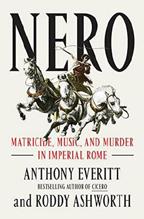
Everitt, Anthony & Roddy Ashworth
Random House (464 pp.)
$28.00 | Nov. 8, 2022 978-0-593-13320-0
A new biography of the notorious emperor who, though hardly a saint, “was a more effective ruler than he has been given credit for.”
Everitt, prolific British historian of the ancient world, and journalist Ashworth write that few Romans regretted the col lapse of the republic, a ramshackle system that dissolved in civil war. Almost everyone, the authors included, agrees that the winner, Octavian, later Augustus, began the empire on a high note. His rule, from 31 B.C.E. to 14 C.E., was absolute but largely peaceful and not terribly corrupt. His successors did not live up to his standards, and his bloodline ended with the widely reviled Nero and another civil
war. The authors admit that none of the half-dozen Roman his torians on whom modern scholars rely were contemporaries, and most portray Nero as an incompetent despot with an “exotic” sex life. However, Everitt and Ashworth add that not all of this is false and that he never wanted to be emperor. “Given the choice,” they write, “he would much rather have been a poet and professional musician.” He became emperor because of his fiercely ambitious mother, Agrippina, wife of his predecessor, Claudius, who also (according to contemporaries) poisoned her husband. Aside from the usual debauchery, Nero seems to have begun as a tolerable ruler, cultivating the Senate and army and allowing administrators to run the empire. Five years into his reign, he murdered Agrippina, a threat to his growing power. This seemed to mark the beginning of his decline, after which his behavior became more erratic, cruel, and extravagant. A revolt in the provinces spread to Rome, from which Nero fled and later committed suicide. The authors present a portrait that is decidedly less skeptical of the ancient historians than many other similar histories, and it makes for page-turning, informative reading for students of the era.
A nice addition to the literature about ancient Rome.
Fisher, Paul
Farrar, Straus and Giroux (496 pp.) $40.00 | Nov. 1, 2022 978-0-374-16597-0
The life of an enigmatic artist.
In a vibrant, authoritative biography, Fisher, a professor of American stud ies at Wellesley, examines the cultural landscape in which John Singer Sargent (1856-1925) rose to prominence, his development as an artist, and the “nonnor mative complexities of gender and sexuality” that character ized his relationships. In considering Sargent’s sexuality, the author contributes to an already robust scholarly inquiry by biographers and historians by taking a measured perspective on what he calls romantic friendships with men such as art ist Albert de Belleroche and Sargent’s longtime valet, Nicola d’Inverno. “It’s unclear,” Fisher writes, whether the men in Sargent’s circles “even knew about each other’s proclivities or consciously chose each other’s company on that basis.” In the author’s view, Sargent was a man “torn between his longstand ing inclinations for transgressive passion on the one hand and frosty respectability on the other.” Raised in an expatriate family dominated by an unconventional, peripatetic mother, Sargent was “powerfully drawn to dynamic, rule-breaking women,” such as his patron Isabella Stewart Gardner and his friend Vernon Lee. In the European cities in which he visited and worked, he was attracted to “decadents and bohemians,” street people, Venetian gondoliers, Spanish dancers, in whose company he was able to “give rein to an idiosyncratic genius hardly allowed to show itself in the more conventional Victo rian world.” Both worlds informed his acclaimed career, much


“In a vibrant, authoritative biography, Fisher examines the cultural landscape in which John Singer Sargent rose to prominence.” the grand affair
of which was dominated by portraiture of the rich and famous, particularly “stylish, well-connected women.” He painted “not only what he knew, but whom, and whom he wished to know better,” portraying his subjects with a rare and sometimes—as in the portrait Madame X—scandalous sense of intimacy. Sar gent’s “social and aesthetic relevance—both to his time and ours,” Fisher argues convincingly, derives from “his represen tation of an ever-more-complex modernity and an ever-morediverse and multicultural world.”
A sensitive, nuanced portrait.

Gabler, Neal Crown (1,280 pp.) $40.00 | Nov. 15, 2022 978-0-593-23862-2
The second volume of the author’s fluent account of Edward Kennedy’s political career in the face of the govern ment’s shift from New Deal liberalism to the beginnings of our current “deep crisis for democracy.”

The liberal consensus, writes Gabler, “had once been the prevailing American ideology.” When Kennedy entered the Senate in 1962 while his brother was president, that was certainly true. Yet, almost immediately, America began a rightward shift, hastened by Richard Nixon and his “fierce Kennedy hatred” and Ronald Reagan, who surrounded himself with hatchet men bent on undoing the administrative state. Yet as the author shows, even the intervening Jimmy Carter, a Democrat now being nominated, it seems, for sainthood, was no ally: Kennedy believed that Carter was “a man with out convictions” who tried to play to the middle while running away from fights with conservatives, “whom Carter seemed to fear much more than he feared liberals.” So it was with other centrist Democrats, including Bill Clinton and Barack Obama, who caved in to conservative demands while won dering how they were so often outmaneuvered. The stalwart Kennedy’s efforts at comprehensive legislation on national health care and a higher minimum wage were thus stifled or frittered away. On immigration reform, for instance, amend ment after amendment was added to kill Kennedy’s bill, and years of negotiations died with them. “The ‘voices of fear,’ as Ted had called them, those on talk radio and in nativist circles, had won,” writes Gabler. The voices of fear have grown louder since then, and Kennedy’s liberalism is nearly unimaginable. The rightward line the author draws runs through Kennedy not as a prime mover but instead as someone whose longevity in the Senate was such that few had such a ringside seat to his tory only to watch the right prevail against a brand of politics that “might remind us of our better selves.”
A thorough, admiring, and not uncritical study of a politi cal lion whose roar is much needed these days.
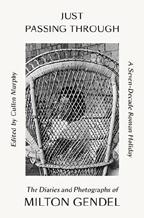
Gendel, Milton
Ed. by Cullen Murphy
Farrar, Straus and Giroux (272 pp.)
$35.00 | Nov. 8, 2022 978-0-374-29859-3
A 70-year “Roman holiday” unfolds in photos and diary entries.
As the title suggests, we all just pass through life, but some travelers, for all their ports of call, find a congenial place to put down roots and have the world come to them. Gendel (1918-2018), art critic, photographer, diarist, and socialite, was an exemplar of the kind. Longtime friend Murphy, editor at large at the Atlantic, assembles a selection of the Americanborn expatriate’s vast diary entries and punctuates them with
Gendel’s moody black-and-white photography, producing a retrospective of an age and social strata as well as a man. Gen del studied at Columbia University, immersing himself in the New York art and literary scenes, and then served in the Army in China before becoming Rome correspondent for ARTnews He would live in the Eternal City for seven decades, making the most of it. Exceptionally well connected through his sec ond marriage, art circles, and his own gift for friendship, as a photographer he was as interested in ordinary people as he was in the rich and famous. In a lengthy, deep-focus introduction, Murphy conveys some measure of this uncommonly culti vated man—his daughter once described him as “his own cul tural microclimate”—and then lets Gendel tell his own story in arresting fragments. Is there anyone Gendel didn’t know? It seems that way sometimes, with his chronology of the lofty and titled who lunched, dined, or stayed with him in his various palazzos. No name-dropper, Gendel never intended that his diaries or his photographs be made public, though he finally acquiesced on the latter. It’s Murphy who does the naming, rather haughtily at times, clearly relishing identifying
in footnotes all of the notables appearing in Gendel’s entries. Surprisingly, he includes few of the surrealist images for which Gendel was known, preferring the atmospherics of Gendel’s portraits, architectural shots, and candid stills.
A rich portrait of an alluring character with an enviable tal ent for living.

Gillette, Felix & John Koblin
Viking (416 pp.)
$28.00 | Nov. 1, 2022 978-0-593-29619-6

How a paid-TV novelty rose to prominence.
Media reporters Gillette and Koblin begin with the launch of the Home Box Office network, which “sputtered” to life in 1972 with only 375 subscribers. During the early years of cable TV, HBO sought to distinguish itself with innovative satellite technology, broadcasting the iconic 1975 boxing match between Muhammad Ali and Joe Frazier. By the early 1980s, HBO began test-marketing more late-night adult programming (“low-cost enticement to male viewers”) and sexuality documentaries, thanks to Emmy Award–winning documentary filmmaker Sheila Nevins, alongside its live broad casts of major sporting events. Despite the success of scripted shows like Tales From the Crypt and Dream On, a series of missed opportunities prevented HBO from rising even higher. Show time cut into HBO’s business in 1986 when they bought It’s Gary Shandling’s Show, which HBO passed on, but the 1990s and early 2000s ushered in original series blockbusters like Sex and the City, Oz, and The Sopranos, which buoyed parent company Time Warner. As viewership evolved, so did the need for net works to bring in something new and groundbreaking. HBO’s profits were declining due to the new DVD delivery service, Netflix, and executives were forced to swallow their pride at not acquiring the startup when they had the chance in 2006. As Netflix exploded, HBO entered the streaming arena with the HBO Go service, which soon morphed into HBO Max in 2020. Throughout their comprehensively detailed account, Gillette and Koblin remain fair-minded in their reportage, accentuating not only HBO’s successes, but also its many failures. Though their brisk narrative is straightforward, it contains plenty of business melodrama. The authors offer profiles of the network executives that helped usher in successful eras, including Time Warner CEO Gerald Levin, who excelled as a shrewd massmedia businessman, and agent Chris Albrecht, whose interper sonal problems became a publicity nightmare. Pair with James Andrew Miller’s Tinderbox
Entertainment buffs will find this report of a risk-taking network fascinating.

This
for
seminal, all-encompassing pregnancy guide just got a lot more
and informative.”
Reviews
“A thorough health guide that’s designed to calm and empower prospective moms.” Melissa Wuske, Foreword Reviews
"The evidence-based book I was looking for."
Customer Review
“Entertainment buffs will find this report of a risk taking network fascinating.”
not tv
Graffin, Greg Hachette (384 pp.)





$30.00 | Nov. 8, 2022 978-0-306-92458-3

The songwriter, lead singer, and sole constant member of the iconic punk band Bad Religion delivers a well-crafted memoir and manifesto.
“Formidable we were not,” writes Graffin. “But something was shared among all punk rockers outside of Hollywood: we were hated.” That hatred bonded those late-1970s–era kids in a torn-jeans, leather-jacketed united front against the yuppies, surf Nazis, and police offi cers who hunted for them. It also provided Graffin with both material and inspiration that informed Bad Religion, which he formed in 1980. The author was no ordinary punker, however: He took time off from the band to go to college and graduate school, though he did delay his doctorate in paleontology by going out on tour. Now a professor of evolution at Cornell as well as a working musician and author of Population Wars and Anarchy Evolution, Graffin takes a decidedly Darwinian view about business. “Never reveal to your competition what your true talent is,” he writes, “until that moment when you really need it to prove your superiority and leave the others dumb founded and defeated, realizing that they had been victims of their own hubris, that you had been toying with them all along.” That ethos served him well when he took his young band out on the road, learning along the way that punk rockers created punk rock more than the other way around and that the genre was a wonderful expression of angst and discontentment channeled into something better than drugs or alcohol. Unusually, Graffin expresses solidarity with the hippies who preceded (and were reviled by) the punks, and he even has sympathetic words for the hair metal bands of Sunset Strip, who never got beaten up by the LAPD as much as the punks did.
An entertaining, memorable look at “the most intractable paradox of all: punk as a positive force in society.”

The lovable actor returns with another lively set of personal essays.

Best known for her role as Lorelai Gilmore on Gilmore Girls, Graham writes with humor, authen ticity, and humility. She gracefully tackles topics ranging from her first car in Los Angeles—a rusty, “1991 lime-green Honda
Civic” with “a spot on the driver’s side where you could see through to the ground below”—to the nuances of talking about emotionally difficult subjects, like growing up without her mother present. Graham, the author of a novel and two previous essay collections, presents a charming and candid depiction of life as a celebrity that reminds us they are, in fact, just like us, with their own struggles, triumphs, and insecuri ties. Recounting one interview with a magazine journalist, she writes, “I talked about the years I spent studying acting, what it was like to leave New York, my hopes and dreams for the show. At the end, I asked her if she had gotten what she needed and she said she had, but she also seemed a little disappointed. ‘I guess—I thought you’d be funnier,’ she said.” Graham doesn’t shy away from seemingly taboo topics, including aging in Hol lywood, which she discusses with her characteristic humor and warmth: “This change sneaks up on you, and like any sneak, it gives you a bit of a scare.” When discussing her early attempts to land an acting gig and her job as a Barney’s sales clerk, where she occasionally saw famous people, she is equally charming. “These…sightings,” she writes, “taught me that famous people

“Ruhl charts his
from growing up
to becoming a
Buddhist
well
pop-Buddhism’
are always much tinier and even more depressingly beautiful in person, and it seemed impossible that I’d ever go from demon strating a family card game or recommending an appropriate level of workplace blouse sheerness to becoming one of them.” Graham’s own celebrity status feels incidental in a collection that can stand on its own wit.
Fun, candid tales of Hollywood make for entertaining reading.

Greenberg, Andy Doubleday (384 pp.)
| Nov. 15, 2022
A sinuous, eminently readable story of the darker corners of cyberspace. Who would have thought an IRS agent could become a legal superhero? That’s just the case with a criminal investigator named Tigran Gambaryan, who had been assigned to “busting gangs in Oakland who had graduated from dealing drugs to filing fraudulent tax returns with stolen identities,” a switch that had the benefit of bringing in more money while carrying less jail time. Fearing that he’d spend his career chasing down small fry, Gambaryan turned his attention to cybercrimes, which in turn led him to Bitcoin. Then at Forbes and now at Wired, technology journalist Greenberg was explor ing cryptocurrency himself and trying to land an interview with the legendary Silk Road mastermind known as the Dread Pirate Roberts, who was “making millions of dollars in highly illegal narcotics sales…while evading every global law enforcement agency.” DPR assumed that cryptocurrency was an impregnable fortress that couldn’t be “de-anonymized.” Not so, and he was finally taken down after e-chatting for months with a supposed online moderator who was in reality a Homeland Security agent. With sometimes competitive agencies working together—even the IRS, which one judge called “the redheaded stepchild of law enforcement”—and spreading the net to include both criminals and police agencies abroad, the chase quickened after DPR fell. Greenberg tells the stories of demolishing crime empires like AlphaBay and Hansa and their bosses with verve that’s refresh ing for a book full of computers, code-breaking, and electronic cat-and-mouse games, including one memorable moment in which the object of an international police hunt “had, entirely by chance, arrived at a meeting at the exact hotel where they were staying and sat down at the table next to them.” Green berg’s book is reminiscent in all the best ways of Clifford Stoll’s Cuckoo’s Egg, smoothly blending crime writing with matters of the deepest techno-geekery.
An absorbing work of true crime—and, as the bad guys will tell you, true punishment.

“An absorbing work of true crime and, as the bad guys will tell you, true punishment.”

Gristwood, Sarah St. Martin’s (400 pp.)

$29.99 | Dec. 13, 2022 978-1-250-27142-6
Love and diplomacy in Tudor England. Five Tudor monarchs ruled England from 1485 until 1603. Like most rulers of the era, they chose consorts as a matter of international diplo macy and national stability—i.e., to produce an heir. Genuine love rarely played a role, but this hasn’t prevented a steady stream of authors from writing books about Tudor spouses or about Elizabeth’s stubborn refusal to choose one. British jour nalist and historian Gristwood, author of Game of Queens: The Women Who Made Sixteenth Century Europe and other books, has produced another, but with a significant variation. Without ignoring the lives of these consorts and candidates and Renais sance European politics, the author emphasizes that, among the upper classes, courtship aimed to follow the medieval code of courtly love. Arthurian legends of knightly chivalry and pas sionate, more or less chaste, romance experienced a revival in the 15th century. Bloody tournaments flourished throughout Europe, and royal courtships featured prolix exchanges of pic turesque rhetoric. Gristwood begins with a literary history of the Camelot legend. This traditionally dates from Geoffrey of Monmouth’s 12th-century narrative of Arthur’s life but includes generous contributions from Dante, Chaucer, Malory, and Ten nyson. This book includes more literary scholarship than the average history buff expects, and most readers will be relieved when, around Page 80, Gristwood reaches the late 15th century and begins an appealing account of the Tudor years. The author covers politics, war, and religion but also emphasizes royal matrimony as well as the obligatory mistresses and purported affairs. Except perhaps in the case of Anne Boleyn, passion was absent in the often interminable negotiations for a royal con sort, but there was no shortage of oratory, correspondence, and poetry extolling the glories and painful sacrifices of courtly love. Inevitably, most involve Henry VIII’s dogged search for a wife to produce a male heir, but readers may wince at the flowery exchanges between royal suitors and the increasingly elderly and unavailable Elizabeth.
A solid, uniquely focused study of the irresistible Tudors.

Griswold, Mac Farrar, Straus and Giroux (560 pp.) $40.00 | Nov. 15, 2022 978-0-374-27988-2
The landscapes of a privileged life. Landscape historian Griswold offers a warm portrait of her longtime friend Rachel Lambert “Bunny” Mellon (19102014), a noted garden designer and “icon of style.” Born into wealth and luxury, Bunny grew up on curated estates: The gar dens of her childhood home, for example, were created by the prestigious Olmsted firm. She married into even greater wealth: Her second husband was Paul Mellon, philanthropist and heir to the Mellon banking fortune. “In the Mellons’ self-sufficient universe,” Griswold observes, “acquiring the best became expected, ingrained, something to be done without remarking
on the effort or the money it required.” Their multiple homes were staffed by as many as 350 employees. Although their marriage soon fell apart, Paul assured Bunny that “she would have all the money she wanted.” That money seemed limitless. Dressed by Balenciaga, bejeweled by Jean Schlumberger, Bunny had a wardrobe that cost close to $3 million per year in today’s money. While Paul took a lifelong mistress and Bunny reveled in serial infatuations with “interesting and talented men— almost all gay,” they remained married until Paul’s death in 1999. Griswold follows Bunny’s passions for art, gardens, and interior design, which led to her reputation as a woman of supreme good taste and imagination. Fashioning for herself a “hushed and extremely private domestic universe,” her social world was glamorous: Queen Elizabeth and Prince Philip came to tea, and Jackie Kennedy became a close friend. Bunny served on Jackie’s White House Fine Arts Committee, redesigned the Rose Gar den, and designed the landscaping for the JFK Library and Ken nedy gravesite. Alongside achievements, though, were scandals and sorrows that challenged Bunny’s “theatrical mastery” of her life. Acknowledging Bunny’s insularity and emotional limi tations, Griswold still admires her. What saved Bunny “from being a complacent, undereducated, rich society woman with time on her hands,” she writes, “was her bottomless curiosity.”
A richly detailed rendering of a world of boundless extravagance.
Groarke, Vona
New York Univ. (224 pp.)
$22.95 | Nov. 15, 2022 978-1-4798-1751-1
An acclaimed Irish poet imagines a female ancestor’s life through a unique blend of research and balladry.
Groarke, who has published eight poetry collections, knew her greatgrandmother Ellen O’Hara through the stories her mother told her. The author was intrigued, but it was only during a stay in New York many years later that she seriously began investigat ing Ellen’s life through a combination of archival research and creative channeling. In order to tell the story, she writes, “I will need guardrail prose, but I will also need language that crossstitches and embroiders itself, the way poetry often does.” The result is a dual-voiced narrative inhabited by a feisty Ellen, who speaks in “the boxy fourteen-line rhyming form” of the folk son net, and a questing narrator who speaks in the thoughtful prose of a seeker. The choice to enshrine Ellen’s voice in this way not only emphasizes the imaginative nature of Ellen’s character, but also pays tribute to what Groarke envisions as her ancestor’s tra ditional nature; it also transforms an otherwise ordinary life into something more consequential. To ground Ellen’s life in history, Groarke interweaves excerpts from studies about Irish immigra tion and archival documents like baptism registers, passenger
manifests, and newspaper clippings and photographs. The author mixes known details about Ellen’s life—her work as a maid in New York; her marriage to a man who deserted her—with intui tive insights into Ellen’s hopes and fears. Most of these involved the return of the children she sent back home along with lifesav ing remittances to her relatives. She wanted only to build a life in America for her children, but in the process, she and other women like her helped build modern Ireland. As it imagines one woman’s life, this genre-bending book probes the nature of family and belonging and the profound ways ordinary immigrant women changed history on both sides of the Atlantic. Intelligent, searching, and warmly rendered.
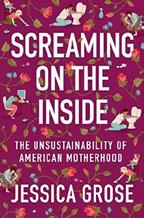
Grose, Jessica Mariner Books (304 pp.) $28.99 | Dec. 6, 2022 978-0-06-307835-2
How historical constructions of Amer ican motherhood have rendered modern motherhood an almost impossible task.
Grose, a journalist who writes a parenting column for the New York Times, opens with a brief historical section on parenting in early America. “Unlike today,” she writes, “where most guidance is directed toward mothers, in colonial times written guidance for parents was addressed to both mothers and fathers.” As the author shows, eventually, the racist drive to increase the White population and to separate upper-class White women from their working-class and Black peers led to the reification of gender roles and, more specifically, the concept of the model mother who was dedicated to her children above all else while being con fined in her home. In modern times, the expectation that women are primarily responsible for childhood has continued, with dev astating and, at times, deeply contradictory effects. For example, Grose illustrates how social media accounts run by mostly White influencer mothers both reinforce harmful ideals of perfection ism while also providing mothers in conservative families one of their only sources of income and connection to the outside world. The author ends the book on a note of hope, profiling mothers whose passion for parenting their children has led them to begin activist movements designed to reform the overlapping systems that keep American parents and children from getting the physical and emotional support they need to thrive. Grose’s fiery compassion is matched by her profoundly complex under standing of the material and her trenchant, witty prose. Although she consciously includes the voices of diverse, modern mothers, her analysis is sometimes more relevant to White, heterosexual, cisgendered mothers, particularly in the historical sections. Still, the author is clear in her intent to be inclusive, and her topic is relevant and worthy of discussion.
A deeply researched and highly relatable analysis of Ameri can motherhood, past and present.

“A deeply researched and highly relatable analysis of American motherhood, past and present. ”

Gutzman, Kevin R.C. St. Martin’s (608 pp.)
$29.99 | Dec. 13, 2022 978-1-250-13545-2
A long, insightful look at three Founder presidents.
Before Bill Clinton, George W. Bush, and Barack Obama, America’s only consecutive trio of two-term presidents were Jef ferson, Madison, and Monroe, a fact of no significance except to trivia buffs, but that earlier “Virginia dynasty” has proved irre sistible to scholars. History professor Gutzman, who has writ ten biographies of both Jefferson and Madison, describes their administrations, which extended from 1801 to 1825, a period during which Jefferson’s Republican Party (radical for the time) drove the Washington-inspired Federalists to extinction, gov erned a one-party nation for a few years, and then retreated as a more numerous and democratic electorate came to dominate. Despite America’s spectacular expansion during this period, Gutzman (and most modern historians) does not give any of its three administrations high marks. Jefferson peaked during the Revolution with the Declaration of Independence and his 1777 Virginia Statute for Religious Freedom, but his conduct as presi dent won America little respect in the dog-eat-dog world of the Napoleonic Wars. Relying on moral suasion and trade embargos to fend off outrages from Britain and France proved disastrous, and he left office under a cloud. Madison, Jefferson’s clos est friend, more scholarly and perhaps more politically astute, labored under the disadvantage of playing second fiddle for more than 20 years. Lacking Jefferson’s charisma and continu ing his unwise policies—especially his fierce government frugal ity—left the U.S. unprepared for the War of 1812. Unlike most historians, Gutzman gives Monroe equal time. Hardly a scholar but an experienced politician, he was president during eight postwar years, dealing unimaginatively but not disastrously with several looming problems, including slavery, banking, and the loose cannon that was Andrew Jackson. Political histories are rarely page-turners, but Gutzman, clearly a scholar who has read everything on his subjects, writes lively prose and displays a refreshingly opinionated eye for a huge cast of characters and their often unfortunate actions.
Outstanding historical writing.

Voracious/Little, Brown (320 pp.)
$24.99 | Oct. 25, 2022 978-0-316-49553-0

The male lead of the TV series Out lander takes us on a long Scottish hike while recounting the travails of stage and screen.
“I’m not hyperactive, I crave down time, but I feel guilty if I’m not…push ing myself in some capacity,” writes Heughan, who, sidelined by Covid-19 after shooting an abbreviated sixth season of Outlander, decided to walk the West Highland Way. Running from just north of Glasgow along Loch Lomond and up the U.K.’s tallest mountain, Ben Nevis, before ending along Scot land’s west coast, the trail is not for the faint of heart. Nei ther, writes Heughan, is acting: He chronicles his unsuccessful
auditions for many much-wanted roles—e.g., hoping to bring the James Bond trademark back home, he was beaten out by Daniel Craig. Being hammered by rain and cold and pained by blisters and sore muscles are perhaps no less dispiriting than losing a role, but Heughan writes with generally good humor of his experiences, in which, on the trail, he plays the part of the hapless newbie. Still, he enjoys the bucolic solitude, as when he notes, “There isn’t a single soul around, unless you count a few hardy sheep in the distance bracing themselves against the gusts.” If you want to read solely about tramping around Britain, Robert Macfarlane is the writer you want, but if you have any interest in the art and craft of acting along the way, Heughan offers plenty of notes. “The key to Shakespeare, I learned, is to allow the text to live,” he writes. “It’s the punctuation and poetry that guides the actor, which makes breathing key to delivery.” For all that, it’s a treat, after a winding narrative that ranges from exultant to melancholic, to see Heughan on top of Ben Nevis at last.
A pleasure for fans of the author, whisky, and Scotland.

How Religion Became More Conservative and Society More Secular Hollinger, David A. Princeton Univ. (216 pp.) $29.95 | Oct. 11, 2022 978-0-691-23388-8
A superbly concise examination of how American Christianity’s division into a Protestant two-party system parallel to the existing polit ical one came to deeply alter the nation’s recent politics.
Among the preeminent scholars of American intellectual culture, especially of religious thought, Berkeley historian Hol linger, who admits to having “drifted away” from faith, focuses on how religious Christianity, previously only one among many sociocultural factors at play in public as well as private life, attained its current prominent role in politics. The author asks important questions: How did 20th-century American Protestantism break apart into evangelical and ecumenical camps? Why did White evangelicals gain such influence in the nation’s life? What made Donald Trump and the evangelicals take advantage of each other? While harshly condemning such figures as Billy Graham for racial prejudice, anti-intellectualism, and political favoritism, Hollinger never surrenders his schol arly balance. He fully acknowledges how evangelicalism “made it easy to avoid the challenges of an ethnoracially diverse soci ety and a scientifically informed culture.” He sharply criticizes the mainline churches, the “ideological disarray of American ecumenical intellectuals,” and ecumenical Protestants generally for their failure to realize the growing strength of evangelical ism in their “multidecade campaign to achieve more cosmo politan Protestantism.” Hollinger makes central to his story the roles both of anti-Jewish and anti-Catholic currents within
evangelical Protestantism and the emergence of what he calls “Post-Protestants” and those claiming to be “nones”—people without any felt religious affiliation. The author’s only misstep is the relative lack of attention he pays to the growth among evangelicals of anti-Muslim bias since 9/11. In the end, for all his discouraging reflections, Hollinger, betraying some opti mism, reminds us that the bitterness of evangelical opposition to recent social and cultural developments reveals how far postProtestant social and ethical values have spread beyond religion into public life generally.
A critically important, authoritative history of great, immediate relevance.
MR. B George Balanchine’s 20th Century
Homans, Jennifer Random House (784 pp.)
$35.00 | Nov. 1, 2022 978-0-8129-9430-8
An intricate, meticulously researched biography of the revered and controver sial dance icon.
George Balanchine (1904-1983), famed choreographer and co-founder of the New York City Ballet, was private about his genius and how he created such beautiful art. He once turned down a request for his biography, saying that his inspiration “is not going to be written down anywhere, for anybody to know.” In this engrossing, vivid account of his life, Homans, a former dancer and current critic for the New Yorker, acknowledges her subject’s personal failings while also portraying him as a man enjoying the sensuous pleasures of life. After the powerlessness and instability of his childhood in Russia, he fashioned an identity for himself in a world that he could control using a language that he helped create. He spoke through his dancers. The author, who also wrote Apollo’s Angels: The History of Ballet, is an expert in her field, and she eschews the task of trying to “define” Bal anchine, instead unearthing the various “truths” about him and presenting them without judgment. Homans creates an admir ing, honest, and page-turning tribute to this magnetic and com plicated figure. Though the text is grounded in conscientious research, the author acknowledges the inability to ever truly “know” a person. The candid admission of Balanchine’s fluidity of memory enables Homans to compose a biography that has all of the sumptuousness and lyricism of a fairy tale. She movingly depicts numerous key moments in her subject’s life, from his mother miraculously winning the lottery and subsequently los ing the fortune to Balanchine being plucked from the examina tion pool to join the ballet corps of the Imperial Theater School. Given that Balanchine embellished some memories and omit ted others from his own narrative, this gripping book reveals a talented artist who feels familiar and yet unknowable and whose greatest creation was quite possibly his own mystique, which still fascinates.
The definitive account of a remarkable and flawed artist.

Hubbard, Shanita Legacy Lit/Hachette (192 pp.) $27.00 | Nov. 8, 2022
A journalism instructor and Black feminist activist offers her perspective on the “missing narrative about Black women’s lives” in contemporary culture.
Hubbard derived much of her early views about Black womanhood from hip-hop songs like the LOX’s “Ryde or Die, Bitch,” which celebrates the self-sacrificing Black woman. The author shows how this female archetype has deep roots in both Black culture and the Black church and exists across boundaries of education and class. After finishing her master’s degree in criminal justice, Hubbard willingly became the emo tional and financial support for a convict boyfriend, his young daughter, and ex-girlfriend, all while spending several days a week volunteering for her community church. The author examines the fraught nature of public spaces for Black women, especially the “corner.” Songs like Common’s “The Corner” speak of street corners as spaces of brotherhood and safety for Black men, but for women, those same spaces are rife with the possibility of harassment. “For black women and our bod ies,” writes the author, “we have a complicated relationship and experience with those corners that has been…ignored in our community.” Indeed, the Black men “hunted by the police” are the ones who, along with the police, hunt Black women and girls to inflict harm upon them. Hubbard also shows how the violence Black women experience is linguistic. She sug gests that labels like queen exist to keep them in their place and divide them from each other. Used by men to compli ment “good,” sexually modest Black women, queen does noth ing more than force women to play the kind of respectability politics that turn up in the lyrics of even the most progressive women hip-hop artists—e.g., Lauryn Hill, whom the author discusses in depth—and contribute to the “collective and individual harm…[of] Black women.” Candid and provocative, Hubbard’s examination of the unspoken truths about Black women’s lives is well rendered and liberating.
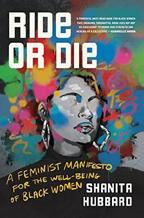
An important book about significant issues that often go unexplored.

Riverhead (240 pp.)
$14.99 paper | Jan. 10, 2023 978-0-593-42025-6
An acclaimed travel writer sets out on a journey to an elusive destination: paradise.
Iyer has written many beloved books on his expeditions around the world, and he has a gift for capturing the texture and cadence of a place and its people. His latest, which he sees as something of a capstone to his life’s work, is more than a travel memoir. He explores the idea of paradise held in different cultures and religions, making the text a spiritual journey rather than an itinerary, a pilgrimage to a semi-imagined place “where so many of our possibilities lie.” The author begins in Iran, a country caught between the ambi tions of its theocratic rulers to return to an earlier time and the desires of its people to build a faith and society suitable for the 21st century. Not for the only time in this book, Iyer finds that he has to discard his preconceptions if he is to make sense of the reality he finds. The search for paradise often intersects with real-world conflict, and the author was stunned by the eth nic violence that has torn apart the beautiful island of Sri Lanka. The irony is that the center of the island is an oasis of Buddhist calm, untouched by the ocean of warfare. In Jerusalem, Iyer discovered “a holy turbulence” of competing beliefs, but some how people have learned to live with the chaos. Perhaps, then, heaven can only be found after death? His visit to Japanese shrines points that way, but Iyer finds the idea rather cold. He does not reach a definitive conclusion, but he begins to accept that the search for peace leads to a place within. “I decided that I would no longer seek out holy places in [a] city of temples,” he writes near the end. “I would just let life come to me in all its happy confusion and find the holiness in that.” Amen. With keen observation and beautiful language, Iyer shows us the essential truths of places, people, and ideas.
Ed. by Jenkins, Willard
Univ. (320 pp.)
paper | Dec. 2, 2022
Pulling back the curtain on the small world of Black jazz journalists.
With the conductive virtuosity of Butch Morris, Jenkins, the artistic direc tor of the DC Jazz Festival, assembles an impressive paean to the Black writers who’ve dedicated their lives to capturing in language what jazz musicians conjure in a split second. With more than two dozen thoughtful profiles, this is a fascinating
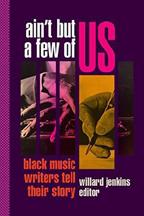
dive into the sociopolitical realities of being a Black writer—in this case, Black writers who love jazz and express that love in vivid prose. As a unifying theme, jazz functions as a metonym for the larger Black experience. Jenkins includes roundtable discussions, biographical profiles, and an appendix full of sig nificant essays by Black music journalists. He presents the material with the care and improvisational beauty of oral his tory, chronicling marvelous behind-the-scenes insights. Lumi naries like the recently deceased Greg Tate receive their due, and each writer profile feels like an intimate conversation with an old, interesting friend. If the central thesis of this orchestra tion interrogates why there have been so few Black journalists in a field pioneered by Black visionaries, Jenkins shows that we are still contending with the ghosts of anti-literacy laws passed in antebellum America. Ultimately, what each of these writers celebrates is the intimate knowledge that out of such violent circumstances—and through the intrepid vision of Black pio neers—a wealth of musical treasure has proliferated, from the blues to rock to jazz to soul and beyond. Of course, the Black jazz writer is not a monolith, and Jenkins does wonderful job of exploring the diversity within this small set. Among others, readers will find the important work of Stanley Crouch, LeRoi Jones, Farah Jasmine Griffin, Karen Chilton, Herb Boyd, Rah saan Clark Morris.
A memorable love letter to Black art, Black joy, and the writers who have sought to tell it like it really is.

Kaplan, Robert D. Yale Univ. (152 pp.) $26.00 | Jan. 17, 2023 978-0-300-26386-2
Classical drama provides crucial les sons for policymakers.
Kaplan has had an impressive career: many years as a journalist reporting on the Middle East, author of numerous books on international affairs, and many years working in high-level think tanks. Con sequently, it may seem strange that he begins this meditative narrative with an admission of a mistake that still haunts him. He saw the regime of Saddam Hussein firsthand and believed it was so awful that it had to be removed. Consequently, he supported the U.S. invasion, but the anarchy that followed, he admits, was even worse. This led him to the conclusion that order, even that imposed by dictators, was preferable to chaos in all but a few extreme cases. Kaplan suggests that presidents and policymakers should look to Greek classical dramas and Shakespeare’s plays to understand the importance of consider ing the consequences of actions and the limits of power. The tragic mind, in this sense, is one that is aware of itself and of the contrariness of human events. He cites George H.W. Bush as the last president with this sort of depth. After him, presi dents have been quick to send troops to one hot spot or another,
always with good intentions but with little in the way of posi tive outcomes. Military involvement should be a last resort, used only as a response to true evil, such as the Nazi regime. In fact, the author notes that the idea of evil has been devalued through overuse. “Every villain is not Hitler,” he writes, “and every year is not 1939….Passion should not be allowed to dis tort analysis, even as social media does exactly that.” Kaplan can often sound pompous and old-fashioned (not a new criticism), but the advice that military actions should be carefully thought through, and then thought through again, should be heeded by anyone who contributes to making life-and-death decisions. A road map for effective, well-considered policy.
OUR MAN IN TOKYO
An American Ambassador and the Countdown to Pearl Harbor Kemper, Steve Mariner Books (432 pp.)

$29.99 | Nov. 8, 2022 978-0-358-06474-9
How a skilled ambassador tried to rein in a wildly dysfunctional nation.
Historian Kemper speeds over the early life of Joseph Grew (1880-1965), who preferred travel to the lucrative family business. He joined the Diplomatic Service in 1904 and rose steadily. Appointed ambassador to Japan in 1932, he served until World War II broke out. Japan had a con stitution and elected parliament but also a godlike emperor. “To ensure this infallibility,” writes the author, “he wasn’t allowed to make any decisions, nor could he be held responsible for decisions made by others.” The military swore loyalty to the emperor, not the constitution, so it was largely uncontrollable. Young, jingoistic officers regularly murdered their superiors or civilian officials who seemed insufficiently bellicose, pro claimed that they acted out of love for the emperor, and were treated with kid gloves. In this richly detailed narrative, Kem per emphasizes that Japan had genuine grievances against the West. The U.S. prohibited many Asian immigrants, and many states forbade Japanese from becoming citizens or owning prop erty. Japanese leaders denounced Western imperialism—not because it was unjust but because they believed that Japan, not the West, deserved to rule the Asian world. Grew arrived after Japan had annexed Manchuria and would later invade China. This produced outrage in America, including among his supe riors. Although equally unsympathetic, Grew explained that since America had no intention of using force, outrage alone produced irritation without accomplishing anything. His goal as a diplomat was to win respect from the Japanese and encour age more enlightened behavior. Grew himself did not rate his chances highly, and readers know how matters turned out, but Kemper’s compelling history gives him high marks for winning popularity among the people and trust from Japanese leaders— far more than other Western diplomats. He accomplished this despite understanding that he was dealing with a deeply flawed
“A fine account of an American diplomat who did his best to contain Japanese ambitions in the run up to World War II.”
our man in tokyo
government willing to commit hara-kiri in pursuit of its goals, which it proceeded to do.
A fine account of an American diplomat who did his best to contain Japanese ambitions in the run-up to World War II.
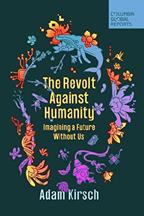
Kirsch, Adam Columbia Global Reports (104 pp.) $16.00 paper | Jan. 20, 2023 978-1-735-91376-6
A critical assessment of the doom ostensibly advocated by the speculative and apocalyptic thinking of anti- and transhumanists.
According to Kirsch, a poet and literary critic, the contin ued existence of the human species is threatened by two con temporary strands of thought. One involves a radical faction of the Anthropocene crowd, which views human dominance over and exploitation of nature as an existential catastrophe in the making. For them, climate change requires the removal of humans through, for example, policies that drastically shrink human settlements to leave most of the Earth devoid of human habitation or that reduce the birth rate to zero. “The idea that we will destroy ourselves by despoiling the planet is…radi cally unsettling,” writes the author. “It means that humanity is endangered not only by our acknowledged vices, such as hatred and violence, but by pursuing aims that we ordinarily consider good and natural: prosperity, comfort, increase of our kind.” The other is a brand of transhumanism wedded to digital tech nologies able to generate “new forms of intelligent life,” thereby freeing post-humans of their material needs. Both strands assert that “the only way to restore the sovereignty of nature is for human civilization to collapse.” In essence, these thinkers “attack the very achievements that humanists cherish,” and their goal is “a world without us.” Alarmist in tone and selective in its reading of the literature—the author rightly includes Eliza beth Kolbert, Naomi Klein, Michio Kaku, and Ray Kurzweil, but where is Bruno Latour’s canonical We Have Never Been Mod ern?—this short book takes scenarios that Kirsch admits are “necessarily speculative” and casts them as real forces having “the power to change the world.” The author fails to acknowl edge that the central thrust of the Anthropocene argument is to imagine and bring about a better humanity (because it’s shared), not to engender a revolt against it. Acknowledging this, though, would cast further doubt on an already one-sided argument.
A brief look at the idea of human exceptionalism, resonant with conspiratorial anxiety.
Kumar, Priyanka
Milkweed (304 pp.)
$25.00 | Nov. 8, 2022 978-1-57131-399-7
A delightful ode to birds and a pow erful defense of the planet we share with them.
In this moving memoir, filmmaker and novelist Kumar explores encounters with birds as meditations on the natural world. Told in a series of vignettes comprised of notable bird sightings, the narra tive offers countless magnificent reminders of the beauty and force of nature as well as warnings of human-caused destruc tion as bird populations plummet due to such factors as habi tat loss, water shortages, and changing temperatures. Kumar didn’t take up birding until her 20s, when a chance encounter on the beach with some avid birders and a flock of curlews transformed her life. This experience became her access point to nature, and she nurtured that connection, whether living in urban settings like Los Angeles or, later, rural New Mexico, where “even the winters are sun-drenched.” Through birds, the author was able to revisit the childhood intimacy with her sur roundings that she cherished growing up in the heavily forested mountains of northeastern India. “Birds became a portal to a more vivid, enchanted world,” she writes, and “allowed me once again to relish solitude in the way I had as a child.” This sense of enchantment permeates the book as she brings us along on her adventures, including long odysseys to see bald eagles, bob cat sightings through her living room window, and glimpses of the mango-colored tanager in a city park. The author is clearly concerned about leaving a planet rich with wildlife for her chil dren, but her ancestors are also on her mind. She lost both her parents and brother as a young adult, and she connects to their spirits through birds and nature. Ultimately, this is a book about the interconnectedness of generations and ecosystems, and birds are the conduit between the two. “Sometimes it just takes the right bird to awaken us,” writes Kumar.

An eloquent depiction of how birding engenders a deep love of our ecosystems and a more profound understanding of ourselves.
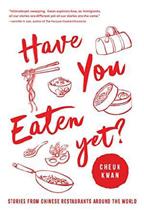
From Chinese Restaurants
A documentarian recounts his jour ney touring Chinese restaurants around
According to Kwan, one of the few things that unites Chi na’s incredibly diverse diaspora is a shared love of Chinese food in all its iterations. It was this shared love that motivated the author, who speaks English, French, Japanese, and a few Chinese dialects, to travel “more than 200,000 kilometers…from the Amazon to the Arctic Circle” in search of Chinese restaurants and the histories they contain. The histories are what interest Kwan the most. Making good on his promise to use food as an “entry point,” the author describes every establishment he vis ited through personal, political, and historical lenses. In Havana, Kwan met a Cuban-born Chinese octogenarian who was also a talented singer specializing in Cuban music. After being robbed in Mombasa, Kenya, Kwan flew to Mauritius, and he traces the history of the Hakka people who settled on this African island in the 16th century. In Haifa, Israel, Kwan learned about how the descendants of Chinese refugees from Vietnam assimilated into Israeli society. “When I was looking for a Chinese res taurant in Israel, it was a challenge to find one run by ethnic Chinese,” he notes. “Most owners were Israelis, with Chinese as cooks or managers. Many even employed Thai cooks, add ing a distinctive Thai flavour to their Israeli-Chinese cooking.” Throughout these encounters, Kwan offers bits about his per sonal life, including his Hong Kong family’s peripatetic life. His rich descriptions, humorous tone, and extensive research make for a pleasurable reading experience. The connections he draws between far-flung places are particularly impressive, revealing a deep empathy and knowledge about the people he encountered. Kwan’s inclusion of his personal history—and the histories of his film crew—gives the book an added feeling of intimacy. Only occasionally does the author feel out of touch—e.g., his lack of a critical lens about Israel’s tumultuous history.
A heartfelt and entertaining culinary and historical survey of the Chinese diaspora.
Buddy St. Martin’s (400 pp.)
| Dec. 6, 2022
The gripping account of a fatal polar adventure.
Journalist Levy, the author of River of Darkness and Labyrinth of Ice, chronicles the tale of an Arctic expedition that featured a great deal of heroism as well as disaster. Its leader was Vilhjalmur Stefansson (1879-1962), an experienced polar explorer who was perhaps bet ter at self-promotion than organization. In 1913, he convinced the Canadian government to finance an expedition to investi gate Inuit people on its northern coast and the poorly charted sea and islands beyond. A veteran of the exploration genre, Levy capably describes the backgrounds of a dozen significant figures and the complex job of buying ships and stocking them with supplies sufficient for several years. In a hint of what lay
ahead, the author notes that the ships were not designed to break through sea ice and were stocked hastily to meet an oblig atory spring departure date. Sailing north during a particularly cold summer, Stefansson’s ship became icebound. After a few weeks, he abandoned it, leaving for a purported hunting trip but then walking to land in an attempt to resume the expedition. Drifting east, the ship was crushed, forcing 25 crew members to survive on the ice and then struggle across 50 miles of frozen sea to a desolate island north of Siberia. Their only advantage was their captain, Bob Bartlett, an Arctic veteran and superb leader who kept them together and, with an Inuit companion, walked 1,000 miles to Alaska to summon ships that rescued 14 survivors. Many fascinating histories of exploration stick to the evidence, but popular writers often novelize their material, inventing dialogues and their subjects’ inner thoughts. Levy belongs to this group, but his tale is entertaining and probably more or less what happened. The author includes maps, a list of characters, and a timeline of “Relevant Arctic Exploration, Expeditions, and Disasters.”

Hair-raising suffering and heroism in the Arctic.
Machado, Jessica Little A (224 pp.) $28.99 | Jan. 1, 2023 978-1-54202-732-8
An editor at NBC News recounts her childhood in Honolulu and young adult hood in Los Angeles.
After her parents’ divorce, Machado, whose background includes Kanaka Maoli, Portuguese, and White Southern Baptist, felt discon nected from her aloof mother and lived in constant conflict with her fiery father during the few moments when he was around. While she was a teenager, she writes, his parenting method “was not one of steady guidance but of pointed instruc tion and interrogation.” The family’s lack of togetherness vio lated the Hawaiian concept of ‘ohana, or caring for the family and community. “Instead of feeling one with the land,” writes the author, “we often felt like islands unto ourselves.” After college, the author moved to LA, where she lived with a room mate from Hawaii. Taking on restaurant work to stay afloat, she was arrested for a DUI and mandated to attend AA meetings and alcohol education classes. The author also writes that she endured sexual assault by a friend and former roommate. Dur ing these years, Machado’s mother, who already suffered from a host of health problems, was diagnosed with cancer. Eventually, the author’s mother and stepfather moved to California, and Machado participated in her care until her death. Throughout, Machado makes sense of her story through Indigenous Hawai ian folktales and the island’s anti-colonial history. It’s clear the author conducted extensive research about these topics. The second half of the text is the strongest, gorgeously portraying the complexity of Machado’s spiral into despair. However, the

protagonist’s slow unraveling is never fully resolved. The author doesn’t delve deep into many of the struggles she faced, leaving readers to wonder what exactly happened and how she over came the obstacles. This lack of cohesion renders the book’s ending unsatisfying and its initial pages difficult to interpret. Overall, though, Machado’s rich descriptions and frank voice make the book worth reading.
A vulnerable but unfocused memoir about loneliness, loss, and finding a cultural identity.

Max, D.T.
(224 pp.)
| Nov. 22, 2022
Final interviews with the great est composer and lyricist in Broadway history.
New Yorker staff writer Max had wanted to meet Stephen Sondheim (1930-2021) ever since, in 1977, the author’s mother brought home a signed copy of the album Side by Side by Sondheim. Falling in love with the “tricky rhythms and harmonic improbabilities” and characters who “were made of doubt, of missteps, of ambivalence,” Max became a lifelong fan. In 2016, he wrote to Sondheim’s assistant to propose a profile and a short piece for the New Yorker. To the author’s surprise, Sondheim responded and agreed to what would become a series of interviews from 2017 to 2019. Those interviews form the bulk of this book. It’s a little crass when Max says he felt he had a better chance than previous jour nalists of getting the famously guarded Sondheim to open up because “he was old now. Coming to the end, to state it plainly.” He admits that, before the first interview, “I could not recall even the most rudimentary things about him,” and that, thanks to his lack of knowledge, “I would be able to push him just far enough out of his routine to get a fresh glimpse of who he was.” That’s a dubious theory and, as this book proves, a flawed one. Much of the information has been documented elsewhere. But Sondheim was a fascinating raconteur, and the book shines when Max allows him to discuss his work. Among the best sec tions are those about Sondheim’s difficulties trying to compose a musical based on films by Luis Buñuel, a project he didn’t com plete; a long conversation on the genesis of the original Merrily We Roll Along; and little-known tidbits—e.g., that A Funny Thing Happened on the Way to the Forum, Sondheim’s Broadway debut as composer and lyricist, was the first show ever to be workshopped.
An adoring but surprisingly ill-informed book about a Broadway legend.
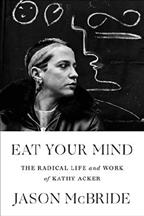
McBride, Jason Simon & Schuster (416 pp.) $28.99 | Nov. 29, 2022 978-1-982117-02-3
The tumultuous life of a singular artist.
Journalist McBride makes his book debut with a perceptive, thoroughly researched biography of the experimental writer Kathy Acker (1947-1997), self-identified as queer, whose publications included 13 “groundbreaking novels,” two novellas, screenplays, poetry, libretti, essays, and criticism. In 1988, McBride, then a college sophomore at the University of Toronto, heard her read and was mesmerized both by Acker’s tattooed muscles and “her fusion of sex and literature, the streets and the academy.” Her iconoclastic works featured a heady collage of “scenes, phrases, characters, and ideas from texts both canonical and otherwise,” juxtaposed with “shards of her own diaries, sexual fantasies, gossip, political screeds, and blunt critiques of capitalism, lib eralism, patriarchy, and language.” She also clawed at childhood wounds caused by a cold, controlling mother and a father, she was stunned to learn, who was really a stepfather. Acker’s bio logical father had abandoned her mother when she was three months pregnant. The “seesaw of seduction and betrayal” that began in childhood became a lifelong torment. McBride recounts Acker’s love affairs, sexual liaisons, two failed mar riages, “semi-regular abortions,” sex work, and emotional afflic tions—depression, anxiety, fear of abandonment—all of which fueled the writing that McBride closely examines. “She wrote,” McBride asserts, “to figure out why she acted in certain ways, why she thought in certain ways, how her memory worked, how experience was perceived and processed and represented.” Furthermore, “she wrote to complicate herself.” Acker could be infuriatingly self-absorbed and needy. “She pushed people away as soon as they came close,” writes McBride, “and then resented them for leaving her alone.” Even when she attained literary success, she insisted she was “an outcast, a traumatized street kid who had overcome enormous pain and adversity.” Informed by Acker’s published works, private papers, and many interviews, McBride presents a persuasive case for her enduring significance as “an icon of unorthodoxy.”
A brisk, engaging literary biography.
“A brisk, engaging literary biography.”

McCallum, Jamie K.
Basic Books (320 pp.)
$30.00 | Nov. 15, 2022
978-1-5416-1990-6
A sociologist shows how the pan demic has changed the world of work irrevocably, but there’s more to be done.
“Work is a scam. We spend far too much time doing it, and most people aren’t paid anything close to the amount of value their labor creates.” So writes McCallum in this timely followup to Worked Over: How Round the Clock Work Is Killing the Amer ican Dream. Meanwhile, the rich profit from that scam—one reason, notes the author, is that they have been working so vigorously to create a narrative by which working-class Ameri cans aren’t working hard enough. That’s not at all the case, McCallum insists. With the pandemic and its unfair demands on those classified as “essential workers”—health care workers, to be sure, but also truck drivers and meat packers—the result was a “Great Reassessment” that became a “Great Resignation” that “helped fuel the Great Discontent,” with its rejection of low-wage jobs on the part of those who were able to search for something better. Much of that essential work, especially that which involved caregiving, has barely been valued at all, con sidered unskilled and compensated accordingly; given demo graphics, that caregiving work is only going to expand. “As the so-called invisible hand of the market attempts to push us off an ecological cliff,” writes McCallum, “it’s the invisible hands of the behind-the-scenes care workers that are propping up our care infrastructure.” Reasonably enough, the author calls for a revised Green New Deal package of programs that considers care workers to be essential workers indeed—and that includes a Medicare-for-all component to boot. Meanwhile, he notes, the capitalists aren’t sitting still. While some have accepted that in order to rebuild the labor market, they’ll have to pay more, others are pushing the “gig economy,” hiring scabs, and other wise attempting to shore up an old, utterly broken status quo.
A thoughtful consideration of work and the workaday world that brings the class struggle to the fore.
The Secret Plot To Kill
Roosevelt, Stalin, and Churchill Meltzer, Brad & Josh Mensch Flatiron Books (400 pp.)
$29.99 | Jan. 10, 2023 978-1-250-77726-3
The Tehran Conference was a pivotal event of World War II, but there was danger lurking in the shadows.
This is a strange—and strangely entertaining—book. Melt zer and Mensch, whose careers have included TV documenta ries, nonfiction, thrillers, and comic books, acknowledge that the events they recount may not have happened, and they have obviously filled in some blank spaces with reasonable specula tion. The authors focus on a possible plot by the Nazis to assas sinate Roosevelt, Churchill, and Stalin—the “Big Three,” as they were called by the media of the time—when they met for a crucial conference in Tehran in 1943 to plan strategy. Several chapters of the book deal with the problems of setting up the conference, especially Stalin’s insistence that it must be held in Tehran. The Nazis, who had a network of spies and sympathiz ers in the city as well as tapped communications line between Roosevelt and Churchill, were aware that the conference was going to happen and saw an opportunity to reshape the global order. There was a plan to send a squad of commandos into the Soviet Embassy, where the meetings were being held, through underground tunnels. But the NKVD, one of the Soviet intel ligence agencies, discovered the plot and intercepted the group before they could do any damage. Much of this territory has already been covered, but Meltzer and Mensch dig up some new material. They admit that several researchers, pointing to contradictions in various firsthand accounts and a lack of docu mentation, have described the “plot” as a Soviet hoax. However, after sifting through the evidence, the authors conclude that there probably was a plot. As in the authors’ previous two coauthored books, The First Conspiracy and The Lincoln Conspiracy, the narrative sometimes wanders away from the main story, but it makes for interesting reading.
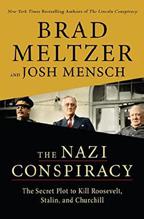
A colorful trek through a labyrinth of twists and turns that could have changed history.

Melville House
Melville House (144 pp.) $17.99 paper | Nov. 29, 2022 978-1-68589-009-4
The latest in the publisher’s Last Inter view series focuses on the grunge icon.
Kurt Cobain’s meteoric rise to musi cal superstardom with Nirvana and troubled descent to suicide in 1994 happened so quickly that it mostly remains shrouded in mystery. This collection pulls back the curtain on how the musician’s mind worked. It’s an odd mix of conversations led by skilled interviewers, including Rolling Stone’s David Fricke and Guitar World’s Jon Savage, and by more amateurish writers. Roberto LoRusso, a DJ for Ontario-based CHRW, titles his 1991 chat “My Embarrassing Interview With Kurt Cobain,” which does include plenty of cringey moments— though LoRusso does nail down that Nirvana’s advance for signing with major label Geffen was $175,000. Even when the interviews lean toward the perfunctory, Cobain’s honesty and genuine engagement make them enlightening. The interviews
chi
also show that the narrative in the early 1990s that Cobain was difficult and constantly strung out was not true. Fricke gets him to explain why Nirvana didn’t tour to support its breakthrough album Nevermind. “I needed time to collect my thoughts and readjust,” Cobain said. “It hit me so hard, and I was under the impression that I didn’t really need to go on tour, because I was making a whole bunch of money….So I thought I would sit back and enjoy it.” Throughout the interviews, Cobain discusses his chronic stomach pain and his complaints about how the media covers celebrities, especially after he married Courtney Love. Though his arguments are debatable, including his thoughts on whether alternative artists should embrace their mainstream fans, they are still well reasoned. “I’ve been validated far beyond anything,” he told Savage. “But I would gladly go back to the point of selling out the Vogue in Seattle, which holds about three hundred people. I’ll gladly go back to playing in front of twenty people—if I’m still enjoying it.”
A collection that helps reveal more about the man behind the mythical anthems of the grunge generation.
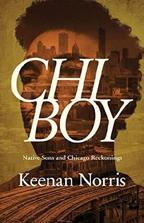
Norris, Keenan
Mad Creek/Ohio State Univ. Press (216 pp.)
$21.95 paper | Nov. 30, 2022 978-0-8142-5853-8
Arresting fusion of literary biogra phy, memoir, and consideration of Afri can American community and violence within a segregated nation.
Norris moves from the Jim Crow South to Chicago to Cali fornia’s Inland Empire, establishing a multigenerational, hard scrabble familial odyssey and a broader discussion of Black endurance and culture. “This book,” he writes, “maps a narrative lineage from the books about black life in mid-twentieth-century Chicago and other Great Migration destinations that my father gave me when I was a boy so that I would understand him better, to the stories about himself.” Writing about his grandfather, Nor ris notes, “it was by assisting in the war effort of the American empire that Gramps won some measure of dignity and self-deter mination.” In contrast, the author portrays his father, Butch, a reserved athletic prodigy targeted by neighborhood gangsters, as “a mystery and a contradiction…an anti-authoritarian lone wolf.” Chicago’s perpetual violence and poverty drove their family to the agricultural West, but Norris remains fascinated by the city’s flaws and rituals. He links this gritty family history to a broader arc of Black radical expression, focused on Richard Wright but also including Barack Obama, Ralph Ellison, and others. Nor ris is troubled by Wright’s misogyny yet argues for the vitality of his Chicago connection: “It is in this crucible of a city where he brings to sharpest, hottest edge his understanding of the devasta tion wrought upon Black America.” The discursive narrative also encompasses how Chicago’s violence is both a cynical right-wing
talking point and a portent of increasingly gentrified, marginal ized urban life, reminding readers that “the dismantlement of gang hierarchies by federal prosecutions and the destruction of the housing projects across Chicago were the all-important cata lysts for the present violence.” The author’s precise, often lumi nous prose powerfully reconstructs his family’s journey and its reflection of Chicago’s troubling relationship to Black America, but the literary and biographical critiques of Wright and others have less visceral impact.
Striking, unusual blend of meditative memoir and urgent social critique.
Nussbaum, Martha C. Simon & Schuster (400 pp.) $28.99 | Dec. 6, 2022 978-1-982102-50-0
The acclaimed moral philosopher advances a theory of justice that enables animals to lead empowered, safe, and dignified lives.
According to Nussbaum, professor of law and ethics at the University of Chicago and author of more than 20 books, humans and animals are moral equivalents and, as sentient beings, merit equal justice. This means substantial opportunities for choice and action in the areas of their lives that they value along with protection from injustices that wrongfully impede a flourishing existence. The latter is particularly critical given the cruelty, deprivation, and neglect that animals suffer. At the core of the argument is her previously developed Capabili ties Approach, which valorizes a person’s (and, now, an individual animal’s) capacity to act and learn within enabling environments. She considers this theory superior to a “so like us” approach, which values animals for approximating human attributes such as speech but lacks “wonder at the diversity of nature [and] love of its many distinctive forms”; a utilitarianism that focuses on a cal culus of pleasure and pain but ignores, for example, the sociabil ity of animals; and a Kantian perspective that treats all creatures as ends rather than means while denying animals moral capacity. However, only beings that are intelligent, sentient, and striv ing (i.e., active in pursuing their goals) qualify for justice, hence omitting crustaceans, coral, and (maybe) bees. The robustness of Nussbaum’s approach becomes clear as she reflects on how we should think about animal death; “tragic dilemmas” that pit humans against animals, as in medical experimentation; compan ion animals; and animal-human friendships. Central to attaining animal justice are legal supports that confer rights on animals and give them standing in the courts. The author is particularly insightful on “four areas of moral unease: medical experimenta tion, meat eating, questions raised by the hunting practices of threatened traditional cultures, and, finally, larger and more gen eral conflicts over space and resources.”
A thought-provoking guide to ethical coexistence with the diverse creatures of Earth.

“Striking, unusual blend of meditative memoir and urgent social critique.”
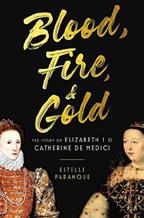
Paranque, Estelle
Hachette (336 pp.)
$29.00 | Dec. 6, 2022 978-0-306-83051-8
A dual biography of two legendary women of the 16th century.
That Elizabeth ruled England from 1558 to 1603 is well known, but readers may need reminding that Catherine de Medici, the Italianborn wife of one French king and mother of three others, was a dominant figure during the reigns of her children from 1559 until her death in 1589. History professor Paranque empha sizes that the two had much in common, including their endur ance of oppressive early years. Marginalized by her father, Henry VIII, due to his obsession with obtaining a male heir, Elizabeth feared for her life during the reign of her predeces sor, Mary, who did not hesitate to execute those she believed threatened her throne. Though a common stratagem in Italy’s tortured politics, Catherine’s marriage into France’s royal fam ily seemed a dead end, as her husband, Henry II, ignored her in favor of his mistress. Matters improved when both Mary and Henry II died within months of each other. Elizabeth became queen of England. Although Salic law forbade women rulers in France, Catherine’s male children required a regent when young and became accustomed to her authority as years passed. The women never met, but they argued, cooperated, negotiated, and made war, usually as enemies but occasionally together, for 30 years, during a time awash in violent religious disputes. These battles tore France apart, and the nation was overshadowed by Europe’s superpower, Spain, which, despite being firmly Catholic, gave priority to its national interests and so sometimes allied with Protestant England, sometimes with France. Inevitably, the text is mostly a record of quarrels and negotiations as revealed in the two women’s massive pri vate correspondence and diplomatic reports. To enliven mat ters, Paranque often converts the material into fictionalized scenes with invented dialogue and insight into the characters’ thoughts. Although not always successfully, the tactic seems to preserve the spirit of the interactions.
Solid diplomatic history and account of the lives of two female rulers who held their own in Renaissance Europe.

Philip, Leila Twelve (336 pp.)
$29.00 | Dec. 6, 2022 978-1-5387-5519-8
A close look at furry ecosystem engineers.
Describing herself as a “self-trained American naturalist,” Philip shares her fascination with beavers, the “wonderfully weird” animal archi tects that are notably odd-looking: “part bear, part bird, part monkey, part lizard, humanoid hands, an aquatic tail.” Among the numerous factoids she shares with readers: “beavers never walked backwards; they ate their food twice; they could not doggy paddle; they had ever-growing orange teeth” with which to gnaw woody plants. Although their dams create homes for fish, beavers are herbivores. In prehistoric times, beavers as large as grizzly bears spread across Asia, Europe, and North America. An estimated 60 million to 400 million inhabited North America “prior to European contact,” figuring impor tantly in the myths, rituals, and even medicine of Native Ameri cans. When Europeans arrived, beaver fur quickly became a coveted article of commerce. John Jacob Astor grew rich from trading in pelts, which supplied the beaver-hat industry. Philip reports in detail on her travels to beaver habitations in north ern Connecticut, the White Mountains, and along the Eastern seacoast, talking to environmentalists and researchers along the way. She visited with a professional trapper who works to pre vent overpopulation and potential starvation in beaver lodges. She attended a fur auction, where beaver skins were among the pelts of other wild animals, including coyotes and bobcats. In the southern Adirondacks, she searched for the beaver sanctu ary created by Dorothy Richards, who lived with 14 beavers in her home. Neighbors thought the “beaver lady” was “nutty.” Most interesting is what Philip learned about beavers’ contri bution to environmental restoration. Dams are only one piece of their intricate and “incredibly dynamic” waterways. Without beavers, wetlands dry up, and “the very shape and function of riverine systems” are affected. Even a relatively small popula tion of beavers can cause major rehabilitation, leading environ mentalists to look to the animals as essential contributors to a thriving planet.
A spirited, informative historical and environmental investigation.
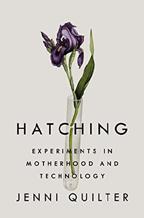
Quilter, Jenni
Riverhead (288 pp.)
$27.99 | Dec. 6, 2022 978-0-7352-1320-3
A look at how mothers are made.
In 2015, Quilter went to an in vitro fertilization clinic with the goal of freezing her eggs. At 35, describing her self as a “white, able-bodied, bisexual, middle-class woman,” she was ambivalent about motherhood but, wanting to keep her options open, decided to take advantage of the new tech nology. Melding intimate memoir and enlightening medical history, Quilter recounts the unexpected journey that began with that visit. Advances in reproductive technology, she knew, have given women—that is, “white cisgender women who can afford it”—myriad choices: “We can fall pregnant without sperm entering the cervix; fall pregnant with eggs that have been harvested from our own bodies years before; develop in our uterus or someone else’s a child that isn’t genetically ours.” But, she discovered, her own choice was limited. She did not have enough eggs to freeze; it was unlikely that she could become pregnant; and if she did manage to conceive, she would probably miscarry early. Devastated, Quilter became intensely focused on having a baby. Her immersion in IVF became both personal (lying on rumpled paper sheets, under going scores of ultrasounds, injecting herself with hormones) and intellectual, as she investigated innovations “for viewing and manipulating female-identified bodies” from the 16th cen tury on. As she shares her frustrating yet hopeful quest, she also offers a history of gynecology, birth control, and attitudes and laws regarding abortion, adoption, surrogacy, and embryo donation. She profiles researchers and physicians, including the two men who created the technology that led to the birth, in 1980, of the first IVF baby, Louise Brown. Quilter considers the views of angry feminists who rose up in the 1980s to deride IVF for affirming “a conservative, heterosexual, consumeroriented vision of a nuclear family.” Though sympathetic, the author never loses sight of the deep complexities inherent in the issue of fertility.
A sensitive, politically astute examination of reproduction.

Richardson, Robert D. Princeton Univ. (136 pp.)
$22.95 | Jan. 24, 2023
978-0-691-22430-5
Illuminating stories of how three of America’s most celebrated authors charted pathways to healing.
In this brief but remarkably rich study, Richardson (19342020) explores how three giants of American thought—Emer son, Thoreau, and William James—struggled with and found vital ways of transcending the grief brought on by losing a loved one. The author, who has written celebrated full-length biog raphies of each of the figures, provides what he terms a “docu mentary biography,” deftly guiding readers through copious quotations drawn from his subjects’ letters and journals. Such an approach, he explains, seeks to “facilitate a personal, even sympathetic, connection—rather than a detached, critical, or judgmental connection—between the reader and the subject.” This aim is vividly realized in the book’s informed and deeply moving considerations of responses to loss. Memorably, we hear from Emerson on his revelatory visit to the Jardin des Plantes in Paris, which provoked in him a salvific sense of “the wonder and power and interconnectedness of Nature” after the death of his young wife; Thoreau, who, in the aftermath of his brother’s death, documented his emerging understanding of natural pro cesses of destruction and creation as ultimately life-affirming; and James, whose cherished cousin’s death finally provoked in him a hard-won awareness that the cultivation of self-discipline and self-government could be the vehicle for extraordinary per sonal resilience. With great sensitivity, Richardson explains the relationship between personal trauma and the philosophical insights that might be generated in its wake, and his restrained but clarifying commentary allows his subjects’ voices to compel our attention. The author expertly frames the emotional and intellectual lives of these three significant artistic figures and demonstrates the relevance, for anyone, of what they accom plished in their profound negotiations with loss.
A stirring and keenly perceptive examination of bereave ment and recovery.
“A stirring and keenly perceptive examination of bereavement and recovery.”

$29.00 | Nov. 29, 2022 978-0-593-54231-6
The supply chain is broken—and it’s not likely to get fixed, at least not as we know it.
It may comfort gun control advocates to know that, in the words of one industry spokesperson, “5.56 ammunition for an AR-15 used to be about 33 cents a round. Now you’re looking at closer to almost a dollar a round.” Blame it on a failed supply chain, and blame that failure on the Trump administration since things began to unravel with the trade war with China. Granted, writes Rickards, it was a mistake to admit China into the World Trade Organization in the first place, and in any event, “stretch ing supply chains to reach cheap labor in China exponentially increases the risk of adverse outcomes on the way.” The author argues persuasively that the supply chain suffers other weak points. Though it has always been with us, its so-called scien tific management has not, and innovations such as just-in-time inventory invite disaster when they run off track. Combine such disasters with stacked-up shipping containers, truckers not moving loads because they’re busy protesting pandemic restric tions, and hoarding behavior, and your local Costco begins to look like East Berlin. What’s more, writes Rickards, our current bout of inflation is a direct result of supply chain disruption, and it’s likely to get worse before it gets better—and might even become deflationary in the end. Given that “Apple works with suppliers in forty-three countries on six continents to source the materials and parts that go into an iPhone,” it’s essential to get things right. Rickards offers an eminently sensible (though costly and surely difficult) solution. Remove regimes such as China and Iran from the global “College of Nations,” establish a “Supply Chain 2.0” that “involves bringing commodity inputs and manufacturing back to the United States and allied coun tries,” limit trade to “trusted partners,” and rebuild the econ omy from scratch.
An alarming but not alarmist book that deserves serious attention from economists and policymakers.

Rifkin, Jeremy
St. Martin’s (304 pp.)
$29.99 | Nov. 1, 2022 978-1-250-09354-7
A scattered invocation of the better future that will come when we give up on the idea of progress.
“Like it or not, each of us is caught up in a giant biosphere classroom where we are learning the les son that each and every act we engage in requires some change, no matter how trifling, in the natural world we inhabit,” writes Rifkin, noting that as a species we’ve done more than trifling damage to the world. As he enumerates, if we each ate 300 trout per year, then those trout would have had to eat 90,000 frogs, which in turn ate 27 million grasshoppers. Given that we eat cows, chickens, and pigs, and not so many trout, our food chain is a kind of economic transaction with “a long entropic tail.” Blame it on a system that assumes that nature is there for our convenience and the point of life is to accrue profit by being efficient actors in the marketplace. Against this, sounding like Charles Reich, Rifkin intones such mantras as “Biophilia is the next evolution of empathic consciousness.” That’s all well and good, but while we’re learning to love our fellow creatures, the world is rapidly disintegrating, and one wonders whether there’s enough time to become resilient—adaptable, that is—enough to embrace the author’s program. Among its tenets: The natural world must be restored, climate change has to be fought, communities need to become “peerocracies,” and children should be educated in such a way that “the natural biophilic impulse embedded in a child’s genetic makeup be expressed and flourish in preschool and con tinue to mature throughout the schooling experience.” It’s a big program, and Rifkin tries to say too much in too few pages; this book is less on point than some of his previous ones, especially Beyond Beef: The Rise and Fall of Cattle Culture
A well-intentioned work with some worthy ideas, but spread much too thin.
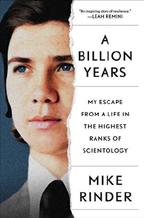
Rinder, Mike Gallery Books/Simon & Schuster (336 pp.)
$28.99 | Sept. 27, 2022 978-1-982185-76-3
A former high-ranking executive chronicles his defection from Scientology.
In this riveting, meticulously detailed memoir, Rinder describes his life as a Scientologist, from when his family “preor dained” him as a child in Australia through his departure in 2007,
at age 52. His parents first heard of L. Ron Hubbard from a neigh bor in 1959. While not inherently religious, both were “attracted by the promise of eradicating unwanted emotions and insecuri ties, having better relationships, raising successful children, and maybe even saving the world.” They were soon immersed in the odd healing rituals and the concept of a superior “thetan” spirit responsible for everything. At 18, instead of attending college, Rinder signed a billion-year “Sea Org” contract and boarded a ship, where he worked as a deckhand in filthy conditions with out pay. Later, during his “slow voyage of self-delusion,” he fared somewhat better, receiving surveyor assignments in Portugal and eventually becoming Scientology’s international spokesman and head of its Office of Special Affairs. At the same time, the organi zation was drawing intense scrutiny from the IRS. Rinder’s chil dren were raised from infancy not by he and his wife but by the Sea Org. The author’s revelations are both fascinating and shock ing: sadistic punishments, zany life-improvement courses, and countless outrageous stories about Scientology’s “darker forces.” After he helped strong-arm the organization’s tax-exempt status with the IRS, Rinder ran interference, neutralized investigations, and obfuscated Scientology’s vast, corrupt hierarchy, which left him overwhelmed and feeling like a “virtual prisoner.” The narra tive takes on the flavor of a suspense thriller after Rinder’s escape, which resulted in his ex-communication, harassment, and numerous dangerous threats by volatile Scientology executives like David Miscavige. While Rinder admits his recollection may be blurry due to the “dull fog of exhaustion,” the voice is crisp, urgent, and vividly impassioned, whether assessing his years as a compliant member, his breathless escape, or his promise to con tinue exposing Scientology as a “unique and vengeful monster.”
An intensely personal, cathartic memoir of blind alle giance, betrayal, and liberation.

Rubenstein, Mary Jane Univ. of Chicago (224 pp.)
| Dec. 6, 2022
A polemical critique of traditional Western economic, scientific, and reli gious dominance as it relates to space exploration.
Rubenstein, professor of religion and science in society at Wesleyan, lends fresh energy to a familiar debate about the value of space programs, dreams of mining the solar system, and colonizing the moon and Mars. Her core arguments are largely unassailable: that lofty visions of extraplanetary development by Elon Musk, Jeff Bezos, and their fellow space cowboys would export the worst of our exploitative and commodify ing impulses, much of it underwritten by taxpayers; that such obscene wealth could be better deployed to constructive ends on Earth; and that a more ethical, environmental approach to space is not only possible, but beneficial to more than the
few. She marshals diverse scientific and historical evidence to buttress her case. Yet her sweeping exaggerations, withering criticisms of capitalism as evil, and recounting of the wretched history of European and U.S. plundering of the Americas become a seething ideological rant unlikely to sway those who otherwise might be receptive. While democratic socialism has its virtues, Rubenstein renders it as a world-saving manifesto. She insists that the only way to halt environmental degradation on Earth (and prevent its repetition in space) is to disavow the darker tenets of Christianity, rationality, and the profit motive and embrace the more benevolent, life-affirming worldview of Indigenous, Afrofuturist, and feminist thought. She is persua sive about our destructive myths, but the lecturing tone smacks of diatribe and serves little purpose apart from letting Ruben stein blow off steam. Most readers will agree that the universe is not there for us to do with as we see fit, nor is the Earth, but regarding rocks as having “personhood” gets a little strained. The author seeks to replace one flawed utopian vision with an idealized, likely unattainable one.
The author has her moments, but there is simply too much pie in the sky to her prescription.
Selected Writings 2001-2021
Self, Will Grove Press (336 pp.) $27.00 | Jan. 17, 2023 978-0-8021-6024-9
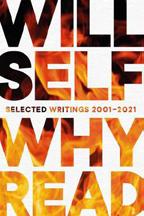
Sharp, trenchant essays from an enfant terrible of modern letters.
In this wide-ranging hodgepodge of pieces, Self reveals a more personable side—a kinder, gentler, more accessible one, even if the prose may send readers scurrying to the diction ary. On a single page from his astute essay on the “otherworld liness of Kafka’s prose,” he uses vermiculated, velleity, inanition, and neurasthenia. The titular essay examines the powerful expe rience of solitary reading, which provides “direct engagement with the mind shaping its language.” Besides, quips the author, it’s freeing to do so whenever we want. In the witty “What to Read?” Self urges us to “read what the hell you like,” later adding, “No, read what you want—but be conscious that, in this area of life as so many others, you are what you eat, and if your diet is solely pulp, you’ll very likely become rather…pulpy.” There’s also “How Should We Read?” while “Reading for Writers” neatly concludes the collection. In between, Self effortlessly weaves his way from such lighthearted topics as shelves, the “very lynchpins of a form of bourgeois domesticity,” to a lengthy, dark, autobiographical piece on W.G. Sebald and the role of the Holocaust in his writing as well as an unfortunately timely piece about his visit to “coruscating” Pripyat, near Chernobyl, at the same time as the Fukushima disaster. In “A Care Home for Novels,” Self argues that the literary novel is “dying before your eyes,” while another essay, from Harper’s in 2018, is titled “The Printed Word in Peril.” Self also delivers an insightful piece
“Plenty to ponder in this energetic, opinionated collection.”
on the “gonzo journalist avant la lettre,” George Orwell; a fine appreciation of William S. Burroughs and his “fiendish parable of modern alienation,” Junky; and a stellar exploration of Joseph Conrad’s forward thinking regarding “space, time and their odd interlinkages” in The Secret Agent. Winding down, “Apocalypse Then” is an introspective, sobering piece on climate change. Plenty to ponder in this energetic, opinionated collection.
Sheehy, Suzie Knopf (320 pp.) $30.00 | Jan. 10, 2023 978-0-525-65875-7
An accelerator physicist takes read ers on a tour of 12 significant scientific experiments of the 20th century.
From the basic structure of the atom to the mass of the Higgs boson, how we understand the world around us—in particular, how we understand matter—has been profoundly transformed in the last century. In this accessible and fascinat ing book, Sheehy shows how human curiosity, ingenuity, and persistence have resulted in ever more sophisticated experi ments designed to test even the most esoteric theories. “Over the course of a century,” she writes, these experiments “have changed our lives in almost every aspect, from computing to medicine, from energy to communications and from art to archaeology.” Among others, the author describes the mechan ics behind the cathode ray tube, the cyclotron, synchrotron radiation, linear accelerators, and the Large Hadron Collider, “the biggest machine on Earth.” Being an experimental physicist requires vision, collaboration, and a skill set that ranges from engineering to mechanics as well as extremely complex math ematics. At the heart of these experiments lies a question that is as philosophical as it is scientific: How does matter interact to create everything, from atoms to apples to human intel ligence? The author blends personal narrative and scientific history as she eloquently explains each experiment, the collab orative effort required for its success, and how the subsequent discovery advanced our knowledge of the fundamental building blocks of our universe—and led to the invention of innumer able technologies, from MRI to GPS. Looking to the future, Sheehy describes the heady possibilities for new experiments, some of which could cost billions of dollars and involve tens of thousands of scientists from across the globe. Such experi ments will hopefully shed light on big mysteries yet to be solved and further enlighten us regarding the entanglement of all of the universe’s matter.
An exhilarating overview of experimental science and the remarkable humans who make discovery possible.

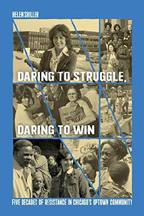
Haymarket Books (500 pp.) $24.95 paper | Nov. 15, 2022 978-1-64259-842-1
A former member of the Chicago City Council reflects on a life dedicated to the never-ending struggle for the “right of all people to life, liberty, and the pursuit of justice.”
Shiller grew up a McCarthy-era child of leftist immigrant Jews who instilled a strong sense of social responsibility from an early age. During the 1960s, she honed the political awareness that followed her through high school and college at the Uni versity of Wisconsin, where she became involved in the anti-war movement and the Students for a Democratic Society. Shiller’s post-college commitment to civil rights action in Racine led to involvement with the Black Panthers, which intensified her desire to fight for social justice. Her grassroots work eventually took her south to Chicago. A single mother, she assisted poor residents in the uptown area through food and clothing distri bution programs and led the fight against the Chicago 21 Plan, an urban renewal project that would further segregate the city. “The plan envisioned a downtown where upper-middle-class families could live and thrive, while targeting surrounding com munities where poor and working people (often of color) lived,” writes the author. In 1978, Shiller ran the first of several city council campaigns but did not become alderperson until 1987, the same year the liberal Black mayor, Harold Washington, won a second term. For the next 24 years, Shiller remained engaged in the fight for affordable housing, increased AIDS funding, more inclusive public schools, and an end to police brutality. Overwhelming in the amount of, at times chronologically frac tured, detail it presents, this hyperlocal narrative, which also includes a Black Panther–inspired 10-point guide to political engagement (“Identify the opposition and deepen the commu nity’s understanding of it”), will most likely appeal to activists and/or readers with a specific interest in the modern political history of Chicago.
An informative book for a limited audience.
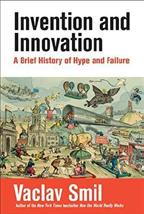
Smil, Vaclav MIT Press (208 pp.)
$24.95 | Feb. 7, 2023 978-0-262-04805-7
A highly respected scientist takes a close, cleareyed look at the processes of invention.
Smil, the author of more than 40 books on scientific sub jects and global matters, is always worth reading. In his latest, the author investigates some technologies that have not lived up to their promise despite huge investments of effort and capital. In the first section, he explores three inventions—leaded gaso line, DDT insecticide, and chlorofluorocarbons—that were initially welcomed but later shunned as environmentally haz ardous. This was mainly due to the long-term consequences not being fully understood or the balance of benefits and disadvan tages not being properly measured. Basically, they seemed like good ideas at the time. The second category deals with inven tions that were supposed to be world changing but never quite got out of a niche—e.g., airships, nuclear fission, and supersonic travel. In these cases, the inventions were overtaken by alterna tives that were cheaper and less dangerous. Then there are ideas that failed to mature into useful technology, like nuclear fusion, high-speed travel in vacuum tubes (hyperloop), and nitrogenfixing cereal crops. These are all intriguing concepts, but there have always been problems that stubbornly resist solutions, and 90% of a breakthrough does not count for much. Smil clearly understands the technical issues involved, but he avoids jargon, and he has a cheeky sense of humor. He wonders why technolo gies that are proven failures receive regular bursts of enthusi asm, and he points to the media as a primary culprit. A novel, earth-shaking invention is an easy headline even if the fine print shows that real-world application is decades away. In fact, the author shows how new-generation supersonic travel would not markedly improve our lives. Today, the most crucial technolo gies involve better water treatment methods and improved agri cultural yields. It may be unglamorous work, but advancements in both would make a critical difference.
An informative, entertaining package from a gifted, origi nal thinker.
Ed. by Stavans, Ilan Restless Books (512 pp.) $35.00 | Jan. 17, 2023 978-1-63206-265-9
Stavans brings together poets and presidents, rappers and novelists to show how language has shaped, and been shaped by, American culture.
Language has always demonstrated the power to both unite and divide, sometimes simultaneously. It is also a field of remark able richness, as this collection of essays, poems, speeches, and song lyrics shows. Stavans, a Mexican American author and academic, presents a broad spectrum of material, from the Pil grims to the age of Twitter, tracking the evolution of American English. For a significant period of time, particularly in the early days of the republic, a common language was seen as necessary to hold a country of immigrants together. Despite numerous attempts to standardize the language, the strength of American
English has always been its capacity to absorb new words and phrases. One major debate involved the role of patois in Black communities, which drew on slavery-era roots: Was it a way to assert independence or a reinforcement of negative stereo types? This argument would continue for decades, although James Baldwin’s 1979 essay, “If Black English Isn’t a Language, Tell Me What Is?” (included here) was a powerful statement for the legitimacy of Black language. A similar theme emerged from Spanish-background writers: How can unity and diversity be balanced within a framework of language? Stavans’ piece on Spanglish points to one path forward. While he acknowledges that America is now in “a time of passionate philological bel ligerence,” as the particulars of language seem to be driving people apart more than bringing them together, Stavans might have offered more material about the impact of social media’s acronyms and contractions on language development. Never theless, the book provides a sweeping historical narrative and solid context for further discussion. Among the many notable contributions are pieces from Sojourner Truth, Mark Twain, Walt Whitman, Thomas Wolfe, Zora Neale Hurston, William Faulkner, Richard Rodriguez, Toni Morrison, Joy Harjo, John McWhorter, and Kendrick Lamar.
A useful resource for the classroom and anyone interested in the history of American English.


The Generation That Redefined Love, Freedom, and Self-Expression in 1920s England Strachey, Nino Atria (304 pp.)
| Dec. 6, 2022
A queer history of the infamous Blooms bury Group and their young acolytes.
In the 21st century, where ENM is used as an acronym for ethical nonmonogamy, it may be strange to think there was a time and place where people had to hide their sexual preferences and the people they loved. Of course, while much has changed for the better, so too has homophobia and discrimination been embold ened in recent years, especially against trans people. This is, in part, what motivated Strachey (a descendant of Bloomsbury’s own Lytton Strachey) to write this book. The author insightfully analyzes the substance of Bloomsbury’s social network, how their lives intertwined as a kind of queer chosen family, and how they adapted to heteronormative expectations while remaining true to their desires and identities. With short chapters written in lucid prose, this is a dream to read for those interested in queer history, and Strachey treats the colorful drama of her subject’s lives with tact. The most delightful surprise here is learning that some of the most beloved pillars of early 20th-century Anglo phone culture—e.g., Virginia Woolf, E.M. Forster, and Lytton Strachey—were not above using their literary gifts for catty mis sives about their fellow creatives or paramours or roommates (or
“A useful resource for the classroom and anyone interested in the history of American English.” the people’s tongue
some magical commingling of all three categories). Queerness has been a social constant through the ages. What’s significant about this meeting of old and young Bloomsbury is how queer cultural knowledge has been exchanged from one generation to the next and how vital that transmission remains. A mistake the young make is assuming their antecedents have nothing left to contribute to an ever shifting present. On the contrary, the bril liant works produced by the luminaries of young Bloomsbury would not have happened without the nurture of old Bloomsbury. Strachey demonstrates this truth with aplomb.
This compact history proves that the lived experiences of our elders are essential resource for succeeding generations.

Suri, Jeremi PublicAffairs (320 pp.)
$30.00 | Oct. 18, 2022 978-1-5417-5854-4
A sharp history in which the author argues that the Civil War has been raging for more than a century and a half—and the Confederacy is winning.
The Civil War “ended only militarily at Appomattox,” writes Suri, the chair of leadership in global affairs at the University of Texas. It has been waged in venues other than the battlefield ever since, often with the aid of those who would have been Unionists in 1861. The battle flag in the Capitol on Jan. 6, 2021, notes the author, came from a latter-day secessionist in Delaware, a 51-yearold White man for whom the Confederate cause “remained alive.” Moreover, it remained alive in various nonimaginary ways: voter suppression, Jim Crow segregationism, lynchings, and spasms of insurrection. In the last case, Suri reminds readers that the smoke had barely cleared from the battlefield when Whites in Memphis rebelled against Union martial law, which was enforced by Black soldiers. The Union general in charge “told investigators that the hostility of the white citizens in Memphis was simply too great and that his forces were too small to counter it,” and no insurrectionists were punished. Once the war was formally over, Whites on both sides essentially abandoned the Black population to their fate, with Reconstruction jettisoned owing to Andrew Johnson’s White supremacism and Ulysses S. Grant’s failure to press for universal civil rights. The result was a Lost Cause nar rative that enabled Southerners, would-be and actual, then and now, to imagine themselves as the victims of the war. The author clearly shows that with the death of James Garfield in 1881, the victorious Union gave up on trying to “build an inclusive, multi racial democracy.” Few of Suri’s observations are groundbreaking, but his prescriptions for finishing that job are meaningful all the same, including “a constitutional amendment guaranteeing all citizens the right to vote.”
A provocative look at a long shadow cast over the nation’s past and present.
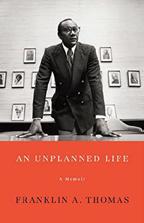
Thomas, Franklin A.
The New Press (400 pp.) $27.99 | Nov. 22, 2022 978-1-62097-757-6
A Black leader charts his distin guished career.
Thomas (1934-2021), president and CEO of the Bedford-Stuyvesant Resto ration Corporation in the late 1960s and president of the Ford Foundation from 1979 to 1996, recounts a life marked by talent, determination, and success. Born to immigrant parents and raised in Bedford-Stuyvesant, Thomas excelled at school even while working to help his widowed mother support the family. He graduated from Columbia in 1956 and from Columbia Law School in 1963. After a few years in the U.S. Attorney’s office, he was named as deputy commissioner for legal matters for the New York City Police Department. Thomas characterizes the trajectory of his life as “unplanned.” Clearly, he was in the right places at the right times to make fortuitous connections, but his many achieve ments reflect his own vision and leadership. In the late 1960s, he met Robert Kennedy, who intrigued Thomas with the inno vative idea of promoting urban revitalization through commu nity and for-profit collaboration. That meeting led to Thomas’ taking the helm at a major restoration project that created a new urban development model—which incited fractious debate. As he gained prominence, he was invited to join the boards of major institutions, including Columbia University, Citibank, Alcoa, PepsiCo, and Conoco. “In more cases than not,” he notes, “I’d be made lead director of those boards as well, the first time a Black person would have the position.” Serving as a trustee of the Ford Foundation during its search for a new president, he soon was tapped for the position—a challenging job at a time when the foundation needed major restructuring and refocusing. At the same time, he devoted his energies and influence to ending apartheid in South Africa. In a memoir that privileges the public over the private, Thomas imparts the political, cultural, and economic milieu from which he emerged and the world he indelibly shaped. Darren Walker, the current president of the Ford Foundation, pro vides the foreword.
A vividly detailed record of significant accomplishments.

Thompson, Erica
Basic Books (256 pp.)
$30.00 | Dec. 6, 2022 978-1-54160-098-0
Math-based models have become the secret machinery of our society, and this book draws back the curtain for a close look.
Reality has a way of confounding expectations, especially those of mathematicians concerned with models. Thompson is a respected statistician whose research focuses on the use of computational models to inform decision-making. In this deep exploration, she delves into the ways in which they have, in many cases, taken over our lives. They are everywhere, from finance to social media to sociology to pandemics to weather forecasts. “If data is the new oil,” writes the author, “then mod els are the pipelines—and they are also refineries.” However, as Thompson shows, more raw material has not necessarily cre ated models that are better at predicting outcomes. Though data scientists love to keep adding more and more data, this can make a model less robust and more vulnerable to excluded factors. There is also the issue that models inherently reflect the values of those that build them, even if the modelers fail to recognize it. “Mathematical modelling is a hobby pursued most enthusiastically by Western, Educated, Industrialized, Rich, Democratic nations,” Thompson writes. “WEIRD for short.” Often, problems arise not from a model itself but from the communication of its output. With climate change models, for example, there is a tendency of advocates to seize on the worstcase scenarios to garner media attention. The scientific veneer of the process can easily turn models into weapons to attack opposing views. As a response to these problems, Thompson proposes a series of questions to ask of modelers in order to identify biases, assumptions, and structural weaknesses. In the end, policymakers should be willing to include model predic tions in their thinking, but they should leaven them with their own experience and judgment. The author, who clearly under stands her field well enough to point out its limitations, offers sound guidance.
A complex subject rendered in accessible terms, with good advice for using models without drowning in data.
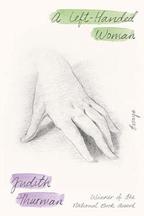
Thurman, Judith
Farrar, Straus and Giroux (432 pp.) $30.00 | Dec. 6, 2022 978-0-374-60716-6
A collection of essays from an inci sive cultural observer.
National Book Award winner Thur man, a biographer and essayist who has been a staff writer at the New Yorker for more than two decades, assembles 40 pieces, published from 2007 to 2021, on art, culture, books, and fashion, many focused on the “lost women who have been my specialty as a writer.” The title comes from her own experience growing up left-handed, which taught her that somehow she wasn’t “right,” a feeling echoed by other women she profiles. While not all have been lost to history—Margaret Fuller, Emily Dickinson, Alison Bechdel, Helen Gurley Brown, for example—each of them defied the image of how a “right” woman could and should behave. Thurman’s discoveries include ceramicist and industrial designer Eva Zeisel, a “maverick modernist”; avantgarde photographer Grete Stern; Black fashion designer Ann Lowe, who created Jacqueline Kennedy’s wedding dress; and outspoken Betty Halbreich, a personal shopper at Bergdorf’s, who gives Thurman a tour of her own cavernous closets. Thur man’s fascination with fashion—as culture, craft, and art— informs pieces about Charles James, Alexander McQueen, Paul Poiret, and Miuccia Prada, occasioned by museum ret rospectives. Thurman’s interests are capacious: lost language speakers, hyperpolygots, Cleopatra, and, not least, art and art ists. When she was in her early 20s, living abroad, she met Bal thus and posed for his wife, also a painter. She recounts a visit to performance artist Marina Abramović at her Hudson Valley home as well as her visits to sites of prehistoric cave paint ings. She also chronicles her discussions with actors Charlotte Rampling (about sex) and Liv Ullmann (about Ingmar Berg man). In her introduction and in a few other essays, Thurman drops a few tantalizing personal details, but memoir is not her aim: “I write about the lives and work of other people in part to understand my own, while avoiding what I feel obliged to do here: talk about myself.”
Finely crafted, graceful, captivating pieces.
“A complex subject rendered in accessible terms, with good advice for using models without drowning in data.”

Tonti, Lucianne
Island Press (240 pp.)
$29.00 | Jan. 19, 2023
978-1-64283-271-6
We seldom think about the origin and impact of the clothes we wear, but this well-researched book shows us why we should.
Tonti is a consultant and journalist who has worked in many parts of the global fashion industry in Melbourne, Syd ney, London, and Paris, and she has seen enough to understand the numerous negative environmental effects. She believes that the fashion supply chain is a significant contributor to green house gas emissions, with polyester being a particular villain. Resource waste and soil degradation are also parts of the pic ture. A key issue is that the fast-fashion trend has led to people buying more clothes than they need, sometimes ludicrously more. “Various reports describe how members of Gen Z refuse to re-wear an outfit once they’ve posted a photo of themselves in it on social media—the terrifying amalgamation of free mar ket and toxic psychological forces,” writes the author. One solution is for consumers to choose clothes made from natural fibers that last longer. Individual pieces might be more expen sive, but the long-term value is there. Not afraid to literally get her hands dirty, Tonti chronicles her travels around the world to find farms that are trying new methods of sustainable pro duction. Even cotton, often seen as an environmental problem due to the amount of water it needs, can be grown sustainably with careful planning and in the right location. The author also highlights the useful work being done with cashmere, silk, and linen, and she explores the potential of hemp and new recycling systems. “For the imperiled fashion industry, regenerative agri culture presents an intriguing solution,” she notes. Refreshingly, Tonti avoids the ideological, scolding tone often used by those concerned with sustainability issues. Even more, her love of fashion and good clothes shines through, injecting the narrative with an uplifting sense of optimism and purpose.
Tonti’s insightful book shines light into the darker corners of the fashion business and points to new ways forward.

Vargas Llosa, Mario Trans. by John King Farrar, Straus and Giroux (288 pp.) $28.00 | Jan. 17, 2023 978-0-374-11805-1

The celebrated author’s personal take on the evolution of his liberal ideas.
Vargas Llosa describes this thought ful, reflective book as an autobiographi cal and intellectual road map to his
journey from the “Marxism and Sartrean existentialism of my youth to the liberalism of my mature years.” The author laid his political beliefs on the line when he ran for president of Peru in 1987 and when he prominently spoke of defending liberal democracy in his Nobel speech in 2010. He returns to Edmund Wilson’s To the Finland Station as inspiration, seeking to do for liberalism what Wilson did for socialism. The map consists of biographies and detailed discussions of thinkers who helped shape Vargas Llosa’s political education. He begins with Adam Smith, the “father of liberalism,” focusing on the “oceanic” The Wealth of Nations, which shows how the free market “brings progress to nations,” fostering the “economic freedom [that] upholds and drives all other freedoms.” Vargas Llosa believes that Spain’s José Ortega y Gasset, the “most intelligent and elegant liberal philosophers of the twentieth century,” has been unjustly overlooked and deserves greater recognition. He admits that Friedrich von Hayek is one of the three modern thinkers to whom he owes the most, and Hayek’s last book, The Fatal Conceit (1988), is “one of the most important works of the twentieth century.” Thanks to The Open Society and Its Enemies, an “absolute masterpiece,” Karl Popper was the “most daring liberal thinker of his age” despite “opaque and meandering prose” and his hatred of TV. Vargas Llosa is also a staunch sup porter of the “pragmatic realism and the reformist and liberal ideas” of Raymond Aron. The author concludes with Isaiah Berlin, the “extraordinarily erudite political thinker and social philosopher”; and Jean-François Revel, one of liberal culture’s “most talented and battle-hardened combatants.”
Vargas Llosa reveals with enthusiasm and aplomb the political and social beliefs that have found homes in his work.
Waldman, Anne Coffee House (320 pp.) $19.95 paper | Jan. 17, 2023 978-1-56689-669-6
The award-winning poet pieces together her life story.
Early on, writes Waldman (b. 1945), she took “an eternal vow to poetry,” and her work has influenced the lives of numerous other writers. Literary boundary-pushers require loyalty, understanding, and close attention from their readers, and this compendium is no exception. Waldman’s assemblage of observations and recol lections (in various forms) displays the restlessness of her life as an activist poet. Immersed in her “frenetic” energy, readers embark on a journey that originates on MacDougal Street in Greenwich Village, where nearly all her neighbors were artists, writers, and musicians. Waldman attended Bennington Col lege, where “highly strung, sensitive, creative students were the norm.” Upon graduation in 1966, she returned to Greenwich Village, where she helped establish the St. Mark’s Poetry Proj ect, which became the spiritual and intellectual home of poets emerging from the 1960s coffeehouse scene. Throughout, the
author tells tantalizingly sketchy tales of friends and collabo rators such as Allen Ginsburg, Ted Berrigan, Bernadette Mayer, Frank O’Hara, and Edwin Denby. Many themes emerge from the scattershot narrative: Waldman’s attraction to and rejec tion of male dominance (“Were our bodies the only source of women’s power?”); her concern over the “cyborgian future” and ecological destruction; and the belief that only poetry can get us out of the mess we’re in. While the text rewards readers with moments of oracular clarity—“We are in the Anthropocene, where nothing is not affected or infected by the ‘hand of man,” our massive carbon footprint, our War Machine”—it is weighed down by imprecise verbiage. Readers would benefit from more clearly marked signposts in the presentation of the poems (in particular) and more hard decisions with regard to content. While Waldman’s loyal readers will undoubtedly seek this book out, it remains an unnecessarily choppy flyover of an important artist’s intellectual and spiritual journey.
An uneven autobiographical rendering from a cultural beacon.

Washington, Ella F. Harvard Business Review Press (320 pp.) $30.00 | Nov. 8, 2022 978-1-64782-128-9
Diversity scholar Washington deliv ers meaningful stories on how companies have—and have not—done the hard work of becoming equitable and inclusive.
An organizational psychologist and business professor at Georgetown, the author began this wide-ranging survey when, after George Floyd’s murder, CEOs and human resources offi cers expressed concern that their companies were not doing enough to promote diversity. Arguing that the effort properly falls under the threefold rubric DEI—diversity, equity, and inclusion—Washington notes, “DEI is a journey. It includes programs, yes, but also making cultural changes, finding new ways to influence people, making difficult decisions, and more.” Some of her case studies are impressively positive even if the journeys are never quite complete. For example, Slack, the tech nology company, began to “shape equity and inclusion into its culture from the start,” with a workforce that has large minor ity representation, numbers nearly 45% women in management positions, and is committed to coaching to advance employees equally. Some companies talked the talk but fell short in reality: Nike did noble work in advancing the idea of diversity publicly but had a workplace culture that sometimes seemed hostile or indifferent to that idea. “To get past this tactical part of the journey,” writes the author, “organizations must create align ment between their DEI efforts internally and externally, and it must come from the top down and emerge from the bottom up.” Many of those alignments come from executives who them selves embody DEI’s goals: A Black woman, for example, has led
her spirits company to a strong position in the sector by “doing something that other spirit brands haven’t figured out how to do, which is to market to everyone.” Similarly, Denny’s, after having been legally enjoined to commit to compliance, became a model in working toward such things as recruiting minor ity businesses into its supply chain and encouraging minority employment in and ownership of its restaurants.
Highly useful for diversity officers, HR workers, CEOs, and activists in the business community.
England’s Medieval Queens, Book Three, 1299-1409

Weir, Alison Ballantine (576 pp.) $30.00 | Dec. 6, 2022 978-1-101-96672-3
Five consorts of 14th-century British kings, hitherto obscure, come vividly to life.
The prolific Weir, a serious historian and diligent researcher, specializes in English royal women, having recounted the lives of Anne Boleyn, Eleanor of Aquitaine, Mary, Queen of Scots, and many others in both novels and books of nonfiction. This book completes the author’s Medi eval Queens trilogy, following Queens of Conquest and Queens of the Crusades. Weir points out that her subjects “grew up in an age in which society regarded women as inferior beings.” The education of princesses emphasized piety and aimed “to increase their desirability in the royal marriage market and equip them to be the ornaments of courts.” Some may not have been literate, and their public influence varied from neg ligible to considerable. As objects of diplomatic strategy, most were French, England’s major rival, betrothed in childhood and married a few years later. In fact, 12 was considered the ideal age for marriage. Most of these royal women accepted their privileged but subordinate role, which featured a great deal of ceremony, religious observance, pregnancy, and family matters as well as occasional brushes with the nasty politics of the time. In addition to political matters, the author examines the women’s wardrobes, hairstyles, jewelry, designs of their living quarters, architecture of their castles, travel itinerar ies, and their royal domestic routines. History buffs may skim some of these sections. Fortunately, Weir regularly steps back to assess 14th-century Europe, “an age that witnessed high drama: the toppling of two kings, the Hundred Years War, the Black Death and the Peasants’ Revolt.” At the same time, she writes, “England saw a burgeoning nationalism and the rise and prosperity of the merchant classes.” The author includes helpful family trees for the Plantagenets and the French royal connections at the time.
Well-researched, competent popular medieval history.
“Highly useful for diversity officers, HR workers, CEOs, and activists in the business community.” the necessary journey
Wilson, A.N. Bloomsbury Continuum (320 pp.) $30.00 | Nov. 1, 2022 978-1-4729-9480-6
A sometimes rueful, sometimes cel ebratory memoir by the prolific British writer.
“Over fifty books published, and prob ably millions of words in the newspapers,” writes Wilson, an author who, his critics charged, “wrote with too much ease.” Pondering the past as a man in his early 70s, the author finds regret at certain roads not taken and certain relation ships broken on the shoals. His father, he recalls, was a director of the Wedgwood china company and “a designer of distinctive brilliance” who was less successful as a family man. For himself, Wilson recalls the brutalities of school, where, he shrugs, “at least the sexual abuse was relatively minor.” (Others, he allows, had dif ferent views on the matter.) Wilson works a number of themes, including indecisiveness and inconstancy, even as he meets and beats every deadline thrown at him. His passing notes on books and writers will be of great interest to every student of modern British literature. His recollections of the travails of Christopher Tolkien, anguished son cast deep into the shadows of his Lord of the Rings author father, are worth the price of admission alone. So, too, is Wilson’s account of how a publisher friend turned down Watership Down and then tried to make up for the gaffe by having Wilson write a novel in which “I should try to do for stray cats what Richard Adams had done for the rabbits of Berkshire.”
It didn’t work. Anglo-Catholic and sometimes arch, Wilson is also a delightfully close observer of the passing scene, as when, at a London bar, he sees “a lower-middle-class imitation of Jac queline Onassis”—none other than Christine Keeler, the real-life model for the politically ruinous prostitute in his novel Scandal Though it ends on a thud, Wilson’s yarn has much to recommend. A readable, often entertaining summation of a life of hard work and second thoughts.

Grand Central Publishing (304 pp.) $29.00 | Jan. 24, 2023 978-1-5387-2360-9
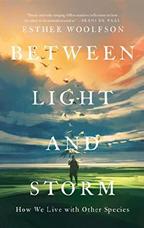
There is a crisis of trust permeating the medical profession, according to this insightful book by a leading researcher.
The practice of medicine is “a science of percentages, a science of intelligent guesses, a science of hedging bets,” writes Wilson, director of Yale’s Clinical and Translational Research Accelerator. “Medicine continues to evolve, with
new discoveries overturning old beliefs, inching us closer to real truth.” The problem is that many patients do not want reasonable guesses but immediate, sure-fire answers. The gap has been filled by alternative healers, naturopaths, and internet marketers who provide diagnoses and cures that range from the esoteric to the foolish. What they are really selling, Wilson suggests, is certainty, a desirable commodity in a chaotic world. Most of the “cures” are harmless, some help patients via the pla cebo effect, and a few are actually dangerous. Yet the public per ception of practitioners of alternative medicine is above that of the pharmaceutical industry. “The marketing of foxglove extract, reiki and qigong is peaceful and patient-centric,” writes the author. “And, of course, no one is paying $80,000 a year for Saint-John’s-wort.” Given these circumstances, Wilson argues persuasively that doctors should spend more time with patients instead of rushing them through as if on a conveyor belt. This would also give them the opportunity to explain the limitations of a proposed treatment. Equally, doctors should be ready to move away from drug-based solutions. Wilson sees an epidemic of “deaths of despair”: drugs, alcoholism, and suicide, driven by isolation and loneliness. These cannot be addressed with pills; lifestyle changes are needed, which means building a trust rela tionship. Mixing hard data with personal anecdotes, Wilson sets out a convincing case, and he does not ignore the difficul ties of making these changes. If nothing is done, the prognosis for the practice of medicine is grim.
In an unstinting appraisal of the profession, Wilson effec tively diagnoses the issues and looks for new paths forward.
Woolfson, Esther Pegasus (368 pp.) $28.95 | Dec. 6, 2022 978-1-63936-276-9

A beautifully written reflection on the enduring conceit of human excep tionalism and the resultant harm caused to animals.
Two suppositions guide this book. One is that all Earth’s creatures possess “an indefatigable determinedness of self”— for this reason, they have a right to flourishing lives. Humans are neither behaviorally nor morally superior, nor are animals “a thing apart.” Animals and humans are equal in moral standing: “If I have a soul, so do my birds,” writes Woolfson, acclaimed author of Corvus: A Life With Birds and Field Notes From a Hid den City: An Urban Nature Diary. Our response to the “egregious, destructive, purposely and wantonly cruel” treatment that animals often receive from humans should be nothing short of indignation. The other supposition is that “our behavior towards the natural world” is shaped by the diverse ways that we interact with it. Woolfson weaves together a rich array of personal anecdotes, historical documents, novels, religious
scripture, philosophical ruminations, and scientific studies to explore human-animal encounters: killing them for food, hunt ing them for pleasure, subjecting them to experiments, display ing them in museums, farming them for use in clothing, and living with them as pets. Woolfson is particularly concerned about arguments that defend human cruelty, as when “tradition” is called on to justify hunting whales and killing birds. Through out, Woolfson’s prose is lyrical—e.g., “the heavy hum of insects in scented air”; regarding vivisection, she recalls accounts “so graphic and disturbing that, like the whispered memories from prolonged and punishing sieges, peculiarly sanguinary battles or wanton massacres, they live to be revisited.” While the author exercises restraint when it comes to justified outrage, she does not wholly resist: “Eric and Donald Trump Jr., enthusiastic ‘big game hunters’, were famously photographed with their kill—a leopard, an elephant, a buffalo. One of them holds up an ele phant’s severed tail. They smile, as they all do, bathed in the full glow of their malignant vacuity.”
Learned, compassionate, and disconcerting, this is a major contribution to the literature on animal welfare.
These titles earned the Kirkus Star:
GOLD by Jed Alexander

FAMILY! by Cale Atkinson
GREAT ZAPFINO by Mac Barnett; illus. by Marla Frazee
OF THE WILD SEA by Megan Frazer Blakemore
SORT OF SAYS by Erin Bow
SICILY by Tamika Burgess
THE INFINITE QUESTIONS OF DOTTIE BING by Molly B. Burnham; illus. by Fanny Liem
FASHIONISTA by Maxine Beneba Clarke
BOOK OF MANNERS by Cindy Derby
THE BOY WHO FOLLOWED HIS FATHER INTO AUSCHWITZ by Jeremy Dronfield
MILLOO’S MIND by Reem Faruqi; illus. by Hoda Hadadi
THE GREEN PIANO by Roberta Flack with Tonya Bolden; illus. by Hayden Goodman
AT THE DROP OF A CAT by Élise Fontenaille; illus. by Violeta Lópiz; trans. by Karin Snelson & Emilie Robert Wong
A MIGHTY LONG WAY (ADAPTED FOR YOUNG READERS) by Carlotta Walls LaNier with Lisa Frazier Page
by Sonia Nimr; trans. by M. Lynx Qualey
MADE OF GLASS by Ami Polonsky
BOMB (GRAPHIC NOVEL) by Steve Sheinkin; illus. by Nick Bertozzi
BEDTIME FOR BO by Kjersti Annesdatter Skomsvold; illus. by Mari Kanstad Johnsen; trans. by Kari Dickson
GOOD HATS by Emma Straub; illus. by Blanca Gómez
GRUMBLEBEE by David Elliot
BIRDS by Laura Gehl; illus. by Gareth Lucas

Adderson, Caroline Illus. by Roman Muradov
Books (72 pp.)
| Oct. 25, 2022
What’s the point of punctuation?
Babble’s citizens can’t communicate. They can’t tell the difference between speech and thoughts; their words run together. A stranger arrives with a bag. She doles out pink, odd-shaped items, explaining each piece’s function and how it will help the townsfolk: a period, a question mark, quotation marks, an exclamation point, and, finally, a comma (which can become an apostrophe). As each item is introduced— villagers don’t know it’s really an enlarged punctuation mark— it’s incorporated into the narrative in black type and in normal font size. At the outset, the text contains run-on sentences, but the gradual inclusion of punctuation renders the text readable as the story proceeds. Furthermore, on a meta level, communi cation among the villagers improves as they learn to distinguish between thoughts and vocalizations. This is an odd, confusing, contrived story. The author suggests that thinking and speaking are the same, that they occur simultaneously, and that people can’t differentiate between them. The tale will confound read ers who know they can’t “see” punctuation marks when they’re speaking and thinking, though vocal intonation can imply cer tain marks. Besides marks, the digital pink-toned illustrations depict the villagers but with few discernible details (race and ethnicity are not made clear from either art or text). This suits the text, which, when lacking necessary punctuation, could also be described as ill-defined.
Aims for cleverness but misses the mark. (afterword with information on additional punctuation marks) (Fiction. 7 10)
GOLD Alexander, Jed Creston (32 pp.) $18.99 | Oct. 4, 2022 978-1-954354-11-1
Assumptions are challenged in this wordless, fairy tale–like story.
In a modern-looking city where anthropomorphic ani mals and humans coexist, a young Black child exits a goldenhued school bus in a golden-hued outfit before walking to
a golden-hued home in an otherwise colorless world. Once inside, the golden child makes themself at home, dropping their backpack, hat, scarf, and shoes aimlessly on the way to the kitchen—via the dining room to grab a chair—and starts cooking porridge. As the child takes the porridge to the table, a trio of bears in matching gold scarves cycle home. At this point, readers may think they know this story based on the visual cues. But Alexander zigs when he could have zagged, and read ers soon learn that the little human protagonist is the fourth member of a loving blended family. Educators will enjoy shar ing this book with children and challenging them to question their biases and assumptions. (Some educators and caregivers may have their own assumptions challenged, too!) It’s a clever and unexpected twist on a fairly (fairy?) well-known tale, and it’s one that belongs on every bookshelf. The illustrations, which have a hand-drawn feel, perform the hat trick of all hat tricks, making the story feel simultaneously classic and contemporary. (This book was reviewed digitally.)
Pure gold—welcome this one into your family! (Picture book. 4 6)
The Musicians, Culture, and Roots of the World’s Coolest Music
Asim, Jabari Illus. by Jerrard K. Polk Black Dog & Leventhal (96 pp.) $19.99 | Dec. 27, 2022 978-0-7624-7941-2

Series: A Child’s Introduction to...
In nine chronologically arranged sections, with scores of cultural and biographical thumbnails, this encyclopedic look stretches from jazz’s roots in African rhythms to the eclecti cism of the contemporary scene.
After establishing a working definition of rhythm, Asim addresses the significance of Congo Square in New Orleans, where enslaved and free Black people congregated on Sundays to dance and make music. There, Cuban, Mexican, French, and local Indigenous musical traditions mingled, setting the stage for regional and global influences to impact jazz. Not unlike jazz’s improvisations, Asim’s narrative nuggets beget each other as players learn from masters like Fletcher Henderson, Duke Ellington, and Count Basie and form their own bands. The Great Migration from the South brings musicians to Chicago, Kansas City, and New York’s Harlem. Cross-pollination—from West Coast to East; from the United States to Europe and back— fertilizes entire scenes. Modern makers mix jazz and hip-hop, sampling midcentury bebop and ’70s fusion in a music defined by innovation. Readers can access audio recordings of instru ments and musical styles by scanning QR codes interspersed throughout, and suggestions for significant songs, albums, and performances to seek out appear in the biographical sketches. Polk’s stylized, captioned illustrations deliver fine likenesses of
musicians, with attention to variations in Black and brown skin tones. Notably, Asim avoids the role of substance abuse in the lives of many musicians.
Both anecdotal and encompassing, this attentive introduc tion ably prepares readers for further learning—and listening. (jazz museums and places of interest, index) (Nonfiction. 8 12)
Atkinson, Cale
Tundra Books (96 pp.)
$12.99 | Nov. 1, 2022 978-0-7352-7243-9
Series: Simon and Chester, 3
A ghost and his living boy buddy get philosophical (and funny).
Readers won’t have to be super fans to enjoy Book 3 in the Simon and Chester graphic-novel series, but they’ll be trying to scare up the previous volumes soon if they start here. Sweet and sassy ghost Simon and his human housemates Chester and Chester’s grandma could hardly be called a “normal” family, but so-called typical family dynamics are exactly what are examined here. After a morning watching cartoons, Chester finds himself won dering what traditional nuclear family life would be like. Main taining that their situation is great, Simon redirects focus to his upcoming Annual Specter Convention, where he’ll no doubt bump into his nemesis, Clancy. Simon departs, and Chester mopes until his friend Amie calls to invite him along on her fam ily’s weekend water park trip. Begging off from his usual cozy routine of puzzles and pizza with Grandma, Chester hops in the car with Amie’s family. What follows is a comedy of errors that creates a perfect aha moment for young Chester, and though Simon ends up tuning out during a lecture at the convention, he finds what he needs in a most unexpected way. Atkinson’s mas tery of facial expressions is unmatched in comics today, and the combination of visual and written humor with genuinely sweet revelations about the nature of familial love is so perfectly balanced it’s simply superb. Chester and Grandma are brownskinned; Amie is tan-skinned, and her family is multiracial.
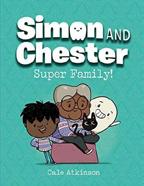
An abnormally good read for the whole super family! (Graphic novel. 6 10)
THE GREAT ZAPFINO Barnett, Mac Illus. by Marla Frazee Beach Lane/Simon & Schuster (32 pp.) $17.99 | April 5, 2022 978-1-5344-1154-8

A diminutive circus high diver loses his nerve.
Behold! Rendered entirely in pencil on transparent film and accompanied by hand-lettered text, this tour de force of
With the midterm elections around the corner, educators and caregivers have an opportunity to get children excited about the electoral process. Granted, it feels like a pre carious time for democracy, with the specter of the Jan. 6 insurrection still looming. Nevertheless, there are rea sons to feel hopeful. In recent years, our government has become far more diverse, with bold newcomers un afraid to take a stand for what’s right, as the subjects of these new picture-book biographies illustrate. From gubernato rial candidate Stacey Abrams, whose mobilization of voters helped flip Georgia from red to blue in 2020, to Rep. Alexan dria Ocasio-Cortez, whose 2018 win was one of the biggest upset victories of that year’s midterm primaries, the individ uals profiled in these books will leave young readers eager to effect change of their own.
Stacey Abrams is a force to be reckoned with—no surprise that there are two new books dedicated to her this year (with another due in December). Sarah Warren’s in sightful Stacey Abrams: Lift Every Voice (Lee & Low Books, Sept. 6), il lustrated by Monica Mikai, explains how the politician’s commitment to justice is rooted in the example set by her community-minded parents. Traci N. Todd’s strik ingly original Stacey Abrams and the Fight To Vote (Harper/ HarperCollins, Aug. 30), illustrated by Laura Freeman, places its subject within the context of the Black wom en who came before her. Sojourner Truth, Ida B. WellsBarnett, Fannie Lou Hamer, and Septima Poinsette Clark form a sort of Greek chorus as they chronicle Abrams’ life, with attention to her efforts to combat the injustices faced by Black voters; throughout, their respect and affec tion for her are palpable (“That child is one of us, too”).

“How did one young Boricua smash expectations / and become a phenomenal force in politics?” An ika Aldamuy Denise’s Phenomenal
AOC: The Roots and Rise of Alexan dria Ocasio Cortez (Harper/Harper Collins, Sept. 6) answers that ques tion with panache, tracking the rep resentative from a childhood in a working-class Bronx neighborhood

to being the youngest woman ever elected to Congress. Denise’s forceful text and Loris Lora’s vibrant images make for a winning profile of a determined trailblazer.
The first Thai American and the first woman with a disability elected to Congress, the first senator to give birth while in office, and the first senator to cast a vote while hold ing her newborn—the subject of Christina Soontornvat’s A Life of Service: The Story of Senator Tam my Duckworth (Candlewick, Sept. 13) has redefined conceptions of what a politician looks like. Ac companied by Dow Phumiruk’s muted yet expressive illustra tions, this multifaceted portrayal of Duckworth covers her childhood travels, the poverty she endured growing up, and the injuries she sustained while serving in Iraq in 2004.
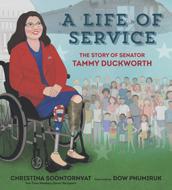
Mama in Congress: Rashida Tlaib’s Journey to Washington (Clarion/HarperCollins, Sept. 20), written by the con gresswoman and her son Adam, with co-author Miranda Paul, offers an appealing child’s-eye perspective on its subject’s path to politics. Narrated by young Adam, visiting the Capitol with his younger brother, Yousif, and their mother, the book makes Tlaib’s journey accessible—and perhaps replicable—to a young audience as Adam discusses his mother’s willingness to persevere despite her initial doubts that a Muslim and Arab candidate could succeed.
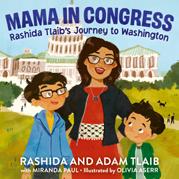
There are plenty of books on the horizon to keep readers interested in the political process in the com ing year, including Tami Charles’ Ketanji Brown Jackson: A Justice for All (Simon & Schuster, April 4, 2023), illus trated by Jemma Skidmore. And with the inspiring Put Your Shoes On & Get Ready! (Philomel, Jan. 10, 2023), il lustrated by Temika Grooms, Sen. Raphael G. Warnock uses footwear as a metaphor for the many jobs he’s held over his life—and for the great things he hopes readers will achieve.
Mahnaz Dar is a young readers’ editor.

visual storytelling features the Great Zapfino, an adorable little man with a pale cue-ball head, huge ears, and a striped bathing outfit. “Prepare to gasp as Zapfino dives ten terrifying stories through the air, landing on a tiny trampoline!” the ringmaster announces as Zapfino enters the circus tent and climbs a ladder to a diving board. Frazee’s grayscale spreads, which simultane ously capture the petrifying perspective and the details of Zap fino’s body language and expressions, leave readers unsurprised when Zapfino bolts from the tent in panic. The remainder of the book is almost wordless and utterly charming; a combina tion of full-page compositions and vignette panels present Zap fino’s new life as an elevator operator in an art deco high-rise by the beach. It’s a simple life: He rides the elevator (marvelous pages full of rectangles tell the stories of the various residents he encounters), makes toast, and gazes at the night sky. Until one day, the toaster malfunctions and he must evacuate via window. And there, 10 stories down, firefighters are holding a trampoline outstretched, waiting for him to jump. Behold! The Great Zapfino comes full circle, conquering his fear and illumi nating the greatness within.
Perfectly plotted and visually superb. (Picture book. 3 8)

Becker, Shelly Illus. by Eda Kaban Union Square Kids (40 pp.) $17.99 | Dec. 6, 2022 978-1-4549-4342-6
Superpowered beings tackle their fears (after some heavy-duty cowering). This brave pack of superheroes may have names like Thrash, Zing, and Screecher, but please don’t think they’re fearless. As a gently rhyming text helps to explain, no matter how brave the superhero, they all have to face scary things from time to time, from stage fright and bugs to claustrophobia and the dark. With each of these examples we see a crew of petrified, cape-wearing good guys who won’t be able to save the day if they don’t act. A number of coping strategies are outlined for handling fears, including talking to mentors and questioning “scared inner voices.” The lesson here is not that superheroes don’t feel fear. Rather it’s that “they feel fear, then choose to be brave!” The stylized depictions of superheroes are a lot of fun to look through, though the advice can on occasion be a bit adult and too vague for everyday use (particularly when saying superhe roes “calculate risks and make logical choices”). Rhymes scan with clockwork efficiency, though it’s unfortunate that the book does use the problematic term thug, as in “Imagine super heroes…afraid of bugs! / Would that prevent them from chas ing thugs?” Both the superheroes and those around them are racially diverse. (This book was reviewed digitally.)
Not quite super. (Picture book. 3 6)

Berkowitz, Leah Rachel & Erica Wovsaniker
Illus. by Katherine Messenger
Apples & Honey Press (216 pp.)
$24.95 | Oct. 4, 2022 978-1-68115-586-9
Stories from the Torah, the Old Tes tament’s first five books, are enlivened.
A Reform rabbi and a Jewish educator use the original text, midrashim (stories that “search or explore” the original Bible), and their own creativity to reinterpret the well-known tales about Adam and Eve, Noah, Abraham, Sarah, Moses, Aaron, Miriam, and others. Sometimes they invent characters, and in the last story, they leap into the future, juxtaposing Moses writ ing the Torah with God telling him about the questions future people will have, even mentioning the smartphone, to show the

Many years ago, my daughter’s perceptive and nurturing first grade teacher said he felt that his primary charge as an educator was not to do anything to quash the intrinsic cu riosity that children had when they walked in the door each Septem ber. Young people’s passion for read ing nonfiction reflects this insight. They may groan over homework or dislike the way certain subjects are taught in school, but offer them superlative nonfiction books like the ones below, and their innate drive to ex plore and acquire knowledge will be clearly evident.
Learning about people’s lives is deeply reassuring, of fering hope when you feel lonely or misunderstood and showing the many ways there are to be human. The fol lowing three books demonstrate the power of literature to show how others overcome challenges and create some thing meaningful in the aftermath:
Braver Than I Thought: Real Peo ple. Real Courage. Real Hope. by Luke Reynolds (Beyond Words/Aladdin, Sept. 13): The title of this book says it all. Reynolds’ profiles show the many ways there are to cope with trauma, offering meaningful, reassuring role models.
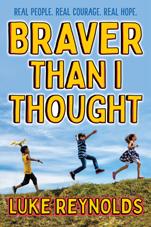
Play Like a Girl by Misty Wilson, illustrated by David Wilson (Balzer + Bray/HarperCollins, Sept. 27): The author (assisted by her illustrator husband) shares sympa thetic, cathartic memories from seventh grade, including playing football with boys and facing changing social and gender expectations.

The Tryout by Christina Soontorn vat, illustrated by Joanna Cacao, col ors by Amanda Lafrenais (Graphix/ Scholastic, Nov. 1): This graphic memoir compassionately highlights the struggles of a biracial middle schooler in small-town Texas, navi gating challenges with friendship, identity, and more.
The world is full of fascinating facts to be marveled over. Young read ers love to collect and recite mindboggling facts, and there’s an endless demand for books that feed this desire to master the known world and pon der the unknown. These two books will not disappoint:
Crash From Outer Space: Unravel ing the Mystery of Flying Saucers, Alien Beings, and Roswell by Candace Flem ing (Scholastic Focus, Oct. 4): Be loved veteran author Fleming returns with an intriguing, well-researched account that is sure to make read ers wonder what we have yet to learn about UFOs.

Full of Life: Exploring Earth’s Biodi versity by Isabel Thomas, illustrated by Sara Gillingham (Phaidon, Oct. 5): Stellar graphics and a well-organized, readable ap proach to its expansive subject matter make this volume stand out; it’s sure to evoke awe for the natural world.
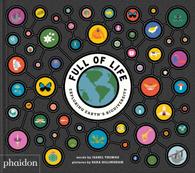
Many books for young read ers describe changemakers who, despite facing adversity, stood up for causes they believed in. Well-known heroes are impor tant cultural reference points, and the value of their sto ries is enhanced by learning about less well-known people past and present like the two below:

Unlawful Orders: A Portrait of Dr. James B. Williams, Tuskegee Airman, Sur geon, and Activist by Barbara Binns (Scholastic Focus, Oct. 18): This inspir ing biography highlights racism in the medical field by introducing readers to a Black veteran who had an impact on the civil rights movement through steadfast, courageous advocacy.

We’re in This Together: A Young Read ers Edition of We Are Not Here To Be Bystanders by Linda Sarsour (Salaam Reads/Simon & Schuster, Nov. 29): A Palestinian Ameri can activist honestly and relatably shares her story of com ing to understand—and being moved to work against— systemic injustices of many kinds.
Laura Simeon is a young readers’ editor.
continuing importance of Jewish learning. Though the events are familiar—the Great Flood, the departure from Egypt and the long desert sojourn—the storytelling is engaging. The bibli cal figures have strong personalities, and the authors make play ful asides, such as a remark from God to Moses when the great leader is worried about his brother’s feelings:“When was the last time you saw Aaron happy?” Although traditionalists may not be comfortable with these adaptations, the stories make real the joy and suffering of the Jewish people during their early days. With particularly rich backmatter (including excellent discussion questions), the book will be useful for some Jewish education programs, but individual readers will also enjoy this less formal approach to the stories that have been taught in reli gious schools and homes and mentioned in secular literature for centuries. Simple black-and-white vignettes accompany chapter headings and are interspersed throughout.
This spirited collection will make the Jewish people’s beginnings tangible to today’s readers. (descriptions of Jewish values and the stories that relate to each value, index of values and sources) (Religious anthology. 10 13)

Blakemore, Megan Frazer
Bloomsbury (256 pp.)
$16.99 | Jan. 24, 2023
978-1-5476-0956-7
A princess, a curse, and a pricked fin ger—but something is different this time.
Harbor Rose, princess of the Lands of Lapistyr, was cursed at her christen ing by one of her aunts. To keep Harbor and her lands safe from the prophesied war and strife, she was whisked away to Small Island, where she lives with her mother and other magical aunts. Harbor spends her time receiving les sons from her aunts and the island’s townsfolk as well as keeping a close eye on the beach for any items that might have washed up from The Somewhere Else. Then comes Harbor’s 12th birth day: The curse comes to pass, and Peter, a boy from a strange land who doesn’t think he’s much of a hero, arrives. Suddenly,

Harbor is the only one who can save her kingdom, her fam ily, and more, as she draws upon the gifts from her aunts and uncovers secrets, some ancient and others much closer to home. Starting with the basic elements of “Sleeping Beauty,” Harbor’s story quickly diverges from the familiar classic, exploring what it means to be a hero, both in our world and in the land of fairy tales. Blakemore blends the fantastic and the mysterious into a fast-paced narrative that still leaves room for the characters to breathe and to wonder. Harbor and Peter are cued White.
An imaginative adventure both familiar and new. (Fantasy. 9 12)
Bow, Erin Disney-Hyperion (320 pp.) $16.99 | Jan. 31, 2023 978-1-368-08285-3

Attempting to start over, a trau matized tween and his parents move to a town where electronic devices are banned.
In a tale that will put readers through an emotional wringer, Bow crafts an uproarious small-town comedy with a devastating tragedy at its core played out by a cast as memorable for its animals as its peo ple. Having gone through a year of therapy and home schooling after witnessing the deaths of the rest of his fifth grade class in a school shooting that happens before the events of the book Simon O’Keeffe hopes the move to Grin And Bear It, Nebraska, will let him escape the relentless notoriety and start seventh grade as an ordinary new kid. As no one in town is allowed to have a computer, cellphone, or even unshielded microwave because of the supersensitive radio telescopes nearby, things go well…for a while. He even makes friends with Agate, a classmate who cheerfully announces that she’s autistic and challenges him to a gross-out contest. (Which he easily wins, what with his mother’s being an undertaker.) Though developments—rang ing from a roundup of escaped emus to being tasked with social izing a winsome puppy in service-dog training—provide plenty of warm and comical moments, the secret comes out eventually, spiraling into a crisis exacerbated by chance events and Simon’s still uncontrollable reactions to sirens and other triggers. Read ers will be relieved and cheered by the way he ultimately finds both the inner stuff and outer support to weather it. The cast largely presents as White.
Adroit, sensitive, horrifying, yet hilarious. (resources) (Fic tion. 9 13)
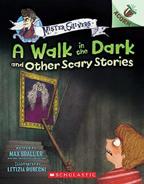
Acorn/Scholastic (64 pp.)
$4.99 paper | Dec. 6, 2022
978-1-338-82196-3
Series: Mister Shivers, 4
New readers should prepare them selves for five tales of terror (and giggles).
What do you do with the child who’s ready to start read ing on their own, loves scary stuff, but may not be emotionally ready for anthologies of true terror? You appease their need for ghosts and ghouls with this illustrated collection that might make them jump but won’t keep them up into the wee hours. As in other books in the series, this installment begins with a grisly introduction via a letter from Mister Shivers, who tells readers that he was sent a notebook of tales (with a warning to share them, or else) and a box of strange items. With topics ranging from a bizarre hotel to a magical pen, the tales are reminiscent of scary stories told around a campfire: They begin suddenly, providing a few details about the setup, ramp up the suspense quickly, and end with a scare (and sometimes a laugh). Readers won’t be emotionally invested in the characters, but they’re not supposed to be; the characters exist for the startling surprise that follows. The illustrations provide an added level of sus pense, mixing dark shadows and spooky characters to keep the excitement going. Readers may take a hint from Mister Shivers’ letter and share these stories (or ones of their own making) at future campfires or during sleepovers; if they do, they’ll be the hit of the night. Characters are racially diverse.
Spooky fun! (Fiction. 5 8)
Bright, Rachel Illus. by Chris Chatterton Orchard/Scholastic (32 pp.)
$7.99 paper | Dec. 6, 2022 978-1-338-82869-6
A group of young “dinosauruses” go out into the world on their own.
A fuchsia little Hugasaurus and her Pappysaur (both of whom resemble Triceratops) have never been apart before, but Hugasaurus happily heads off with lunchbox in hand and “won der in her heart” to make new friends. The story has a first-dayof-school feeling, but Hugasaurus doesn’t end up in a formal school environment; rather, she finds herself on a playground with other little prehistoric creatures, though no teacher or adult seems to be around. At first, the new friends laugh and play. But Hugasaurus’ pals begin to squabble, and play comes to a halt. As she wonders what to do, a fuzzy platypus playmate asks some wise questions (“What…would your Pappy say to do? / What makes YOU feel better?”), and Hugasaurus decides to give everyone a hug—though she remembers to ask permission

“Adroit, sensitive, horrifying, yet hilarious.”
first. Slowly, good humor is restored and play begins anew with promises to be slow to anger and, in general, to help create a kinder world. Short rhyming verses occasionally use near rhyme but also include fun pairs like ripples and double triples. Featuring cozy illustrations of brightly colored creatures, the tale sends a strong message about appropriate and inappropriate ways to resolve conflict, the final pages restating the lesson plainly in a refrain that could become a classroom motto. (This book was reviewed digitally.)
Gently models kindness and respect—positive behavior that can be applied daily. (Picture book. 4 6)
RIPPLE GROVE Broder, Robert Illus. by Melissa Larson Chicago Review Press (32 pp.) $18.99 | Nov. 22, 2022 978-1-64160-819-0
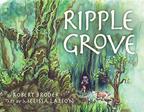
Take a fairy-filled walk through the woods. One pleasant day, Dad introduces his daughter, Stella, to Ripple Grove and tells her a story about the fairies who live there and protect the forest. He believes the fairies are real. Will she? Larson employs three different styles of illustrations: the first, lush mossy green forest and underground scenes; the second, a labeled cartoonish drawing identifying the characters; and the last, annotated maps of Ripple Grove and its multi layered magical world of the Underground Meadow, where an underground River with No Name helps magic crystals grow, and Hobb Hill, home of the Trelfs, “a dirty, rotten bunch who didn’t take care of their trees, or soil, or water” and whose land is dying. The Trelfs want to steal the crystals and keep all the magic while letting Ripple Grove and the fairies waste away. Dad’s storytelling, illustrations that turn somber, and welltimed page turns capture this tense conflict between good and evil as the tiny fairies defend their home from the giant Trelfs. At the end of the father’s tale, the pair head home. The story could end at Stella’s bedtime, but it doesn’t. Subtle hints in ear lier scenes—a portfolio tucked under Dad’s arm—make sense when Dad gets to work drawing after Stella is asleep. Though younger children will enjoy hearing this read aloud, older ones will pore over the in-depth artwork. Both father and daughter present White; the magical beings vary in skin tone. (This book was reviewed digitally.)
A well-told tale sure to enchant older and younger readers alike. (Picture book. 5 10)
Burgess, Tamika
Harper/HarperCollins (304 pp.)
$16.99 | Jan. 3, 2023
978-0-06-315960-0
Sixth grade changes Sicily Jordan’s whole world and how she sees herself.

Sicily lives in San Diego with her parents; older brother, Enrique; and paternal grandmother. While she and her mother are darker-skinned Black Panamanians, Sicily’s father; his mother, Abuela Belén; and Enrique are much lighter, yet it’s never been much of an issue before, as they all share and celebrate Panameño heritage. Sicily has a tightknit friend group of Black girls who, due to school zone borders, won’t be going to her new school with her. At Shirley Chisholm Middle, while also working tirelessly on chal lenging school assignments and friendships, culture and iden tity become a stressful focus for Sicily. Her classmates find the

 BY MAHNAZ DAR
BY MAHNAZ DAR
Whether he’s visiting the ruins of Pompeii, New York City, or his hometown of Roanoke, Virginia, The odore Taylor III is alert—he never knows where he might find an example of street art. (Yes, he’s found examples of the art form in all three places.) It’s long been a passion of his, one that he explores in his pic ture book Off the Wall (Roaring Brook Press, Oct. 11), which follows Sam, a Black child who feels out of place after moving to the suburbs from the city. Under the guidance of her cousin, Lincoln, Sam observes graffiti all over her new town and even finds a community of graffiti artists—experiences that parallel Taylor’s own life. As he tells Kirkus on a Zoom call from his home in Richmond, Virginia, he’s been photographing images of graffiti for years. “It’s just fun to spot things in plac es and wonder who did it.”
Taylor, 36, was introduced to the art form as a child playing Jet Grind Radio, a video game in which play ers skate through the streets of Tokyo spraying graffiti. On a high school trip to New York City, his interest grew. “Just seeing graffiti everywhere…it was fascinat ing to me.” After that, while staying with his grandpar ents in Washington, D.C., he visited Adams Morgan,
a culturally and artistically rich neighborhood where he observed eye-catching murals. “[I saw] a lot of edgy public art, versus what I was used to in Roanoke,” he says.
Like his protagonist Sam, Taylor has found joy in coming across graffiti in unexpected places. Though Roanoke doesn’t have a big street art scene, a friend of his has shown him out-of-the-way places where it can be found. “He took me into a lot of random corners of the city where I would never think to go. And you see evidence of people having been there.” And on a trip to Pompeii, he was struck upon seeing ancient graffiti. Street art, he feels, is “just a thing people do,” a kind of universal urge to leave one’s mark.
In Off the Wall, Sam not only sees street art; she also meets local artists who are transforming an abandoned factory into a vibrant artistic space. Joining them, she finally feels a sense of belonging. Like Sam, Taylor ini tially struggled to find community growing up, often feeling out of place. “Most of my friends were White. I remember my grandmother asking why I didn’t have more Black friends,” he says. “I was also a nerd. All my friends were nerds.”
Although he loved art, his high school in Roanoke didn’t offer a lot of support. “They wanted to cut off our advanced art program,” he says. When he went to college, however, Taylor bonded with friends who shared his passion. “So that’s where that concept came from. Just finding my people.” He pays tribute to many of his friends within the book, weaving in references to people’s names in the graffiti art. “We lost a friend a few years ago. And I put his previous Instagram user name, Kazma, on one of the trucks,” he says.
In college, Taylor began following local graffiti art ists as well as muralists such as David Choe. Brazilian culture was also an influence; Taylor was drawn to Bra zilian music and the film City of God. He drew inspira tion from the art book Graffiti Brasil (2005) by Caleb
Neelon and Tristan Manco. Whereas American graffi ti tends to focus on words, he says Brazilian street art features depictions of human figures—something that readers will also notice in Off the Wall. “They just seem to have a lot more fun playing with characters.”
Though he’s a big fan, Taylor isn’t a graffiti artist himself, so when it came time to create the illustra tions for Off the Wall, he was understandably anxious about getting it right. “I watched a lot of YouTube graffiti artists giving advice on how to draw graffiti… because I just wanted to make sure it looked authen tic. And also I had some friends that I asked for advice as well.”
He adapted his own technique accordingly. “When you’re working with spray paint on a wall, you start with the color layer first and then work on top of that. It’s kind of the opposite of the way I work, where I do the linework first and then add the color. So I tried to just pretend I was doing graffiti, but on my iPad, ba sically, where I would just do the color first and then work on top of it.”
Though Taylor hopes that readers come away with a greater knowledge of the art form, he also wants to leave them inspired to find their people, just as he did. “If you’re feeling alone,” he says, “just go exploring. Just find people who have similar interests, because it’s im portant to have a sense of community.”
Off the Wall received a starred review in the Sept. 1, 2022, issue.

existence of Afro-Latine people inherently confusing and say so in hurtful ways. Meanwhile, at home, Abuela Belén’s deepseated colorism and racism boil over into hostile interactions with her vulnerable granddaughter. Sicily feels attacked from all angles, and while supportive conversations with close friends and family are heartening, her convictions as a writer like her late Abuelo and a researcher of her own heritage impressively model the ways an ordinary girl—consistently serving fab lip gloss looks—can be an extraordinary self-advocate even when she shouldn’t have to be. The laudable culmination presents all Sicily has learned about herself and Panamanian history and, in doing so, offers a striking learning opportunity for those who struggle with understanding cultural and racial differences.
Prejudice can show up anywhere; this smart, rich novel deserves to be read everywhere. (Fiction. 9 13)
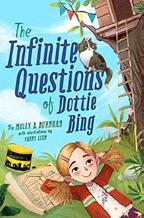
Burnham, Molly B. Illus. by Fanny Liem Dial Books (208 pp.) $17.99 | Jan. 17, 2023 978-0-593-40666-3
A child deals with loss.
When 10-year-old Dottie Bing’s Grandpa Walter shows up at her house, he is carrying a Chock full o’ Nuts coffee can and his suitcase. He is there to visit after the death of Dottie’s grandma Ima. Dottie soon realizes Grandpa Walter goes everywhere with the coffee can, which is filled with Ima’s ashes. He brings it to the kitchen, where he pours two cups of coffee; he reads out loud to it; and he plays cards with it. Dottie is puzzled, but she is deal ing with her grief in her own way—building a treehouse, because Ima always wanted one. Her best friend, Sam, is excited to help in this mission—a word Dottie knows Sam will like, since he loves using complex vocabulary, introduced throughout (which readers will delight in learning and using). Tucked into this bril liant mix of a plot is Miles, an unfriendly boy who is always mak ing fun of Sam and Dottie, and Dottie’s younger sister, Jazzy, a force of nature in a 4-year-old body. As Dottie and Sam build the treehouse, Dottie focuses on all the animals in her stomach—an effective, original metaphor for her churned-up feelings of grief and change. Embellished with black-and-white illustrations, this surprisingly humorous story has narrative details that fold seamlessly into the overall plot while cleverly enriching it. Most characters read as White in the artwork; Sam is trans.
Profound in its own sparkling, humorous way. (Fiction. 8 10)
young adult
Butterworth, Nick Harper/HarperCollins (32 pp.)
$18.99 | Sept. 6, 2022 978-0-00-848435-4
Series: Percy the Park Keeper
Sometimes, (day)dreams do come true. In the latest in the series, the hedge hog who lives in the park where light-skinned Percy works is asleep, dreaming about the joy of flying. But he’s rudely inter rupted by a shower of buckeye chestnuts, and he rolls himself into a protective ball. In a laugh-out-loud scene, the hedgehog uncurls to see a strange bird named Carla “tangled up in what looked like a clothesline and…going up and down like a yo-yo.” At Carla’s request, the hedgehog doesn’t tell Percy what’s going on and does his best to help. First, the hedgehog trots off in search of food for Carla and returns, after a bit of a tumble, with his spines stuck in one of Percy’s sandwiches, a giggleworthy image. The chatty Carla explains how she ended up like this: Spotting some food near the clothesline, she swooped, but the clothes “went flappy-flap,” she hit her head, and then she got tangled. Carla hurt her head, so the hedgehog races off to Percy’s to get Band-Aids and creates quite a mess in the pro cess. Luckily, Percy arrives to untangle Carla. During the few days Carla spends recovering, everyone works out a plan to help the hedgehog’s dream of flying come true. The smile on the hedgehog’s face is priceless, as are the warm, cozy illustrations in this tender tale of friendship and community. (This book was reviewed digitally.)
By turns funny, poignant, and affirming. (Picture book. 4 7)
Clanton, Ben Tundra Books (80 pp.)
$12.99 | Oct. 4, 2022 978-0-7352-6672-8
Series: Narwhal and Jelly, 7
Narwhal wildly takes Jelly’s casual question way too far in the latest install ment of the fan-favorite graphic-novel series.
Narwhal always claims to be the unicorn of the sea, but do they even know what a unicorn is? Jelly wants to know, and their waffle-fueled pondering sets the stage for the deep-sea duo’s latest adventure. Narwhal insists they do know what a unicorn is (a land narwhal, of course) and enthusiastically encourages pal Jelly to meet them that night at the big beach for an out-ofthis-world adventure. When Jelly arrives, Narwhal’s wild, weird surprise is that they know an actual star and some special words that grant them a very special wish—the ability to walk on land to search for a unicorn. While an excited Narwhal sprouts hair and learns to run and dance, a tired, nauseous Jelly is relegated to a fishbowl on Narwhal’s back. Though Jelly’s irritation and frustration will be apparent to readers, Narwhal does not notice.
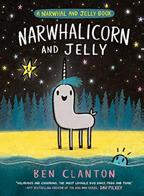
Clanton’s focus on social awareness and listening gives Narwhal an opportunity to work on some social-emotional development that will surely increase their capacity for empathy in future adventures. With splashes of new hues to the usually blue, gray, and yellow palette (added to depict some intergalactic excur sions), readers will find themselves satisfied with the happy resolution and wishing for more.
A wonderful, whimsical romp for fans of this heart-filled buddy comedy. (Graphic fiction. 6 10)


Clarke, Maxine Beneba Candlewick (48 pp.) $18.99 | Dec. 6, 2022 978-1-5362-2377-4
A kaleidoscopic tribute to fashioni stas of all colors, shapes, sizes, and ages.
Clarke creates a runway of fashionloving folks of various skin tones who rock their styles with verve and vitality alongside verse that rolls off the tongue and delights the ear. The characters’ lack of facial features invites readers to imagine who might be wearing each outfit (and how they feel) and suggests that anyone of any back ground can embrace their bodies as a canvas on which to write their own artistic story. When the narrator chimes: “Be your / BOLD-BIG-SELF, / brave in bright brilliant blue hair: deli ciously different, dramatic and daring,” a brown-faced individual with textured, electric blue hair appears in silhouette. Some of the images clearly represent children, like a skirt made of flowers above a pair of brown legs with feet shod in frilly socks and ruby sequined Mary Janes. Others portray more seasoned individuals, like the two elderly, dark-skinned people using canes and wearing neckties, dress shirts, and fedoras with colors that echo the pat terns in their clothes. Although the bold-colored backgrounds change from page to page, their singular color makes Clarke’s amazing, unique mixed-media collage illustrations of people— “CHIC-A-BOOM! CHIC-A-BAM!”—pop and announce their presence. (This book was reviewed digitally.)
A luminous picture book that exudes joy as it celebrates the freedom to be the one and only you. (Picture book. 4 10)

MORNING SUN IN WUHAN
Compestine, Ying Chang
Clarion/HarperCollins (208 pp.)
$16.99 | Nov. 8, 2022 978-0-358-57205-3
A pandemic story told through the eyes of a girl growing up in Wuhan, China, author Compestine’s own hometown.
Grieving her mother’s death and with Father busy working as a physi cian at a major hospital, 13-year-old Mei
often finds herself home alone. She fills the solitude with her favorite pastime: cooking. When she isn’t busy in her apart ment kitchen, she jumps into her virtual one in the computer game Chop Chop. There, she and her teammates’ key strokes and culinary knowledge fend off zombie invaders by making sure the soldiers are well fed to fight. Mei’s virtual escape soon becomes all too real, though it is not zombies that threaten but the new airborne viral disease the world will come to know as Covid-19. As the city enters lockdown and neighbors fall ill, Mei joins forces with her gamer friends to prepare meals and coordi nate food deliveries to their neighborhoods. All the while, Mei’s own anxieties simmer on the back burner: Is her father safe working at the hospital? Does her Aunty hate her for choosing to stay with Father? Readers who have lived through the pan demic over the last few years will surely identify with Mei’s wor ries and hopes for a brighter post-pandemic future. The simple story is a bridge builder across geography and culture, universal in its themes of family and community through the global pan demic, encouraging empathy, introspection, and optimism.
Endearing, hopeful, and sure to make your mouth water. (recipes, cooking glossary, information on cutting techniques, author’s note) (Fiction. 8 12)
Cunill, Marta Trans. by Susan Ouriou Owlkids Books (32 pp.) $18.95 | Aug. 16, 2022 978-1-77147-536-5
Procrastination gets you nowhere.
Birds start taking off from their forest dwellings in autumn, but three unnamed lazy members of the flock would prefer not to fly off. They’d rather hang around and sleep instead—and they awaken to find themselves wet and freezing as winter sets in. To combat the cold, the trio don winter coats like humans. The coats keep them warm but prevent them from flying. The next plan is to wait out the winter underwa ter, like fish. That probably would have worked if it weren’t for the pesky issue of breathing. In a last-ditch attempt, the birds take a lesson from the bears and try to hibernate, set tling inside a hole in a tree. It seems to work for a bit, but bore dom sets in, and the birds finally decide to fly south to join everyone else. When they arrive, their flock is making plans to fly north again, as winter is coming to the Southern Hemi sphere. Translated from Spanish, this is an amusing story of procrastination—and perhaps a gentle reminder to readers of all ages just how hard we work at times to be lazy. The cartoon illustrations are bold enough that librarians and educators will happily share this book during storytimes and read-alouds. Caregivers and educators will appreciate the doors this book opens regarding topics such as seasonal change, animal habits, and migration. (This book was reviewed digitally.)
Don’t be lazy—read this entertaining tale of an aimless yet relatable trio. (Picture book. 4 8)

Davis, Tanita S.
Katherine Tegen/HarperCollins (336 pp.) $16.99 | Jan. 17, 2023 978-0-06-314357-9
A girl with a learning disability navi gates the demands of her new school and family dynamics.

Henrietta “Henri” Weldon, a Black tween, is cautiously excited about starting seventh grade. It’d be helpful if her older sister, Kat, answered any of her probing questions about what to expect, but she’s acted strangely ever since Henri completed her math placement test. In the middle of a mentally taxing first day, the last thing Henri needed was to drop her change in the lunch room, but it results in her meeting Vinnie Morgan and his mul tiracial group of foster home siblings. As they form friendships, Henri craves the bond that the Morgans possess; it contrasts

“Uplifting and amusing, this book will leave readers with valuable lessons.”
figure it out, henri weldon
with her own competitive, driven family. Kat warns her to stay away from the Morgans, however, seeing them as troublemak ers. But Henri doesn’t have much time to worry about this, as she tries to stay on top of parental schoolwork expectations, playing soccer, and writing poetry. The story’s brisk pace and accessible vocabulary help readers quickly get to know Henri and the interesting supporting cast. Without sacrificing the story’s light tone, the author highlights the daily obstacles that Henri confronts due to her dyscalculia (which is never explic itly named in the text) and her longing for a tighter family unit. Skillfully realized, this is an affirming and inspiring tale for read ers who are only ever told what they can’t accomplish.
Uplifting and amusing, this book will leave readers with valuable lessons. (Fiction. 8 12)

Derby, Cindy Roaring Brook Press (48 pp.) $18.99 | Dec. 6, 2022 978-1-250-81035-9
What are manners without kindness?
Or, for that matter, fart jokes?
Meet Ms. Elizabeth Picklepop IV. You are delighted to make her acquaintance. After taking her course on manners, readers will receive a certificate of comple tion. However, when blue-skinned Ms. Picklepop happens to drop an errant paint can, it results in an overly enthusiastic blue blot with eyes that becomes sentient. Every lesson Ms. Pick lepop attempts to convey has the unfortunate consequence of attracting the attention of the creature, named Blurp (chang ing colors with every paint can they chug en route). Though well-intentioned and good-natured, Blurp causes massive paintsplotch–riddled chaos wherever they go, until finally Picklepop can take it no longer and becomes significantly less than wellmannered. Will she see the error of her ways? Derby’s natural inclination to play with paint like a child in a mud puddle comes fully to her aid here. Picklepop’s world is all hedgerows and ele gant teas. The sheer, wild exuberance of Blurp comes, then, as a cathartic corrective. The great irony of the tale, of course, is that at the same time that Blurp is instigating a visual cacoph ony of colors, their manners are impeccable, if riddled with B’s (upon introducing themselves, Blurp says, “Bits bice boo beet boo”). (This book was reviewed digitally.)
Emily Post might raise an eyebrow, but our hero is bound to find fast friends with ill-mannered readers everywhere. (Pic ture book. 3 6)
Dill, Khodi
Illus. by Chelsea Charles
Triangle Square Books for Young Readers (52 pp.)
$19.95 | Oct. 4, 2022 978-1-64421-187-8
An ode to Black children, affirming their worth and teaching them about those who walked the path of greatness ahead of them.
A narrator cautions a young Black child seated in front of a wall of television screens to turn away from the displayed images of protest and violence, warning that the news can make them “feel numb” while also explaining that change is possible and that “little Black lives matter.” The narrator notes that there have been others like readers who lived “little Black lives” before growing up to effect change and shape history in momen tous ways. The words and actions of 15 remarkable Black figures are subsequently presented, including those who are commonly found in children’s history books, such as Dr. Martin Luther King Jr. and Rosa Parks, and others who are not, such as gay lib eration activist Marsha P. Johnson, whose vibrant likeness is fea tured on the book’s cover, and Fred Hampton, chairman of the Illinois Chapter of the Black Panther Party. The rhyming text used throughout works well for reading aloud; however, some vocabulary seems advanced for the targeted age range, and the frequent refrains of “little Black life” and “little Black lives” risks trivializing more than empowering. Straightforward illus trations complement the text. (This book was reviewed digitally.)
A broad introduction to important figures in the ongoing struggle for Black liberation in the United States. (Informa tional picture book. 6 9)

Doi, Kaya Trans. by David Boyd
Enchanted Lion Books (40 pp.)
$16.95 | Nov. 1, 2022 978-1-59270-384-5
Series: Chirri & Chirra, 8
Chirri and Chirra have another fantastical adventure in this latest installment of the Japanese series.
The identical dark-haired, pale-skinned duo, as always dressed in white with black leggings, riding their identical bicycles, follow the sound of drums as the sky darkens to night. Ahead, they see lights at the edge of the forest and a bevy of cats beckoning them to a brightly decorated booth, where they are offered sparkly, delicious full-moon sodas, with the reflection of that moon “shining its face” in their goblets. After several of these drinks, the children grow pointed ears, whiskers, and tails and develop keen night vision. They are given necklaces of beautiful flowers and pedal to the Full Moon Festival, where they see booths of unusual delights. Along with all the cats, they


circle a perfectly round lake, and the loveliest magic of all occurs. When the cats touch the necklace flowers to a lantern flame, they sparkle and glow and become beautiful “flowerworks.” The children pedal home safely, guided by the full moon and no longer sporting tails or whiskers. The text is spare and descrip tive, while the charming, softly focused illustrations add detail and dimension. Chirri and Chirra are game for adventures and trusting of the characters they meet. Nothing remotely fright ening interferes; it is all pure, gentle magic, fantasy, and lively imagination throughout. (This book was reviewed digitally.)
Sweet, wonderful make-believe. More of this duo, please. (Picture book. 3 8)
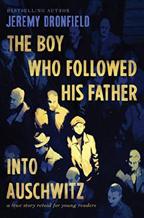
Dronfield, Jeremy Quill Tree Books/HarperCollins (384 pp.)
$16.99 | Jan. 17, 2023 978-0-06-323617-2
A family’s experiences in the Holocaust told in heart-stop ping, relentless detail.
Dronfield emphasizes that the horrific events are true and the Jewish family at the center of the story is real. In 1938 Vienna, Gustav and Tini Kleinmann, daughters Edith and Herta, and sons Fritz and Kurt were living quiet lives in a small apartment above Papa’s upholstery shop. When Hitler invaded Austria, the Nazis immediately enacted anti-Jewish laws. On Kristallnacht, synagogues and Jewish businesses and homes were looted, smashed, and burned. Former trusted friends betrayed them and were instrumental in what followed. Mutti filed applications, hoping the children might get limited spots in rescue programs—Edith eventually secured a British work permit; later, 10-year-old Kurt was allowed to go to America. While Kurt found a loving surrogate family, he always wor ried about his loved ones. Fritz and Papa endured yearslong nightmares in Buchenwald, Auschwitz, the Death March, and Mauthausen. The beatings, forced labor, starvation, illness, death, and brutal deprivation they witnessed and endured are meticulously described, interwoven with necessary historical background and sparing readers nothing. Nazis, collaborators, and fellow prisoners alike are identified by name, and grateful credit is given to those few who showed kindness. Dronfield informs readers of each character’s fate, some surviving and reuniting and others murdered, lost in the horror that was the Holocaust. Reading with a knowledgeable adult would be invaluable and comforting.
Difficult, gut-wrenching, terrifying, gruesome, and so very important: never again. (timeline, author’s note, glossary, further reading, bibliography, source notes) (Nonfiction. 11 16)

Charlesbridge (32 pp.)
$17.99 | Jan. 17, 2023 978-1-62354-166-8
A true and tender tale that celebrates the lasting bond that forms between a small penguin in dire straits and the man who rescued him.
One day in May, Seu João finds an oil-soaked Magellanic penguin on the beach at Praia Provetá and takes him home to clean him up. He assumes the bird won’t hesitate to return to the ocean, but even when fully recovered, Dindim, as he’s dubbed, has different ideas. The two—one a shin-high poppet clad in formal black and white in Alarcão’s pastel-hued illus trations, the other a light-skinned elder aglow with wrinkled benevolence—become constant companions…until, one hot day the following February, Dindim begins to molt and, around the time of Carnaval, doesn’t come back from his accustomed swim. But then, four months later, he waddles back out of the ocean to touch his bill to a delighted Seu João’s nose, and so con tinues an annual pattern that goes on for seven years. In group scenes the illustrator populates the warm and sandy Brazilian setting with multihued local children in animated poses and, though he portrays Dindim with plenty of personality, resists the temptation to anthropomorphize his feathered subject. Earle expands a closing note on the real Dindim with remarks about Magellanic penguins in general and environmental and other threats to them. (This book was reviewed digitally.)
An episode with a strong sense of place awash in humor and heart. (glossary) (Informational picture book. 6 8)

Edelman, Claudia Romo & Sara E. Echenique
Illus. by Manuel Gutierrez
Roaring Brook Press (112 pp.)
$5.99 paper | Sept. 6, 2022 978-1-250-82810-1
Series: Hispanic Star, 1
A hagiographic account of the rise, career, and legacy of the first Latine player elected to the Baseball Hall of Fame.
Noting that his life was shaped by “many strong women”— like his hardworking mother, Luisa, who could lift entire beef carcasses with her “powerful shoulders and arms”—the authors characterize their subject as a “strong, passionate kid” who succeeded through relentless dedication to achieving his goals, continued to play at a high level despite injuries, and, to the end of his life in a plane crash (delivering relief supplies to Nicaragua in the wake of an earthquake), never lost either his pride or his
concern for the welfare of others. His private life and religious faith receive at best cursory notice and his baseball career little more, but along with the Taíno, Spanish, and African cultural milieu in which he grew up, both the colorism he faced (being relatively dark skinned) in his native Puerto Rico and the racial prejudice he encountered there and while playing in the States both from the media and his teammates receive indignant scru tiny. Gutierrez adds realistically modeled portraits of Clemente in various team uniforms on and off the field or posing with his family and friends. The final chapter of posthumous awards and accolades ends with a challenge to readers: “He moved others to help people and make a difference, to not ‘waste their time on this Earth.’ How will you make the most of your time here?”
Straight-up hero worship, with highlighted issues of rac ism adding context to his times and luster to his achievements. (authors’ afterwords, online source notes) (Biography. 8 12)
Faruqi, Reem Illus. by Hoda Hadadi Harper/HarperCollins (40 pp.) $18.99 | Jan. 17, 2023 978-0-06-305661-9
The true story of Maryam Faruqi, an Indian woman who fought for girls’ education rights.
When Maryam—called Milloo—reads, her “thoughts dance…, her mind breathe[s], and her heart hum[s].” Shy Mil loo doesn’t speak up in class, though—until the day her teacher doesn’t show up and she takes control of the class, awakening a desire to teach. Though in 1930s India, girls weren’t expected to pursue an education, she finishes not only school, but also college. Her teaching plans are dashed when her husband says she can’t work. But that doesn’t stop her—as she often says, “Enough is enough!” Milloo eventually moves to Karachi, Paki stan, and founds Happy Home Schools, helping thousands of girls to follow her example and obtain educations. This bio graphical picture book is elegantly told and splendidly illus trated. Powerful prose underscores Milloo’s determination and the importance of gender equity in education. Rose-ringed parakeets fly across the endpapers as a graduation robe flaps in the wind, and floral and faunal motifs can be found throughout. The detailed art invites readers to linger over each page, poring over collaged outfits and patterns, all of which evoke a strong sense of place. In an appended note, the author—Maryam Faruqi’s granddaughter—offers more information about Mil loo’s life and work. (This book was reviewed digitally.)
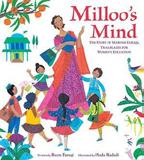
A stirring tale of grit and perseverance. (glossary) (Picture book biography. 5 8)

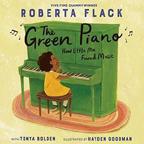
Flack, Roberta with Tonya Bolden Illus. by Hayden Goodman Anne Schwartz/Random (40 pp.) $18.99 | $21.99 PLB | Jan. 10, 2023 978-0-593-47987-2 978-0-593-47988-9 PLB
Singer Flack looks back on her childhood. The titular piano, rescued from a junkyard for the 9-yearold prodigy, serves as a memorable central image, but the mem oir the renowned singer and co-author Bolden weave around it is really about the joys of growing up in a musical family and turning musical dreams into reality through years of listening, practice, and study. Identifying her parents, siblings, and music teachers by name as she goes, Flack vivaciously recalls first her excitement as her father and mother painstakingly fixed up the “old, / ratty, beat-up, / weather-worn, / faded, / stained, / stinky”
instrument (“I couldn’t wait, couldn’t wait, couldn’t WAIT for / the paint to dry!”), then the intense feeling of “notes flowing through my fingers / to my body, / to my soul,” on the way to a life in music: “Grown-up me lived this dream! Year after year after year!” Goodman follows along in equally lyrical measures, giving the brown-skinned narrator the same rhapsodic smile as she goes from a vision of playing hymns on a rickety-looking church piano at “age three, maybe four” to accompanying her self on a huge concert grand as an adult star. In a closing note, with photos, she offers further nods to people who helped her as she fills in the details of her stellar career. Family members and other figures in the pictures are African American. (This book was reviewed digitally.)
A moving testimonial to the effects of instilling a love of live music in childhood. (timeline) (Picture book biography. 6 8)

Fontenaille, Élise
Illus. by Violeta Lópiz Trans. by Karin Snelson & Emilie Robert Wong Enchanted Lion Books (36 pp.) $18.95 | Jan. 24, 2023 978-1-59270-382-1
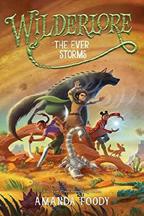
A French child expresses love for a Spanish grandfather in this French import.
A dark-haired, pale-skinned 6-year-old adores spending time with their grandfather, whom they call Luis. The sensi tively written text reveals Luis’ struggles without presenting him as lesser. The young narrator loves how Luis mixes up idioms, the source of the book’s title. Because Luis fled Spain as a child during “a terrible war” and had to work to support himself in France, he never went to school or learned to read and write. Although early on the narrator informs us, “I’m learn ing to read and write,” this does not turn into a story centered on Luis’ illiteracy. Instead, the grandchild lovingly details their grandfather’s appreciation for birds, cats, and the natural world as well as his many skills, like gardening, cooking, playing guitar, and painting. “Dad says Luis is as good as Henri Rousseau,” the text reads, which provides insight into the artistic inspiration behind Lópiz’s lush, naïve style and flat aesthetic. By book’s end, the narrator can read well, and Luis celebrates this accomplish ment with a gift that reinforces their special bond and brings this stunning and tender tale to a satisfying conclusion. (This book was reviewed digitally.)
Warmhearted and affirming—one to pick up. (Picture book. 4 8)
Foody, Amanda McElderry (368 pp.)
$17.99 | Jan. 31, 2023 978-1-66591-075-0
Series: Wilderlore, 3
Barclay and his friends head into the Desert for their next adventure.
Barclay, Viola, and Tadg saved the Sea (and the world) in the last installment of Foody’s series, but stakes are still high. The villain of The Weeping Tide (2022), Audrian Keyes, was never captured and could still be out there. Not to mention that the trio must take an intimidating set of courses called the Sympo sium before they can become actual Lore Keepers—those who wield Lore magic and tame the world’s creatures as companions. So the three friends and Runa Rasgar, their mentor, travel to the University of Al Faradh to embark on the next step in their magical education. During the Symposium, the students also participate in the Tourney, an unofficial annual prank competi tion that pits the different apprentice tracks against each other. Now 13, Barclay must juggle peer expectations, academic pres sure, and physical danger as unnatural sandstorms threaten the Desert’s capital city of Menneset. Readers who’ve been along for the journey can expect to enjoy the same level of solid sto rytelling and racial diversity as before. An especially sweet ele ment here is the depiction of Viola’s harmonious blended family, as readers meet her parents, stepfather, and half sister.
Another strong and enjoyable entry that further expands the earlier worldbuilding. (map, bestiary) (Fantasy. 8 12)

Illus. by Caryn Davidson
& Low Books (40 pp.)
paper | Oct. 18, 2022
A young people’s primer on the Black Lives Matter movement.
After defining principle in the introduction, this book explains the movement’s 13 principles, offering a brief explana tion for each along with several questions to help readers con sider the implications. While some famous activists appear in the illustrations, so do many “everyday people.” Davidson includes visual motifs throughout of beautiful shapes with embedded sil houettes of Black and brown faces; hearts and Black Power fists appear, too. On each verso, Garcia discusses a principle and ends with biographical notes on people who are illustrated on the recto, most of whom gaze out at readers. The text’s density and frequent inclusion of specific terms may limit children’s ability to use the book independently, though the “Afterword for Adults” encourages caregivers to have potentially difficult conversations
with young people. While children also appear on the cover and occasionally in the images, the book doesn’t highlight children who have made or are making change. Still, this is an important book that will help adults and young people alike understand and appreciate the Black Lives Matter movement.
A timely, informative, and inspiring read. (Nonfiction. 8 12)

Garland, Michael Holiday House (48 pp.) $18.99 | Jan. 3, 2023 978-0-8234-5102-9
Twenty wild creatures strut distinctive horns, tongues, feet, scales, and other prominent features.
From the hummingbird hawk-moth to the blue-footed booby, the aptly named blobfish to the narwhal and the babi rusa, land and sea creatures from various parts of the world pose with strong, boldly textured presence in natural settings in Garland’s digitally colored woodcuts—mostly as single sub jects, many chasing or chowing down on favored prey, and two (a male frigatebird and the aforementioned booby) posturing before prospective mates. But if the pictures reward attention, the accompanying commentary generally just singles out one physical feature for each and offers, at best, sketchy explana tions of its function. “My large nose keeps out dust and helps me breathe,” says the saiga antelope. (Don’t most noses do that?) “I have large tusks, but I don’t use them for fighting,” says a babirusa, leaving readers in the dark about what they are used for. Similarly unenlightening are opaque follow-up notes, which mention that the Sunda flying lemur “is a cobego and not a lemur” and that jellyfish “are not fish; they are Scyphozoa,” plus a mistaken implication that only male narwhals have tusks. (This book was reviewed digitally.)
The art is something to see, but the perfunctory text reads like an afterthought. (glossary, bibliography, index) (Informa tional picture book. 6 8)
Gianfrancesco, Raymond Illus. by Thamires Paredes
Inhabit Media (36 pp.) $11.95 paper | Nov. 1, 2022 978-1-77227-428-8
A spin on “The Three Little Pigs” with an Inuit setting in the Nunavut ter ritory of Canada.
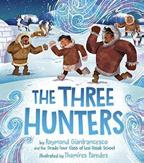
This story was written by the Grade Four students of Leo Ussak School in Kangiqliniq, Nunavut, and their teacher Gianfrancesco. After completing a social studies unit on Inuit traditions and reading a variety of fairy tales, the class wrote their own version. The result is the story of three brothers sent out
to find food for their community. The youngest brother, Ajagaq, pitches a tent made of caribou skins and prepares to wait out the fierce blowing blizzard, but the wind blows the tent down. Ajagaq is rescued by the middle brother, Tiriaq, and they find shelter by hollowing out a pocket in the side of a snow drift, but the wind rips through this shelter as well. Finally rescued by their eldest brother, Akkiutaq, they find shelter in his carefully built iglu. Despite the efforts of the wind, this is one shelter it cannot blow down. The story is charming and engaging, with a fresh and authentic feeling, due in large part to the use of Inuktut words sprinkled throughout. Paredes makes liberal use of blues and white that make the cold very real, and swirling lines give move ment to the menacing wind. (This book was reviewed digitally.)
An inspired retelling of a beloved tale. (glossary of Inuktut words, a note on the authors) (Picture book. 5 8)
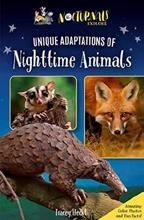
Hecht, Tracey & Emma Carlson Berne
Illus. by Kate Liebman
Fabled Films (128 pp.)
$14.99 | $8.99 paper | Nov. 29, 2022 978-1-944020-73-6 978-1-944020-72-9 paper
Series: The Nocturnals
A fictive squad of nighttime animals shines lights on some of their real cousins.
An ensemble developed by Hecht for a series of novels and easy readers intrudes into the photos as naïvely painted figures and pops up between chapters to comment, but Berne does the informational heavy lifting. Here she profiles a select band of nocturnal creatures, from greater horseshoe bats and red foxes to bandicoots and mangrove pit vipers. Many of the animals are native to Australia or subtropical Asia and may be less familiar or even new to young readers in more northerly climes—the powerful owl, for instance, or the small, fungi-eating marsupial woylie—and the photos (by various contributors credited in the backmatter) likewise offer rare views of seven species of pango lins, five kinds of jerboas, and, following a chapter on the sugar glider, glimpses of other gliders, including the parachute frog and the paradise tree snake. Though the language is informal and every short chapter includes mention, usually with photos, of animal babies (aww), the co-author does introduce chewy vocabulary (crepuscular, cathemeral), explains the mechanisms of echolocation and how foxes use Earth’s magnetic field to zero in on prey, and tucks further detail into a listing of further infor mation on each animal, such as diet and habitat. She even adds savvy general research guidelines to the expansive backmatter.
Broader in scope than the title suggests and likely to keep young naturalists reading well past sunset. (glossary, index)
“An inspired retelling of a beloved tale.”
Howell Baptiste, Kirby & Larry C. Fields III Illus. by Paul Davey Nancy Paulsen Books (32 pp.)
$18.99 | Nov. 15, 2022
978-0-593-40626-7
A Black boy’s love of all things aquatic leads to an interest in marine biology and the dream of one day helping the underwater world he finds so fascinating.
The boy’s passion for all things water is clear, as the book opens with him studying aquatic life in an aquarium. His love of water gradually morphs from splashing in small kiddie pools to learning to swim and eventually to jumping off the diving board. A Black father figure encourages his exploration of the sea, guiding him as he snorkels and kayaks. The boy’s concern for life under the sea grows as he learns more about the pollution affecting the marine creatures and cleans up litter on beaches. All the while, the unseen narrator encourages the boy and urges him to avoid toxic masculinity (“ ‘Toughen up, you may hear, or ‘Act like a man’… // But there’s no rush to grow up”). He gains much-needed perspective and courage by looking to other trail blazing Black marine biologists. The illustrations and palette fit the overall theme of this rousing book. Soft shades of blue, light teal, and pale green effectively convey the overall feeling of being immersed in the landscape of the sea. The encourag ing nature of the rhyming text pairs well with the illustrations. (This book was reviewed digitally.)
An uplifting book about the wonder and joy Black boys can find while pursuing their passions. (Picture book. 5 8)

Howell Baptiste, Kirby Illus. by Paul Davey Nancy Paulsen Books (32 pp.) $18.99 | Nov. 15, 2022 978-0-593-40623-6
A Black girl draws on the wisdom of her family to create a road map to her own destiny.
The illustrations of this book in verse follow the girl as she attempts to create a science project for an upcoming fair. As the girl goes through the many phases of creation, beginning with a drawing of her invention and ending with an actual prototype (a wheeled robotic vehicle with arms), an unseen narrator shep herds her through the process, reminding her of her greatness (“You have sparks in your brain and fire in your heart. / You can decide where to stop and where to start”) and urging her not to listen to the harmful words of others (“ ‘Boo!’ they may say / but don’t let the naysayers get in the way”). The girl feels frustrated as she encounters roadblocks, but supportive Black women in her family reassure her; one moving scene depicts the girl and
an adult in a museum looking at images of Black women such as Audre Lorde and Toni Morrison. This inspirational story misses the mark somewhat with its rhyming structure, as the word choices feel clunky in places. However, the painterly illus trations make up for it, with full-page spreads juxtaposed with vignettes. There is a dreamlike quality to the art, with the main character being a clearly defined focal point and the secondary characters fading into the background on some pages. (This book was reviewed digitally.)
A stirring story about a Black girl learning to celebrate her own uniqueness. (Picture book. 5 8)

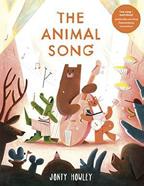
Howley, Jonty
Random House Studio (40 pp.)
$18.99 | $21.99 PLB | Jan. 10, 2023
978-0-593-38146-5
978-0-593-38147-2 PLB
An unlikely band makes music in woods and town.
Blocky graphic illustrations intro duce a crocodile, a bear, and a weasel as an enthusiastic musical trio. Color-coded text signals “Snap” in green for the croc’s snare drum, “Poom-poom” in brown to accompany the bear’s bass, and an orange “Jingle-jangle” for the weasel’s banjo—together, “Snap-poom-jingle jangle” makes for a fun, onomatopoeic refrain to their upbeat, earnest ani mal song. The cheerful, anthropomorphic crew won’t quit for winter, but the rest of the forest is winding down (“Shh, now, please, we want to go to bed!”), and as they pop in on a squirrel, a badger, a bat, and others, they find themselves cast out of the woods and into town with their show, at the suggestion of a rat. The band’s positivity and determination are welcomed by the animals who live in town, but after a season of daily playing on a street corner, the crocodile, the bear, and the weasel finally tire themselves. As spring arrives, they decide to return to the woods. There’s no big message here, but the dedication of the animals may be quietly inspiring to some. For others, there’s a subtle lesson about moderation as the trio settle in for a spring hibernation when their friends start emerging from winter naps. An appended musical score and lyrics make this ripe for the truly musical, with plenty of extension opportunities for inter ested educators. (This book was reviewed digitally.)
A happy, harmonious collection of words and images. (Pic ture book. 3 6)
“A happy, harmonious collection of words and images.”
Jules, Jacqueline
Illus. by Hector Borlasca
Apples & Honey Press (32 pp.)
$17.95 | Sept. 6, 2022 978-1-68115-591-3
A mischievous goblin plays havoc with preparations for Shabbat in this playful take on Jewish folklore.

Rose and Benny, Jewish siblings who are light-skinned with dark hair, are braiding challah for Shab bat dinner, trying to be quiet so Mama can rest after a hard day at work in the village. They are interrupted by loud rumbling noises. They check outside to see their yard a mess and strange tracks all around. Both children attribute the damage to a gob lin, for everyone in the village knows of these invisible creatures with roosterlike tracks. They nervously continue working on the challah. Suddenly Rose’s kerchief is yanked off her head and flies across the room and up the chimney. Then their Shabbat candlesticks and kiddush cup go flying and crashing to the floor. Rose comes up with an ingenious plan, and the siblings work together to capture the goblin. Focusing on Jewish folklore— something not seen as commonly in kid lit—this tale centers on a loving, kind, and resourceful sibling pair. They are never in any real danger, as Jules keeps the tale light and lively, providing sound effects in uppercase letters to enliven the action. Borlas ca’s bright cartoons set the scenes in an old-style kitchen with no modern appliances in sight and with the Shabbat accouter ments prominently displayed. The children are expressive, and the action is depicted with humor and charm. (This book was reviewed digitally.)
Joyful and entertaining, with a glimpse into a different aspect of Judaism. (author’s note) (Picture book. 4 8)
Kaner, Etta Illus. by Brittany Lane Owlkids Books (32 pp.)
$18.95 | Sept. 13, 2022 978-1-77147-444-3
Appearances can deceive.
This natural world guessing game invites readers to cat egorize specimens (as a rock, animal, or plant) shown out of context on a blank background. The clever use of page turns makes the point that “things aren’t always what they seem at first glance.” After defining rocks, plants, and animals, Kaner introduces the question-and-answer process. What looks like a pink, spiky, flowering plant is revealed on the following page to be a purple sea urchin, shown in its ocean home. A short paragraph discusses the animal, plant, or rock formation, some times explaining where it might be found. Kaner, experienced in introducing science topics to young readers, has chosen 14
interesting examples and anticipates some likely questions. From the reef stonefish to the Satanic leaf-tailed gecko to the desert rose, the plants and animals come from all over the world. Lane, a former wildlife biologist, adds information with her accurate renditions, done in a soft pastel palette. The title would also work as a read-aloud for a small group. The text con cludes with a reminder that the lesson not to judge things by appearances applies to people as well and provides a page of rel evant words to know. This book will appeal to the young audi ence who might have enjoyed Tana Hoban’s long-out-of-print Animal, Vegetable, or Mineral (1995) but offers considerably more information. (This book was reviewed digitally.)
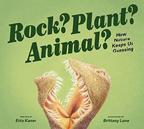
An enjoyable nature puzzle with welcome substance. (Infor mational picture book. 4 8)
Kay, Edward Illus. by Mike Shiell Kids Can (48 pp.) $18.99 | Sept. 6, 2022 978-1-5253-0413-2
Series: Gross Science
Get ready to learn the scoop on poop. (And urine, too!)

Scatological-minded readers—and really, who isn’t?—will be thrilled to get their hands on this smattering of wastebased trivia. Each page is dedicated to a new topic sure to hit that special place where humor, disgust, and a love of unusual facts intersect. For example, did you know that urine has been used as a whitening agent for centuries? From laundry in medieval times to teeth cleaning in ancient Rome, pee has been No. 1 when it comes to making whites whiter. Or perhaps readers will be interested to learn that rabbits consume their feces to take advantage of the missed nutrients the first time around and that panda babies eat their parents’ droppings to better develop healthy gut bacteria—two facts caregivers can throw back at readers if they complain about leftovers! Each page also includes a disgustingly funny full-color illustration or two. A brief list of further reading offers more sources to mine for information, and a glossary (sans pronunciation guide) is there to help forgetful readers with a smattering of terms, from ammonia to vitamins. Some caregivers may turn up their noses at the subject, but consider this: If a young reader is going to be obsessed with poop humor, they might as well learn something.
Fun, enlightening, and gross in all the best ways. (index) (Nonfiction. 8 10)
Kerbel, Deborah
Illus. by Miki Sato
Pajama Press (24 pp.)
$17.05 | May 17, 2022
978-1-77278-246-2
Series: Weather Days, 4
Rain, rain, don’t go away!
Anyone seeking a refreshing spin on rainy-day books will find it here. This delightful picture book is awash in treats for readers’/listeners’ ears and eyes, with bouncy, lively, rhythmic verses that make clever use of assonance and consonance, fea turing, as examples of the latter, many apt, satisfying S sounds, so readers/listeners can “hear” soft, shushing sounds of raindrops pattering on various surfaces. The artwork suits the book’s mes sage, with pages splashed with lovely, lively, textured illustra tions created with paper collage, textiles, and embroidery silk. In addition, this charmer will help develop vocabulary, as rain is described in different ways, e.g., drizzling, freezing, drumming, misty, and sprinkling. The book also points out how rain affects nature—by forming puddles, mud, and streams; arousing snails and worms; watering trees and flowers; and “paint[ing] a work of art” in the sky. Grown-ups sharing this book with children will do well to encourage them to suggest other descriptive terms for rain and the natural changes it can bring about. Rainy days are shown in a variety of settings; characters, all of them children decked out in brightly hued raingear and actively engaging in numerous rainy-day activities (save for the few por trayed indoors), are racially diverse. Endpapers feature assorted vibrantly colored umbrellas. The last page includes several rainand water-themed experiments and activities. (This book was reviewed digitally.)
Rainy days bring all sorts of pleasures; reading this book is just one of them. (Picture book. 3 6)

THE SUPERTEACHER PROJECT Korman, Gordon Balzer + Bray/HarperCollins (304 pp.) $17.99 | Jan. 10, 2023 978-0-06-303279-8

What does it mean to be human?
Mr. Aidact is the new teacher at Brightling Middle School. He immedi ately makes a strong impression when, despite having his back turned, he reaches out and catches a spitball the moment before it hits his head. This does not endear him to spitball-thrower Oliver Zahn, Brightling’s self-described fore most rule breaker and the first narrator in this tale told through multiple perspectives. Gifted student and field hockey player Rosalie Arnette, like many kids her age, is just trying to figure out how to negotiate the hallways and the middle school social structure. Nathan Popova, Oliver’s best friend, enjoys a good prank but doesn’t want to get in trouble, which is hard when
your buddy actively goes looking for it. Steinke Newhouse— who really hates being called Stinky—feels his greatest talent is arguing, which regularly lands him in detention. Although Mr. Aidact seems to be very literal and to lack a sense of humor, he sees and gets each student, meeting them where they’re at. Is he too good to be true? Oliver and Nathan know something’s up—but the answer, which brings in AI and government experi ments—surprises even them. Each viewpoint is distinct, and most characters are multifaceted. Most characters default to White.
A school story with a twist, told with humor, insight, and empathy. (Fiction. 8 12)
Lacika, Jenny Illus. by Teresa Martínez
Trans. by Carlos E. Calvo Charlesbridge (32 pp.)
$15.99 | Oct. 18, 2022 978-1-62354-221-4
A young Latine boy builds a wall out of a shoe box and other items to protect his toys from his toddler sister.
Two “No Pasar” signs hang outside both entrances into the living room. In the center, Rafael pins a sheet around his toys to shield them. But it doesn’t stop his sister, Essie, who comes barreling in with a mighty “¡CRASH!” An idea strikes Rafael to build a wall “wide enough and tall enough to keep Essie out.” Picking a favorable spot in his bedroom, Rafael initiates his new plan while Essie takes a siesta. He collects a packing box, a shoe box, a puzzle box, a cooler, and more to construct his Essie-proof wall. His goal: to fit, flip, and turn each item into a makeshift barrier. Easy in theory, tough in practice. As Essie stirs and fusses out of her nap, Rafael tries to puzzle out each shape into a wall before time runs out. With a dash of humor, Lacika’s Spanish and English text—translated by Calvo—serves a low-key urgent scenario familiar to older siblings. An eclec tic mix of short, punchy lines and longer, descriptive sentences chugs along at a smooth pace. Full of clean, solid linework, Mar tínez’s bright, colorful illustrations feature big, legible shapes distinct from one another on the page. Visual cues (including a joyful little cat) provide a sense of scale during Rafael’s wall construction. (This book was reviewed digitally.)
A playful tale to encourage spatial awareness and creativity. (author’s note, glossary, activities) (Math picture book. 3 6)


Lakritz, Deborah
Illus. by Julia Castaño
Apples & Honey Press (32 pp.)
$17.95 | Dec. 6, 2022
978-1-68115-610-1
An impassioned musician shared her talents globally.
Jewish singer/songwriter Debbie Friedman (1951-2011) loved music and her faith. When she was a child, her family moved from upstate New York to St. Paul, Minnesota, where she felt adrift before enrolling in Hebrew school. Deeply religious, she found solace in prayers and rituals. Later, working at a Jewish summer camp, she found comfort in music and grew to love the popular folksongs of the 1960s. Yearning to play guitar, Fried man worked hard to earn money to buy her own instrument.
As a skilled guitarist, she led singalongs at Jewish youth group meetings and synagogues around the United States. Friedman wished to emphasize Jewish music at her concerts to help Jews connect, spiritually and musically. She began to compose songs, setting English translations of Hebrew prayers to her original tunes. Shortly after writing her first song, she introduced it to a youth group, and the teens wholly embraced it. Eventually, the author avers, Friedman’s religious songs brought Jews of all ages and levels of spirituality together. Friedman’s story should be more widely known. However, this book, written in present tense, is superficial, though her passion comes across. The illus trations are colorful but otherwise undistinguished and static. There is no glossary or pronunciation guide, which would have helped with some Yiddish and Hebrew words. This volume will be best appreciated in Jewish-school and synagogue-library col lections. Friedman and her family present White; background characters are diverse in terms of age and race. (This book was reviewed digitally.)
A niche offering. (author’s note) (Picture book biography. 6 9)

LaNier, Carlotta Walls with Lisa Frazier Page Delacorte (288 pp.) $17.99 | $20.99 PLB | Jan. 17, 2023 978-0-593-48675-7 978-0-593-48676-4 PLB
The youngest member of the Little Rock Nine faces ghosts from her past to share her story of school integration.
Carlotta Walls grew up in Arkansas in a loving, supportive Black community. In 1957, as a ninth grader at Dunbar Junior
High, she added her name to a roster of students willing to inte grate Little Rock Central High, which was noted for its excel lent education and facilities. However, she and other volunteers faced countless obstacles: The White school superintendent held a meeting with the Black students to let them know that they could not participate in extracurriculars or school social events. The governor sent the Arkansas National Guard to block their entrance. Even after being escorted to school by military troops sent in by President Dwight D. Eisenhower, the teens were physically assaulted and verbally harassed by class mates. Segregationists in Little Rock targeted the livelihoods of the Black students’ parents, and Carlotta’s home was bombed. Despite all these obstacles, she graduated, went to college, and became a realtor, Colorado AIDS Project board member, and president of the Little Rock Nine Foundation, which has a college scholarship program. This highly personal story brings the time period to life, giving readers an inside view of what it meant to be a nonviolent participant in integration and explor ing how laws have been used to heal or harm citizens. The clear voice shares intimate stories that are clearly contextualized within larger societal events.
A compelling and necessary account of facing and surviv ing injustice. (Nonfiction. 10 16)
Leitch, Lynn Illus. by Scot Ritchie Pajama Press (24 pp.) $17.95 | Sept. 13, 2022 978-1-77278-269-1
Buckle up, young dino!
Eight species of dinosaurs from across geologic periods are featured, each paired with a type of motor vehicle. The nearly all-white backgrounds keep children’s full attention on the dinosaur and vehicle introduced on each double-page spread. Iguanodon drives an electric vehicle, while Triceratops and their friends prefer motorcycles. Tyrannosaurus Rex drives a monster truck, while Carnotaurus makes a living driving a limousine. Diplodocus drives a bus, while Brachiosaurus dreams of driving a Jeep—but only when she’s old enough to do so. The concept of the book is interesting and gets a big lift from four appended suggestions for caregivers on engaging readers and honing their critical-thinking skills. The text is spare; a phonetic pronun ciation guide to some of the more unusual dino names would have been appreciated. (We’re looking at you, Compsognathus!) This is a minor quibble, however, and the watercolorlike illus trations do a lot of heavy lifting to promote the humor of each new page—children will gleefully note that most of the huge creatures are themselves crammed into relatively tiny vehicles. Young readers who sit firmly in the Venn diagram overlap of dinosaur lovers and car enthusiasts will be thrilled, and with the right guidance, those outside of that overlap will be interested as well. (This book was reviewed digitally.)
Amusing fun from the “Car”-taceous era! (Picture book. 4 6)

Leung, Flo
Owlkids Books (32 pp.)
$18.95 | Oct. 18, 2022
978-1-77147-462-7
The story of a treasured holiday item.
In anticipation, a child with one Chinese parent and one par ent who presents as White looks out of their apartment window on a snowy urban landscape. The young narrator announces that their family is having “a New Year party” as they excitedly greet their grandmother at the door. Grandma tells the child that they are “celebrating the new moon that begins each brand-new year,” so they must prepare a feast including “the lucky sweets” in their special “Tray of Togetherness,” a decorated, sectioned item brimming with treats that symbolize various good wishes. Bold colors and subtle textures make for a bustling Chinese mar ket where the child and their family pick up ingredients. Along the way, the narrator explains that “tangerines mean gold,” and you eat “pistachios for happiness.” Appealing dishes of other confectionaries, like candied kumquats, candied winter melon, and watermelon seeds, stretch along the page accompanied by their meanings. The spare, upbeat narrative explains that each special food is a wish that you share with others as the child hands a passing peer a treat. As the protagonist’s extended fam ily and neighbors of ethnically diverse backgrounds arrive and settle in for a large feast, the child once again looks over the tray. Further explanation of the Chinese or, more specifically, Can tonese tradition of the Tray of Togetherness follows. (This book was reviewed digitally.)
A delectably delightful celebration. (author’s note) (Picture book. 4 7)

Lewis Jones, Huw Illus. by Ben Sanders Happy Yak (32 pp.) $18.99 | Sept. 6, 2022 978-0-7112-6757-2
Series: Blue Badger, 2
Two busy friends eventually make time for each other. Badger has so many berries to eat that there’s no time to play with friends. That’s convenient, since Badger’s friend Dog is too busy to play. But when Owl explains that Dog can’t play because he is searching for his lost ball, Badger has an existen tial crisis. Could Badger have seen the ball—and even eaten it by accident? (The ball was blue, like the berries.) What should Bad ger do? Owl answers with a string of unhelpful platitudes (“The storm will pass. The early bird catches the worm. We all make mistakes”) that could be the basis for follow-up storytime dis cussion. Badger is quick to accept possible responsibility for the lost ball, apologize to Dog, and offer an alternative plan. Friends don’t need a ball to play when they are together and there are plenty of berries to toss! And Dog is philosophical. Maybe his
ball will turn up someday. Readers with a sharp eye will know where the lost ball is before the final reveal. This second install ment in Lewis Jones and Sanders’ Blue Badger series features textured black-and-white depictions of animals set against col ored backgrounds with minimal details. Blue highlights in the illustrations take over the pages as the narrative progresses. Brimming with visual humor, this simple story quietly models compassion and accountability for one’s actions. (This book was reviewed digitally.)
A clever and attractive tale laced with a solid message on how to be a good friend. (Picture book. 4 6)

The Bashful Cloud
Maclear, Kyo Illus. by Nathalie Dion
Tundra Books (64 pp.)
$18.99 | Sept. 13, 2022 978-0-7352-6728-2
What do you see in the clouds…a new friend, perhaps?
Kumo, a cloud who likes to hide high up in the sky, floats about where no one can see her. One day, she is given a big job—to care for those on land by keeping them cool and shaded and offering rain. Anxious and self-conscious about being seen, Kumo sets out, eyes shut…and gets tangled up in a tree. With the help of a friendly kite and the wind, Kumo tries again and discovers some interesting sights—tall city build ings, a warm lake, rolling fields, and more. At a lively street party, she finds a kindred spirit—a young boy gazing up at the clouds, standing a bit apart, and daydreaming. Using spare, evocative prose, Maclear depicts Kumo’s journey to become braver and make cloud friends, discovering her place in the sky and gain ing confidence along the way. Dion’s illustrations offer a gentle, pastel-tinged land- and skyscape; Kumo’s soft form makes her approachable and relatable, especially for young readers who may themselves feel anxious about finding their place and mak ing friends. They may even be inspired to gaze up into the sky in search of Kumo, perhaps before a repeat reading. Humans depicted are racially diverse; the boy presents as Asian. (This book was reviewed digitally.)
A quiet, satisfying tale about being brave enough to take that first step. (Picture book. 3 6)

“A quiet, satisfying tale about being brave enough to take that first step.” kumo
Majewski, Marc Katherine Tegen/HarperCollins (48 pp.)
$18.99 | Nov. 1, 2022 978-0-06-302155-6
Sometimes parents need to be the wind beneath our wings.
This story opens with a young, tanskinned protagonist with short brown hair making a pair of large butterfly wings (and a pair of antennae) so that they can pretend to fly. Leaving home, the protagonist wanders a verdant landscape, twirling and frolicing. Playtime is cut short, however, when a group of children tease the protagonist and try to pull off the wings. Frustrated, the child heads home to fume in bed. They are cheered up by their father, and the two repair and recreate the butterfly costume so that the child might fly again. Showing the bullies that they don’t care about their opinions, the butterfly child dances free, finding a friend along the way. The story uses spare language and lush illustrations to capture the joys (and societal pressures) that result from beating one’s own drum. The details of the acrylic illustrations may muddy in large group storytimes, but small groups and individual read ers will find a strong message in the book’s pages. The bullies are male-presenting, and the only child to offer acceptance is female-presenting, but the father’s reaffirming role takes some of the sting out of the stereotypical gender roles presented. The book may tread familiar ground, but it does it so stylishly that many readers will be overjoyed. Characters are racially diverse; the child who befriends the protagonist is brown-skinned. (This book was reviewed digitally.)
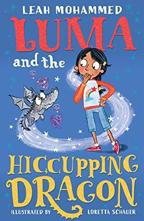


This flies high. (Picture book. 8 10)
Marshall, Kate Alice Viking (272 pp.)
$17.99 | Nov. 1, 2022 978-0-593-52642-2
Series: The Secrets of Eden Eld, 3
A sinister showdown looms in this trilogy finale.
While Eleanor, Pip, and Otto may have escaped the People Who Look Away twice, the trio isn’t out of the woods yet. A jarring visit from Wander (“the girl with backward hands”) cues that the Wending (“the roads between worlds”) is open. Another villainous sibling is on her way. Strange pathways start appearing—and other wrong things too—as the trio is tricked into the latest trap. To make matters worse, the Prime Stories are slowly rewriting the young people’s identities, turn ing them into stock characters. New powers allow Eleanor (now the world-walker) to accidentally transport everyone to the Pallid Kingdom of the People Who Look Away’s childhoods. Can Eleanor and friends really stop them, or will the Pallid
Kingdom’s door stay open for good? Marshall’s latest is a testa ment to the consumptive power of stories (in this case, literally). The complex worldbuilding surpasses the more mood-driven formula of its predecessors, ultimately posing more questions than it answers. Yet this entry feels deliciously on-brand, teas ing out themes of storytelling and fate versus inherent goodness. The overall result expands the story without tying everything up too neatly. Otto has brown skin and tight curls; all other major characters are pale-skinned. A subplot explores Eleanor’s questioning of her sexuality.
A fine finish that’s unexpectedly deep and hauntingly magi cal. (Suspense. 9 12)
Mohammed, Leah Illus. by Loretta Schauer
Welbeck Flame (160 pp.)
$7.95 paper | Aug. 9, 2022
978-1-80130-028-5
Series: Luma and the Pet Dragon, 2
A girl and her pet dragon cope with changes.
Timir is no ordinary dragon—not that any dragons are ordinary. He talks when he’s with his per son, Luma, a British Pakistani girl, but when anyone else is around, he turns into a dog. The only other person who knows Timir’s secret is Luma’s Nani (grandmother). In “The Hiccup ping Dragon,” the first story in this book, Timir finds him self with the hiccups. Nani tells Luma and Timir that means that Timir’s flame is on its way—in other words, he’ll be able to breathe fire. Timir doesn’t like fire, but Nani says that the charm bracelet she gave Luma contains a locket to render the flame harmless—if only Luma can figure out how to open it. In the second story of the book, “The Prickly Tickle,” Luma and Timir prepare for a dog show, but it ends up coinciding with the dragon finally learning to fly. And, of course, he does not like fly ing—it makes him feel “prickly” and “tickly.” Meanwhile Luma is worried about Timir spreading his wings too far and never returning to her. Accompanied by adorable black-and-white illustrations, this second installment in the series is a sweet tale that makes for easy, breezy reading, with a relatable focus on friendship and fears coupled with themes of magic.
A charming tale of friendship, family, and the ups and downs of dragon ownership. (Fiction. 6 9)

Murphy, Frank & Charnaie Gordon
Illus. by Kayla Harren
Sleeping Bear Press (32 pp.)
$17.99 | Aug. 15, 2022 978-1-5341-1153-0
Who besides us will care for the planet that supports us?
The team that produced A Friend Like You (2021) returns to take on a much broader topic: caring for our unique world. “We don’t always take care of our planet,” the authors say. A devastating image of a razed forest proves their point. But what follows is an engaging appreciation of the land, water, animals, trees, air, and people who share our world, showing why we should and how, in some ways, we can. With its emphasis on the importance of these resources, this is a highly appropriate tool to open conversations about the environment. Harren’s appealing illustrations support and add context. From the purple-tinged opening spread, showing the vastness of the night sky as admired from a scenic parkland, to the concluding image of the same scene in sunlight, four lively children, diverse and distinct, engage with the world around them. In vignettes and full-bleed images, their activities demonstrate their enjoy ment of their environment as well as how they care for it. Occa sionally, other characters join them, including a brown-skinned elder who uses a walker and a tan-skinned youngster who uses a wheelchair and has a service dog. The details in each spread can inspire conversations on many levels. A page of activity sugges tions, including a hands-on experiment, completes this pleasing package. (This book was reviewed digitally.)
This conservation message is gently and effectively con veyed. (note from the author and illustrator) (Informational pic ture book. 4 7)
THUNDERBIRD Book Two Nimr, Sonia Trans. by M. Lynx Qualey Center for Middle Eastern Studies (152 pp.)
$16.00 paper | Dec. 8, 2022 978-1-4773-2693-0
The middle volume in this trilogy translated from Arabic follows orphaned Noor as she travels through time on another world-saving quest to collect phoenix feathers.

This time, Noor lands, disoriented, in 1177 Jerusalem. Met with suspicion as a stranger, she must prove her trustworthi ness: Will anyone believe she’s not a spy but a 21st-century Pal estinian girl able to control fire, with a talking cat friend who is really a djinn named Sabeeka? As before, Noor is helped by a girl who could be her identical twin. It emerges that Noor, new res cuer Zainab, and earlier doppelgänger Andaleeb each possess magical traits matching those of the phoenix. Hiding out in a
cave with an Arab community fighting back against the Cru saders, Noor remains focused on acquiring the next phoenix feather. But when everyone learns of nefarious plans to burn the contents of the library of the al-Aqsa Mosque the following day, she and Sabeeka join the rescue effort. Knowing the dangers of revealing information about the future, no matter how buoying, Noor does not give anything away; still, readers will not miss the reassuring theme of maintaining hope during times of duress. The book portrays people who have sustained many losses, indi vidually and as a group, and who sometimes disagree but remain united in their resistance. Earthy humor and moments of won der balance the suffering. Readers need not be familiar with historical figures such as Conrad and Saladin; history is woven seamlessly and accessibly into the novel.
Fast-paced, magical, and inventive. (Fantasy. 11 14)
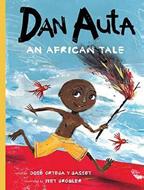
Ortega y Gasset, José Illus. by Piet Grobler Trans. by Elisa Amado Greystone Kids (56 pp.) $18.95 | Oct. 4, 2022 978-1-77164-771-7
A sister has her hands full taking care of her mischievous brother.
This retelling of a traditional Hausa fable published in 1912 by German anthropologist Leo Frobenius, translated into Span ish by Ortega y Gasset in 1925, and now translated into English by Amado, begins with a mother and father who create a life in the forest. They have a little girl named Sarra. When Sarra gets bigger, her parents have her younger brother, Dan Auta. Soon afterward, both parents become ill and perish, but before they die, they make Sarra promise never to let Dan Auta cry and to stay with him always. Despite such a heavy burden, Sarra believes the pair will be OK because of the vast food stores her parents left them—but while she is out collecting firewood, Dan Auta wreaks havoc by destroying all of their food. Forced to venture into the forest beyond their land, Sarra and Dan Auta journey to a nearby city. Not long after, Dan Auta’s curi ous nature lands them both in trouble, forcing the siblings to run. They hitch a ride on a giant hawk, but Dan Auta gets them thrown off; eventually, they ride a whirlwind to a new kingdom, where Dan Auta’s mischievous behavior may pay off. Simple, childlike illustrations bring this old tale to life as Dan Auta’s antics are depicted upon each spread. The omniscient narration guides readers through this multifaceted story of freedom and responsibility before reaching its dramatic conclusion. Set in Africa, likely in what is now Niger or Nigeria, the story features an entirely Black cast.
A thought-provoking tale. (afterword) (Graphic fiction. 9 12)
Ostertag, Molly Knox
Illus. by Xanthe Bouma
HarperAlley (208 pp.)
$19.99 | Dec. 6, 2022 978-0-06-303924-7
Series: Dungeons & Dragons: Dungeon Club, 1
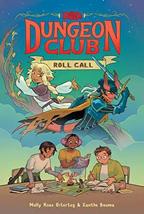
Role-playing and real life are inex tricably intertwined in this Dungeons & Dragons–themed story of middle-grade woes.
Up-and-coming eighth graders Jess, who has light brown skin, and Olivia, who presents as Black and Latine, have been inseparable since third grade. Though Jess may not be socially adept (“I’m not good at friends, but I’m good at stories”), she has a firm friend in Olivia, and the two bond over role-playing games, Olivia acting as Dungeon Master while Jess engages in quests as the hero Sir Corius. Then Olivia suggests starting a Dungeons & Dragons club at school, an idea that changeaverse Jess becomes determined to thwart. The duo becomes a trio when another member joins the club, and Jess, feeling frustrated and vulnerable as things change even more, ends up hurting Olivia. Now Jess will have to dig deep to become a hero in real life. The back and forth between reality and the game’s quest is interspliced expertly, never confusing readers with the switches. Ostertag deftly shows how elements of the game bleed into Jess’ real life, like seeing core stats for kids at school floating about their heads. As the real and the fantastical blend into one another, readers will root for Jess even as her poor choices are hard to disregard. Bouma’s engaging art will surely lure in fans of realistic comics.
Scoring high on charisma, this tale of personal growth is bound to win many a curious young fan over to D&D’s allure. (Graphic novel. 9 12)
Pallotta, Jerry Illus. by Rob Bolster
Scholastic (160 pp.)
$10.99 | Sept. 6, 2022 978-1-338-84155-8
Series: Who Would Win?
Some of nature’s toughest animals battle one-on-one in a set of five death matches.
When animals go into battle with each other, lots of factors can determine who will win, from a creature’s tough skin to its ability to inject poison in its foe. This work collects five books that detail what might happen in to-the-death fights between a Komodo dragon and a king cobra; a tarantula and a scorpion; a whale and a giant squid; a hyena and a honey badger; and a falcon and a hawk. Before the result is played out as a what-if mini-story with photorealistic
illustrations, readers will find pages and pages of facts. For any one who likes trivia about animals, each fight contains volumes of factoids and bite-sized lessons in biology. So much so that small sections, each labeled “Fact,” are piled with “Bonus Facts,” “Fun Facts,” “Interesting Facts,” “Gross Facts,” “Yummy Facts,” and “Sharp Facts” (in relation to teeth) in addition to “Danger ous Definitions,” warnings for humans, and “Did You Know?” sections. It’s quite a lot, enough to make one exhausted from information overload before the final verdict. The fights pull no punches, with animals getting bones broken and poisoned to death. Sometimes the logic doesn’t exactly follow. After a snake kills a Komodo dragon, the next line in the text reads, “Maybe next time, the Komodo dragon will bite first.” Seems unlikely. Occasional humorous asides (“The Tarantulas would be a great name for a football team”) keep the book from being a totally dry undertaking.
An overly fact-packed science book that’s not written for the squeamish. (who has the advantage checklists) (Nonfiction. 6 9)
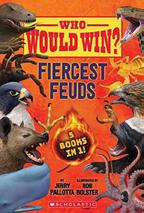
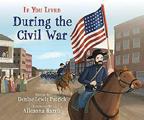
Patrick, Denise Lewis Illus. by Alleanna Harris
Scholastic (88 pp.)
$22.99 | $9.99 paper | Sept. 20, 2022 978-1-338-71280-3 978-1-338-71279-7 paper Series: If You Lived
An overview of the war’s course, cost, and immediate aftermath.
This latest in the relaunch of the If You Lived series follows the question-and-answer format of If You Lived at the Time of the Civil War (1994) by Kay Moore, illustrated by Anni Matsick, and covers similar subject matter, though with updated lan guage (enslaved people rather than slaves ) and different questions. Patrick answers questions such as “Did Abraham Lincoln own enslaved people?” and “Did women fight in the Civil War?” He didn’t, they of course did…and along with hundreds of women, Patrick notes, Native Americans of several named nations also fought, on both sides. Though she is wrong in claiming that the fate of the submarine Hunley remains unknown (the wreckage was discovered in 1995), in general her accounts of the war’s major causes, campaigns, and effects on daily life are accurate if broadly brushed, and her expanded coverage of Reconstruction adds historical context that Moore’s work lacked. With a few exceptions, Harris goes for depictions of generic, stolid-looking light- or dark-skinned soldiers and civilians rather than specific portraits. There are no source or resource lists, but a few small maps and stylized battle scenes are interspersed.
The actual visuals could be livelier, but younger readers after a mental big picture of the struggle will be well served. (glossary) (Nonfiction. 8 10)
“Scoring high on charisma, this tale of personal growth is bound to win many a curious young fan over to D&D’s allure.”
call

Paul, Chris Illus. by Courtney Lovett
Roaring Brook Press (32 pp.)
$18.99 | Jan. 10, 2023 978-1-250-81003-8
An NBA star pays tribute to the influence of his grandfather.
In the same vein as his Long Shot (2009), illustrated by Frank Morrison, this latest from Paul prioritizes values and character: “My granddad Papa Chilly had dreams that came true,” he writes, “so maybe if I listen and watch him, / mine will too.” So it is that the wide-eyed Black child in the simply drawn illustrations rises early to get to the playground hoops before anyone else, watches his elder working hard and respecting others, hears him cheering along with the rest of the family from the stands during games, and recalls in a prose afterword that his grandfa ther wasn’t one to lecture but taught by example. Paul mentions in both the text and the backmatter that Papa Chilly was the first African American to own a service station in North Caro lina (his presumed dream) but not that he was killed in a robbery, which has the effect of keeping the overall tone positive and the instructional content one-dimensional. Figures in the pictures are mostly dark-skinned. (This book was reviewed digitally.)
Blandly inspirational fare made to evoke equally shrinkwrapped responses. (Picture book. 6 8)

Perry, Caroline L. Illus. by Lydia Corry Godwin Books/Henry Holt (40 pp.) $18.99 | Jan. 3, 2023 978-1-250-83238-2
An introduction to the British royal families—human and canine.
Perry begins with the recently deceased Elizabeth II, seen here as a young girl. Elizabeth “wasn’t a storybook princess” even after her father became king, and after bonding with a corgi pup she named Susan, Elizabeth trained to be an auto mechanic in World War II. During the war, Susan guarded her charge “like a precious lamb,” and afterward, along with often finding herself “in the doghouse” for mischie vous pranks in the palace, had pups of her own named Sugar and Honey. Meanwhile, Elizabeth married, became queen, and—though Susan eventually stopped barking and was bur ied—went on to own at least 30 corgis, many of them Susan’s descendants. “Susan’s legacy lives on,” the author concludes. As evidence, she closes with two multigenerational family trees— from Victoria and Albert to Lilibet Mountbatten-Windsor (b. 2021) on one, and from Susan to Willow (d. 2018) on the other, with an utterly precious note about a hybrid line of “dorgis” cofounded by a dachshund parent. Corry supplies cleanly drawn scenes of smiling, stubby legged, solid-looking orange dogs and
slender, upright royals, both in regal poses, surrounded on pub lic occasions by racially diverse crowds of attentive onlookers. (This book was reviewed digitally.)
A sweet sidelight cast on Britain’s longest reigning mon arch and her furry, four-legged retinue. (Informational picture book. 6 9)
Philbrick, Rodman
Scholastic (208 pp.) $18.99 | Sept. 6, 2022 978-1-338-73629-8
It’s the summer of 1924 when Davy and Jo Michaud take off into a life that dreams—and nightmares—are made of.
Newly orphaned and long impover ished, narrator Davy, 12, and Jo, 17, are uncertain about what lies ahead. Their fortunes take a turn for the fantastical, however, when their mother’s estranged cousin, hotshot aviatrix Ruthie Reynard, swoops in to take the siblings under her proverbial—and lit eral—wing. Thrills abound as the children find a new family amid the daredevils and stalwarts of Ruthie’s circus. But behind the ever present danger of stunting lies a far more sinister threat, one from which the siblings and those they love might not escape. Set in Maine against the backdrop of the revival of the Ku Klux Klan in the Northeast, this vivid picture of sense less violence will hit home for today’s readers. As invectives fuel anti-immigrant sentiment, Davy realizes that he and his sister, whose father was an immigrant from Quebec, are the “foreign invaders” the Klan hates. The circus plot thread, full of heart and warmth, clashes with these themes in a way that keeps read ers firmly invested in the fates of tenderly crafted characters they will grow to love. The first-person narration reads some what awkwardly, though it’s befitting of a young not-quite-man still growing into himself and his place in the world. Characters default to White.

A timeless, timely, and poignant tale of derring-do. (infor mation you may find interesting, photograph, additional read ing) (Fiction. 8 12)
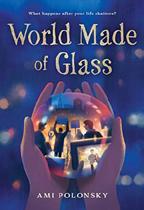
Polonsky, Ami
Little, Brown (288 pp.)
| Jan. 17, 2023
It’s the height of the AIDS panic in New York City, and Iris’ father is dying.
Last year, when Iris Cohen was in sixth grade, her parents got divorced because her dad came out. Her folks still love each other and even live in the same building. Dad’s
“A sweet sidelight cast on Britain’s longest reigning monarch and her furry, four legged retinue.”
corgi
the queen
boyfriend, J.R., is so wonderful and kind that it’s hard work to hate him (“If you lost your focus for even a minute, you started to love him”). But it’s 1987, Dad is dying of AIDS, and the panic over the so-called gay plague is at a fever pitch. Iris discovers his diagnosis is no secret when the best teacher at her mostly White private school overreacts with ludicrous terror when Iris gets a splinter and there’s a tiny drop of blood on her finger. How can you grieve when people are so scared that they won’t go near a dead man’s ashes without protective gear? Framed by lovely acrostic poems by Iris and her dad, the book shows a girl focusing her rage and pain into love through the nascent radical activism of ACT UP. An informative author’s note describes the complex relationships of early AIDS activists with Dr. Anthony Fauci and adds factual historical nuance to various elements of the story as presented. The homophobia of the 1980s and the horror of AIDS deaths are softened for the middle-grade audi ence but still clearly present.
Simultaneously sad and life affirming; a poetry-filled, inspiring call to activism. (Historical fiction. 10 14)
NUBBY Richards, Dan Illus. by Shanda McCloskey Knopf (40 pp.) $18.99 | $21.99 PLB | Jan. 3, 2023 978-0-593-38109-0 978-0-593-38110-6 PLB

A toy rabbit realizes the value of home.
Nubby is a blue stuffed rabbit with a thick black unibrow. Fed up with being “carried, buried, dropped, dragged, torn, worn, chewed on, sat on, and even used as a nose wipe,” he sets off into “the great wide world” (aka the cul-de-sac near his home) for a new beginning. Aided (or, rather, carried) by a mischievous dog, he meets some real rabbits, who ignore him. Picked up by an aspiring magician (a child with tan skin and dark hair), he tries his hand (or paw) at fame, and when that doesn’t work out, he goes looking for fortune, digging for trea sure with his canine pal. Far from home (across the street), he longs for his little boy—who has peach skin and a blond bowl cut—and the love he once had. Luckily, Nubby is able to hitch a ride home and returns to his life of being loved very hard, this time appreciating “being nuzzled, snuggled, cuddled, clutched, bathed, bundled, squeezed, smooched, and utterly adored” in between all the carrying, burying, dropping, dragging, and chewing. Illustrated with simple black lines, the watercolor, pencil, and digital artwork is attractive and laced with humor; Nubby’s trials are standard fare for a favorite toy but sweet to see nonetheless. (This book was reviewed digitally.)
A gentle acknowledgment that it’s a hard life being a hardloved stuffed animal. (Picture book. 1 5)
Illus. by Mechal Renee Roe
Harper/HarperCollins (40 pp.) $18.99 | Sept. 27, 2022 978-0-06-306478-2
In this picture book from a teen designer and author, a young girl gets advice from her big sister on dealing with hurtful bullying.
Imani is an active, dark-skinned Black child who loves danc ing, singing, and skating. She also loves to introduce herself to others at the skate park. But when she hears the others—who include both light-skinned children and those of color—say ing, “She’s just so dark,” she becomes sad and goes to her older sister, Crystal, for help. Crystal advises Imani to “shine bright” and persevere and offers words of encouragement that counter the ways the other children made Imani feel, both about her appearance and her abilities. Crystal shows Imani the beauty of her dark skin and demonstrates how much she is loved. The next time Imani goes to the skate park, she chooses to be her positive self. Rogers, 16, explains in the author’s note that she drew on her own experiences with colorism to tell Imani’s story. She makes it clear that this is a story for anyone who has been made to feel bad about some aspect of their skin color, and she uses her own success in modeling and fashion as an example of overcoming difficulties. Rogers handles a difficult topic with a deft touch, and Roe’s colorful digital illustrations pair well with the decidedly upbeat tone of the text. (This book was reviewed digitally.)
A straightforward and supportive work that tackles an important subject with warmth and optimism. (Picture book. 4 8)


Schept, Ken Illus. by Romina Galotta Feiwel & Friends (32 pp.)
| Jan. 17, 2023
Two young girls grieve their grandmother.
Talula and her little sister, Rhea, love visiting Grandma Dot, who lives in a city two hours away from them. The girls talk to their grandmother about her ever growing collection of feathers and then play a game that involves putting all 99 of them—the same number of years as Grandma Dot has lived—in some kind of order. The elderly woman dies before her 100th birthday, so the last part of the story goes through her funeral, with “some prayers in Hebrew that I didn’t understand.” After the funeral, at home, the girls find two feathers that remind them of their grandmother and bring them to the yearly yahrzeit (a Jewish mourning custom explained in the author’s note). Written in a tone that feels like a much older person recalling memories of childhood experiences and emotions, this is a meandering but
straightforward tale about a White-presenting Jewish family, with similarly straightforward illustrations, describing a realis tic slice of life that may be calming to some but boring to others. This story could help some children contextualize their grief after losing a grandparent, but otherwise it has limited appeal. (This book was reviewed digitally.)
A direct, quiet tale of loss likely to resonate with kids grap pling with grief but few others. (Picture book. 4 7)
Sebastian, Laura Delacorte (240 pp.) $17.99 | Oct. 25, 2022 978-0-593-42958-7
Friends Larkin and Cordelia, along with their younger brothers, set off on a journey to try to bring Cordelia’s father back from the dead.
Larkin, 11, and Cordelia, 12, have known each other all their lives and are best friends despite the fact that they have very different person alities. Larkin, who is more timid and anxious—the magic that runs in her family hasn’t manifested itself in her yet—looks up to self-assured but hot-tempered Cordelia. Their brothers, Dash and Zephyr, are also best friends. When Cordelia’s father dies suddenly in his sleep, all four children are devastated, but Corde lia is unable to heal. She overhears their mothers talking about how Astrid, an aunt of Larkin’s only vaguely familiar to Cordelia, has dark powers and can bring back the dead. Cordelia deter mines to find her and get her to do just that. She enlists Larkin’s help, and the two brothers want to come too. The journey that ensues has some sparkling moments of insight and poignancy, although the fantasy worldbuilding is light, evoking elements of the Everglades with slight name changes. The third-person nar rative alternates chapters between Cordelia’s and Larkin’s points of view, but these are often not readily distinguishable by tone or sentiment, so it’s sometimes confusing at first whose perspective is being referenced. Main characters read default White.
A fantasy with limited worldbuilding but poignant mes sages of friendship, loss, and agency. (author’s note) (Fantasy. 8 12)
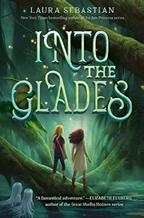
Sehgal, Kabir & Surishtha Sehgal Illus. by Archana Sreenivasan Beach Lane/Simon & Schuster (32 pp.) $18.99 | Sept. 6, 2022 978-1-5344-5365-4
Riffing on the nursery rhyme “One, Two, Buckle My Shoe,” this picture book explores Diwali cel ebrations in India.

The story opens, “One, two… // mehndi for you.” Mehndi is defined below the text, and a colorful illustration depicts
people showing off the mehndi on their hands. Once the book reaches 10, it starts counting backward (“Ten, nine” / fireworks shine”), continuing the rhyming pattern. The text defines Hindu words such as rangoli (“colorful designs made on the floor or ground using chalk and flowers”), diya (traditional clay lamps), and jalebi (a sweet made from deep-frying dough) as well as potentially unfamiliar English words, such as rickshaw. While not all the words are directly related to Diwali, most are com mon vocabulary used in northern India, rendering the book a child-friendly introduction to South Asian Hindu culture. Lush illustrations in a joyful, vibrant palette convey the feelings of India’s festive season and feature characters with a variety of skin tones but mostly similar hair textures. While the authors’ note acknowledges India’s linguistic diversity—pointing out the holiday’s alternative spelling of Deepavali—it calls Diwali an “Indian” holiday when it is actually a Hindu holiday. (This book was reviewed digitally.)
An upbeat introduction to a Hindu festival. (Picture book. 3 5)

Sheinkin, Steve Illus. by Nick Bertozzi
Roaring Brook Press (256 pp.) $17.99 paper | Jan. 24, 2023 978-1-250-20674-9
A graphic version, losing none of the original’s high drama, of Sheinkin’s 2012 award-winning account of the supposedly secret Manhattan Project.
It’s a big story, but the author expertly juggles multiple plot lines to tell a coherent tale at breakneck speed, with all the sig nificant encounters, quotes, and technological breakthroughs intact and a prose afterword to wrap up loose ends. Using a mix of emotionally intense face-to-face exchanges and silent reac tion shots in his realistically drawn scenes, Bertozzi creates a properly cinematic flow as he portrays, on the one hand, the development and cataclysmic use of the first two atomic bombs and, on the other, how the Manhattan Project’s secrets were collected and transported from Los Alamos to the Soviets. Two figures stand out in particular from the teeming cast (which is not quite all-male, as several women played important roles on both sides): Harry Gold, a reluctant courier whose prominence is boosted here by several newly added scenes, and Robert Oppenheimer, who headed up the project’s research team and whose appalled recollection of a line from the Bhagavad-Gita in the wake of the Trinity test explosion—“Now I am become Death, the destroyer of worlds”—remains the Atomic Age’s most powerful and (probably) prophetic motto.
A heady whirl of science and spycraft made even more immediate (and frightening) by strong visuals. (Graphic history.

Shum, Benson
Roaring Brook Press (40 pp.)
$18.99 | Jan. 10, 2023 978-1-250-77613-6
Series: Anzu the Great Kaiju, 2
A contemplative monster discov ers that right action requires more than good intentions.
The benevolent behemoth introduced in Anzu the Great Kaiju (2022) loves nothing more than peacefully tending to his bonsai. But when the lamentations of a neighboring city that has lost its own kaiju pull him “out of his zen,” he compassion ately uses his powers to create a shower of flowers and grow an instant bamboo forest. Unfortunately, the tiny, kodamalike residents need rain more than flowers, and the bamboo wrecks their riverbank—nor are they willing to leave their homes when he invites them to come live with him. Confused, Anzu at last realizes that he should have listened first to find out what they wanted. He returns to hear what they have to say and wait for them to tell him what help they need. So it is that with the same tender care that at last brings his bonsai into bloom, they, too, come to smile once again. Anzu looks less like a scary monster than an outsize Pikachu in Shum’s sunny cartoon scenes, and fans of Andy Runton’s Owly tales or Jon J Muth’s Zen panda Stillwater will be receptive to the similarly serene tone and simply delivered lesson here. The author appends an illustrated introduction to bonsai. (This book was reviewed digitally.)
A gentle suggestion that help should always be accompa nied by respect. (Picture book. 6 9)
Skomsvold, Kjersti Annesdatter
Illus. by Mari Kanstad Johnsen
Trans. by Kari Dickson
Enchanted Lion Books (72 pp.)
$18.95 | Aug. 9, 2022 978-1-59270-374-6
Bedtime has never been so interesting!
Bo, a light-skinned toddler with blond hair, has thoughts and ideas! Perhaps you know a toddler like him? Assuming positions that would make a well-trained yogi jealous, Bo plays on the couch surrounded by toy and pets. As evening approaches and Bo’s mother starts the evening bedtime routine, Bo has his own plans. Instead of going to bed, Bo claims he is a parrot and stands on one leg. Bo’s mother agrees and, join ing in with his imaginative play, flies him off to the kitchen for his evening meal. He stuffs himself like a bear and attempts to hibernate under the kitchen table, but Mommy insists that he has to wash first. Then Bo becomes a sea otter and a walrus and so on until he’s finally in bed asleep. Translated from Norwe gian, the story is delightful and enforces how savvy caregivers can direct and encourage learning, even in quiet moments when
children are brushing their teeth or climbing into bed. The mixed-media illustrations, however, steal the show. With a bold fluidity of hand-drawn lines, vibrant colors, and the occasional hint of the cheeky humor that made Maurice Sendak and Tomi Ungerer famous, Johnsen creates a lush world that children will want to study night after night. The combination of text and illustration transforms into something sublime. (This book was reviewed digitally.)
Don’t sleep on this book; it’s magnificent! (Picture book. 4 8)
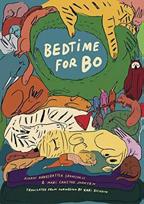

Snider, Hart
Illus. by Sean Covernton Firefly (87 pp.)
$19.95 | Oct. 1, 2022 978-0-2281-0391-2
In this graphic autobiographical short, a boy recalls being the lesson in somebody else’s teachable moment.
It’s 1983, and Hart, a White Jewish Alberta boy, is away at Jewish summer camp. It’s kind of gross and scary, but Hart is grateful there are comic books, cute girls, and Shabbat services. He agrees to play in an intramural basketball game—only realizing the identity of his opponents when it’s too late to back out. Recently the grown-ups in nearby Eckville realized the kids taking social studies from a certain teacher were parroting antisemitic con spiracy theories and Holocaust denial. Jim Keegstra, the teacher responsible, was fired, and now the director of Hart’s summer camp is hosting a day of socializing, including a picnic and bas ketball game, in hopes of forging bonds between the communi ties. In Hart’s memory, the Keegstra kids are massive, terrifying, and look much older—and the first thing he hears from one of them is an antisemitic remark. The illustrations imagine the game as a stylized, colorful comic book–style event involving the defeat of skinheads, Nazis, and the KKK on the basket ball court. As the counselors intended, there’s also a teachable moment for everyone. The simple, cartoonish illustrations include splashes of color to convey indelible sensory memories. Some of the art is abstract and oversimplified to the point of being unclear, however.
A brief and accessible entry point to learning about the ease of spreading ignorant hatred. (content warning, author’s note, map, historical note, discussion questions, glossary)
memoir.
“Don’t sleep on this book; it’s magnificent!”
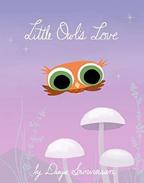
Srinivasan, Divya Viking (40 pp.)
$18.99 | Dec. 6, 2022 978-0-593-20404-7
“Little Owl loved surprises.”
Flying in the magical night sky, Little Owl, a small brown bird with enormous, luminous green eyes, spots his friend Hedgehog, who is happily snuffling through a newly discovered mushroom patch. “Don’t you love finding mushrooms?” Hedge hog asks. “It always feels like such a surprise!” This gets Little Owl thinking: What does he love? Stylized, colorful, and appeal ing illustrations show what our avian hero sees, from shim mering stars and croaking frogs to snoring bears, a mysterious beaver’s lodge, and some hidden butterflies. The more Little Owl looks, the more he finds. His friend Raccoon shares some beloved activities, too, and Little Owl remembers other amaz ing things he has seen and experienced. As the night comes to a close and he heads home, Little Owl is filled with wonder at the forest and his many memories, which he can’t wait to share with Mama. Just right for bedtime, this simple, charming tale beck ons young listeners to stop for a moment and share some of the things they notice and enjoy. (This book was reviewed digitally.)
A paean to the wonders of the night and an invitation for children to observe, appreciate, and discuss what they love. (Picture book. 2 5)
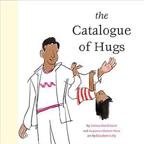
Stein, Joshua David & Augustus Heeren Stein Illus. by Elizabeth Lilly Rise x Penguin Workshop (56 pp.) $16.99 | Dec. 27, 2022 978-0-593-52179-3
Spreading the love, one hug and one family at a time. Joshua David Stein and his son Augustus, a fifth grader, compile an assortment of hug types. Each spread lists the name of a hug and includes a simple yet joyous, loose-lined illustra tion. There’s the Sloth (a brown-skinned child treats a brownskinned adult like a jungle gym, wrapping their limbs around the adult’s arm) and the Tantrum (a bawling, tan-skinned child clutching a tan-skinned adult’s ankles). Readers might know the Backpack as a piggyback ride. There are more than 20 hugs here, but those still eager for more ways to express their affection will appreciate the final page, which suggests the names of 22 more to try. The book is inclusive in its depictions of family, making this a wonderful baby shower or adoption celebration present. One grown-up wears a hijab. A pair of White-presenting older adults are seen with a child—perhaps grandparents raising a little one. A White-presenting adult gives a nighttime hug to a child with dark brown skin and hair, and a later image shows the two as part of a multiracial family. With the Rolling Hug, a White-presenting adult using a motorized wheelchair gives a
ride and hug to a child. Readers will definitely be feeling the love by the end of this warm and reassuring testament to hugs. (This book was reviewed digitally.)
Make room on the shelf for this book that captures the creativity and universality of love. (Picture book. 3 8)
Straub, Emma Illus. by Blanca Gómez Rocky Pond Books/Penguin (32 pp.) $18.99 | Jan. 10, 2023 978-0-593-52943-0
In her debut picture book, adult nov elist Straub offers a tip of the hat…to hats.

This captivating charmer isn’t about hats’ utilitarian func tions—that is, the why, when, or how they’re worn. Nor will readers learn the latest scoop in millinery fashion trends. The author instead muses on…well, hats—mostly how and what they can be made from. And does she have ideas! Among many items, hats can be fashioned from pajama pants, towels, bath time bubbles (temporarily), books, bowls, and—get this—even cats! Speaking of creativity, who says hats only go on heads? Hats fit on fingers, too: Have you ever tried adorning fingertips with raspberries, tortellini, chewed gum, and doll shoes? And— wait for it—where is it written that only people wear hats? Can’t houses, pots, turtles, woodland animals, and stuffed bears wear chapeaux, too? There are many more charming examples in this wonderfully clever title, and children will want to return to it again and again. Adults sharing this adorable winner should be prepared to use it to stimulate creative discussions, drawing, and/or craft-making activities. Children will have a ball donning their thinking caps and coming up with original ideas for devis ing all sorts of hats and various creatures and objects to wear them—including themselves. The digital illustrations incor porate paper collage and are as colorful, lively, and inventive as the text. Characters are racially diverse. (This book was reviewed digitally.)
Raise your hats, everyone; raise them high! (Picture book. 3 7)

Tarpley, Natasha Anastasia
Illus. by Charnelle Pinkney Barlow
Little, Brown (40 pp.)
$17.99 | Dec. 13, 2022 978-0-316-46169-6
A celebration of big ideas, teamwork, and family.
Keyana McGee, a young Black girl, loves big ideas and is willing to put in the work to bring them to life. Her latest idea is to create a backyard soiree for her extended family’s scheduled movie night. Once she has completed her “movie-star hairstyle,” including her “jewel-encrusted princess tiara,” of course, she
transforms her family’s yard into a movie set, with her parents’ and younger brother’s help. Soon, a multitude of extended fam ily arrives: a “fashionista” great-aunt and her dog, five favorite cousins, two uncles, and a set of grandparents, who bring their cat along. When the night’s events take a dramatic turn, Keyana is initially upset, but she and her family work together to imple ment another of her big ideas…one that might just be more brilliant and meaningful than her original. Tarpley’s text cap tures the lighthearted mood of the story, with vocabulary that matches Keyana’s growth mindset and can-do spirit. Pinkney Barlow’s whimsical and expressive illustrations, created digi tally and finished with a handmade watercolor texture overlay, convey the playful and joyous occasion as well as the family’s unwavering commitment to each other. Small details in the illustrations, such as Keyana’s hair supplies (e.g., spray bottle and sleeping bonnet) and choice of hairstyles, offer a welcome layer of authenticity to this celebration of a carefree childhood. (This book was reviewed digitally.)
A loving depiction of a warm, affectionate Black family. (Picture book. 5 10)
Tarpley, Todd Illus. by Sophie Leu Union Square Kids (32 pp.)
$18.99 | Dec. 6, 2022 978-1-4549-4418-8
An attentive meditation on love. Picture books devoted to exploring love can easily slip into syrupy, sweet sentimentality. Tarpley, however, avoids that trap with this work that focuses on everyday moments when we feel love. Following various families through all four seasons, this book demonstrates how love can be found in different forms and various situations. “Love is a puddle with you in the middle. / Love is a laugh in the rain.” As a light-skinned, redheaded child plays with two light-skinned, gray-haired, older adults, “Love is a track / with a big red caboose // pulled by a tank engine train.” The playful rhymes and warm illustrations depict a brownskinned family roasting marshmallow on a summer night, a mul tiracial family crunching through autumnal leaves in the woods, and a brown-skinned Muslim family enjoying a snuggly hug on a snowy evening. The people depicted are racially diverse, and different kinds of families are portrayed. And, of course, there is always enough love to share. “Love is a hug / when you need it the most. // And the best part of love, / it is true… // If you give away all / the love in your heart // even more love will / come back to you.” The book closes with all the families gathered at a park—a community connected by one powerful emotion. (This book was reviewed digitally.)
A sweet reminder that love knows no bounds. (Picture book.
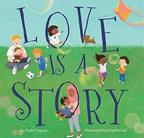
Trimmer, Christian Illus. by Mike Curato
Roaring Brook Press (48 pp.)
$18.99 | Oct. 18, 2022 978-1-250-78602-9
A puppy play date leads to an uncom fortable question.
Though the dogs—a puggle and two poodle siblings—are having fun, the play stops abruptly when the poodles ask the puggle, “What are you?” Unsatisfied by the puggle’s answer of “dog,” the poodles inquire about the puggle’s parents—a combination of pug mother and beagle father—and attempt to justify their preconceived notions about pugs and beagles. The puggle disrupts the stereotypes by turning the question back on the poodles, asking what they are good at (many things) and if this is because of their breed. Affirming that their abilities are not intrinsic but are the result of interest and effort, the poodles realize the same is true of the puggle. The friends play once more until they notice two White human children asking the same question of a brown child; the poodles offer to disrupt the interaction. Trimmer endeavors to confront, and possibly reclaim, a dehumanizing question. Coupled with Curato’s soft, muted illustrations, the book may appeal to fami lies seeking an indirect approach to conversations about iden tity. However, the work only grazes the surface when it comes to the experiences of biracial people and other people of color. Further, the choice to use purebred poodles and a designer mixed-breed dog as stand-ins for, respectively, White children and a biracial child may introduce more stereotypes than it breaks down—namely, the idea that biracial people are exotic or other. (This book was reviewed digitally.)

An insufficient attempt to address the complexity of iden tity. (discussion questions for children and caregivers) (Picture book. 4 6)
Tropper, Jana
Illus. by Genevieve Kote & Axelle Lenoir
Andrews McMeel Publishing (160 pp.)
$9.99 paper | Nov. 8, 2022 978-1-5248-7584-8
Series: Animal Rescue Friends, 2
The second volume of a planned Ani mal Rescue Friends trilogy.
The four kids who work at an ani mal shelter (brown-skinned Maddie; White-presenting, bespectacled Bell; Latine Mikey; and brownskinned Noah) decide to form an animal lovers’ club at their school with the aid of their initially reluctant Chinese American teacher sponsor, Mrs. Wen. To bring the number of members up to the minimum of five, Mrs. Wen invites Jimmy, the Whitepresenting former bully from the first book in the series. When the kids take Noah’s rabbit to visit Mrs. Wen’s grandmother in
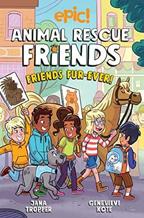
her nursing home, interacting with the cuddly bunny helps her remember her past. The children also use teamwork and detec tive skills to help find the school’s missing hamster. The illustra tions strike a cheerful tone, and the characters show sensitivity and compassion to one another as well as to the animals. How ever, situations in other chapters veer into improbable or even dangerous territory—a horse signifies her unwillingness to pull a wagon by sitting down like a dog, and Jimmy and Bell capture an injured wild porcupine instead of waiting for animal control. The final chapter, in which Maddie attempts to train a cat to become a service animal in a single day, strikes a somewhat sour tone, with sighted Maddie deciding the sort of help a blind per son might need.
The far-fetched episodes and false steps make this volume less successful than its predecessor. (Graphic fiction. 8 12)

Tur, Míriam Bonastre Clarion/HarperCollins (368 pp.) $21.99 | $14.99 paper | Sept. 6, 2022 978-0-358-69310-9 978-0-358-69309-3 paper Series: Hooky, 2
Picking up immediately where Vol ume 1 ended, this sequel sees brother and sister witches Dorian and Dani Wytte trying to avoid notice by the newly powerful witches led by their family.
On orders of the twins’ Aunt Hilde, Master Pendragon’s house has been set alight, while witches patrol towns, and older brother Damien is installed as (reluctant) king by their mother and father. Despite these familial ties, the twins and their friends just want peace and justice. However, there is still debate about what’s fair and how best to achieve the goal of having everyone, magical and nonmagical alike, get along as Tur continues to explore the nuances and ambiguities of good ver sus evil. Relationships grow as crushes are confessed and friend ships find their footing. Change also prompts the protagonists to think about their individual selves, their twin bond, and their complicated family. Other characters are further developed, too: Nico discovers his clairvoyance, and Monica rethinks her obligations. Flashbacks with Damien add deeper backstory as well as insight into the traumatizing catalyst motivating the Wytte parents’ revenge. With a possessed house, dragons, a potion gone awry, and more, readers will enjoy the action and hijinks. The bouncy energy and tone of Tur’s writing match the animated, lively manga-style art. Colored speech bubbles coordinated with individual characters help keep the dialogue straight, which is particularly helpful given the expanded sup porting cast who feature some diversity in skin tone.
Magical adventures abound in this engaging and appealing follow-up. (Graphic fantasy. 8 12)
Uyá, Nívola
Cuento de Luz (46 pp.)
$18.95 | Oct. 18, 2022 978-84-18302-88-6
An unusual bucolic journey.
In this wordless tale, a child with light skin and reddish hair, clad in a dress, travels through the countryside, guided initially by a white rabbit. In a fantastical turn, the child often appears smaller than the rabbit. The protagonist paddles a canoe down the river, encountering a heron, a frog, and a duck, who join the child. Together, they observe one another, and the child contemplates their watery reflection, noticing elements of nature as butterflies flit about and tall rushes and flowers fill the landscape. Uyá’s illustrations appear to be rendered in mixed-media watercolor, with muted tones and textures. Ulti mately the narrative falls flat, as the child’s journey seems to end with little visual explanation. A wordless story needs to be carried by rich, evocative illustrations that can guide readers. However, Uyá depicts the child in a rather stiff and awkward way throughout, which feels distancing. This slight tale would have benefitted from a supporting text that could scaffold a more meaningful reading experience between a child and their grown-up. Skip this and instead opt for Roxane Marie Galliez’s Thank You, Miyuki (2020), illustrated by Seng Soun Ratanavanh. (This book was reviewed digitally.)
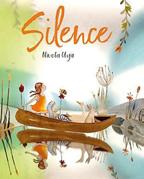
A disappointing addition to the wordless-picture-book genre. (Picture book. 3 5)
Wheeler, Lisa Illus. by Barry Gott Carolrhoda (32 pp.)
$17.99 | Nov. 1, 2022 978-1-5124-0319-0 Series: Dino-Holidays
Popular dino pals are back, this time full of love.
When February rolls around, the dinos suddenly have hearts in their eyes. They break out their paintbrushes and create boxes to collect valentines, they bake festive cookies and tarts, and the flower shop is bursting with roses. Minmi appears to have a crush on many dinosaur friends. She weaves a heart for Diplo, paints a huge sign for Leso, and makes a large chocolate treat for T. rex, all while her heart goes “boom-boomboom” and her stomach flip-flops. As Wheeler sagely points out, however, “School is no place for romance.” But at night, watch out—there’s a Valentine Dance! Will Minmi reveal her true crush? She shyly takes the stage and announces, “For me, this time of year is fun. / The truth is … / I like everyone!” The large, plodding dinosaurs are positively buoyant. They are as jaunty as the bouncy rhymes that propel this love story for ward. Close inspection of the illustrations reveals fun dinosaur puns, some of which may go over children’s heads (the movie
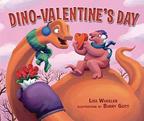
theater is playing When Hadrosaur Met Stegosaurus). (This book was reviewed digitally.)
A sprightly Valentine romp to fill out holiday collections. (Picture book. 3 8)
White, Kiersten Delacorte (288 pp.)
$17.99 | $20.99 PLB | Jan. 3, 2023 978-0-593-37912-7 978-0-593-37913-4 PLB
Series: Sinister Summer, 3
The third stop on the SinisterWinterbottoms’ summer tour of weird attractions is Camp Creepy—only it’s masquerading as completely normal Camp Creek.
Everyone is so happy at Camp Creek! Every counselor and camper is content to do every activity, never mind their person alities or preferences. Theo uncovers the reason why: The camp director is brainwashing everyone to be “normal.” But why? Theo’s chronically anxious twin, Alexander, has succumbed. He’s stopped worrying about things such as waterborne bacteria and is jumping into the lake! Their older sister, Wil, has stopped hunching over her cellphone and is socializing and laughing! Once Theo undoes the process, the trio can once again work as a team to figure out why their parents have disappeared, leav ing them with Aunt Saffronia, who keeps dropping them off at various destinations with vague instructions to find things.
The scenarios are clever, and events are Scooby-Doo–level scary. The siblings’ personalities crystallize in this volume alongside positive messages about acceptance. With the convergence at Camp Creek of characters from the previous two books plus the addition of new ones, a pattern emerges linking the young campers and their families through a common thread involving the villainous Edgaren’t. Next stop: Stein Manor science camp.

This slightly sinister—and very satisfying—intercon nected series continues. (Mystery. 8 12)

Whittingham, Jane Pajama Press (24 pp.)
$17.95 | Sept. 13, 2022 978-1-77278-268-4
Series: Big, Little Concepts, 5
Animals’ physical features compared side by side with children’s.
This picture book compiles photographs of familiar animals along with similarly adorable kids. The simple, repetitive text has a singsong-y feeling: “Owl has eyes— / Big, round eyes. / Owl has eyes. / I do too!” A close-up of the owl’s face is paired with an image of a bespectacled, tan-skinned child looking up from an easel at the camera. Other pages compare showcase
body parts like ears, nose, legs, and, of course, the titular belly. The images are detailed—one stunning picture even depicts the tiny insects stuck to a frog’s tongue midlick. The kids portrayed are diverse in terms of race and ability. The repeated refrain of “I do too!” invites readers to pick up the rhythm and to reflect on their own body parts. The book closes with a note about the importance of movement and body positivity for a child’s growth and development along with a list of suggested activi ties to try together. The format, repetition, and neutral observa tions make this a refreshing title among body books for toddlers and preschoolers. (This book was reviewed digitally.)
A welcome message of appreciation for human (and ani mal!) bodies. (Picture book.

Apunnguaq Lynge, Coco
Inhabit Media (24 pp.) $12.95 | Sept. 20, 2022 978-1-77227-447-9
Two Inuit children count arctic animals.
This rhyming board book shows some familiar cold climate animals and some that might be new to young readers, like musk oxen and caribou. The children, Kuluk and Asa, serve as guides on each page, while rhyming text describes the ani mals. Both kids are dressed in Inuit cold-weather garments, and Apunnguaq Lynge uses one Inuktitut word—ulu, meaning “a crescent knife traditionally used by women”—in the book. The glossary lists the word for each animal grouping as used in the text: a blessing of narwhals and a huddle of walruses, for example. While the rich vocabulary is a boon, the rhyming text often feels awkward and somewhat forced, making for a bumpy read-aloud. Still, the illustrations are appealing, especially the depictions of the animal groups. The heavy-lidded walruses and wide-eyed caribou are especially fun, with a realistic feel. Kuluk and Asa also appear on every page with subtle changes in their expressions, a large numeral behind them to denote the number of each species they see. (This book was reviewed digitally.)
Educational and attractive. (Board book. 2 4)
“A welcome message of appreciation for human (and animal!) bodies.”
Boynton, Sandra Boynton Bookworks (18 pp.)
$6.99 | Sept. 6, 2022 978-1-66592-263-0
Series: Little Pookie
Pookie and family celebrate Thanksgiving.
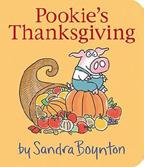
Boynton’s precocious little pig is back in this holiday installment. The family gets ready for Thanksgiving by baking pies, welcoming Nemmy and Boppa for dinner, and sharing gratitude (and pie!). Boynton’s familiar rhyming text and simple, thick-lined illustrations are exactly what readers have come to expect from this series: Pookie is a little silly, the story bounces along, and the artwork is warm and cozy. Though most of the action takes place inside, the passage of day is clear through the window, from daylight to the setting sun. Decorations and a tree with just a few leaves on it indicate the autumnal season. There are two pages where numbers are called out, presented differently from the rest of the typeface (Pookie and their parents prepare apple pie and one pumpkin pie, and there will be five guests at dinner). The only bolded digits are one and five, even though the text does mention that there will be a total of two pies—a stylistic choice that seems to point readers to counting practice but that feels a bit ran dom. Overall, though, this is a worthy new story about one of Boynton’s most beloved characters. True to form, it’s a toddlerfriendly read, providing context for the festivities and a sweet representation of gratitude. (This book was reviewed digitally.)
Exactly what readers want and expect from the boardbook master. (Board book. 1 3)
BUMBLEBEE GRUMBLEBEE Elliot, David Gecko Press (18 pp.)
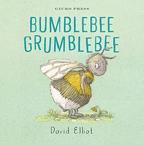
$9.99 | Feb. 1, 2022 978-1-77657-402-5
A series of animal “before and after” scenes told through single-word puns.
What’s a buffalo after it comes out of the tub to dry its fur? Why, a “fluffalo,” of course! How about a rhinoceros after it drops its ice cream cone? A “crynoceros”! Elliot’s simple illus trations show each animal before and after an inciting event, its original and punny new name the only description. The real accomplishment of this astounding board book is that an entire story is conveyed through just two words, one of them being the animal’s name. On one spread, the verso depicts an excited, eager hamster who spots a full jar of jam; on the recto, the jar’s contents now nearly drained, drips of sticky sweetness cover a full and satisfied “jamster.” Elliot’s soft watercolor and pencil illustrations play deftly with light and shadow. Carefully rendered expressions, body language, and movements give each animal its own personality. His original approach to storytelling
and wordplay for toddlers makes for a charming story. The book ends with a gleefully chaotic image of a hose-wielding turtle (“squirtle!”) spraying the other animals. (This book was reviewed digitally.)
Delightful images and carefully selected text combine for a silly, innovative, entirely enjoyable read. (Board book. 2 5)
Evanson, Ashley Penguin Workshop (52 pp.)
$15.99 | Nov. 8, 2022 978-0-593-52061-1
Series: Hello, World!
A concept board book featuring the 50 states and Washing ton, D.C.
Evanson uses counting, months of the year, colors, shapes, and opposites to showcase a different standout historical moment, monument, food, or image from each state and the U.S. capital. Some of the examples may resonate with toddlers: Georgia’s peaches and sunflower fields in Kansas, for instance. Others, like Rosa Parks’ historic civil rights bus ride in Alabama, will take some explaining. The nuance required to understand that scene and others, like six soldiers reenacting the Revolu tionary War, may go beyond what a board-book reader could grasp. Most of the illustrations do match up to what the states are known for, though residents of each might have their own opinions. The book is divided into sections, one for each con cept; each section is outlined in a different color with matching state labels, a helpful though subtle inclusion. Characters are racially diverse, and different cultures are recognized and cel ebrated; readers see San Francisco’s iconic Chinese New Year Festival and the hoop dances of the Nanticoke Indians. Of the various concepts spotlighted, counting and colors are perhaps the most purposeful, while the months, shapes, and opposites are less successful. (This book was reviewed digitally.)
Read this for broad exposure to state names and places as opposed to concept learning. (Board book. 2 4)

OURS
Forman, Ruth Illus. by Talia Skyles
Little Simon/Simon & Schuster (24 pp.) $8.99 | Aug. 30, 2022 978-1-66590-305-9
A message of self-love and friendship and a pronoun primer wrapped into one. Bright, vibrant pages greet readers as young Black chil dren happily get ready for an outing to the park. One fastidi ously applies sunscreen, another ties up electric-blue kicks, and a third adjusts a ball cap to just the right angle before each of them heads out. A fourth friend meets up with them at the park, and the friends have some truly ’til-the-streetlights-come-on
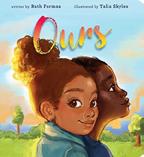
“Delightful images and carefully selected text combine for a silly, innovative, entirely enjoyable read.”
fun. Simple text highlighting different pronouns with repeti tion accompanies each spread: “I love mine / mine” and “she loves hers / hers” steadily building to “you love yours?” set next to a small mirror for readers to practice a bit of self-love as well. And while the question of whether all this love is for rich mela nin or clouds of coils or fabulous style or something harder to see is up to readers, the text turns from ambiguity to end on the certainty that love is for “always, always!” During such a boom of introductory pronoun books, it is difficult not to see the absence of gender-neutral or gender-expansive pronouns here as a missed opportunity. However, such simple text does leave some room for young nonbinary or gender-open readers to see themselves in “I love theirs.” (This book was reviewed digitally.)
Effortlessly uplifting. (Board book. 0 3)
Gehl, Laura
Illus. by Gareth Lucas Abrams Appleseed (22 pp.)
$8.99 | June 14, 2022 978-1-4197-4223-1
Who doesn’t want to take flight and soar sometimes?
Young ornithologist wannabes or children simply dreaming about taking to the skies would do well to cast their eyes on this thought-provoking, dazzlingly colored little book filled with some examples of wonderful birds with rather unusual physical characteristics and narrated in punchy, rhythmic verse. Readers/ listeners will pick up facts about some fascinating avians that possess weird attributes, such as blue feet, baldness, enormous beaks, oversized red pouches, and imperviousness to high tem peratures. Here’s a tidbit that will really make kids sit up and take notice: The hoatzin smells like poop! In the end, though, the text confronts kids with a fact that will truly give them pause: Since humans don’t have beaks or feathers, maybe birds think that we’re the odd ones. No surprise, then, that on the cover, a bird with mesmerizingly huge round eyes stares directly out at readers—unwinged us—in wonder. Set against stylized backgrounds, the boldly hued illustrations depict the birds realistically in terms of color, shape, and characteristic. Notably for a board book, there’s factual backmatter here: a small color photograph of each bird named in the text along with interest ing facts about each one and an explanation of the odd feature mentioned in the book. (This book was reviewed digitally.)
A winning mix of illuminating facts and charming art work—this book definitely isn’t for the birds. (Board book. 2 5)


Herrick, Olivia
Familius (20 pp.)
$9.99 | Oct. 11, 2022 978-1-64170-727-5
A rhyming board book expressing gratitude.
This story, written in the first person and addressed to the “world,” lists many features of life for which we are thankful, from the sun and moon to familiar faces to a bowl of cereal. The book repeats the phrase “I love you” (“I love you neighbors wav ing hi / I love you doggy walking by”), with a rhyme and pacing reminiscent of Margaret Wise Brown’s Goodnight Moon (1947). There is minimal text on each page, which makes this an appro priate length for lap-sitting little ones. The book also has the potential for more complex conversations about gratitude for older toddlers. Though the text lacks capitalization and (with a few exceptions) punctuation, that doesn’t impede read-aloud fluency. The illustrations resemble cut-paper collage: simple images with abundant white space. This makes the pages visu ally appealing but not overly distracting or busy and helps the words stand out. While the concept of gratitude can be a com plicated one for little readers, this book could easily serve as a starting place for building a more personal family thankful ness practice or specific conversation about what it means to be grateful. (This book was reviewed digitally.)
A sweet, relatable book that encourages little ones to appreciate the world around them. (Board book. 1 3)

Illus. by Daniel Roode
Little Simon/Simon & Schuster (26 pp.)
$7.99 | Aug. 16, 2022 978-1-66591-206-8
Series: This Little
A peek at contemporary and historical figures with disabilities.
Holub introduces young readers to 10 racially diverse people, deeming each a “little wonder.” Subjects’ disabilities include limb difference, blindness, and Down syndrome; individuals covered have flourished in fields such as music, sports, and law. On each spread, a singsong rhyme notes the subject’s accomplishment on the verso. On the recto, two sentences provide further back ground, accompanied by a friendly, bobble-headed caricature. An entry on American scientist Temple Grandin notes, “This little wonder / helps us to understand / the behavior of animals / raised on farmland”; on the facing page, a smiling Grandin pats a cow as the text explains that her “sensitivity to sound and touch due to autism has helped her suggest better ways of treating animals.” Other subjects include Irish author and artist Christy Brown,
who had cerebral palsy and used his toes to write and paint, and Indian American musician Sujeet Desai, the first person with Down syndrome to perform at Carnegie Hall. Illustrated with cartoon headshots, condensed nods to 15 additional figures include enslaved American abolitionist Harriet Tubman, who had epilepsy, and Chinese Paralympic wheelchair fencer Alison Yu Chui Yee. Unfortunately, the author’s characterization of suc cessful disabled people as “wonders” suggests that their achieve ments are surprising, casting a patronizing pall over the ensemble. (This book was reviewed digitally.)
A well-meaning effort spoiled by problematic framing. (Board book. 2 4)

Jaramillo, Susie Roaring Brook Press (24 pp.) $9.99 | Nov. 8, 2022 978-1-945635-72-4
Series: Canticos
An expanded explanation of love in both English and Spanish.
Several animal personalities pose the question, “What is love?” and in a series of lift-the-flap responses present various emotional scenarios. Little Elephant asks Spider, “Is it the joy of having you around?” Spider asks, “Is it the way you lift me when I’m down?” Each page corresponds to a flap that reveals one of a multitude of feelings love can evoke in either an Eng lish or Spanish rhyme, which are not direct translations of each other. An interspersed refrain notes, “Amor for the Spanish, / and love en inglés. / Love in any language / always means the same.” A palette of pastels and purple and pink hues dominate as hearts abound on each page, surrounding the characters, who are adorable though on the overly sweet side. The characters are from the bilingual preschool series Canticos, though it will work even among those without knowledge of the show. Chil dren more fluent in Spanish will be better able to appreciate this, and those familiar with the show will recognize the signa ture characters, including “Los Pollitos” (Little Chickies). (This book was reviewed digitally.)
A testament to the universality of love. (Board book. 3 6)

Lee, Vickie Illus. by Joey Chou Henry Holt (24 pp.) $8.99 | Dec. 13, 2022 978-1-250-80151-7
A counting book features animals and colors in Mandarin Chinese and English.
This board book presents the months of the year along with a dozen images in an attempt to spark a bilingual learning
experience. Colorful illustrations that resemble paper craft collages depict a random assortment of creatures amid natural scenery: Two bears doze on snow-covered ground in February, four robins perch on blossomed branches in April, seven crabs float among reeds in July, and so on. For each entry, Lee lists a number, the month, and a phrase (“ONE white crane”) in English and Mandarin. The text is perplexing due to its struc ture, which shows words in two languages yet provides no background information that would facilitate reading aloud for aspiring language learners. The lack of contextual explana tion leaves monolingual readers to puzzle out, for example, the connection between January and the number one or October and the number 10. Likewise, without a pronunciation guide or grounding concepts—such as the customary usage of words in the Chinese language that indicate units or groupings—only those readers with some knowledge of Mandarin as a mono syllabic tonal language or who are familiar with Hanyu Pinyin would find this romanization system relevant. Even so, the Pinyin layout is occasionally inconsistent. The bilingual format may interest Chinese readers who are learning English. (This book was reviewed digitally.)
Scarce appeal for readers who are not already literate in both languages. (Board book. 3 5)

Little Bee Books
Illus. by Glo Wan
Little Bee Books (16 pp.)
$8.99 | Aug. 30, 2022 978-1-4998-1318-0
Feeding? Check. Diaper change? Check. Morning nap? Check. Chess? CHECKMATE!
Combining cutesy illustrations—the knights look like busts of characters from the 1980s My Little Pony TV show—with complex language and die-cut directions, this board book is one that babies and toddlers will love to chew on, though not one likely to leave them prepared for a chess game. The informa tion is solid, but it’s clearly written for an older audience—one that has started thinking abstractly: “Chess is a game with six types of pieces: pawns, knights, bishops, rooks, a queen, and a king. Each piece moves differently. Players take turns moving their pieces to try to checkmate, or trap, their opponent’s king.” That’s a lot of multisyllabic words for one page! The book is edi fying, but the format and the title indicate that it’s for a much younger audience. Older readers—ones genuinely interested in learning chess—may balk at the title, the format, and the fingertracing activities created by die cuts of the paths of the different pieces. Caregivers, let’s focus on games like peekaboo and leave chess alone until a few years after potty training.
Check…out a different book for your baby, mate. (Board book. 1 3)
Little Bee Books
Illus. by Ariel Hsu
Little Bee Books (20 pp.)
$8.99 | Nov. 1, 2022 978-1-4998-1342-5
Series: It’s Your Year, Baby, 1
Welcome, Baby Rabbit.
This festive board book introduces positive characteristics attributed to those born in the Year of the Rabbit as the titular character—the fourth animal in the Chinese zodiac—prepares for and celebrates Lunar New Year. Baby Rabbit is kind and helps friends decorate red banners with greetings and wishes. They are smart and peaceful, figuring out how to fly an over sized dragon kite. Baby Rabbit is also creative, cheerfully mak ing dumplings with a parent. As Baby Rabbit and their loved ones gather around the table for a meal with traditional New Year’s foods, Baby Rabbit pours tea for the others—they are “funny, polite, and generous.” A spread shows how the Five Elements—water, metal, earth, fire, and wood—interact with the zodiac; for instance, those born in 2011 are metal rabbits, “kind and enthusiastic.” As a primer, this book offers mini mal astrological context. Characteristics are fairly simplistic, though they do work as uplifting affirmations to young readers born in the Year of the Rabbit. Hsu’s illustrations, filled with smiling faces, match the mood and incorporate welcome details to the Lunar New Year festivities. Adjectives are set in various colors for emphasis. (This book was reviewed digitally.)
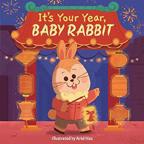
A simple but sweet introduction. (Board book. 1 3)
Little Feminist Press (20 pp.) $9.99 | Oct. 18, 2022 978-1-73418-248-4
Photographs of religious and cultural celebrations.
This board book in the We Are Little Feminists series spot lights religious holidays like Ramadan and Obon, as well as family celebrations like adoption day and preschool graduation. The rhyming text progresses across page turns so that only a few words of a longer phrase appear on each. Bright, full-color photographs from a variety of contributors (listed toward the end) accompany the text. People depicted are diverse in terms of family type, race, and religion. Two young Jewish children wearing yarmulkes celebrate Passover, a Black family lights candles for Kwanzaa, and a North American Indigenous child participates in a powwow. Love, joy, and wonder are palpable in all of the images of ceremonies and celebrations. A helpful glos sary, arranged by page number rather than alphabetically, identi fies each celebration and names the related religion or culture as it applies. While this does make for a clunky back and forth if little readers ask questions along the way, it does streamline the
look of each page. Additionally, the useful note for adults and “Family Discussion Questions”—broken down by age group to foster meaningful dialogue—will encourage conversation and curiosity. (This book was reviewed digitally.)
Warmly celebratory and inclusive. (Board book. 1 4)

UNRAVELLER
Hardinge, Frances Amulet/Abrams
Jan. 10, 2023

Baker, Kylie Lee
Inkyard Press (416 pp.)
$18.99 | Oct. 4, 2022
978-1-335-91585-6
Series: Keeper of Night, 2

Ren Scarborough, Japan’s Goddess of Death, must safeguard her throne and her country from the Reapers of her past.
It’s the early 1900s in Tokyo, and Ren—half British Reaper, half Japanese Shinigami—has now been Japan’s Death Goddess for a decade. But since she killed Hiro, her fiance, and her brother was lost to the deep darkness, her life has seemed lonely and worthless. Even her Shinigami whisper that she is not their legitimate leader because of her foreign roots. When Tsukuyomi, god of the moon and Hiro’s brother, appears at her door to warn her of the presence of English Reapers in Japan, Ren discovers that Ivy Cromwell, who bullied her in the past, has become the Brit ish Goddess of Death and is arriving in a few days to hunt her down. Without being able to rely on the Shinigami to back her, Ren seeks the help of gods who despise her in order to defend her throne and save Japan. This fast-moving, fantastical sequel is full of darkness, gore, anger, and fear, tempered by glimpses of love and forgiveness. Ren grapples with whom to trust, whom to kill, identity and trying to belong, and kindness versus weakness. The book immerses readers in Japanese culture and the captivating world of Shinto gods and goddesses and their complex relationships. Baker’s descriptions and immersive worldbuilding are beautifully detailed and enchanting.
A dark, compelling sequel. (author’s note) (Historical fantasy.

Bates, Laura
Fire (288 pp.)
paper | Dec. 6, 2022
pp.)
Members of a basketball team and their cheerleaders experience a plane crash that leaves few survivors on an island in this Lord of the Flies–esque sur vival thriller originally published in the U.K. as The Trial (2021).
What happens on tour, stays on tour—until a horrific plane crash in the Gulf of Mexico leaves only seven teens still alive
and secrets come spilling out. Basketball players Jason, Brian, and Elliot and cheerleaders May, Jessa, Shannon, and Hayley must quickly learn to work together, foraging for food and water and securing shelter in their new environment. Popularity and social hierarchies don’t matter when you’re struggling for survival. The plot intensifies as someone falls (or is pushed) and the crash survivors contend with incidents involving leeches and a terrifying shark attack that are clearly not accidental. Is there someone else on the island who is trying to hurt them, or is it one of their own? Hayley takes charge, holding a trial to get to the bottom of things during which multiple events from the party the night before the plane went down are revealed. Themes of consent, toxic masculinity, elitism, misogyny, femi nism, and the meaning of justice emerge as Bates creates con versations among the group members that are sobering and thought-provoking. Most characters default to White; May is Japanese American, and Jessa is Black.
An engaging, fast-paced narrative with real-world impli cations. (content warning, author’s note, resources) (Thriller. 14 18)
ONE GIRL IN ALL THE WORLD Blake, Kendare Disney-Hyperion (336 pp.) $18.99 | Jan. 31, 2023 978-1-368-07507-7 Series: Buffy: The Next Generation, 2
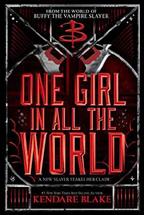
The slayer-witch and her Scoobies have more Big Bads to fight in this sequel to In Every Generation (2022).
Frankie Rosenberg is getting plenty of experience mixing her witch and slayer powers as more evil pops up (often from graves) in New Sunnydale. Demons of yore, back from Buffy’s slaying days, are reappearing in droves, but the fate of Buffy herself after the explosion at slayerfest is still unknown. The Scoobies, a crew comprising teens introduced in the first book as well as some beloved characters from TV’s Buffy the Vampire Slayer, are work ing on finding out what happened to the missing slayers when an oracle warns them “the darkness is coming.” As if that wasn’t enough to worry about, everyone is dealing with the ups and downs of romantic entanglements and the pressures of expec tations from loved ones. This is clearly a midseries book that relies on knowledge from the previous story and ends with more of a reprieve than a resolution. Still, there’s important development of the overarching plot as well as notable charac ter growth that together make for a propulsive read. Like the show, this tale satisfyingly blends humor and lightheartedness with gruesome action, compelling mystery, and a dash of taboo romance. Frankie is cued White; there is some racial diversity and queerness among the Scoobies.
A captivating addition to the series that will leave fans clamoring for the next entry. (Paranormal. 14 adult)

Boyington, Ben, et al.
The Censored Press and Triangle Square Books for Young Readers (272 pp.)
$18.95 paper | Oct. 25, 2022 978-1-64421-196-0
This introduction to media literacy aims to teach readers to be engaged media critics and creators instead of just passive consumers.
Eight well-researched and clearly argued chapters explore key themes: meaning, which is dependent on context and personal experience; access (who is able to use information); representation (who or what is represented—and how); and validity (how genuine a claim is). The book is serious in tone and grounded in academic theory that is bolstered by robust citations. While the concepts presented are complex, the text strives to make them accessible through examples that may res onate with teens, such as references to arguments with parents about screen time and an analysis of news outlets’ responses to tweets from singer Nicki Minaj speculating on the safety of Covid vaccines. Interspersed throughout the book are sug gested activities designed to engage readers in self-reflection. Occasional black-and-white spot art breaks up the text but does little to extend or enhance the meaning. The last chapter offers 10 strategies for using media responsibly and effectively and applying the lessons learned, along with links to relevant online resources. More dense and less visually appealing than similar recent releases, this work may prove most valuable for classroom use.
The moment post truth entered the dictionary, the need for a book like this became clear. (glossary, additional reading, index) (Nonfiction. 13 18)

Cass, Kiera
(576 pp.)
| Nov. 29, 2022
Star-crossed lovers are on opposing sides of an impending war.
Annika, the princess of Kadier, believes in the love of fairy tales but knows it’s not in her future since her father demanded she marry to secure a political alliance. Not too far from their kingdom, there is a growing army of those who believe Kadier rightfully belonged to their ancestors, and they plan to reclaim it. When stoic, hard ened soldier Lennox is given the opportunity to prove himself, he makes a plan to sneak into the kingdom. Neither Annika nor Lennox is prepared for the ways their lives and those of every one around them will forever be changed upon their meeting.
They start as enemies, but their hearts have other ideas, and soon their love is impossible to ignore. This stand-alone fantasy romance shifts between the two protagonists’ points of view, giving readers access to the interior lives of both. Patience is required, as the tale is slow to start; it finds its footing eventu ally, but readers may find it to be too little, too late. Much of the narrative feels bloated with story yet hollow in characterization and emotional depth. Even moments meant to evoke big emo tions, like important deaths or grand romantic gestures, wind up falling flat since there’s not enough substance to give them weight. Characters are assumed White. What should feel epic and romantic winds up dull and uninspired. (map) (Fantasy. 13 18)
Daniels, Sarah Sourcebooks Fire (464 pp.) $17.99 | Jan. 3, 2023 978-1-72825-812-6
Formerly a luxury cruise ship, the Arcadia became a refuge for those flee ing Europe after a deadly virus was unleashed during biological warfare in this duology opener.
It’s 2094, and the refugees have been stranded shipboard in the Atlantic for 40 years—the isolation ist Federated States, which seceded from the United States, will not admit them. Sixteen-year-old Esther and her boyfriend, Alex, are part of an elite group studying to be medics who will have the opportunity to work on land. Esther lives in her grand parents’ former honeymoon cabin with her parents and sister, May. Secretly in cahoots with Nikhil, her love interest, May and other renegades strive to liberate the passengers in a largescale rebellion against Hadley, the ship’s authoritarian com mander. Classism and systemic oppression persist, although race does not seem to be a factor, with comfortable upper-level cabins juxtaposed against poverty-ridden passengers known as Neaths who live beneath the waterline, are ruled by gangs, and never see the light of day. Over time the ship has become decrepit and food, scarce. Possession of outside information is cause for arrest. This fast-paced, action-packed, near-future thriller explores social and political issues that feel relevant today. The characters are well fleshed out through chapters that shift between various points of view. Esther’s arc, in particular, embodies an eye-opening journey. A morally gray cloud sur rounds many characters, supporting plot twists. Main charac ters default to White; Nikhil and his family are British Punjabis.

An addictive, original debut that will leave readers clamor ing for more. (Dystopian. 13 18)

Sourcebooks Fire (368 pp.)
$10.99 paper | Nov. 29, 2022 978-1-72824-804-2
Five teens compete on a reality show set in a haunted cave.
Lex Hazleton did not sign up for the paranormal reality show It’s Behind You to make friends. Nor is she interested in playing the role of supportive friend or comic relief the way manipulative producer Jackie suggests. She wants to be the star, and she wants to win. All she has to do in order to walk away with the $10,000 prize is outlast the other contestants— pretty actress Marla, flamboyant vlogger Python, serious para normal investigator Abbie, and cute, nerdy Liam—in the caves of Umber Gorge, which are prone to collapse and supposedly haunted by a ghost known as the Puckered Maiden. But things go wrong from the beginning: A generator malfunctions, mak ing the lights inside the cave unreliable, and a cave-in blocks areas that were supposedly safe. Everyone is hiding something, and at least one person will kill to keep their secret. Though descriptions of the cave layouts can be confusing and the book is fairly light on scares, mystery-loving readers will keep turning the pages to uncover the characters’ secrets and learn the truth about the events in the caves. Liam has brown skin; other char acters are default White.
A fun read for readers who prefer mild suspense and enjoy reality TV settings. (Mystery. 12 18)

Goldstone, Gabriele
Ronsdale Press (288 pp.)
$18.95 paper | Nov. 1, 2022 978-1-55380-665-3
A young woman survives a brutal post–World War II work camp in this title that continues the series that began with 2015’s Red Stone and is loosely based on Goldstone’s mother’s experiences.
The book opens with Katya’s younger brother Albert’s brief furlough home to Königsberg for his 24th birthday. It’s November 1944, and Albert’s a Wehrmacht soldier. While the official word at the munitions factory where Katya works is that victory is near, Albert knows the Germans are los ing. Katya, Albert, and their sisters are kulak orphans, ethnic German refugees from Stalin’s USSR. When the Soviet army invades East Prussia a few months later, Katya flees only to be captured and sent with other German women to a work camp in the Ural Mountains where her fluency in Russian means she’s forced to translate for her captors in addition to enduring backbreaking work, near starvation, and typhus. When Katya kills and eats one of the crows that haunt the camp, she finds a
source of hope that may help her survive. Goldstone paints the horrors of war vividly and comprehensively; neither the Ger mans nor the Russians are the good guys. Katya, treated bru tally by both sides, doesn’t seem to hold to any political ideology, although she challenges Nazi belief in Aryan superiority. The number of times Katya encounters people from her past strains credulity but not to a breaking point.
Difficult, harsh, and worthy of attention. (map, author’s note, glossary, list of places, supplemental reading) (Historical fiction. 14 18)



Gonzales, Sophie
Wednesday Books (384 pp.)
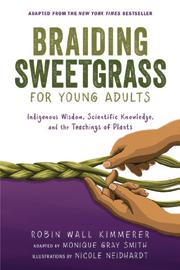










$18.99 | Dec. 6, 2022 978-1-250-81916-1
Revenge is a dish best shared.
In the new reality show Second Chance Romance, a bachelor will date his exes and try to “discover which of them might be the one that got away.” Ameri can Maya Bailey dated Jordy Miller, who became famous when his sister married a prince. After a year together, she got her heart broken when he started dating another girl and moved away. Canadian Skye Kaplan dated Jordy for two months before Maya found out about it, though Skye was not aware at the time of Maya’s existence. Now the two high school graduates, along with four other exes, have signed up for seven weeks at a mansion in the fictional European country of Chalonne. Maya,
adult

though, plans to serve Jordy some just deserts on international television. When she reveals Jordy’s past behavior to Skye, the two begrudgingly make a pact that slowly but surely turns into a new attraction for the two young bisexual women. Readers know Jordy is a baldfaced liar by Chapter 3, so there’s no love lost there. The book definitely passes the Bechdel test, but readers get little backstory about either of the girls indepen dent of their dating histories. Those looking for an enemies-tofriends-to-lovers rom-com as an indulgent treat will have fun but will likely wish to know more about Maya and Skye. Main characters read White.
A light, escapist read. (Fiction. 14 18)

Green, Simon James Clarion/HarperCollins (384 pp.)
$17.99 | Dec. 20, 2022 978-0-358-61725-9
Can a road trip of petty vengeance help two gay British teens recover from a dream prom–turned-nightmare?
Jack—out, flamboyant, and a drama queen—knows that prom with his hot, popular boyfriend, Dylan, is going to be sublime. He and Dylan will surely be prom king and queen. Nate—closeted, shy, and totally in love with his out boyfriend, Tariq—is going to bite the bullet and come out tonight during his senior prefect speech. But everything goes wrong for these two White boys almost immediately when Jack notices Tariq and Dylan exchange a significant glance and he just…knows The ensuing brouhaha leaves Nate heartbroken and furious, while Jack is humiliated and friendless. Yet somehow they end up together on Nate’s family’s road trip, with Jack prepared to Insta their way to revenge. He freely admits to Nate that social media is fabricated even while preparing to document a fabu lous influencer journey of two gay 16-year-olds illustrated via selfie. A shy boy and an attention hog, already angry at each other, are a recipe for tension. But as Nate sulks and Jack avoids getting shot by the army, accidentally lights a hotel on fire, and meets a famous influencer, the truth about their long-broken best friendship slowly comes out. New friendships, supportive family, and old revelations balance out this compelling journey. An unexpectedly funny, heartwarming voyage of discovery. (Fiction. 13 17)
Hardinge, Frances
Amulet/Abrams (432 pp.) $19.99 | Jan. 10, 2023 978-1-4197-5931-4
In a land where curses are real and binding, a young weaver discovers that teasing them apart is wrapped in unex pected consequences.

Hardinge has a rare gift for craft ing strange and original worlds, and here she’s in top form as she chucks two teenagers into webs of deadly magic and conspiracy in Raddith, where curse eggs are illegal but readily available to be cast by anyone out of spite or hatred. The journey takes rude, ill-tempered Kellen, whose unique talent for unravelling affects not only curses, but any woven garment or item in his vicinity, and his constant (in every sense) companion Nettle, seemingly “meek and inoffensive if you didn’t know her,” from the populous capital of Mizzleport to swampy wilds haunted by terrifying creatures to eldritch Moonlit Market (where everything, including memories and daydreams, is vulnerable). The author gradually brings Kellen

(and readers) to an understanding that curses are not always undeserved, that those who bestow them may be damaged but are not invariably evil, and that perhaps we all have the capabil ity to control the hatred that fuels them. Along with weaving in frequent desperate straits and near brushes with disaster, she embroiders her tale with memorable lines; a romantic subplot involving a rider bonded to a demonic horse and, by the end, even more so to his loving husband; and a cast of characters who are memorably distinct. The cast presents White.
Brightening toward the end, frightening throughout, psy chologically acute. (Fantasy. 12 18)
Hibbert, Talia
Joy Revolution (336 pp.)
$18.99 | $21.99 PLB | Jan. 3, 2023 978-0-593-48233-9 978-0-593-48236-0 PLB
Two Black British ex–best friends tumble into an unexpected romance in this YA debut by noted romance author Hibbert.

On paper, Bradley Graeme and Celine Bangura are com plete opposites. Brad is a handsome soccer player who can charm anyone in a five-mile radius. Celine is a fiercely guarded perfectionist who runs a popular conspiracy theory TikTok channel. After a major falling out nearly four years ago, the two avoid each other at all costs. When Celine learns that her hero, human rights lawyer Katharine Breakspeare, is running a pro gram offering three full scholarships for incoming university



“A stunning and emotional debut.”
—Kirkus Reviews (starred review)

arresting look at two girls embarking on diverging futures in a character-driven story that promises—and delivers—hope for a brighter tomorrow.”
—Publishers Weekly
unforgettable, character-driven exploration of sisterhood, survival, and self-advocacy perfect for fans of Elizabeth Acevedo or Ibi Zoboi.”
School Library Journal
“A zippy rom com with strong characterization, bursting with stolen kisses.”
Mass shootings in the United States happen fre quently enough that they have become horrifyingly rote. News of the latest tragedy often lands as a weary nation has only begun to shake off the fresh horror of the incident that came before. In her debut graphic memoir, Numb to This: Memoir of a Mass Shooting (Oct. 11, Little Brown), au thor/illustrator Kindra Neely plumbs the awfulness and dreadful monotony of these massacres through her own experience as a survivor of the 2015 shooting at Umpqua Community College in Roseburg, Oregon, where Neely was then a 19-year-old student. In a book that “will reso nate with far too many,” according to our review, Neely conveys her struggle to cope with the incident, and its psychologically grueling aftermath, with honesty, selfawareness, and hope. The author spoke to us via Zoom
from her home in Salem, Oregon; the conversation below has been edited for length and clarity.
In the book, you include frank depictions of your struggle with mental health as a result of the shooting and sub sequent events. How did you decide how much of that to include, and was it scary to make that so public?
It was very, very scary to make that public. I talk a little bit about it in the book, but previously I was very much a person who kept my feelings to myself, so putting that out in public was a big step and a decision that I’m very proud of. I thought that it was important to include frank discussions of how I was struggling mentally and the effects that had on my friendships, on my body, and on everything, because I wish I’d had those kinds of conversations about some of the very difficult mental health issues that come from traumatic events like these.

When you say that it’s a step you knew you needed to take, did you think of it primarily as something you had to do for yourself or for your audience? Or was it a bit of both?
A little bit of both. It was a big step on my personal journey, but it was also something I definitely felt I needed to do for the audience.
Having lived through an active shooter incident, what’s something about the experience that might surprise someone who hasn’t gone through it?
I’ve had friends and family members be very surprised when I say that I think about the shooting almost every day. While that has lessened as I’ve gotten in a much better mental space, I just don’t think that people realize how much that perme ates your life and your thought. I remember going to classes at [the Savannah College of Art and Design in Georgia], and I would get so many compliments from teachers being like,
you’re so attentive, you’re very quiet and you pay attention. They don’t know that I’m sitting there being like, OK, if a shooter was to come in the room right now, which table am I going to flip over? How can I even get out of this room? I would have those thoughts and those scenarios running through my mind ev ery single day, every time I stepped into a classroom. I’ve had people tell me that they’re surprised to hear that, especially as years have gone by since the shooting.
What suggestions do you have for readers who are in spired to help fight gun violence—especially for readers who might want to help but fear the issue will never get better?

I think that’s how the general public feels about the issue: It’s not going to get better, that they can’t do things to help make it better. I don’t want to flood people with this sense of optimism that things can get better as soon as we do A through B or what ever, but there are things that you can do. It depends on what you’re able to do individually. Some people might find that they are better at going to protests and being on those very physical front lines of enacting change or being involved in programs that help people that have been through gun violence.
I think people take school shootings specifically and put them in their own box [and think of them as] this enigma that happens off to the side. Really, it is a matter of, frankly, White supremacy. I do see that mass shootings and school shootings are linked to [White supremacy]. Depending on the reader, that will be where you have to start making decisions about what you can do to help; for a lot of White people, that’s going to be reflecting and working to combat that kind of ideology.
Were there storytellers and/or artists who inspired you as you were creating the memoir?
I’m fairly new to the world of comic books, so I had a lot of fun getting to read lots of memoir or memoir-adjacent sto ries. I loved Tillie Walden’s Spinning; it made me feel like I could definitely do this book, and the monochromatic purple splash-art illustration in the back of [my] book was very much inspired by [Walden’s book] specifically.
Have you taken a break from creating since you finished the book, or have you still been making art?
I’ve been making art—it’s not necessarily been comic art—but I have been taking a bit of a break; I was so happy finishing the book and [with] the amount of personal healing that I had through that. There was a moment when it was done where I was like, I definitely want to keep doing comics. But this is the first time since the shooting has happened that this doesn’t affect
every single aspect of my being every single day, and I want to enjoy just being a 26-year-old for a little bit.
Have any reactions to the book surprised you?
I gave an advance copy to my friend Jasmine, who’s in the book. She had a friend that at the time was going through some legal stuff with a past partner, I think, and who was afraid to give her testimony in court. When I wrote the book, I thought that this would be good for people that had been in shootings, hopefully, and I didn’t really think beyond that. And Jasmine gave her the book, she read through it, and then she basically pulled an all-nighter working on her stuff for the court. She felt like, Well, this person did this. I can do it, too, and it is important to speak up about what I’m going through. That was a little bit of a surprise, just because I hadn’t really thought about it outside [the context] of shootings.
Do you think that you’ll write another book, and do you have an idea of what you might like to write about?
I hope to have a long career in comics and graphic novels. I have thought about doing another memoir-style book and talk about growing up queer in the South and in a heavily Chris tian community. I might write that book one day, but I think I might take a break from writing about such immediately seri ous topics. I’d love to write books for younger kids about them going on fun and fantastic adventures. It would be awesome to just kind of have my own original characters and my own world to do things with.
Nina Palattella is the editorial assistant. Numb to This was reviewed in the Aug. 1, 2022, issue.
young adult
students, she knows she has to apply—even if it requires two wilderness survival expeditions in a Scottish forest. She also wants to prove a point to her estranged father, whose corporate law firm is a sponsor. For his part, Brad is eager to win a scholar ship that would mean he wouldn’t have to take out loans after all. As their final year of school progresses, the 17-year-olds are thrown together as they attempt to conquer the Breakspeare course. Along the way, they regain mutual trust, reignite their long-simmering feelings, and discover their authentic selves. The pair’s relationship sparkles with tender moments and vulnerable revelations, balancing swoonworthy infatuation with sincere empathy. Brad, who is bisexual and has obsessivecompulsive disorder, helps Celine finally process the pain of her dad’s abandonment.
A zippy rom-com with strong characterization, burst ing with Gen Z–approved verbal sparring and stolen kisses. (author’s note, glossary) (Romance. 12 18)

Ibrahim, Maiya
Delacorte (464 pp.)
$19.99 | $22.99 PLB | Jan. 24, 2023 978-0-593-12696-7 978-0-593-12698-1 PLB
Series: Spice Road, 1

Seventeen-year-old Imani leaves the only world she’s ever known to bring home her disgraced older brother in this fantasy adventure.
Sahir is a place of magic, isolated from other nations and threatened only by the monsters that live in the magic-free wasteland known as the Swallowing Sands. Heartbroken by her beloved brother Atheer’s assumed death, Imani throws herself into her work as a member of the Shields, protecting her city of Qalia from these outside threats. She’s aided by the magi cal properties of Spice, a tea made from the bark of the ancient misra tree that temporarily allows those who consume it to control whichever element of the land they have an affinity for. When Imani finds herself face to face with the djinn Qayn, who claims Atheer is alive and assisting a rebellion in a country across the Swallowing Sands, she persuades the ruling Council of AlZahim to let her journey to this unknown land and bring him back. Ibrahim’s worldbuilding is fresh, with an exciting premise that not only promises a tantalizing romance, but explores clas sism, privilege, and a debate on the human responsibility to sup port those who are powerless. The novel is heavily influenced by Arab cultures with elements like food (for example, manakish and bamya) and representations of everyday life, like smoking shisha and discussing politics, that feel authentic and natural. All main characters have traditionally Arabic names with vary ing physical descriptors that speak to the diversity within the Arab world.
A beautifully written, surprise-filled page-turner. (Fantasy. 13 18)
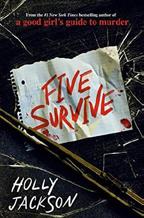
Jackson, Holly Delacorte (400 pp.)
$17.99 | Nov. 29, 2022 978-0-593-37416-0
Red Kenny and her friends’ spring break road trip veers off course when they are detained by a sniper.
Since her police captain mother’s murder, Red has been inseparable from Maddy Lavoy, though it’s often difficult for Red to witness the warm family dynamics Maddy and her brother, Oliver, share with their mother, an assistant DA and Red’s late mother’s best friend. Red, the Lavoy siblings, and three other friends—Reyna Flores-Serrano, Arthur Moore, and Simon Yoo—embark in a borrowed RV on a journey to Gulf Shores but instead find themselves in the crosshairs of a
“A beautifully written, surprise filled page turner.”
long-range rifle held by a man demanding that one of them reveal an important secret. As Red battles internally with her guilt and grief over her mother’s death, her companions become increas ingly volatile and paranoid as the group tries to discern whose secret is the one the hostage taker is after. The sometimestedious, sometimes-intense moment-by-moment breakdown of events in the 31-foot RV (that seems much smaller as the night wears on) magnifies the claustrophobia. Subtle indications that no one can really be trusted alternate with mind-blowing revela tions. Toxic masculinity is often at war with common sense and good judgment, and moral ambiguity abounds. Red, Arthur, and the Lavoy siblings read White; Reyna is Mexican American, and Simon is cued as biracial (Korean and White).
Intervals of intense suspense and a well-crafted puzzle blend to create a thrill ride of a story. (maps) (Thriller. 14 18)

Jaigirdar, Adiba Harper/HarperCollins (368 pp.) $17.99 | Dec. 13, 2022 978-0-06-291632-7
Four young women board the Titanic to steal a rare, gem-studded copy of the Rubaiyat, the classic book of Persian poetry.
It doesn’t take long for Josefa, a thrill-seeking Dublin thief, to select her crew. Croatian Violet, who wishes to reunite with her younger brother at home, has a natural talent for acting and gathering information. Emilie, a skilled painter and forger, is reluctant to take apart the Rubaiyat for profit but is swayed by the thought of using the money from selling the individual jewels to travel to Haiti, her birth country, and visit her deceased mother’s family. Hinnah from Karachi is the youngest of the group, and she’s eager to leave a thankless job at the circus and put her con tortionist abilities to better use aboard the Titanic by sneaking through circulation vents and into locked cabins. Stolen tickets and false identities get the four onto the famously unsinkable ship, where they must nab the priceless volume before it arrives in America. While the planning and execution of the heist keep the story ticking along, the action and excitement really escalate in the latter half of the book. Earlier it’s the shifting dynamics between the girls that build tension as brief chapters in alternating perspectives reveal conflicting interests, hidden motives, and mutual pining. A countdown in the chapter head ings adds a sense of urgency—will the girls succeed before time runs out?
A character-driven story that builds to a dramatic end. (content warning, author’s note) (Historical fiction. 13 18)
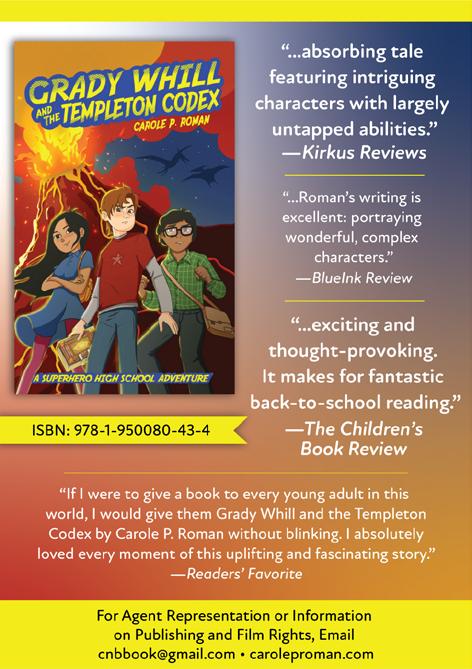

Jouhanneau, Anne Sophie
Delacorte (336 pp.)
$12.99 paper | Jan. 3, 2023 978-0-593-17361-9
A helpless romantic can’t see what’s in front of her in this food-filled romp around New York City.
After one romantic summer night together in Paris, 17-year-old Margot, an aspiring chef from a small French town, and Zach, a visitor from New York City, make a pact to meet in one year’s time in Times Square at midnight. Margot will be relocating after high school to pursue her restaurant dreams (her father, the American son of French immigrants, lives there with his fiance, Miguel). Zach and Margot don’t exchange contact information, believing that this is meant to be. However, on the night they are to meet, Margot gets a call from her dream restaurant asking
her to start that day. Late to the meeting, she finds that Zach is nowhere in sight. Margot—whose restaurant-owner mother is friends with the head chef—was further humbled by hav ing been made a dishwasher despite having culinary training. Line cook Ben befriends her and suggests they try to find Zach together by following clues from things he said during their night together, leading to an adventure. The New York setting is vividly described, with scrumptious food scenes and authen tic restaurant dynamics. The romantic mix-up is enhanced by Margot’s managing of both her cooking bravado and clueless ness in holding onto a romantic ideal while missing her growing connection with Ben. Margot and Zach are presumed White; Ben has black eyes and tan skin.
A delicious romance. (author’s note, author interview) (Romance. 12 18)
Madden, Tobias Page Street (384 pp.) $18.99 | Jan. 3, 2023 978-1-64567-706-2
A lonely Australian gaymer joins a musical theater society in a quest to win the heart of his soul mate.
Noah Mitchell—or Snitchell as he’s called at school—has a problem. He’s in love with MagePants69, a friend he only knows through the online role-playing gameSpire of Dusk. They’re both 17, gay, and live in Ballarat, but parental rules pre vent them from sharing any other identifying details. In real life, wealthy White Noah avoids social interactions at all costs. When his self-absorbed mother, the leading lady of their town’s upcoming production of Chicago, asks him to fill a hole in the show’s chorus, he has no intention of accepting until Mage Pants69 casually mentions in a late-night chat that he attended a rehearsal. Desperate to meet the boy of his dreams and sure that MagePants69 is in Chicago, Noah crafts a plan to make their lives converge. Tightly connected storytelling emphasizes the importance of honesty and vulnerable communication, tying together Noah’s conflicts with his family, his messy romance, and an incident in his past that ended all his friendships in ways that ramp up the tension. The emotional impact of the resolu tion is muddied by the lack of reflection on race; in the predom inantly White cast, most of the antagonists are people of color. Lanky, self-conscious Noah starts working out but by the end of the book is starting to feel more accepting of his body.
Skillfully explores how a teen reckons with authenticity in his relationships. (Fiction. 14 18)

Nanua, Sarena & Sasha Nanua
HarperTeen (560 pp.)
$17.99 | Sept. 6, 2022 978-0-06-298562-0
Princess Rani and Princess Ria embark on new adventures when a prophecy warns of impending calamity in this follow-up to 2021’s Sisters of the Snake

Under the magical influence of the vengeful Amara, the queen and king of Abai lost their memories of their daughter, Ria, who grew up in the streets as a thief. Ria and Rani, her identical twin sister, managed to restore their par ents’ memories, but Amara remains a threat as she gathers the talismans of the Masters of Magic in order to become the Soul Master and gain power over life and death. Ominous visions, a new prophecy from the Fountain of Fortunes, and the appear ance of the Blood Moon, a portent of doom, compel the two princesses to take action: Rani travels to Retan to consult with the desert kingdom’s scholars, while Ria heads north to snowy Amratstan, where Amara was last spotted. As the sisters work with old and new allies to put an end to Amara’s scheme, they each struggle with self-doubt and the weight of royal expecta tions, with these issues affecting their respective romantic rela tionships as well the fate of their world. This sequel picks up from the conclusion of the previous title and expands on the Indian-inspired fantasy world that it introduced. The prose is unsophisticated but vivid, filling the pages with more original mythology, lavish descriptions, and a suitably grand showdown.
Sure to please fans of the series. (list of the Masters of Magic) (Fantasy. 12 17)
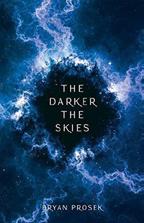
Prosek, Bryan CamCat Books (292 pp.) $19.99 | Nov. 8, 2022 978-0-7443-0554-8
Series: Earth United, 2
One year ago, Jake Saunders and his best friend, Cal Danielson, saved Earth from destruction at the hands of a mys terious enemy.
Their plans to enjoy their hardearned peace fizzle, however, when they’re contracted to uncover intel that might turn the tide of the pirate wars being fought throughout the Milky Way. Extragalactic forces are mobilizing, their sights set on Earth. Backed by old friends and unlikely allies, will they prevail once again, or will the galaxy fall to darkness? Although this is a sequel, enough context from The Brighter the Stars (2020) is provided—presented both in-text and via interstitial news broadcasts—that new readers will not feel lost. Prosek’s greatest strength is his worldbuilding: Every thing, from minute technical details to villainous plots spanning
multiple decades and galaxies, comes across as meticulously planned. Perhaps as a result, the stakes never feel high enough to adequately sustain suspense, although the tight twists and turns remain engaging. Still, there is something vividly cin ematic about the worlds depicted: This is old-school science fiction. The narration feels dry and even stilted at times, and the one-dimensional characters’ dialogue is somewhat canned, but the ambitious scope of the plot and a tantalizing cliffhanger ending promise exciting prospects for a third book. Jake and Cal read White; the supporting cast is diverse in skin tone.
A solid space adventure for fans of the genre’s classics. (Sci ence fiction. 13 18)

Schaeffer, Rebecca Clarion/HarperCollins (384 pp.) $18.99 | Jan. 10, 2023 978-0-358-64730-0
A girl who escapes being collateral damage in an attack must face her over whelming fears.
In the fictional city of Newham, bribes, shootouts, and corruption are widespread, and the water supply is laced with a drug that keeps people from dreaming so that they don’t wake up transformed into the worst thing they can imag ine. Ness came to Newham after her older sister turned into a giant spider and ate their father. To avoid becoming homeless, she works for the Friends of the Restful Soul, though she’s always messing up due to her lack of piety and extreme fear trauma responses to Nightmares. With her position already in jeopardy, she ends up accidentally sucked into a targeted con spiracy that throws her together with a living Nightmare. Ness must then figure out the secrets people are willing to kill her to keep hidden. The worldbuilding’s a dream: The magical rules are revealed clearly and concisely when relevant, and the quirky alternate setting maintains internal consistency and is frequently revealed in pithy, hilarious ways. The matter-of-fact tone of the humor effectively keeps the laughs from undermin ing the scary story elements. Ness’ development from being a self-described coward is hard earned and connects to powerful themes of relationships (including friendships) and overcoming manipulation. While immediate threats are neutralized by the end, bigger threats loom. The cosmopolitan world is casually and naturally diverse; Ness lacks racial descriptors.
So much fun readers will stay up all night to finish it. (Fan tasy/horror. 13 adult)

Sharpe, Tess
Little, Brown (384 pp.)
$18.99 | Jan. 24, 2023 978-0-316-30279-1

Two girls navigate life in a small town, orbiting their mothers and each other.
Penny and Tate have been stuck with each other through their moms’ best friendship. Although they don’t always see eye to eye, they do have a lot in common: They’re both 17, they both care deeply about their mothers—and they both like girls. The latter has made them come close to kissing on sev eral occasions—six, to be exact. Not that they’ve talked about it; after all, they have far more pressing matters to discuss, like Tate’s mom’s frail health or the money issues both families face. Whether it’s Penny’s dad’s death or Tate’s swimming (she’s hop ing for a college scholarship), every issue involves both of them,
and their families often merge into one. As a new development in Tate’s mom’s health comes up, the girls are forced to be in each other’s lives in an even more present way, and their feelings for each other can’t stay bottled up. In this character-driven, slow-burn romance, both Penny and Tate are engaging voices, enriching the narrative with their strong and very different per sonalities. It’s impossible to choose a favorite: Each one moves through life in her own way, informed by individual traumas and hopes, colliding with each other in an angst-y and ultimately satisfying way. Main characters read White by default.
Well characterized and wholly entertaining. (Romance. 13 18)
Taslim, Priyanka
Salaam Reads/Simon & Schuster (400 pp.)
$19.99 | Jan. 3, 2023 978-1-66590-110-9
Zahra Khan finds herself in a real-life Bengali natok, or drama, when two hand some boys enter her life.
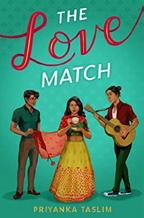
All Zahra really wants is to be a writer, but she must first navigate adulthood, love, and the Bengali community of Paterson, New Jersey. She has to put off college to work at local Pakistani tea shop Chai Ho to help her mother support their family, which has strug gled financially ever since her father died two years ago. While Zahra focuses on making ends meet, her mother tries desper ately to set her up with gorgeous, well-mannered Harun Emon, who is from a wealthy family—precisely what Zahra’s mom is looking for. The two 18-year-olds are not interested in one another, but they pretend to date to keep their parents satis fied. Meanwhile, Zahra is falling for new Chai Ho hire Nayim Aktar, a poor orphan and recent arrival from Bangladesh. As the pressures start building, Zahra finds herself at a crossroads: choose obligation or choose herself. Taslim’s descriptions of the Bengali community and her articulation of diverse Muslim identities and practices are authentic and nuanced. Details like waking up for Fajr prayer, halal dating, and inner turmoil over wanting physical intimacy describe genuine experiences. Topics like double standards in the South Asian community, the inter section of queer and Muslim identities, and the reality of the inaccessibility of higher education add depth to the novel. Candid, textured, and amusing: a novel readers will devour in one sitting. (Romance. 12 18)
Thomas, LaLa
MTV Books/Simon & Schuster (368 pp.) $19.99 | Jan. 3, 2023 978-1-66591-727-8
Two high school friends in Nevada face tough decisions when one of them discovers she’s pregnant.

Since learning she’s pregnant, 16-yearold Erykah Smith has been having the worst birthday of her life. Instead of wor rying about college test scores and getting her driver’s license, she’s going to be battling morning sickness and the judgment of her peers. At least she has her best friend, Kelaya Lancaster. The two Black girls come from totally different neighborhoods of Lynwood Heights—Erykah’s low-income projects and Kelly’s affluent enclave—but until now their friendship trumped any differences between them. Kelly, who aspires to be valedicto rian and play basketball in the WNBA, has a wonderful boy friend, Ray, who is quite unlike Erykah’s unreliable boyfriend, Miguel. Kelly knows her friend needs her support, especially after Erykah decides to lie to her mom about what she plans to do about the pregnancy. But Kelly is also focused on her own goals, and the girls’ friendship is pushed to its limits as they try to juggle the truths, the lies, and their dreams for the future. Thomas’ characters are so real readers will feel like they’re part of the text conversations that are scattered throughout the novel. Deftly woven into each girl’s story are hard-hitting facts about teen pregnancy and Black maternity issues. Far from being a judgmental cautionary tale, the work treats Erykah’s circumstances with care, offering a true representation of the right to choose, despite the odds.
An empowering, relatable read. (Fiction. 14 18)
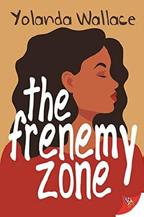
Wallace, Yolanda Bold Strokes Books (264 pp.) $13.95 paper | Nov. 15, 2022 978-1-63679-249-1
A fun, thoughtful small-town tale of teen romance and family connection.
Olly Smith-Nakamura has just moved from the Bay Area to Frog Wallow, West Virginia, where one of her fathers grew up. She’s going through a lot, having recently experienced a breakup with her girlfriend and lost her Grandpa George. Adjusting to Appalachia after living in Califor nia is difficult; she understands it makes financial sense to take over Grandpa George’s hardware store since Dad lost his job and Papa had to close his restaurant, but her life back home seemed much better. In Frog Wallow, Olly stands out just by vir tue of being biracial and having two dads; Papa, her biological father, is Japanese American, and her African American biologi cal mother is Dad’s sister. Olly is also a lesbian. Things take an
“Candid, textured, and amusing.”

interesting turn when Olly meets competitive Ariel, nicknamed Miss Perfect, who in truth wants out from her ultracontrolled life. The two initially clash but later find out they have more in common than anticipated. Unfolding in a world in which Covid is still present but the early pandemic lockdowns are over, Olly’s growth is strongly supported by her family as she embraces her African American roots. While the book is at times slow paced and generous on the telling rather than showing, it’s an enjoy able read that explores a queer romance in a rural setting.
A coming-of-age story with a rich cast of interesting char acters. (Romance. 13 18)
SUNBURN
Watson, Andi Illus. by Simon Gane Image Comics (224 pp.) $19.99 paper | Nov. 29, 2022 978-1-5343-2233-2
A girl in mid-20th-century England grows up quickly during a summer holi day in Greece.

Sixteen-year-old Rachel Collingwood lives in a modest row house and has never been abroad. She expects to spend the summer working at the butcher’s and going with her parents on their usual caravan holi day at the Essex seaside. An unexpected invitation to instead join Peter and Diane Warner, her parents’ glamorous, childless friends, is too good to pass up. Staying at the Warners’ hilltop Greek villa, Rachel is awed by effortlessly chic Diane, who shares her lipstick and sundresses, and debonair Peter, who introduces her to alcohol as they dine alfresco in the Mediterranean sunshine. The couple trot Rachel out at parties and connect her with the only other young person in their circle—Benjamin, an attrac tive young Englishman working at the tennis club and hoping to curry connections that will help him land a job with upward mobility. Rachel and Benjamin fall into what seems like a typi cal holiday romance; as time passes, however, it is increasingly clear that this insular community of expats is hiding secrets, leading to innocent Rachel’s experiencing feelings of shock and betrayal. The spare dialogue flows naturally, propelling the story forward. The luminous, evocative artwork steals the show with its palette of blues and sandy browns accentuated with occa sional pops of red and yellow. This is a contemplative study of a girl battered and disillusioned by her first glimpses of adult complexities.
Atmospheric and nostalgic. (Graphic fiction. 16 adult)

Watts, K.M.
Duet (284 pp.)
$12.99 paper | Nov. 15, 2022
978-1-951954-21-5
Naïve princess joins pirates. White-coded, bisexual Princess Andromeda of far-future Celestine (the terraformed moon) struggles with panic attacks after an airship wreck that neces sitated replacing much of her body with robotics. Her upcoming dynastic marriage to an Earth-born prince causes more stress; she’d rather tinker with engines but understands that her role is to rule Celestine rather than to live her dreams. En route to Earth, her spacecraft is hijacked by the crew of the pirate Lord Captain Bran. Although at least one crew member knows who she is, he agrees to keep the secret, and Andromeda becomes aspiring mechanic Andy, although Bran nevertheless seems strangely focused on her. Once aboard the pirate ship, Andy builds new friendships, engages in flirta tion with a man called Allen and a woman named Mars (a pos sible polyamorous romance is hinted at), and learns hard truths both personal and political about her world. Clunky writing and retrograde monarchies (absolute, dynastic, and more concerned with image than good governance) detract from the excitement. Some violent scenes involving the space pirates clash with the more tender found-family story threads. Secondary characters are diverse in skin tone, gender, and sexual orientation, all of which are non-issues in this otherwise old-school future. A late game introduction of possible fantasy elements sets up the sequel but further occludes narrative coherence.
An interesting premise that doesn’t quite coalesce. (Science fiction. 13 18)
“A contemplative study of a girl disillusioned by her first glimpses of adult complexities.” sunburn
THE END by John Bray; illus. by Josh Cleland
TRINE REVELATION by C.K. Donnelly
THE SHATTERING OF ALENDIA by Diana Edmondson

ALONE IN THE HOUSE OF MY HEART by Kari Gunter Seymour
A VOICE OUT OF POVERTY by Jillian Haslam
ARGO & ME by Chandra Ghosh Ippen; illus. by Erich Ippen Jr.
THIS COULD BE YOU by Cindy Williams Schrauben; illus. by Julia Seal
SPIRIT VALLEY RADIO by Jennifer Tall
ORPHANS OF CANLAND by Daniel Vitale
Atchison, Elise Sowilo Press (268 pp.) $21.79 paper | May 31, 2022 979-8-9854317-1-1
A debut novel in stories follows the rise of a Western town through the men and women who build it.
In a remote Montana valley, a com munity takes shape beneath a snowy crag called Crazy Mountain. A real estate agent seizes an opportunity to buy a massive ranch on the cheap, but flipping it turns out to be a bigger challenge than he bargained for. A wealthy couple from Los Angeles, still mourning the murder of their son, eventually buy the property, but their desire for uninterrupted nature is ruined by the tres passes of their “yokel” neighbors. A divorced man from Mis souri uses his last bit of money to start a trailer park, but when he breaks ground on a convenience store to serve his residents, he’s unhappy to find what seems to be an Indigenous burial site. An older woman waits for her husband to die on their remote, snowed-in ranch, knowing she will have to dispose of the body on her own: “It took two weeks for Frank to finish dying.… After he took his last breath and there was nothing left but the body, she undressed him and wrapped him in a cotton sheet, trying not to focus on the miles of empty space surrounding her now that Frank was gone.” Across 15 stories that span from 1970 to 2015, Atchison relates the history of the valley as it develops from a lonesome ranch into a wildfire-threatened exurb. The author’s observant eye for nature makes her an especially adept chronicler of its decline: “Juniper tapped her brakes…when she saw the massive Aspen Springs Subdivision cluttering the sage brush foothills where the elk used to graze in the bunchgrass all winter long. The hillsides had been taken over by cheatgrass and knapweed and the mountain slopes were stained with the rusty-brown hue of beetle-killed trees.” Each tale takes on a new character’s perspective, leaving the valley itself to serve as the book’s true protagonist. The result is a story collection with a novelistic sweep, capturing what is lost and what is gained in the development of the mountainous West.

An elegant, eco-minded collection of tales set in a Mon tana valley.
adult
Vampires thrive in unexpected places. The FX comedy series What We Do in the Shadows chronicles the escapades of vampires on Staten Island. The Portugal Pavilion at the Venice Biennale, which runs through Nov. 27, features the exhi bition “Vampires in Space.” And plenty of films and books showcase the pale, bloodthirsty predators. Kirkus Indie recently reviewed three novels about these fanged night crawlers.
An unhappy vampire agent meta morphoses into a villain in James T. Carpenter’s Blood of All Evil. Samuel Johnson, an agent of Vam pires Against The Evil, battles humankilling “true vampires.” But dismayed by his deliberately risky assignments, Samuel slays his boss and switches sides. He par ticipates in plots to assassinate “humanlover” vampire leaders while pretending to be a righteous VATE agent. Has Sam uel really embraced the dark side? Our re viewer calls the tale “a spirited and enjoy ably droll supernatural romp.”
In Oh Great, Another Vampire Book by Diane Hunter, a 250-year-old vampire in Boston falls in love with a communica tions student named Sara Fielding. When he tries turning her into a vampire, she in stead becomes a powerful “intermediate being” who frequently communes with God and advocates peace as a “Social Jus tice Warrior.” Then the luminary con fronts a social media backlash. According to our critic, the satire offers “a diverting and often hard-hitting commentary on America’s celebrity-obsessed culture.”
Geraldine Burrows’ Vampire Island, Rhode Island focuses on a folklorist who challenges a legend involving a vampire plague in the 19th century on Purga tory Island. Dr. Leah Gerard diligently searches for historical clues and scien tific explanations on Purgatory with the help of a local. Unfortunately, Leah’s de bunking mission angers some of the is landers. And after a startling murder, she finds herself investigating the crime. “A razor-sharp protag onist headlines this gripping tale of mythical vampires and scarier humans,” our reviewer writes.

Myra Forsberg is an Indie editor.
Bray, John Illus. by Josh Cleland

Starry Forest (32 pp.)
$17.99 | Sept. 13, 2022 978-1-951784-12-6
In Bray’s picture book, readers learn the value of starting and finishing activities.
Endings are hard. Many kids struggle with finishing one task and moving on to another, but, as this book points out, “THE END of one thing is the beginning of something else. And the beginning of one thing is THE END of another. And that’s okay.” The text offers more guidance than narrative, providing many examples of how the start of one task (reading, adventuring, matching up socks, and so on) means another is being left behind, or how being in the middle of things can be fun but eventually becomes a snooze: “Boredom is THE END of fun.” The art reflects the text’s sentiments but also tells its own story of a pigtailed, dinosaur-loving child who joyfully heads into a school’s summer vacation, has adventures with their cat, then returns to school in the fall and makes a new friend. (The unnamed child has light brown skin and straight hair; the friend has dark brown skin and curly hair.) Cleland’s illustrations are charmingly whimsical, and characters’ faces are beautifully expressive even though the protagonist never says a word. They’re a perfect fit for the playful, lively text that explains the good and bad elements of concluding things with out ever talking down to its audience. An engaging book about accepting endings and celebrat ing beginnings.


Dividends Press (262 pp.) $14.99 paper | $9.99 e-book | Sept. 20, 2022 979-8-9857017-0-8
A writer recounts her controversial affair with a much older woman in this debut memoir.

Cohen first met Sarah when she was still a closeted undergraduate with dreams of one day being a writer. The author took a summer job on campus as a counselor helping to orient incoming students. Sarah was her boss, a hardnosed woman in her 50s who quickly took a shine to Cohen— and the author worked hard to impress her. After graduation, Cohen found a job in admissions and remained on campus, con tinuing to run into Sarah now and then. The connection between the two was enough to draw the attention of the author’s first girlfriend, who commented on the impropriety of Sarah being attracted to a woman one-third her age. The attraction, though, was mutual. “That night I woke from a dream in which Sarah showed up at my apartment, told me her girlfriend had left her,

and kissed me,” writes Cohen. “I tried falling back to sleep, but my brain was hellbent on replaying the dream.” Eventually, the two acted on their desires despite Sarah’s long-term relationship with a woman named Linda. But the secret could only stay hid den for so long, and when the truth of their love became public, the author was forced to live with the consequences of her affair. Cohen’s prose is simple but urgent, capturing the passion and confusion of her emotions: “Fifteen minutes later Sarah pulled into the driveway at my parents’ house. It was pitch black out, the sky full of stars. The air smelled cold like snow was coming. I shuddered…Sarah was about to meet my parents who thought they would be meeting my former boss, not my current lover.” The book moves quickly, and the author proves a sympathetic protagonist even when she recounts decisions that readers will likely wish she hadn’t made. It’s a compelling scenario, one that feels transgressive to both the writer and readers, and Cohen holds her audience’s attention to the end.
A gripping account detailing a May-December romance between two women.
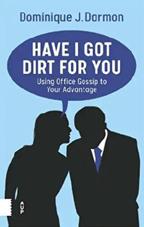
Darmon, Dominique J. Amsterdam University Press (260 pp.) $43.50 paper | Aug. 23, 2022 978-94-6372-489-0
A plan for putting workplace gossip to productive use.
As Darmon, a senior lecturer at the Hague University of Applied Sciences, observes at the beginning of her book, workplace gossip is a spectrum; workers who never do it are seen as “socially inept,” whereas those who do so constantly are seen as unworthy of trust. But, Darmon argues, there’s a “sweet spot”—a point at which gossip can serve useful and beneficial purposes in an organization. Citing a wide array of psychological and work place studies, popular works of nonfiction, and journals such as the Harvard Business Review, Darmon analyzes what exactly gossip is, how it’s classified, and how it’s disseminated in a group of co-workers. Some sources look at negative aspects of gossip, but others address the humanizing effect of such communi cation and its ability to convey positives such as empathy and nuance. The author also shows how it can convey important information about workplace culture: “Let’s say that you know that your boss…has a reputation for hitting on a record number of employees,” she writes. “If a new, young colleague comes to work for your department, and…you notice the sleazebag flirt ing with her but choose to say nothing, you will eventually be judged quite poorly.” Over the course of the book, Darmon switches smoothly between such well-drawn hypotheticals and more technical analyses. As a result, the work does a pitchperfect job of both eliciting the personal, universal nature of gossip and treating it seriously as a method of communication. Readers who’ve ever indulged in such conversation—and who
hasn’t?—will look at the subject in a new light after finishing this book.
A sharp, lucid, and compelling study of a relatable but rarely discussed topic.
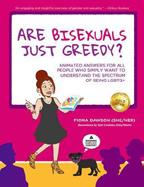
Dawson, Fiona Illus. by Syd Cordoba Publish Your Purpose Press (128 pp.) $45.95 | $29.95 paper | Nov. 15, 2022 978-1-955985-86-4 978-1-955985-85-7 paper
A lighthearted but informative summary explores the basics of gender and sexuality.
In this debut nonfiction book, Dawson uses a questionand-answer format (with the text accompanied by Cordoba’s delightfully colorful illustrations) to address key concepts related to gender and sexuality at an introductory and compas sionate level. The author, who is cisgender and bisexual, uses herself as a frequent example as she answers questions like “How Do I Know What My Gender Is?” and “How Do Trans gender Women Pee in a Public Restroom?” along with more than a dozen others, including the one that serves as the book’s title. She also shares stories of her friends and family, drawing on the power of anecdotes to illustrate abstract concepts. In short but illuminating chapters, Dawson answers each ques tion, balancing a chatty and upbeat tone (“This is because being nonbinary is a gender identity wired in their brains, whereas sex is visible between their legs”) with solid information and an enthusiastic appreciation of the various ways in which humans identify and present themselves to the world. Some readers may feel that the book could have used fewer details about the author’s own sex life, but those specifics (frequently accompa nied by a request that Dawson’s father avert his eyes for a sen tence or two) also serve as evidence of the work’s sex-positive approach. The volume makes it clear from the introduction that its target audience is readers who want to know the differ ence between cisgender and transgender, not those already well versed in current terminology and concepts. For readers who cannot immediately define each component of the LGBTQIA+ acronym, the book offers a solid and highly readable synopsis that explains why skeptics should embrace—not simply toler ate—the wide range of identities that exist. The work’s discus sion of the Bible’s mentions of gender and sexuality might have been better served by a less high-level approach, but even that chapter’s brief arguments are fully supported by citations.
An engaging and insightful overview of gender and sexuality.
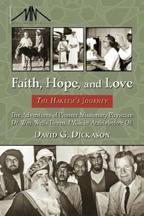
Dickason, David G. Van Raalte Press (454 pp.)
$30.00 paper | June 8, 2022 978-1-956060-95-9
A biography explores an American missionary couple’s quest to spread mod ern medicine and the Gospel through the Arabian Peninsula.
Dickason recounts the adventures of Reformed Church in America missionaries William Wells Thoms, a surgeon, and his wife, Beth, a teacher with lab techni cian training The couple went to the Middle East in 1931 and spent their careers treating patients in Bahrain, Saudi Arabia, and, for 30 years, at a hospital in the Omani capital of Muscat. Arriving before the postwar oil boom, they found the region mired in desperate poverty and practiced medicine under the most trying constraints in hospitals that lacked basic supplies and equipment like X-ray machines, trained staff, sanitary amenities, and money for improvements. In Riyadh, Saudi Arabia, Thoms performed assembly-line eye operations in the most rudimentary conditions while navigating fraught cultural tensions. (After resuscitating an 11-year-old boy whose heart stopped during surgery, Thoms was informed by the patient’s uncle that he would have killed the doctor had the child not survived the operation.) While Thoms wrestled with medical crises, he also attended to his missionary calling, delivering impromptu sermons—“I am not the head of the hospital. The head of the hospital is the Great Physician, whom Muslims call the Prophet Isa and Christians call Jesus Christ.” Dickason fleshes out this largely factual, though sometimes embroidered, biography with background material on the complex interac tions among Arab society, Omani tribal and religious politics, missionary initiatives, and British imperial machinations, often conveyed through invented expository dialogue. At one point, a ship’s captain asserts: “According to Lorimer’s Gazetteer of the Persian Gulf, whose six volumes I have as my bedside compan ion, this entire coast focuses on one major activity—pearling.”
The narrative is mainly an anecdotal ramble, but the stories are told with panache—“Then with a sudden roar, the full tsunamilike flood hit,” Dickason writes of a flash flood Thoms barely escaped—and set amid vivid, evocative travelogue. (“No trees or greenery softened the view. It was like a high-contrast, blackand-white photograph. The bright reflection from the water, the beach, and the whitewashed, adobe-like buildings almost hurt Wells’ eyes.”) The result is a captivating story of strangers in a strange land.
An engrossing re-creation of an iconic encounter between Western Christians and traditional Arab culture.

Donnelly, C.K.
Kibbe Creative Media (332 pp.)
$28.95 | $17.95 paper | $8.95 e-book
June 14, 2022
978-1-73505-188-8
978-1-73505-189-5 paper
The two most powerful people in a world called Kinderra prepare their final moves against each other in this third volume of a YA fantasy series.
Trine Mirana Pinal has only lived “16 summers,” but the fate of Kinderra is in her hands. She’s just learned shock ing news about her mentor in the art of “the Aspects”—the great powers she wields. Trine Tetric Garis is the “Dark Trine.” (Trines have three Aspects, a rare phenomenon.) Garis plans to take over Kinderra using the “Power from Without,” a magic based on subjugation and death. As Mirana sets out from RünTaran, she’s determined to reach the “mountain-locked learn ing hall” of Caladazh. There, she must prevent Garis from retrieving the final passage of a journal kept by her formidable ancestor Jasal Pinal. The passage reveals how to weaponize Jasal’s Keep, the stronghold from which the warrior turned back Ilrik the Black’s armies. Among the treasured belong ings of Jasal that are in her possession, Mirana finds his dia mond amulet, through which she’ll focus her Trine skills in “Healing,” “Defending,” and “Seeing.” Her journey becomes more complex when she reluctantly teams up with Sido Ren del, Garis’ potential heir to power. Sido doesn’t want Garis to rule Kinderra either, because, as he tells Mirana, “We both believed he would show us how to be something more than what our destiny called us to be. Instead, he lied to us both.” While traveling with Sido, Mirana learns that he’s a man with a Codex. Using her Healing Aspect on his festering wound brings them closer together, offering her a chance at love after rejecting Teague Beltran, her “Unaspected” best friend, for his own safety. Despite her commitment to personal sacrifice, Mirana will learn that the Dark Trine’s cruelty has no limits. Donnelly’s latest installment pushes her meticulously crafted narrative to a dramatic peak. The Trine novels’ depic tion of good versus evil—and the compromises made for the sake of each—is a heartfelt, streamlined alternative to the one found in the unwieldy Star Wars franchise. When Teague, who stands no chance of surviving a confrontation with Garis, says, “Mirana, I swear to you, I will find you, and I will never leave you again,” the third act’s romantic stakes rocket upward. Far from perfunctory, the love triangle that develops relies on worldbuild ing nuances. As Mirana falls for Sido, who’s a Seer, it’s because he’s offered her “a place from which to begin to tame my own monsters.” Later, Mirana’s refusal to leave her horse, Ashtar, behind in battle hints at an expansion of the Aspects that changes a Trine’s core potential. The action sequences, often portraying psychic warfare, are striking (Garis’ “mind attempted to breach her protections...the diamond she gripped now hot against her palm”). While not everyone dear to Mirana survives
the final battle, Donnelly gives her cast a warm sendoff that val idates her hero’s optimism. After one character ends his journey with the words “I’m a bad man who occasionally does good things.... But maybe I might become good....Someday,” fans will be eager to see what unfolds in subsequent volumes. The author’s skill with revelatory character arcs and tightly woven suspense sets this saga apart from countless other series featuring fantasy worlds that draw on similar inspirations.
A highly inventive and gripping installment of an impres sive fantasy saga.
Edmondson, Diana Self (486 pp.)
$12.00 paper | $2.99 e-book | April 15, 2018 978-1-977015-42-6
In Edmondson’s fantasy debut, a pandemic’s source shocks survivors.
Five years ago, the “shattering” began to take root in the realm of Alendia. Vic tims of a deadly contagion become “gaunt and feverish” before dying. Aislyn, a gifted healer, left her home of Tolune three years ago with her 12-year-old daughter, River. They travel with a caravan of survivors who stop in shattered towns that might still be saved from being irreparably “riven.” Among the travelers is Lindsey, Aislyn’s friend and cook, and Quinn, a quiet, capable man whom some find unsettling. In the town of Lynnvale, Aislyn meets Caleb, another healer. The stress of try ing, and failing, to save lives brings them close, but they initially keep their relationship a secret. Eventually, we learn that River has a gift for healing like her mother. Quinn teaches the girl horse riding, and a future nearly becomes visible on the horizon. Yet as Aislyn and Caleb continue trying to reverse the shattering, the malevolent source of the disease threatens to change Alendia for ever. If George R.R. Martin’s series A Song of Ice and Fire had been informed by a pandemic, it might read like Edmondson’s series opener. Robust swaths of dialogue draw readers deep into the characters’ lives. The first savage twist is masterful, jolting the narrative for the remainder of the novel, and Alendia’s reac tion to the shattering mirrors the emotional challenges of fac ing Covid-19. Aislyn is suspected of causing the disease, while the hard truth should resonate strongly with audiences. When narrating, Aislyn is poetic without being florid when she says, “I had wrapped my grief and terror up in tough canvas only to find it more resembled fish netting than ship’s sail.” Quinn’s rugged charm makes him one to root for when a love triangle heats up. Surprising final chapters will see fans eager to continue the series.

A brutally effective fantasy drama that succeeds on every risk taken.

Gardner, Bruce Zino Publishing (490 pp.)
978-0-9998811-5-6
978-0-9998811-4-9 paper
Gardner’s historical novel of the Civil War follows the lives and times of a plantation owner’s bitterly divided family.
The novel opens in 1856, describing the fallout of what would become known as the Pottawatomie massacre, in which the abolitionist John Brown and his followers killed five proslavery settlers. The impact of the event sent shock waves through American society, which is on the brink of war. The story then focuses specifically on the Hodge family, who live on a 700-acre tobacco plantation in Virginia and enslave more than 80 people. As unrest spreads, the family patriarch, Law rence, grows increasingly anxious about the potential threat to his livelihood. After war comes, his daughter Emma works as a nurse but loses her job after protesting the abuse of a Black child at the hands of a Confederate States Army major. Lawrence’s son David meets Abel Bowman, a former follower of Brown, as they both witness Brown’s execution in 1859; when the country plunges into war, David goes north, becoming a first-rate war journalist who receives praise from President Abraham Lincoln himself. Both Emma and David become deeply committed to the abolition of slavery. Lawrence’s other daughter, Catherine, unlike her siblings, is a resolute Confederate who refuses to believe Emma’s accusations regarding the abuse of enslaved people on the family plantation and whose belief in the Con federacy seems unshakeable. The novel closes at the beginning of the Reconstruction era in 1865.
Gardner meticulously examines his main characters’ shift ing attitudes, particularly through the lens of faith. The novel includes a wealth of thought-provoking dialogue that explores the contentious religious rhetoric that was used to legitimize slavery’s perpetuation: At one point, for example, he shows how Catherine seeks to justify her vile, ingrained beliefs by asking a pastor if enslaving others serves “a doubly useful purpose for society—because it supports not only our southern economy but also the continuing civilization and Christian enlighten ment of the slaves themselves?” Portrayals of other charac ters, such as David, capture a longing for change: “There’s just something inside me that fights against so many of the things I’ve been taught.” Gardner is a keenly observant writer, gently bringing the Virginia landscape to life, such as “the sun-speck led, mirrored surface of the middle portion of the river, broken in only a few spots by small, swirling eddies.” However, the author also ably offers suspenseful and shocking scenes that capture the horrors of slavery. As in his previous novel, Hope of Ages Past (2018), the author seamlessly intertwines fiction with fact, as when David attends a lecture given by the abolitionist Frederick Douglass. The author’s great attention to detail roots
adult
“Robust swaths of dialogue draw readers deep into the characters’ lives.”
his story firmly in its era and clearly reflects a wealth of careful research. Novels set during this time and place are common place, to be sure, but this one stands out due to its contempla tive excavation of its characters’ religious beliefs before, during, and after the conflict.
A thoughtful and often compelling narrative that approaches the Civil War from a refreshing and provocative angle.
Glants, B.V. Anchor Media (256 pp.)
$15.99 paper | $5.99 e-book | Oct. 4, 2022 979-8-9865985-1-2
A German teenager discovers his Jewish ancestry in 1933 just following Hitler’s ascendancy to power.

Hans Meyer is a 15-year-old in Berlin, the only child of a prosperous family. All around him he sees the increasingly vio lent rise of Nazi ideology—swastikas become prolific, books of allegedly un-German literature are burned, and the head master of his school, Herr Wullen, is arrested for neglecting to adequately adhere to the party line, while his teacher, Herr Wendell, is a Nazi fanatic who works his hateful ideology into every lesson. Hans’ instinct, at first, is to dismiss all this angry illiberalism as fleeting and assume that most will come to their senses and recognize the ritualistic humiliation of the Jewish population as “pointless exercises engineered out of prehis toric tribal biases that had no place in modern life.” But then the political turbulence invades his own life—he learns that his maternal grandparents were Jewish and converted to Christi anity long ago. Once word is out, his mother, Anne, loses her job at a music conservatory. Also, he falls in love with classmate Rebecca Deichmann, who is openly Jewish, and is mercilessly bullied as a result. With impressive subtlety, Glants chronicles the moral darkening of German society as Hitler asserts his des potic grip over it and the grotesque choices this foisted upon so many. Hans is a memorable protagonist—wise and empathetic beyond his years but also, like any adolescent, afraid to swim against the current of peer pressure. His love for Rebecca is poignantly depicted by the author: “I was afraid to look at her lest my feelings overwhelm me. She was not classically beautiful, but her energy, her movements, and her daring words choked me whenever she was near.” However, the path of least resis tance is depicted with great sensitivity and power, a vivid tab leau from which this gripping novel draws much of its allure.
A mesmerizing novel, moving and intelligent.
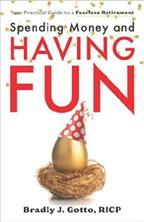
Gotto, Bradly J. Lioncrest Publishing (140 pp.)
$15.99 paper | $6.49 e-book Aug. 10, 2022 978-1-5445-3319-3
A debut personal finance book offers advice for saving for retirement and planning for longevity.
In this guide, youth pastor–turned–financial adviser Gotto counsels readers about the fundamentals of planning for retire ment and the mechanics of spending the accumulated savings after the end of the working years. Although the book opens with the story of a man who was reluctant to take a longed-for trip until the author’s calculations demonstrated that he had already saved enough to support himself for 200 years, the text does not spend much time on the psychology of saving and spending. Instead, it focuses on the practical aspects. The man ual addresses how to minimize tax liability, evaluate the particu lar challenges and opportunities facing widows and widowers, make decisions about collecting Social Security, meet health care needs while aging, match spending to available capital, and incorporate charitable giving into the retirement lifestyle. While Gotto’s target audience is clearly the highest earners (“At Fiat Wealth Management, we work with families who live on six-figure incomes a year in retirement, and they pay no taxes on their Social Security”), even readers who will not be spending $8,000 a month during their retirement can apply the book’s advice at a relevant scale. The writing is clear and straightfor ward, and the author’s advice is sound without becoming overly technical. The chapter on withdrawal rates is particularly well done, explaining the history of the common recommendation to withdraw 4% a year and clearly demonstrating how misjudg ing the rate by a small amount can lead to running out of money. But for the most part, the volume’s tone is upbeat, assuring readers that responsible retirement saving and spending are eminently doable. Readers who are already informed about their retirement options will discover little new information in the manual, but those who are looking for a starting point will find a solid grounding in the basic principles of planning for a secure and fulfilling retirement.
An astute and thorough guide to the fundamentals of retirement finance.
alone

Gunter Seymour, Kari Swallow Press (104 pp.) $17.95 paper | Sept. 27, 2022 978-0-8040-1243-0
Gunter-Seymour’s intricate poetry collection weaves together themes of grief and joy.
This poetry compilation begins in the past with “Vernal Equinox”: “I’ve been thinking about last times / I never knew were the last.” Across five sections, Gunter-Seymour’s works continue to reckon with the past head-on as they tell of childhood in Appalachian Ohio and the experience of being a mother. The poems portray the mosaic of her speakers’ lives, touching on a complex relation ship with a mother, a loved one’s battle with alcohol and drug use, a fierce love of a child, and an insatiable commitment to the possibilities of language. As readers move through the col lection, they will also encounter reflections on current topics, such as Covid-19, police brutality, the opioid epidemic, and others. A wide variety of poetic forms and devices brings a musicality to the poems that underscores both the simplicity and the jaggedness of love, and each section moves fluidly into the next. Beyond that, Gunter-Seymour attaches her speak ers to physical locations through language, offering personal meaning to places such as New York City, Ohio, and Tennes see. Overall, the language is stunning and abrupt, with nug gets of introspection, as in “Rorschach Test”: “Listen—there are things to love / about failure too. Sometimes / we make mistakes, call them coincidence, / trapped like thirsty sponges / between memory and the moment.” Gunter-Seymour doesn’t shy away from discomfort, impressively embracing painful moments and showing how memories define people only as much as they allow them to do so. The collection’s title is a tes tament to the idea that being alone doesn’t mean being with out a sense of place; one can create a home inside of oneself and move forward with “the sense / of something waiting to unfold, / leaving only the wait” (“Weather Report”).
A breathtaking, artful set of poems on loss, family, place, and memory.
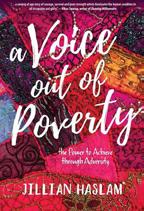
Haslam, Jillian
Top Reads Publishing (236 pp.)
$18.99 paper | $7.99 e-book | Sept. 13, 2022 978-1-970107-23-4
In this memoir, a humanitarian shares her journey from growing up in poverty in India to founding an esteemed charity that helps protect society’s most vulnerable.
Haslam was raised in Kolkata, India, in the 1970s. Her par ents were part of the Anglo-Indian community that remained in the country after the British government withdrew in 1947. The family was homeless for the first six years of the author’s life. Despite her father’s being employed full-time, they could not afford a permanent residence. Haslam became accustomed to squatting or staying in slums, during which time she witnessed the deaths of her twin siblings, who suffered from malnutrition. The author was determined to gain an education, and her first break arrived when she was offered a job with Bank of America, where she later became president of its Charity and Diver sity Network in India. Devoting her life to charitable causes, including the founding of Remedia, a trust that helps educate hundreds of children in India, Haslam was honored with the Mother Teresa Memorial International Award in 2017. This is a deeply affecting, harrowing story that will remain locked in readers’ memories. Haslam’s delicate, descriptive writing style captures even her most distressing moments, including when she recounts how her deceased baby sister was placed in a tea chest rather than a coffin: “My mother began to seal the top of the chest in place—methodically, like an artist, dripping candle wax along the narrow edges.” Always capable of pinpointing emotions, the author elegantly describes how her childhood shaped her later purpose in life: “I had never forgotten how much the small gestures of kindness in my childhood meant to me and what a difference they had made for my family.” Draw ing on her talent as a motivational speaker, Haslam delivers succinct words that have the power to both inspire and offer hope: “Light can come from darkness. My family’s pain is not the entire tale.” The author has lived an extraordinary life—her odyssey, which is skillfully recalled here, will unnerve, move, and inspire readers in equal measure.
A remarkable account that captures the horror of hardship and the power of charity.
young adult
“A variety of poetic forms and devices brings a musicality to the poems that underscores the simplicity and jaggedness of love.”

House, M.D.
Self (354 pp.)
$16.99 paper | $5.99 e-book | June 24, 2022 978-1-08-804706-4
A historical novel focuses on an enig matic figure in the Book of Mormon.
Drawing on two chapters of the Book of Mormon, House puts flesh on the outline of the man known only as “the servant of Helaman.” The servant at one point thwarted an assassination in the kingdom of the Nephites in the first century B.C.E. and killed the evil Kish kumen. The author opens the story on a thrilling note, with Kishkumen approaching a nemesis in the Nephite city of Zara hemla, intent on violence against the “mealy-mouthed, selfrighteous Pahoran the Younger,” who “occupied the judgment seat and continued to press the cause of the greedy, wealthy Christians on the good people who represented the long-suf fering, fair-minded backbone of Nephite success.” This bru tal act caps years of increasing tensions since the Great War between the Nephites and the Lamanites, and it throws Zara hemla into chaos. The ensuing narrative examines the young scout and adventurer Kihoran, called Kai, who gets caught up in the march of armies and the broader events drawn from the Book of Mormon, becoming the servant of Helaman and mov ing inevitably toward his great destiny. House, an experienced historical novelist, overcomes the main obstacle to this tale— the fact that many readers are unfamiliar with the underlying writings being expanded here—very smoothly. The volume’s extensive amounts of exposition are worked organically into the narrative, to the point where those readers who are not members of the Church of Jesus Christ of Latter-day Saints will easily follow the tale and appreciate the drama. This pro cess is helped enormously by the author’s decision to make Kai both fallible and immensely likable, an experienced but hum ble young hero. When Kai is told the spirit of God is clearly helping him, for instance, he privately doubts the clearly part. The result is a very enjoyable foray into fictionalizing the intriguing material in the Book of Mormon, something just begging for more such ventures on the part of House. A richly textured and involving spiritual tale about an unsung hero.
Ippen, Chandra Ghosh
Illus. by Erich Ippen Jr.
Piplo Productions (29 pp.)
$19.95 | $11.95 paper | $4.99 e-book Sept. 1, 2022 978-1-950168-18-7 978-1-950168-17-0 paper
A child and a dog with troubled pasts bond in this picture book. Canine Argo and a young, unnamed human narrator both love playing, running, and cuddling on the couch. They also both lived in many other places before they got together. Argo once resided in an animal shelter, where he was very fright ened until two employees made him feel safe. Although it’s not overtly stated, the child appears to have been in foster care; in one scene, the character is shown as a baby while two faceless adults argue in the background. The text is informative without being scary: “Some people I lived with before had big problems and didn’t always take good care of me.” When Argo chews up a beloved toy, the narrator explodes with anger until his family member (an unnamed adult) talks about the effects of Argo’s past. The child apologizes and the pair make amends: “He feels safe and loved,” the child says. “Just like me.” In less skilled hands, this story could have treacly undertones (or worse, be upsetting to kids), but Chandra Ghosh Ippen’s gentle, acces sible text, paired with Erich Ippen Jr.’s expressive, full-color pen-and-watercolor illustrations, perfectly conveys the trans formative power of patience, kindness, and love for those who’ve experienced trauma. The narrator is depicted as Black; adult characters have varying skin tones.

A touching tale flawlessly told.
Knight, Nolan Down & Out Books (241 pp.) $3.99 e-book | Sept. 26, 2022
A collection of short stories explores the dark corners of city life.
Los Angeles is both the setting and the unifying force behind these 11 tales of crime, false hope, and down-and-out disillusionment. Knight writes primar ily in the third person, past tense, usu ally from multiple viewpoints within each story. This narrative omniscience allows readers to experience events from different perspectives and heightens the effect when lives and choices inexorably come together in an ill-fated concatenation. Such interconnectedness is most evident in “Tip the Barkeep” and “White Horse,” tales in which a murderer and drug dealer take refuge from pursuers who have links to the bars they hole up in, and “Night Windows,” about a patsy framed for a homicide who happens to be known to the investigating officer. Two stories are told in the first person, present tense: “Mouth Bay,” in which a self-centered woman fails to make the life changes that would

render her a fit parent, and “That Dreaded Undertow,” in which a fisherman turns his life around but is dragged back down by his past. These notions—the power of children to inspire reha bilitation and the difficulty of escaping one’s history—form common, contrasting threads throughout the volume, clashing most notably in “Bleeders Abound,” in which a taxi driver trying to make good picks up a fare linked to his gangland past. Knight employs realistic dialogue and an immersive, staccato-style prose that deals directly with life in all its seedy, sordid details. The characters who emerge may be unlikable but are very real and distinctly memorable, from the reclusive, would-be good Samaritan of “Vin Scully Eyes” to the aging party girl of “Full Bloom” and the rehabbed bartender (“I don’t drink”) of “Angels Live Here.” The last two are wistful vignettes of lives gone astray early and never corrected. The first tale is more plot-driven and emphasizes how wrong it is to shut out the world yet how let ting it in can end badly. Indeed, few of these stories have happy endings. The collection’s tales work well together, and Knight’s writing will pull readers in—a kind of literary mugging that will leave them wiser and sadder. Noir enthusiasts will grant their somber approval.
Unapologetically confrontational, grimly poignant; a gritty depiction of LA vice and vicissitude.

Lahn, Busshō
Monkfish Book Publishing (220 pp.) $17.99 paper | $13.49 e-book | Dec. 20, 2022 978-1-948626-78-1
This debut nonfiction book medi tates on the nature of suffering using an 18th-century Buddhist poem.
Hakuin Ekaku was one of the great thinkers of Zen Bud dhism, and his hymn “The Song of Zazen,” composed around 1760, is a poetic encapsulation of his philosophy. “In his day, Hakuin was to Japanese Zen what the Beatles were to rock ’n’ roll in the 1960s,” writes Lahn of the poet. “He was a radi cal reformer, reinvigorating the active practice of Zen, both within the monasteries and among the common folk.” Even so, the ideas contained within the poem are not inherently Buddhist: The author argues that Hakuin’s meditation on suffering and wisdom speaks to people across cultures and faith traditions. With this book, Lahn seeks to bring Hakuin’s poem to that wider audience, demystifying its sometimesenigmatic verses and applying them to his own modern con cerns. As the author explains, the poem “takes away far more than it gives,” helping readers shed the cumbersome ideas and emotions that get in the way of accessing the deeper truth of being. “The Song of Zazen” is not a lengthy poem— the translation by Norman Waddell that Lahn works from is only 43 lines long—but each short stanza is given its own elucidating chapter. The author’s prose is empathetic and
accessible, supplementing Hakuin’s spare lines with relat able analysis. Here, he illustrates Hakuin’s insistence on the necessity of suffering with an example from his own life, when he became reliant on crutches after injuring his foot: “After a while, the nurse told me I could wean off the sup ports and walk freely again despite the pain. Although it was growth and progress, I found myself reluctant to experience the pain of a healing foot as well as go without the nice atten tion and sympathy the crutches and cane brought me.” It’s an unexpectedly breezy work, and Lahn is correct that one need not be a Buddhist to appreciate the simple, if unintui tive, wisdom that Hakuin and his poem offer.
A thoughtful exploration of pain and truth.
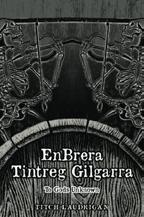
Laudrigan, Titch
Gatekeeper Press (492 pp.)
$19.99 paper | $4.99 e-book | Nov. 3, 2021 978-1-66291-840-7
A troubled Vietnam veteran wrestles with his past in Laudrigan’s second fic tionalized memoir.
Titch, who shares a name with the author, loves bacon, Scotch, and the 1945 John Steinbeck novel Cannery Row. He grew up in an abu sive home and became a “youth scarred with hate and anger.” While serving the U.S. military during the Vietnam War, he cultivated a talent for violence. Afterward, the Army asked him to remain enlisted, but he refused because he felt that there were no worthy wars to fight. Instead, Titch placed large sums of inherited money in various bank accounts, including one offshore. He planned to become a killer for hire, using major city newspapers to communicate with clients. But now, after taking his final leave of the Monterey, California, Army base, Titch notices someone following him as he heads for his warehouse apartment. Later, a lethal confrontation with men claiming to be FBI agents sends him fleeing to a hideout that he once knew as a teen in the mountains of New Mexico. In his subterranean mountain lair, Titch takes stock of his diffi cult life through journal writing. He poses as an archaeologist when touring New Mexico and uses his soldierly knowledge to prepare for the worst in his compound. Laudrigan’s har rowing two-part saga unfurls at a meticulous, sinister pace. The tension of jungle warfare bleeds into the prose, resulting in blunt but poetic depictions. Of one friend, for example, Titch writes that he could see that “the lights of sanity...were slowly dimming.” The main character admits to a “tendency to drift” in the narrative, and, indeed, readers may need to find patience with its copious flashbacks and occasionally over stuffed sentences (“Outwardly surprised, not expecting this change in routine venue, the lead trainer nodded nonplussed”). There’s also hardly any dialogue; instead, readers will find long reams of exposition reminiscent of H.P. Lovecraft’s Gothic style. Ultimately, though, Laudrigan delivers a chilling period
“Laudrigan delivers a chilling period piece that successfully encapsulates the frustration, trauma, and paranoia of the Vietnam era.”
piece that successfully encapsulates the frustration, trauma, and paranoia of the Vietnam era.
An effectively disturbing tale that will transport readers to a dark time in American history.

Maddison, Christian D. Self (168 pp.) $24.99 | $9.99 e-book | Aug. 19, 2022 979-8-8459-9213-0
Women enjoy rapturous sex—or grow cantankerous when they don’t get it—in these erotic stories.
Maddison’s tales center on single women in the Atlanta metropolitan area who seem to share a taste for a particular type of man—tall, muscular yet “thyck,” bald, bearded, great at cooking, and who enjoy scented candles and rose petals. They include a woman named Chris in “The Trucker,” who encounters attractive truck driver Marcus at a Walmart and soon has sex with him in the bunk bed of his rig; Bronwyn in “Mr. X,” who hooks up with a man she meets online and then dumps him when he reveals he videotaped their pas sionate sex; and a nameless woman in “The Barber” who dates gentlemanly barber Spike for months before they get around to volcanic lovemaking. Less satisfied is Lyric in “The Musician,” who’s dazzled by Thaddeus, a well-heeled young dreamboat who lights so many candles that she’s “surprised the house hasn’t caught fire,” but finds him a clumsy lover. One tale, “The Prin cipal,” features KiKi, a high school junior and self-described “ultimate bad girl” who enrages the principal Mr. Mosley with her scandalous attire and is delighted when he subjects her to carnal “punishment” in a soundproofed chamber adjoining his office. Maddison’s stories feature cheerful narrators who know what they want and pursue it avidly. The formulaic plots effi ciently usher the characters into sexual adventures amid flirty banter full of double-entendres. The sex scenes feature lav ish similes and metaphors that are imaginative, if not always entirely coherent: “He latched onto my wetlands as though it were the Sahara Desert, and he was a thirsty traveler….Thrust ing his leviathan into my catacomb in search of a song no other has ever heard before.” Readers who enjoy stories with a tone of flowery tawdriness will not be disappointed.
A vigorous, if sometimes inelegantly written, collection of soft-core romps.
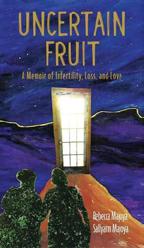
Majoya, Rebecca & Sallyann Majoya Rootstock Publishing (218 pp.) $27.99 | $18.99 paper | Sept. 20, 2022 978-1-57869-098-5 978-1-57869-097-8 paper
A lesbian couple describe the pitfalls of trying to adopt a child in this debut memoir.
Vermont, 2014. The Majoyas were already raising two boys: Rebecca’s sons from a previous marriage. They would have loved to have one more baby together as a couple, but after eight years of under going fertility treatments and being on adoption wait lists, they started to wonder if maybe it was time to abandon that dream. Then they got a call from a teacher friend at the local high school: There was a 17-year-old student who was pregnant and looking to give the baby up for adoption. The Majoyas had their doubts about Delilah—how sure she was about giving up the infant, the product of a rape; how well she had been taking care of herself during the pregnancy—but the couple quickly agreed to adopt the child. Two weeks later, a boy, Sage, was born. The Majoyas were thrilled; Delilah didn’t want to look at him, but her mother—always against the adoption—insisted on getting to hold him. Then, a few days later, as they settled into their life with their new son, the couple received the call they had been dreading: Delilah wanted the baby back. As the Majoyas’ odys sey with Delilah and Sage unfolds, flashback chapters about the authors’ history as a couple and their attempts to grow their family provide context for this dramatic, final effort. The Majoyas take turns narrating the memoir, alternating by chap ter. The dual perspective helps to fill out their personal jour neys, particularly Sallyann’s desire to raise a child from birth. When Sallyann marveled at how small the newborn Sage was, Rebecca teased, “Of course he is. You just forgot how little the boys were.” Sallyann responded, “No, actually, they were never this little when I saw them, when I held them in my arms.” The book grapples with complex emotions in a candid manner, and it raises intriguing questions about how and when someone becomes a mother.
A well-told story of heartbreaking near misses, second chances, and new beginnings.
Manning, J.B. Encircle Publications (600 pp.) Nov. 16, 2022
A satirical skewering of the machi nations of a despicable fictional Ameri can president.
Vermont-based author Manning exhib its a well-honed sense of the absurd in a silly but humorously absorbing debut. Wilhelm “Hick” Richter is the current American president, a double-chinned, Trump-esque, coke-snorting scoundrel his 13-year-old son, Billy, describes as “mean as a gutter rat” with a dyed comb-over and nefarious ties to corrupt international entities. Disgruntled with his young wife, Savanna, and their newborn baby, Richter contin ues to maintain nefarious ties to corrupt international entities while Georgina, one of his daughters, runs his sketchy compa nies. Cody, another daughter, snoops around and uncovers her father’s corruption and alerts the FBI. She is kidnapped and drugged by someone hoping to make her accept her father’s innocence by, among other things, forgetting some incriminat ing evidence surrounding her mother’s death. Cody’s brother Billy, who himself has bugged the Oval Office, is determined to swoop in, save her, and have his father implicated. Add to the cast Richter’s chief of staff Baron “Bugsy” Knowles and a host of unscrupulous druggy hoodlums, and you’ve got a serpen tine stew of dirty politics. There’s also the smart, young Jeremy Green, who plans to hijack Richter’s reelection plans with his own campaign. Richter enters into a deal with a Russian ambas sador named Boris to reveal secrets about a robotic prototype in exchange for help securing his reelection. Cody narrowly escapes her captors and goes on the run, while Richter’s legions of “Hick Brigades” crisscross the nation inciting violence and discord in honor of their philandering leader. Manning lays the head-spinningly satirical groundwork for all of these eerily familiar antics with the ease of a seasoned comedian. If it all sounds insanely zany, it is, yet Manning’s imagination, ambi tious plotting, and comic timing are impeccable, and the out right corruption is hilarious. The hijinks steamroll common sense toward the conclusion, when the parade of bumbling idi ots makes one final plan to dispose of poor abused Cody. This is a brilliantly conceived parody.

A sprawling, cleverly imagined spoof of political culture and the miscreants it spawns.
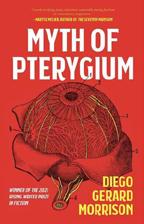
Morrison, Diego Gerard
Autumn House Press (136 pp.)
$16.95 paper | $12.49 e-book March 22, 2022 978-1-63768-029-2
In this novel, an aspiring poet with eyesight problems, a baby on the way, and a dark family legacy struggles in Mexico City.
At first, it seems as if the unnamed narrator has a perfectly benign, if annoying, eye condition. He is told that it’s pterygium (and likely caused by the ever growing pollution problem in Mexico City), given eye drops, and sent home. There, he faces his dwindling editing career, his ambi tions to be a poet, and a very pregnant wife on maternity leave from her urban planning job. But just as his eye worsens, so does his financial condition, and the pressures of upcoming parent hood lead him to break a lifetime commitment to avoid his shameful family’s weapons-dealing business. He ends up asking his relatives for a job. And this is where a seemingly contained, small slice-of-life story about a frustrated poet and his pregnant wife unveils its hidden depths. The narrator—sometimes called Arthur due to his similarities to poet-turned–arms dealer Arthur Rimbaud—feels his eyesight diminishing and the walls clos ing in on him. (“The news on TV can best be described as the bastard child of current events and slasher films….The gunfire on the screen makes me wonder if my mother’s gun enterprise is feeding all this drug violence.”) He suffers the humiliation of asking a favor from his abrasive brother, going back to the abhorrent family enterprise, and becoming a part of a vicious, corrupt cycle of destruction that affects a decaying society. His other problems range from the worries of bringing a child into this collapsing world to the misfortunes of editing the prose of a terrible writer. This all builds up to a finale that is a skillful blend of the micro and the macro—the idiosyncrasies of one person’s life and the magnitude of a country’s future. The short novel offers succinct chapters—sometimes just a few lines—in which every word is not only meaningful, but also carefully cho sen to smartly match its main character’s status as an editor, a lover of language, and a failed poet. And amid all of the devas tation, Morrison manages to deftly weave threads of optimism into the bleak claustrophobia of his story.
A well-crafted tale of despair and hope.
“Manning’s imagination, ambitious plotting, and comic timing are impeccable.”
richter the mighty
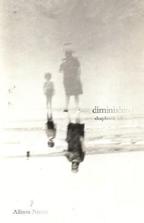
Nicole, Allison
Poetically Grey (48 pp.)
$11.99 paper | $7.00 e-book | Sept. 13, 2022 979-8-9864289-0-1
A poet attempts to capture the trials of dementia in this volume.
For centuries, poets have used form to shape how their readers interpret and ingest a poem’s content. In her chapbook’s foreword, Nicole says that this work is “meant to be experienced more than read,” with a warning that the rep etition and the clinging to stories obfuscated by disease may get “annoying.” She cites her grandmother as an influence, but she’s not the chapbook’s speaker; rather, any woman becoming a “passive character within their own life” will see themselves reflected. The first page thrums with self-flagellation, synaptic chaos, and frustration at the depths of the past now beyond reach. There is power in morbid statements like “I can’t find you anymore in my heart,” “the brain digests the self,” and “I sit numb in my unceremonious tomb.” As an experience, Nicole’s volume invokes an acute disorientation. It’s unclear if this is a collection of poems or one continuous work; there are no titles, no table of contents, and, at times, no legibility. The stanzas appear to layer upon themselves like mismatched plates, often fading in and out like printers running out of ink. Nicole also uses ample blank space, as many pages contain just a handful of lines. The lines that survive are clipped and largely crisp, with some stale interlopers (“You are a ghost to me…but then I’m also a ghost to you”). Like the sharp cut of a film scene transi tion, the work’s penultimate page states, in an italicized depar ture from the rest, “Dementia is a terminal illness / you will likely not die from it,” followed by a paragraph of soliloquy. Dementia is largely described as the atrophy of neurons and their connec tions, but, as Nicole points out, “it will not have the pleasure of adorning your death certificate.” People do not die of dementia, but they regress beyond dignity into a prison of unknowing.
A haunting, thought-provoking exploration of a person’s relationship to memory.
Riccards, Patrick Amazon Pro Hub (186 pp.) $15.48 | $9.99 paper | $5.50 e-book Dec. 21, 2021 978-1-956406-99-3 978-1-956406-98-6 paper
A father recounts how he became his daughter’s cheerleading coach in this memoir.

Until his 8-year-old daughter, Anna, became interested in cheerleading, Riccards admits to having “zero experience” in the sport. Anna had struggled to maintain
interest in the previous sports she pursued—horseback riding, taekwondo, and soccer—and at first the author and his wife, Jennifer, dismissed the cheerleading idea as a passing fancy. But as Anna began to take the sport seriously and moved up from the “younger, less intense, Mighty Mite squad” to the Junior Pee Wee squad, Riccards also became increasingly involved in team activities. When a family wedding took Jennifer away for the weekend, he became the designated “cheer mom.” It was “no big thing” for him to attend a “curling party,” where the girls had their hair styled in preparation for a competition, despite being the only man among the mothers and daughters. When Anna decided that she was done with her team, the Wildcats, her one condition for returning was that her dad become an assistant coach. Riccards describes a rewarding process that began with the mandatory Youth Cheer and Dance Association coach training and the Centers for Disease Control and Preven tion concussion training. He also discusses his awkwardness as a man regarding the issues of physical contact with the girls. The book recalls how the author overcame his insecurities to become a competent, supportive coach—“a cheerleader for the cheerleaders.” He recounts the rewards of watching the team improve and grow, helping the Wildcats take first place at the Central Jersey competition, win second place at the Globals, and secure eighth at the Nationals.
Riccards’ memoir is written in a fluid, openly conversa tional style that makes for an easy read: “We assumed that with the end of the year, she would have had enough of cheerleading, and it would be time to move on to something new. Boy, were we wrong!” The account bursts with enthusiasm and will make readers beam with admiration: “There I was, in a sea of cheer moms, wearing my Wildcats Cheer t-shirt, a pair of tiger ears, and a fluffy orange tutu. Cheering on our squad.” Neverthe less, the author is unafraid to address issues regarding gender stereotyping: “It is often (not always!) easier for men to accept a woman knowledgeable about football than for men or women to accept another man spending their time doing choreography or such with female athletes.” He asks readers to reassess how they perceive the roles of men and women in sports coaching roles. Riccards is also aware of key social developments, com menting how the #MeToo movement emphasized the impor tance of never being alone with a young athlete to protect both parties and build trust. The author repeats himself on occasion, as when emphasizing that he looked more like “a dad who plays football.” This does not detract from a forward-thinking mem oir that encourages fathers to support their daughters even in areas where they may feel out of place. Riccards writes: “I wear the label ‘boy cheer coach’ with immense pride.” Perhaps more men will do so in the future.
Courageously upbeat writing in a frank, inspirational sports account that supports change.

Total Human Publications (282 pp.)
$17.99 paper | $9.99 e-book | Jan. 3, 2023 978-0-9821855-4-4
A road trip takes three siblings through their mother’s eye-opening past in this novel.
Chicago bartender Jesse Chasen is not at all like her older sister, Jennifer McMahon. An upper-middle-class wife and mother of two, Jennifer only hears from Jesse when she needs money. But the sisters head to Florida together after getting the news that their birth mother has died. Shockingly, the parents they lost in a car accident five years ago were actu ally their aunt and uncle. Their mom, Angie, left an inheri tance clocking in at $1.2 million. But they’ll only collect it if they take an all-expenses-paid journey across the Southern United States to learn about Angie. This includes picking up a heretofore unknown brother and drag performer, Jack Babi neaux, in New Orleans. All three siblings resent their mother for abandoning them as kids. But meeting people from Angie’s life shows them another side of the woman they never knew. As they bicker and periodically run into trouble, the “three J’s” slowly start to understand one another as well as them selves. Although it steps into grim territory, Rice’s tale pro vides ample comedy. The siblings’ arguments, for example, are often funny and teem with Jesse’s unfiltered dialogue. Jesse isn’t the most likable protagonist, as the million-dollar pay out seemingly drives her. Her surprising backstory will never theless enlighten readers, which is also the case with Jack as well as Angie, whose unhappy teenage years will garner read ers’ sympathy. The tale consistently moves to different states and cities, aptly boosting momentum. Characters, meanwhile, bond in fun, unexpected ways, especially Jesse and Jack and even Jack and Sean, Jesse’s bouncy puppy who’s “part Golden Retriever and part Beanie Baby.” Unfortunately, though the end of Rice’s story ties up everything satisfactorily, readers will find one final reveal both unconvincing and distracting. This breezy, charming tale incisively shows a family’s bit tersweet facets.
Richey, Drew & Shawn Perry
Houndstooth Press (90 pp.)
$15.99 | $9.99 paper | $6.49 e-book
July 5, 2022 978-1-5445-2752-9 978-1-5445-2751-2 paper
In this compact self-help book, two financial advisers demystify the financial service industry.

Richey and Perry, who run a wealth management firm, open their book by pitching their services and listing the rea sons people look for financial advice. These range from the traumatic, such as the death of a family member, to the cele bratory, like getting a big raise. Based on the core belief that “A financial advisor should primarily be, throughout all stages of your engagement, your Financial Advocate,” the book asserts that it was “written in the spirit of advocating for individu als and families seeking financial advice and assistance with their financial goals, dreams, and needs.” The chapters that follow contain simple explanations of investment strategies, a section on who not to choose as a financial adviser, a list of services that should be offered by reputable financial advis ers, and a guide for interviewing advisers in order to evalu ate which is best suited to the individual’s needs. A helpful explanation of typical fee structures notes, “It is most impor tant to make sure that how you pay your wealth-management team is entirely transparent and aligns with your goals.” The authors promote their firm throughout the guide (“We have strategically built our team over three decades to serve the complex needs that investors face today”), but this doesn’t undermine their informed advice. The prose is accessible, and Richey and Perry make a convincing case that financial advice can grow and protect wealth, even for those without a large investment portfolio. Without investing hours of study or wading through jargon, readers are likely to emerge from reading this book with a better understanding of whom to hire to manage their money. Additional resources are avail able on the book’s website.
A concise, effective guide to finding the right financial adviser.
young adult
“Richey and Perry make a convincing case that financial advice can grow and protect wealth.”
Samuels, Jamiyl & Tracy Ann Samuels
Illus. by iNDOS Studio T.A.S.K. Media (72 pp.)
$19.95 | July 12, 2022 979-8-218-01930-3
A boy with autism visits the dentist while his imaginary counterpart battles monsters that cause tooth decay in a pic ture book about good dental hygiene.

In the latest entry in the Amazingly Awesome Amani series, Amani stays up eating snacks in bed, and his mother scolds him and says he’ll ruin his teeth. She warns, “Make sure you brush your teeth….You don’t want the molar monsters to get you.” That night, Amani dreams that shadowy molar monsters, led by one wearing a crown, have come to take over his teeth. He wakes up just in time, fiercely brushing his teeth with his moth er’s help before his dental appointment. At the dentist, Amani and his sister, Sandy, meet Dr. Kersch, who understands that Amani needs some extra coaching after his mother explains he has autism. Dr. Kersch knows just what to do, showing Amani all her tools and letting him look into his mother’s mouth before it’s his turn. Back at home, Amani imagines himself as the super powered Awesome Amani; even with his powers, the molar monsters are almost too much, until Super Sandy appears to save the day with mouthwash. The New York–based co-authors do an excellent job of casting Amani as a hero who learns about keeping his teeth clean in order to defeat monsters; although others help him, he handles his fears independently, becoming a hero on his own. Dr. Kersch’s patient approach, focusing on clarity, setting expectations, and navigating Amani’s sensory sensitivities may comfort children afraid of visiting the den tist for the first time. As depicted in cartoonlike illustrations by iNDOS Studio, Amani’s family members all have the same brown skin tone but different shades of hair; Dr. Kersch is paleskinned with dark blond hair. The writing is clunky, with tenses that shift back and forth from the present to the past, a device that may confuse independent readers. Those shifts weaken an otherwise strong message of what a visit to the dentist is like and the benefits of good tooth care.
Awkward writing takes a toll on a clever and sensitively handled premise.
Schrauben, Cindy Williams
Illus. by Julia Seal
Cardinal Rule Press (32 pp.)
$16.95 | April 1, 2022 978-1-73534-513-0
Careers and the qualities they repre sent are explored in this debut picture book’s take on the tradi tional question “What will you be when you grow up?”
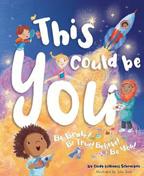
On each page of this work, children are encouraged to envi sion their futures as filled with endless possibilities. In each of the rhythmic stanzas, the narrator repeats the final word in the first three lines (for example, dreams on the opening page) and asks who might embody the actions or qualities mentioned. Then the narrator follows with a command (“Believe,” “Blast off,” “Create”) and the phrase “It could be you!” The second line in most stanzas offers a job title: astronaut, artist, athlete, trucker, and more. But while the various careers will interest young readers, the key features of those occupations—their qualities of resilience and creativity—should capture their imaginations (“Who has keen-design flair, / an artist’s time-toshine flair, / a sketch-and-then-refine flair? / Create. It could be you!”). Schrauben’s firm beat and repeated phrases allow young lap readers to chime in with adults reading aloud. Veteran illustrator Seal’s soft-edged, cartoonish paintings show a diverse group of children and adults interacting in natural and urban environments. Inclusivity is emphasized throughout, especially on the athlete page, which depicts a wheelchair race. By look ing at the careers’ positive traits and phrasing the rhymes to support a “growth mindset” and flexible thinking, the author breathes fresh life into a familiar theme.
An inventive and empowering read-aloud about careers that should inspire preschoolers.

Shanks’ debut mystery, set during the so-called secret war in Laos, melds love and war stories in a novel with a plot as tangled as the jungles that provide a backdrop.
Just out of flight school in America, Andy Harris can’t believe his luck when Operation Pegasus, based in Udon, Thai land, is willing to give him a shot as a pilot for a U.S. Army combat helicopter, flying sorties over the border into Laos. The assistant chief pilot, Maj. John Pike, a legend in the outfit, is skeptical, but the newcomer’s skills win Pike over, and he becomes Andy’s mentor. On his second day at work, Andy meets and falls in love with the beautiful Fon Wattana, a young Thai woman. But she is engaged to Nate O’Riley. Although older than the others, middle-aged
Nate is tolerated by his mates because of his unquestioned brav ery and flying skills. At one point, Fon is willing to break the engagement to Nate, but her fiance had saved Andy’s life, so he balks at the offer. Years later, Pike—alcoholic, half-demented— finally lays bare the truth about a tragedy revealed in the first pages that had gnawed the crew at every yearly reunion: Some one had gunned down Nate and Fon on their wedding day, but why? As the story toggles between the events of the early 1970s and Andy’s return to Thailand 20 years later, it’s hard to believe that this is Shanks’ debut novel. He says he worked on it for more years than he cares to admit, and it shows in the best way. Clearly Shanks knows his subject. He goes into minute details of flying a helicopter, and battle scenes are hairy and scary. He also shows what war can do to gung-ho warriors. In one appall ing scene, the crew of Andy’s helicopter makes sport of a mor tally wounded Viet Cong down below, as if they are playing an arcade game. Andy is repulsed by the madness. “Patriotism” gets a rough workout here.
A vividly written work of fiction shows the enduring effects of the war in Southeast Asia on its characters.
Shao, Bonnie Self (335 pp.)
$12.99 paper | $6.99 e-book | April 30, 2021 979-8-7428-5522-4
Unexpected friendships help a tween reclaim her creativity in this middle-grade novel set in contemporary Shanghai.

Tackling sixth grade math and living up to parental academic expectations are bad enough, but for almost-12-year-old Xu Haiqing, there are worse problems. She feels estranged from her best friend, Xia Luolan, who left Shang hai to move with her family to Massachusetts. And the tween feels sad and guilty that since her beloved Laoye (grandfather), a master Chinese calligrapher, died, she has not practiced the art herself. Movingly, calligraphy had been a bond between them from the time she picked up a brush at age 3. When Haiqing is encouraged by friends to attend a Chinese calligraphy class, her parents say no. Making art has no place on the path her careerdriven mother has mapped out for her daughter’s academic and corporate success. How can Haiqing reclaim “the person I was two years ago and make Laoye proud”? This energetic and relat able first-person narrative is written with an observant eye for time and place in the everyday life of a Chinese tween wrestling with peer relationships, strict parents, dictatorial teachers, aca demic pressures, and dreams and challenges that seem hopeless. The deft narrative weave does loosen somewhat when portray ing Haiqing’s efforts to help a young violinist with stage fright. Intended to propel Haiqing to find her own confidence and her way back to her art—and to mend her friendship with Luolan— this overly involved subplot (secret meetings, eavesdropping, text exchanges, a hidden recording attempt) takes center stage
for too long. It’s difficult, too, to attribute sincerity to the insti gator of these clandestine meetings and actions, a boy who stabs classmates’ arms with a freshly sharpened pencil as a joke. But despite these missteps, Shao knows whereof she writes. She’s a middle schooler and, like Luolan, a transplant from Shanghai to Massachusetts. The author’s first novel, The Xia Stories: Once in a Lifetime (2019), about Luolan adjusting to life in the United States, was published when she was 10. A sprinkling of Manda rin words is explained in the text and in a glossary.
A lively, engaging tale with relatable tween concerns and themes of friendship and self-worth.
Siem, Brooke Central Recovery Press (256 pp.) $18.99 | $14.49 e-book | Sept. 6, 2022 978-1-949481-70-9
In this memoir, a woman recounts her attempt to live without the antide pressants she relied on for 15 years.
When Siem was a teenager, her father died suddenly, an emotionally catastrophic event that left her dizzied by depression and thoughts of suicide. At the age of 15, she was treated with a powerful cocktail of drugs that included antidepressants, a pre scription she would accept until she turned 30. At that point, she had been profoundly medicated for half her life—and the entirety of her adult existence—and yet she still suffered from a deep hopelessness. The author decided to try life without medication and emancipate herself from the “hazy world of antidepressants” against the wishes of her doctor, who unfor tunately advised her to make the break cold turkey. Siem not only experienced severe physical withdrawal, but also a terrible emotional fallout, including thoughts of rage and violence. She was compelled to fretfully wonder if it was too little too late, an anxiety poignantly conveyed: “What if the soul is too shattered to scrub? If, over the years, it disintegrates layer by layer until there is nothing left? What then? How do karma or crystals or compassion cleanse something that no longer exists? People always talk about how antidepressants flatten a person, how they push the issues down and dull it away. But people are wrong. I was never numb. I was simply not here.” Siem’s remembrance is as powerfully affecting as it is thoughtful. She relates both the ways in which she became hypersensitive to the clamorous world around her after renouncing the antidepressants—“the drugs were like earmuffs”—but also came to know the summit of euphoria. The author realized, with unflinching clarity, that the drugs were intended for her teenage self, and had become a principal obstacle to her emotional growth. She combines a courageously confessional forthrightness with an impressive intellectual appraisal.
An important, timely, and intelligently rendered recollec tion about quitting antidepressants.

“Siem combines a confessional forthrightness with an impressive intellectual appraisal.”

Spencer, Tricia
Lilac Bloom Press (304 pp.)
$22.95 paper | $2.99 e-book | Oct. 6, 2020 978-0-9715098-1-8
A whimsical collection of vintage dog photos and text showing their invented thoughts.
“This book is a glimpse of Americana as imagined in a dog’s mind,” Spencer writes. “This book is a smile, a laugh, or a pang of loving remembrance at the end of a hard day.” The worst part of having dogs, she notes in a sentiment that dog owners will universally second, is losing them: They die long before we do. Her notion was to imagine all the wit and wisdom those longdeparted dogs might impart, which is here conveyed in dozens and dozens of smile-inducing black-and-white photos of dogs from a century ago to the present day. These pictures are the highlight of the book; they must have been an enormous labor of love to assemble, and that work has paid off. They include adorable and hilarious photos of dogs being best friends, relentless snack-poachers, and acrobatic goofballs in every cir cumstance imaginable, all with lighthearted, sometimes silly, accompanying text. A photo of a beautiful pointer climbing a fence elicits: “I’m not escaping. I’m eloping! Don’t worry, Baby cakes. I’m on my way,” for instance, and a shot of a small dog buried in the fur of a larger dog is the subject of a short poem (one struggles not to call it doggerel): “I’m just a little guy who really needs his naps / But beds are cold and lonely, with silly chilly gaps.” The book is broken into nominal sections—more dog poetry, dogs in advertising, doggie wisdom, and so on—and Spencer is a cheery, cheesy presence throughout, intentionally stressing the silly and happy sides of her subject in ways that will be immediately identifiable and charming to the dog people who are her obvious target audience. “No one understands your feelings better than the dog who loves you,” she writes—and amply illustrates.
A charming and funny roundup of pictures of dogs and what might have been going through their minds.

Ed. by Stawowy, Margaret & Jim Cokas Shanti Arts (196 pp.)
$18.95 paper | Oct. 11, 2022 978-1-956056-40-2
An anthology of poems by profes sional and family caregivers of people with dementia and Alzheimer’s disease.
Editors Stawowy and Cokas have personal experience caring for loved ones with cognitive
impairments. In a foreword, Stawowy expresses the editors’ wish that they had access to related poetry to guide them through “difficult days of change and coping,” so they curated this poetry collection by fellow caregivers to help readers in similar situations. She notes that caregiving “forces us to give up the luxury of viewing death and decline as an abstract con cept and…brings us face-to-face with its inevitability in a way that intellectualizing never can.” The poems here aim to reflect that process by taking readers through the various stages of Alzheimer’s disease and their subsequent effects on caregivers. It’s divided into seven sections, beginning with poems about the early days of the disease (“Evening Gray”) before moving into later stages involving nursing homes and, eventually, death (“Salvage” and “Salt”). These poems are harrowingly honest, and sometimes brutal, in how they illuminate the realities of caregivers’ lives. In Felicia Mitchell’s “My Cheating Heart,” the speaker says, “Sometimes, if she’s not all that very wet, / … / I check my mother out of her nursing home / without changing a thing.” The courage of these poets to discuss these difficult, painful topics is admirable, resulting in a touching reading expe rience. Additionally, the collection’s fluid structure succeeds in highlighting diverse aspects of caregiving, including small, seemingly mundane moments that later loom large in caregiv ers’ memories. Stawowy and Cokas have produced an anthology of poems that honors caregiving work with compassion, just as flowers “move us / beyond the moment / of failed memory / into the present” in Barbara Hill’s “Hyacinths.”
An affecting and expertly arranged set of poetic works.

Tall, Jennifer Self (500 pp.) $12.00 paper | $3.99 e-book | June 3, 2022 979-8-8339-7986-0
Mysterious radio broadcasts from the past are among the spooky goings-on roiling a corner of the Missouri Ozarks in this fantasy.
Tall’s novel centers on KSR, a pirate radio station whose Saturday-night broadcasts in the vicinity of Joplin, Missouri, feature uncan nily accurate present-day weather forecasts, hit-parade songs, St. Louis Cardinals games from the 1960s, sermons of the long-dead Rev. Franklin L. Hewitt from the 1930s, and “air traffic control for a mysterious WWII airfield.” Federal agen cies have tried and failed to locate and silence the station, whose signal seems to emanate from an area called the Spirit Valley, which includes an abandoned airstrip, the village of West Bobcat, a rain tank that amplifies a disembodied voice, a creepy forest, and invisible spirit beings known as Nunnehi in Cherokee legend. Tall’s narrative wanders back and forth over decades, telling the loosely integrated stories of charac ters around the Spirit Valley. They include Charles J. Howell, a Cherokee man who has visions of a spectral old man; his buddy E.J., who hires on a slate of untalented local musicians
mac’s big wish
to scare tourists from his diner; Jake, a government paranor mal investigator; Sylvie T., a teenage mind reader; Merlie, an unhoused woman in New York City who picks up KSR on her radio and is drawn to West Bobcat; and even a rooster. Tall’s yarn enfolds readers in a world of magical realism where super natural occurrences and astral adventures are a prosaic part of life; one plangent arc follows the Rev. Franklin’s ghostly wan derings after his death in 1934, complete with socially awk ward encounters with the living. Tall’s writing features colorful characters who stay grounded amid the supernaturalism and sly humor and prose whose deadpan matter-of-factness shades into poetry: “The ghosts were crazy in a big city. They paced overhead across long hallways; they lurked in laundry rooms and cried ‘Help me!’ They stared through walls and knew what you were doing.” The result is a fun tall tale that’s also a reso nant meditation on the magic of an iconic American landscape.
A beguiling fable that’s full of rich whimsy with a thought ful bite.
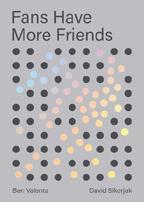
Valenta, Ben & David Sikorjak
Silicon Valley Press (200 pp.)
$21.99 paper | $8.99 e-book | Oct. 25, 2022 979-8-9858428-1-4
A Fox Sports executive and the founder of a consulting firm explore the social value of fandom in this nonfiction book.
Chicago Cubs season ticket holder
Nick Camfield’s fandom “runs at least three generations deep,” and every trip to Wrigley Field “transports” him back to his childhood experience of watching games with his father. In conduct ing interviews with the Cubs enthusiast and others for this well-researched work, Valenta and Sikorjak came across doz ens of individuals like Camfield whose emotional well-being and favorite memories revolved around sports—from Little League coaches and fantasy football leaguers to local fan club members and season ticket holders. In addition to anecdotal oral histories, the authors (self-described data geeks) convinc ingly deploy a host of statistical data to back their argument that not only do sports fans “have more friends,” they also “exhibit stronger measures of wellbeing, happiness, confidence, and optimism than non-fans.” Not only does fandom bring families closer together, the volume argues, but it is also an essential tool—for instance, it is used by immigrants to find a welcome home in new cities or countries. And as much as rivalry is central to the world of sports, fandom, the book con tends, can actually “soften the hardened boundaries between ‘us’ and ‘them.’ ” Valenta, the senior vice president of strat egy and analytics for Fox Sports, and Sikorjak, the founder of an analytics consulting firm and a former executive with Madison Square Garden, combine their career insights into American sports with a firm grasp of data-driven analysis that is accompanied by a network of scholarly endnotes. At times their prose can revel in the sappy nostalgia of sports history,
which may alienate more objective sociologists while gripping the average fan. Still, their writing effectively blends keen storytelling with erudite statistical analysis that will appeal to both scholars of human behavior and lifelong sports enthu siasts. The book’s readability is enhanced by an ample use of full-color charts, graphics, diagrams, and other visual aids that support its overall message that the value of sports goes far beyond its mere entertainment value, as its “social power” has the potential to “heal an ailing world.”
A convincing case for the societal benefits of sports fandom.

Vanderwall, Peter Illus. by Janis Lillian Luminare Press (48 pp.) $24.95 | $14.95 paper | $6.99 e-book June 7, 2022 978-1-64388-389-2 978-1-64388-388-5 paper
A dog learns that each pup is special in their own way in Vanderwall’s debut picture book.
Mac is sure he’ll be adopted from Puddleton’s Pet Rescue, as Mr. Puddleton puts him in the front window where he’ll be seen by everyone. Roxy, a parrot, introduces him to an older woman, Emma, who wishes she could adopt Mac. A hunter adopts Sandy, a yellow Labrador, and a dog-show competitor chooses poodle Precious. Two runners choose greyhound Dash to be their racing partner. Mac doesn’t have the talents those dogs have, and soon, Mr. Puddleton puts new puppies in the window, making Mac fear that he’ll never find a home. Later, however, Mac realizes he’s great at being a good friend. Vander wall builds the story well for newly independent readers, with simply structured sentences, repeated phrases, and fun sound words (squish-squash-squish, click-clack, squeak-squeak-squeaking). Emma’s visits to the rescue center each day will cause readers to be concerned, like Mac, when she stops coming in and to celebrate their reunion. Illustrator Lillian’s two-page spread of this event is also joyful. The painterly cartoon style allows for humanlike expressions on otherwise realistically portrayed ani mals’ faces, and the diverse cast of humans of varying skin tones, shapes, and ages is a delight.
A fine book for dog lovers featuring a strong lesson about the value of friendship.
“The diverse cast of humans of varying skin tones, shapes, and ages is a delight.”

Vitale, Daniel Strïj Publishing (361 pp.) $8.99 e-book | Nov. 15, 2022
In Vitale’s debut SF novel set in an ecologically ravaged future California, a 12-year-old boy begins to realize his privi leged status has blinded him to cruelties in his community.
It’s 2088, decades after a series of mid-21st-century natural disasters known as the Evanescence, which was fueled, in part, by government-directed fracking. This displaced the heartland population, and more refugees came from coastal cities ravaged by earthquakes and flooding. Conflicts between various groups, including Christian funda mentalists and radical environmental activists, finally brought down society. In its place arose WORLD (or Worldwide Objec tive: Restoration Longevity Dominion), an authoritarian pro gram led by a shadowy billionaire. Habitable communities known as “Parts” are strictly regimented to maximize efficiency and rehabilitation. Canland, located at the former site of Cali fornia’s Manzanar internment camp, is supposedly one of the better Parts, practicing desert reclamation and low-impact living—but it’s also the site of suicides and rampant substance abuse. Tristan Weekes, born without the ability to feel pain, has been used by his father, a WORLD scientist, as an experimental test subject. His mother leads Canland’s propaganda programs,
and his brother, Dylan, is a criminal hacker trying to locate their father, who has been away for over a year. Over the course of the novel, Tristan (who narrates largely via journaling) begins to comprehend the serpents in Canland’s Eden. He exists in a state of limited emotion, exhibiting moments of borderline genius; however, because he has no physical discomfort or fear to deepen his outlook, readers will find him a distorted lens through which to view Vitale’s fictional world. Cautionary nov els in the SF subgenre known as cli-fi are numerous, piling on details of disaster and woe. However, Vitale unusually focuses on the psychology of survivors in this novel—strivers and idealogues rationalizing their guilt, debating humanity’s role within (or without) nature, and confronting family betrayals. As a result, it’s a complicated, rich, and challenging work. It’s particularly discomfiting how characters who seem to be taking good, sustainable actions also show themselves to be serving a sinister dystopia.
An impressive debut that goes beneath surface issues of climate-apocalypse fiction.
Weissenrieder, Fredrik & Daniel Lindén McGraw-Hill (240 pp.) $35.00 | $26.49 e-book | Sept. 1, 2022 978-1-264-28529-7
A business book offers a panoramic reconsideration of capital expenditure strategy, its place in a com pany’s overall vision, and its significance in the global economy.
According to Weissenrieder and Lindén, capital expendi ture is both absolutely crucial to a company’s success and largely deprioritized. For the most part, firms continue to rely on meth odological approaches that date back to the 1960s and fail to take advantage of the considerable progress in computer tech nology—especially regarding calculative measurement—but even more disastrously assume the perch of “analytic thinking” versus “systems thinking.” In other words, each capex project is adopted in a spirit of reactive assessment, with companies seeing a series of isolated opportunities rather than a “holistic” strategy that examines the whole financial picture. In fact, most capex projects do not add any value, and site managers generally pursue them in order to maintain current operations, not maxi mize shareholder value. As a result of this piecemeal approach, only a “fraction of the capex budget goes to the sites that are the real economic engines of the company—the powerhouses that keep pouring money into the company’s coffers.” The authors eloquently argue that a company’s prospects for success hinge on the creation of an overarching capex vision that includes a 10-to-15-year horizon of predictions: “Why do some succeed where others end up in disaster? It is not that some companies are luckier with pricing or were dealt a better economic hand.

It comes from superior capital allocation decisions; it’s how leadership reacts to those conditions. Poor companies result from poor capital allocation and end up with poor competitive ness and cash flow. Companies allocate resources to assets not creating value and starve those that are.” The authors not only limn a comprehensive synopsis of their radical reinterpretation of capex strategy, but also provide painstakingly granular illus trations—they forward a theory, but a thoroughly empirical one well evidenced by their own considerable experience and a wealth of data.
Weissenrieder and Lindén have a great expanse of experi ence in capex strategy between the two of them, and their exper tise is inarguable—they write with immense confidence and intellectual circumspection. Unlike the typical business book today, which promises the world and largely delivers conven tional platitudes, this one is equal to its promises, tackling the issue with all the rigor of an academic treatise. But the volume is not a mélange of intellectual abstractions—the authors make an argument and then provide substantiation for their thesis. And while that argument often is necessarily a technically formi dable one—this is not a breezy book—they advance their posi tion with much more lucidity than could be reasonably expected. Moreover, they also consider the macro-level impact of reform ing capex strategy, which they believe is an essential part of the “virtuous cycle” of creative destruction as well as a healthy global economy that is financially and environmentally sustainable: “Creative destruction is a fundamental fact of free markets and capitalism, and the fundamental drivers of creative destruction are innovation and capital allocation. The smoother the wheels of the creative destruction process can turn, the higher the eco nomic growth.” This is a masterly and analytically scrupulous work, and it should serve as a model for other books in the genre.
A concise and compelling rethinking of an unjustly deemphasized element of corporate strategy.

$11.99 paper | $2.99 e-book | Aug. 15, 2022 978-1-66784-963-8
In this middle-grade novel, a teenager journeys to a Tolkien-inspired fantasy land to act as its hero.
On the day before his 13th birthday, Toby Baxter looks out the classroom window and sees what appears to be a hobbit. Toby is into comic books and Marvel movies, not literary fantasies like Tolkien’s The Hobbit and C.S. Lewis’ The Lion, the Witch and the Wardrobe. Still, when he wakes at night to find a middle-aged man named Author in his room, he can’t help following him through the closet and into his own adventure. Toby is transported to a world where his coming is foretold and he is known as a hero. There is a magic sword encased in rock, inscribed “I.C.E. Call
Toby Baxter.” The hobbit Toby saw turns out to be an elf wearing hairy boots. The elves are at war with the trolls, and though they try to live normal lives (eating large meals and playing Australian rules football), another crisis has arisen in this long conflict. Can Toby lead his new friends to victory or will Clygon, Tribal Chief of the trolls, steal his power? Through his actions, what sort of hero does Toby aspire to be? Wright employs a jocose narrative style, telling the story from Toby’s perspective (third person, past tense) but with sporadic authorial asides: “Every sound startled him. Every birdcall caused him to duck—did he just step into a pun?—until he finally relaxed.” Toby is a typical middleclass American teen who carries much of his real-world person ality into the fantasy setting. He is quick to suspend disbelief yet never entirely unaware of reality. Though fired by determination and assailed by doubts, he remains happy-go-lucky and too eas ily distracted by food. Wright reimagines stock fantasy charac ters (elves, trolls, gnomes) to be more everyday in their outlooks, less a product of quest narrative requirements. While there are perhaps too many elven characters with too little to distinguish them, their society as a whole has more personality than most. The story moves at a good pace, albeit with plenty of asides, and offers a laudable twist (a Star Wars–esque “don’t give in to the dark side”). Young fantasists will enjoy having their eyes opened. Lighthearted and conspiratorially didactic; an agreeable romp toward adulthood.
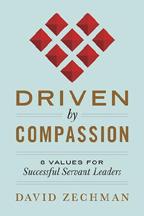
Zechman, David Amplify Publishing (152 pp.) $29.00 | $9.99 e-book | Sept. 13, 2022 978-1-64543-667-6
In this business book, a hospital man agement consultant lobbies for compas sionate leadership.
Zechman, a former hospital CEO, says he learned the power of positive reinforcement even before he started his health care career. As a high school coach, he recognized “that leaders who show people that they care about them make the best leaders.” In this sincere work, the author identifies and describes eight values he believes are associated with caring leaders: “Patience, Trustful, Grudgeless, Honesty and Integrity, Communication, Servant Leadership, Walk the Talk, Commitment.” Zechman devotes a chapter to each value, voicing his views in a lucidly written text that occasionally ref erences other authorities and incorporates numerous examples, primarily from his health care management experience. While the notion of leading with compassion is not a unique idea, the author writes with an authentic enthusiasm that is infectious. For example, one of his useful takeaways on patience is “always praise three times more” than you admonish. About grudges, he acknowledges that “disagreements are a necessary part of the decision-making process for an organization,” but “grudges truly hurt the person holding them the most.” Regarding
adult
“The author writes with an authentic enthusiasm that is infectious.”
communication, Zechman insightfully observes that “there are some leaders whose ego tricks them into believing that hoard ing knowledge is a form of power.” When it comes to commit ment, the author optimistically notes that “the primary role of a committed leader…is to radiate hope!” Zechman is perhaps most passionate in the chapter about “Servant Leadership.” Here, he discusses in detail five specific requirements for the practice and suggests that “servant leadership is a calling to sup port the greatness of those one serves, which benefits our world all the way down to the organizations we support in our pro fessional life.” Drawing on his consulting role, the author uses a valuable technique: He asks readers to rank the eight values in order of importance at the beginning and end of the volume to see how their perspectives may have changed. He adminis tered the same survey to “the twenty-five leaders I interviewed for the book” and reports the results for comparison purposes. This exercise will engage readers in self-reflection and effec tively validate the values covered in the work.
Candidly written and sensitively delivered leadership advice.
Copyright
Fortuna,
by Kirkus Media
Periodicals Postage Paid at Austin, TX 78710 and

An unpredictable and gripping thriller with a strong cast.
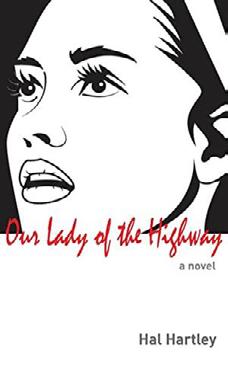
A raucously funny yet heartfelt and illuminating tale of holy orders at theirmost chaotic.
An outstanding per formance playbook.

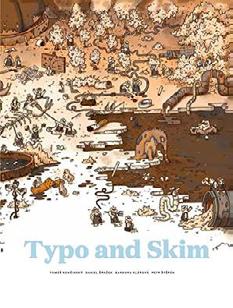
Barbora Klárová & Tomáš KončinskýIllus. by Daniel Špaček Art Director: Petr Štěpán; Trans. byAndrew Oakland
Imagination soars in this smart, humor ous, visually capti vating approach to a scientific concept.
An encouraging, upbeat, and useful call to host parties and make friends.

young adult

Lea Lane
Lane’s sharply obser vant yet intimate writing will transport readers to places all over the world.
Episode 280: Mohsin Hamid, author of The Last White Man (Riverhead, Aug. 2), on the long sentences in his latest novel and his last novel, 2017’s Exit West :

In Exit West, the sentences grow longer as the book progresses and take on this kind of incantatory quality, like it’s trying to summon into existence a magic spell that allows this world to exist. In The Last White Man, what’s hap pening is something slightly different, in that what each sentence is doing is something is said, it’s sort of questioned, it’s puzzled over, it’s qualified, it’s moved. And I think that corresponds, in a way, to how we actually think.
Episode 281: Beth Macy, author of Raising Lazarus: Hope, Justice, and the Future of America’s Overdose Crisis (Little, Brown, Aug. 16), on how a journalist knows she’s got a good quote:

A really good quote makes the hair stand up on the back of my neck. It makes me laugh, or it makes me cry. It moves me, you know—it’s really trenchant. [Dr. Nikki King, one of the health care providers profiled in Raising Lazarus], just has this way of seeing the world that’s so fresh and new. So many people in the book have that same ability—that’s why I want to write about them. I interviewed scores of people but ended up settling mostly on five or six who were just either a quote-a-thon, like Nikki, or they’re giving me this window…that I wouldn’t oth erwise see.
Episode 283: Sidik Fofana, author of Stories From the Tenants Downstairs (Scribner, Aug. 16), on how hard it is to write a good short story: It is impossible. What makes it even harder is when you tell someone, “I’ve been working seven years on this,” and they’re like, “It’s only 15 pages.”…Writing a short story is like spinning a penny: I’m bad at spinning pennies, so like every time I try to spin a penny, it’s just gonna fall flat. The goal is to just spin it—so that it spins on its own. It’s the self-engine of spinning. And it’s impossible. And for me, who’s bad at it, I’ll get it 1 out of every 15 times. And then to explain, how did you get it to spin on its own? And it’s like, I don’t know.
Editor at large Megan Labrise is the host of the Fully Booked podcast. Find new epi sodes every Tuesday on Apple Podcasts and Spotify or at kirkusreviews.com/podcast.

When she was growing up in the only Black family in her Rhode Island hometown, actress Viola Davis wet the bed fre quently. The target of racist bullying, she often went to school reeking of urine. Rats ate the faces of her dolls, her alcoholic father beat her mother, and she and her sisters were victims of sexual abuse.

Such real-life horror makes for what Kirkus calls a “starkly forthright memoir.” Finding Me (Harper Audio, 9 hours and 15 minutes) is a searing portrait of grinding poverty and sur prising triumph and how the echoes of the first haunt the security of the second. The story is so wrenching and personal it could only be narrated by the fiery Davis herself. Winner of two Tony Awards as well as an Oscar and an Emmy, she summons a simmering rage—often speaking in clipped tones as though with barely controlled fury—at the teachers who never helped, at systems that continually punish the poor, at the racism and colorism that blocked her path to success for so long.
But like any great performer, Davis can access other emotions, too: pride in her accom plishments, deep gratitude for everyone who encouraged her, love for her family. Delivered with passion and hard-won insight, her words are a balm to anyone struggling to be seen.
Hannah Gadsby’s Netflix stand-up show, Nanette, was an unexpected tragicomic gut punch, and in Ten Steps to Nanette: A Memoir Situation (Random House Audio, 13 hours and 47 minutes), the comedian explains how a self-described “financially insecure, autistic Aus tralian genderqueer vagina-wielding situation” reshaped personal and universal trauma into a stunning work of art.

Read by the author in her sly, quirky tone, the book follows Gadsby’s childhood in rural Tasmania and the rocky path she traveled into adulthood to find her voice, rolling out against the backdrop of Tasmania’s ongoing criminalization of homosexuality.
Pulling stories together to form a cohesive and funny whole is what Gadsby excels at, and her pitch-perfect comic delivery serves her well as narrator. The “initially stiff prose” Kirkus mentions in its review isn’t evident in the audio version. This performance displays great humor—and real heart.
Foo Fighters frontman and Nirvana alumnus Dave Grohl narrates The Storyteller: Tales of Life and Music (Harper Audio, 10 hours and 35 minutes) with a friendly, straightforward earnestness that cements his public persona as one of the nice guys in rock and roll. Whether he’s talking about his days as a middle-class suburban kid falling in love with the 1980s punk scene, the rise and fall of Nirvana, or buying Barbies with his daughters (he opted for a Joan Jett Barbie for himself), Grohl comes off as a likable dude who loves his life (which just happens to be a bit flashier than ours).
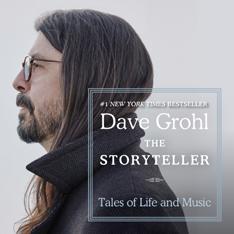
In the book, published before the death of Foo Fighters drummer Taylor Hawkins earlier this year, Grohl name-drops with casual abandon, but each anecdote lands with a refresh ing gee-whiz normality. The Storyteller is less gritty than you might expect—Kirkus writes that sometimes a lack of depth “make[s] the book feel like a missed opportunity”—but the author projects such regular-guy appeal in his narration that even casual fans will enjoy his transformation from teenage pothead to musical star.
Connie Ogle is a writer in Florida.
